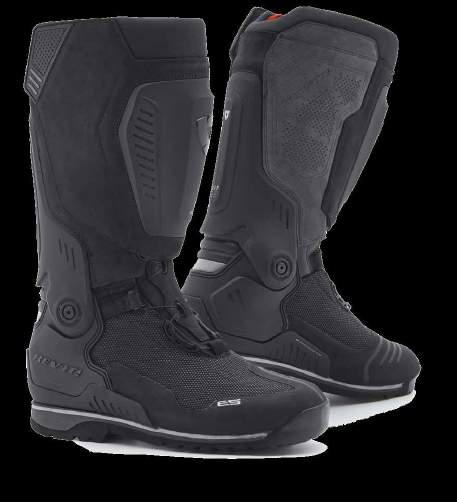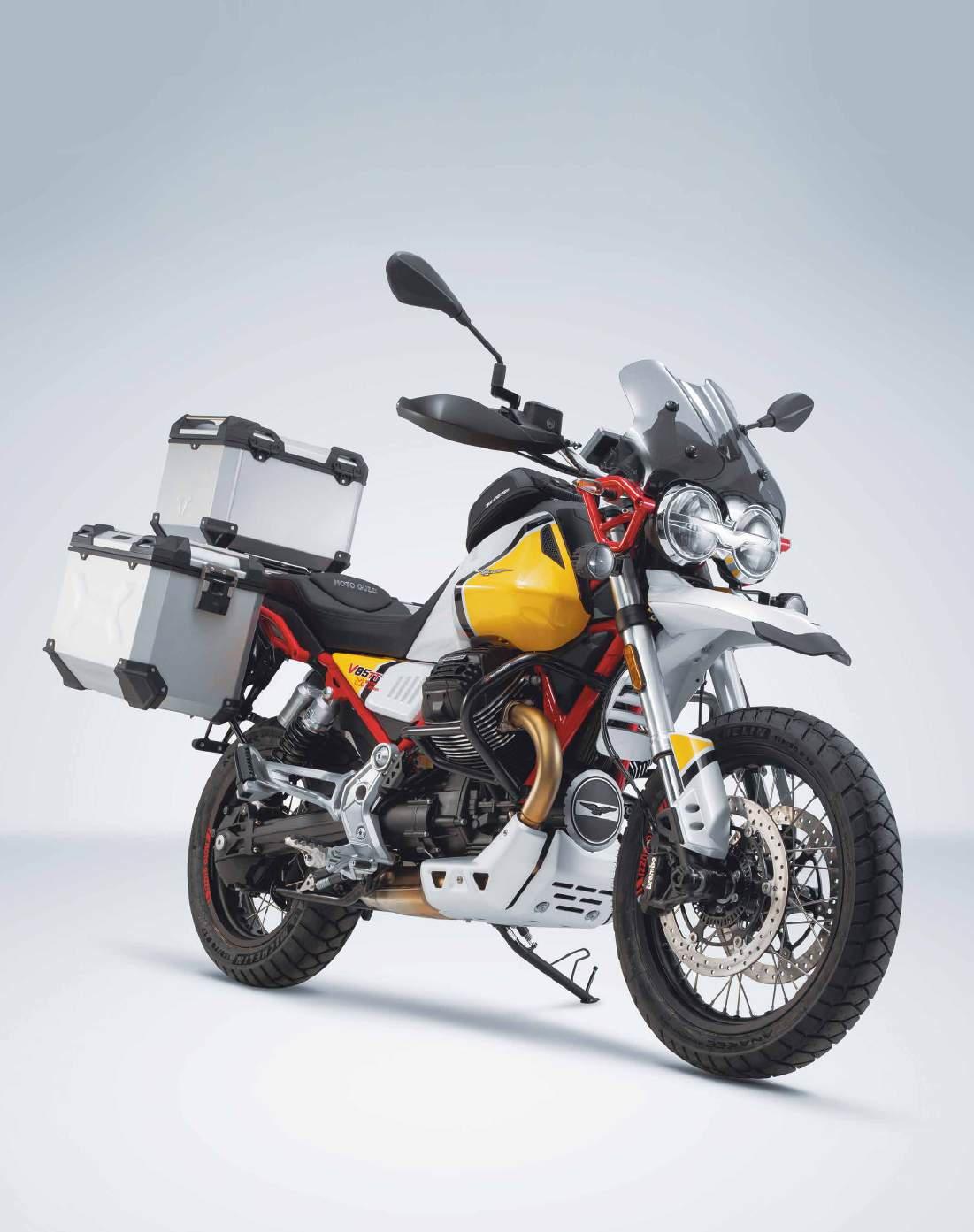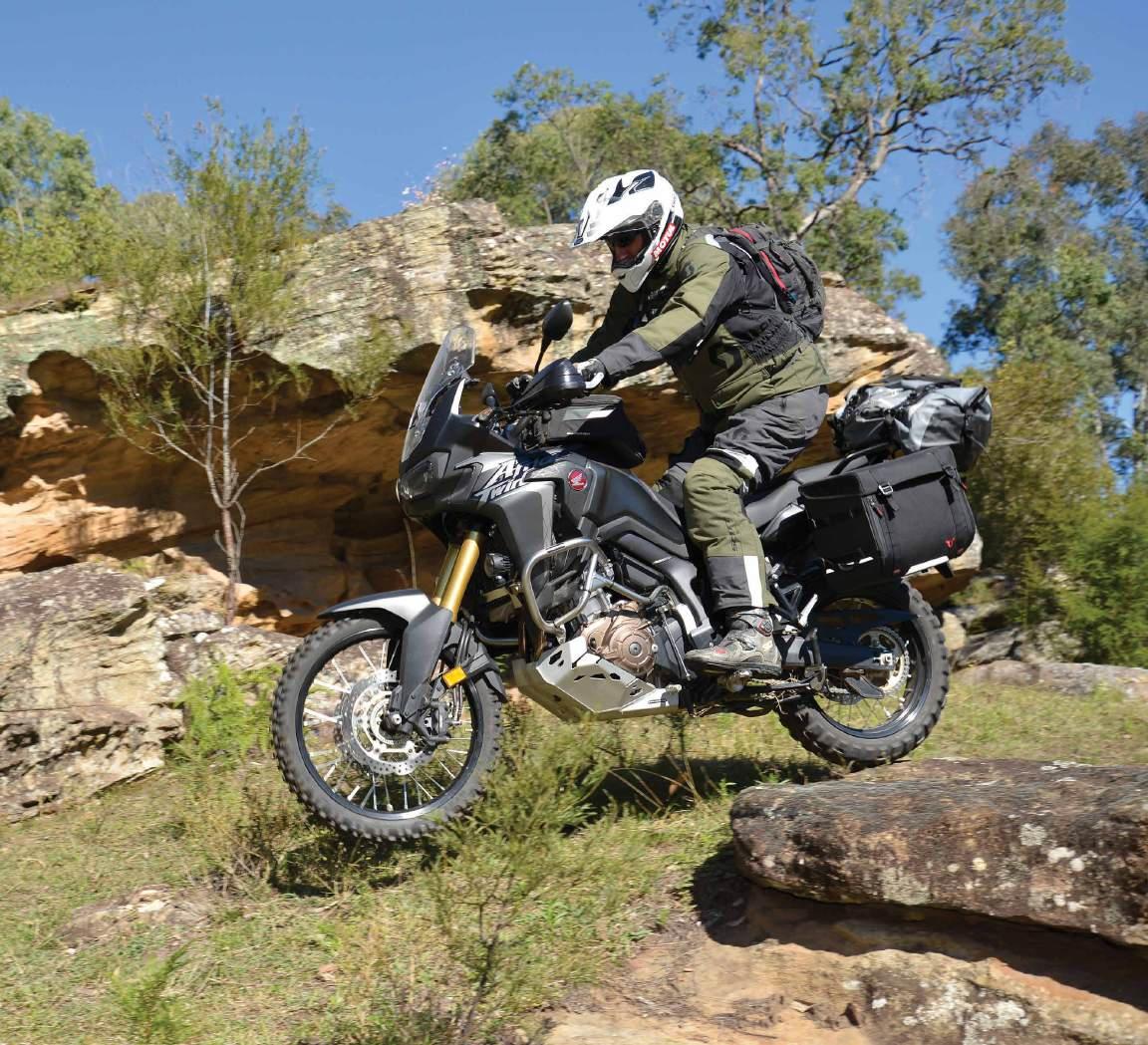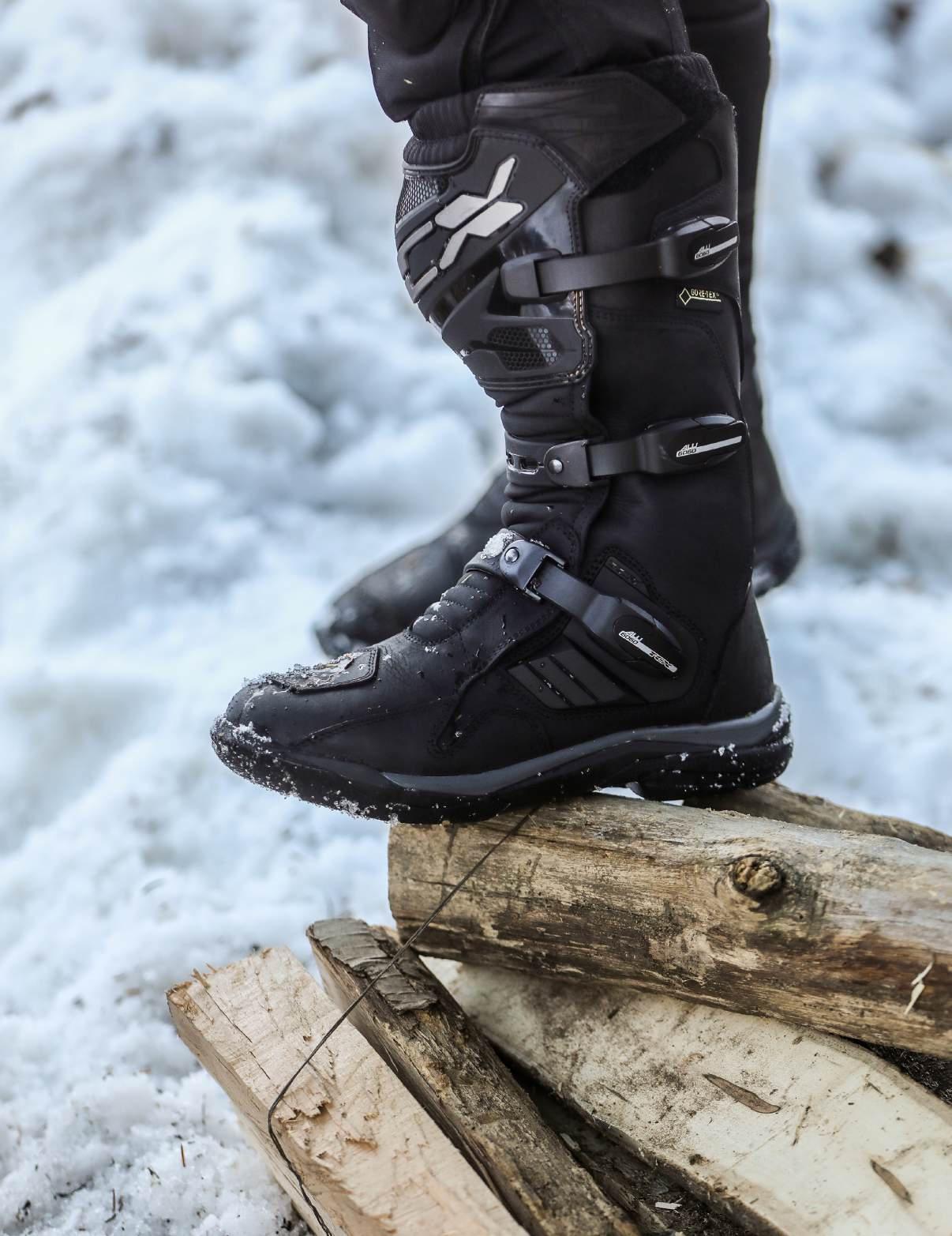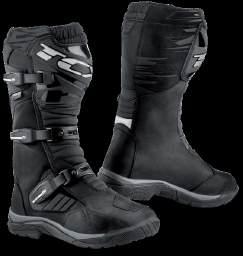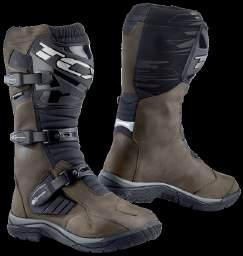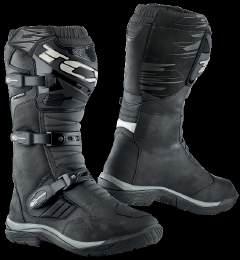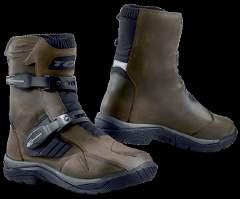
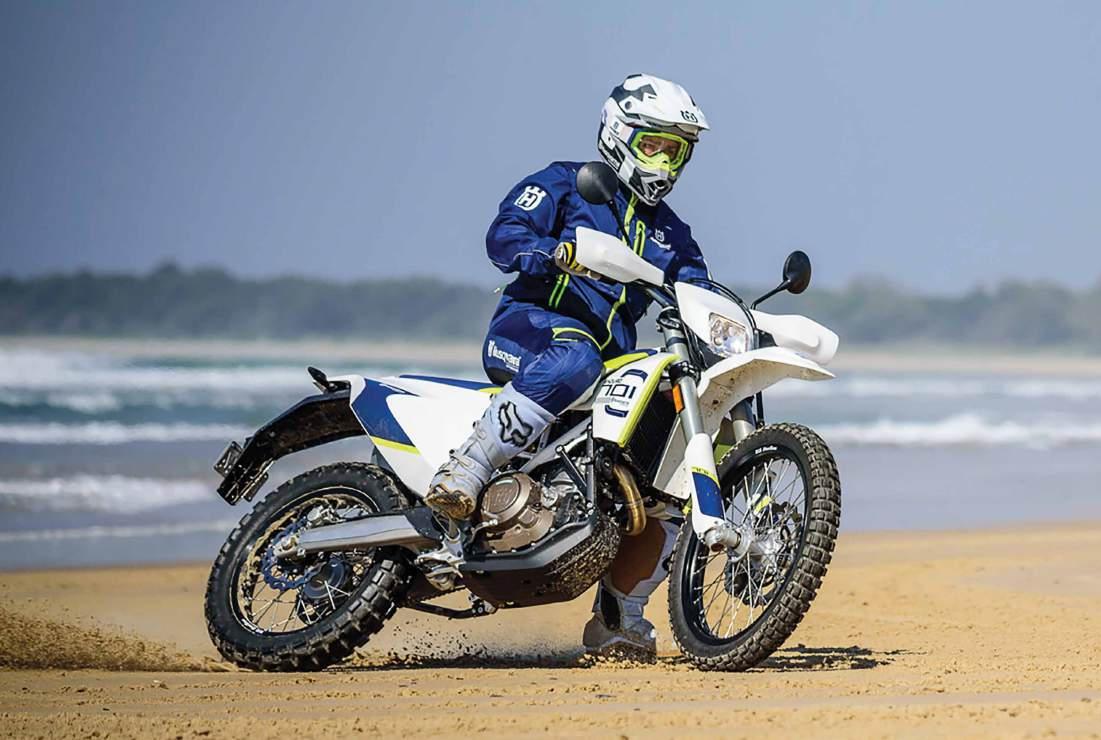





With the ability to go the distance on any terrain you choose, the options for endorphin-inducing experience are endless. A state-of-the-art chassis and distinctive design ensures that your ride is at home wherever it goes. Set off on limitless exploration with Husqvarna Motorcycles 701 ENDURO.
It’s we what
Tom Foster - Editor
’ve done some track time on a few high-performance road bikes lately, and it’s been an interesting experience. I’m talking about four-cylinder, litre-class sports bikes, and even in that category I’ve been lucky enough to ride some seriously highpowered, high-performance examples. It’s interesting because these are road-registerable bikes I’m talking about. Any mug can walk into the shop, whack some cash on the counter and ride away on one.
adventure bikes? Not me, that’s for sure.
But does that stop me lusting after those big Ducatis, Triumphs, BMWs, Yamahas, KTMS and all the rest?
Hell no. I love riding those things.
And that’s what’s interesting. Although I’m no closer to pushing the performance envelopes of those big bikes than most other riders, I hunger after them something chronic.
IThere’s a direct comparison to big adventure bikes. Seriously, how many people can honestly make the most of the performance offered by the big
“Seriously, how many people can honestly make the most of the performance offered by the big adventure bikes?”

For road riders, 200 horsepower with more electronics than Microsoft is probably the dream. Destroying $300 rear tyres in a single day at the track is something to brag about. Paying $50 jabillion for exotic parts and servicing every few weeks is a delight. For adventure riders it’s the same. Not that we’re drooling over huge horsepow er figures – although some of us clearly are – but we love the high level of technology, the sheer presence of a beautifully designed and finished bike and the glorious, deep lustrous paint. What good is any of that to someone bogged up to the sidecovers in a muddy creek bed or stuck on a shitty hill? Would the rider be better off with half the horsepower and a bike that weighed half as much?
Of course. That’s only sensible. And there. That’s the point. Our riding decisions aren’t made with common sense. They’re made with passion, dreams and desire, and they’re made to fulfil deep longings that have nothing to do with common sense. The same way a road rider will climb on board a 200-horsepower monster to commute, adventure riders will take a Postie bike across the nation or a 1200cc pinnacle-of-perfection into the desert. There’s no common sense in the decision. It’s just about the dream and the challenge.
I hope that never changes.

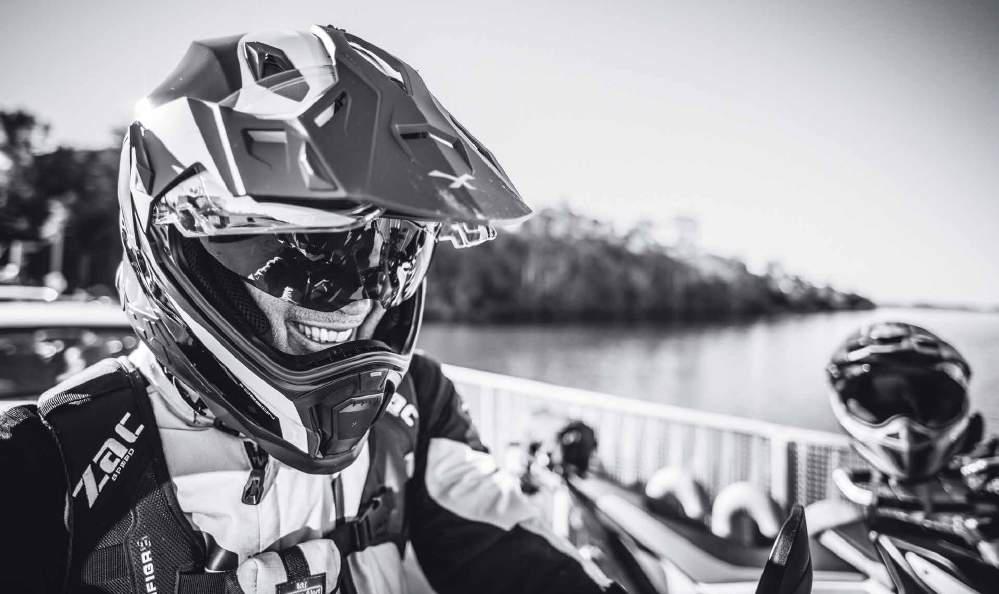
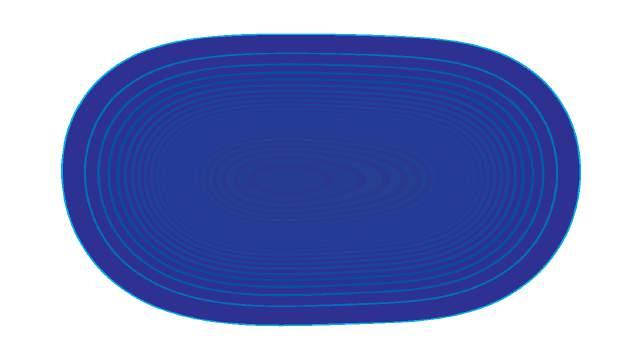







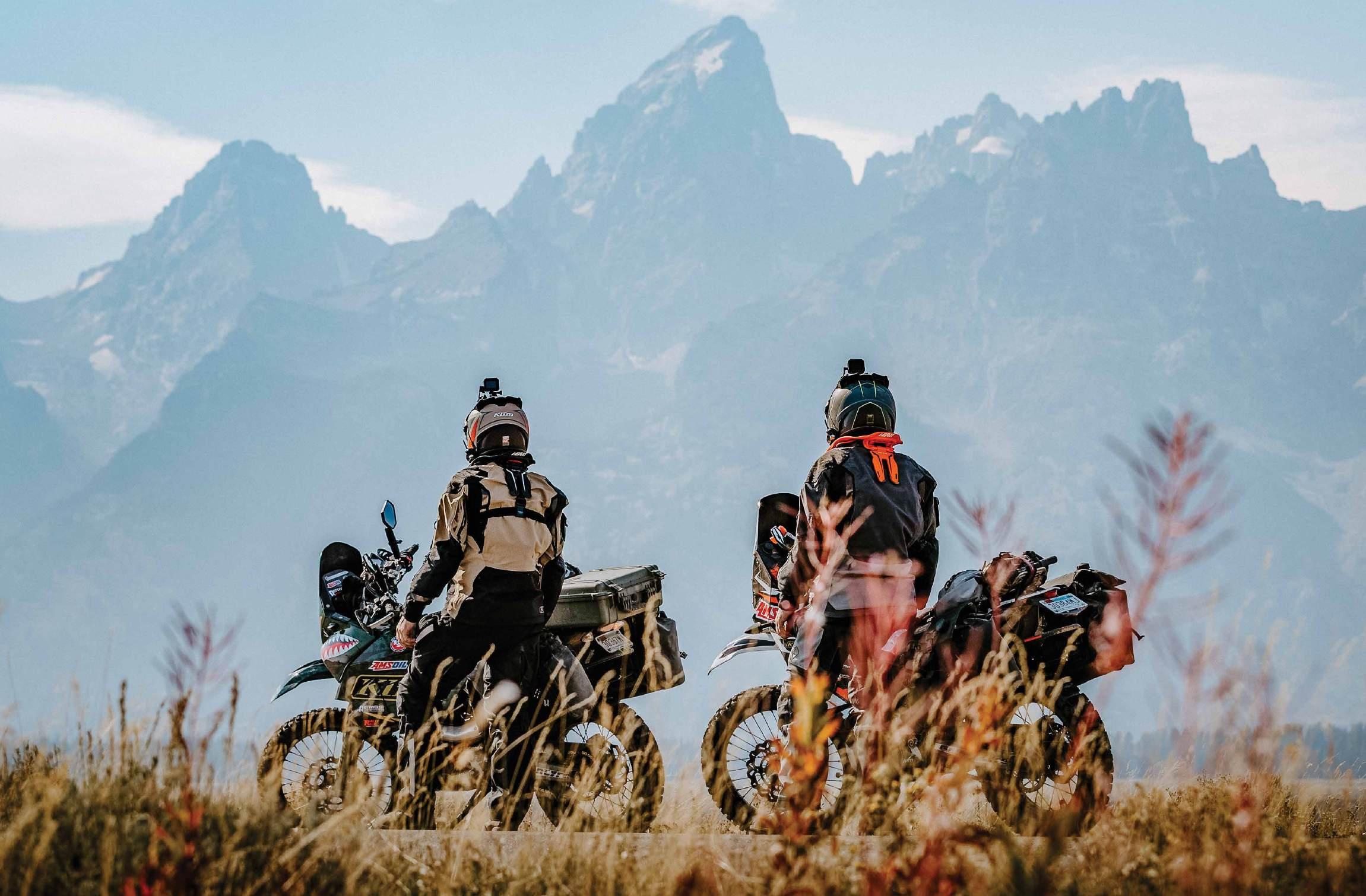

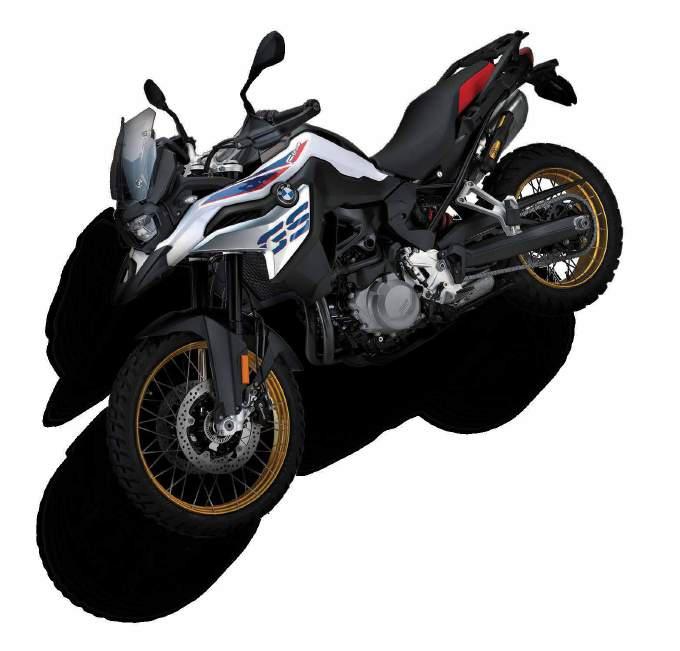
Experience the superior benefits of a BMW GS Boxer, with the all new BMW ShiftCam engine. The variable camshaft ensures optimised power delivery – in both high and low engine speed ranges. Leave others in the dust with next level performance, all whilst enjoying the benefits of class-leading connectivity and functionality. Book a Test Ride: bmw-motorrad.com.au
@bmwmotorradaus
@bmwmotorradaus
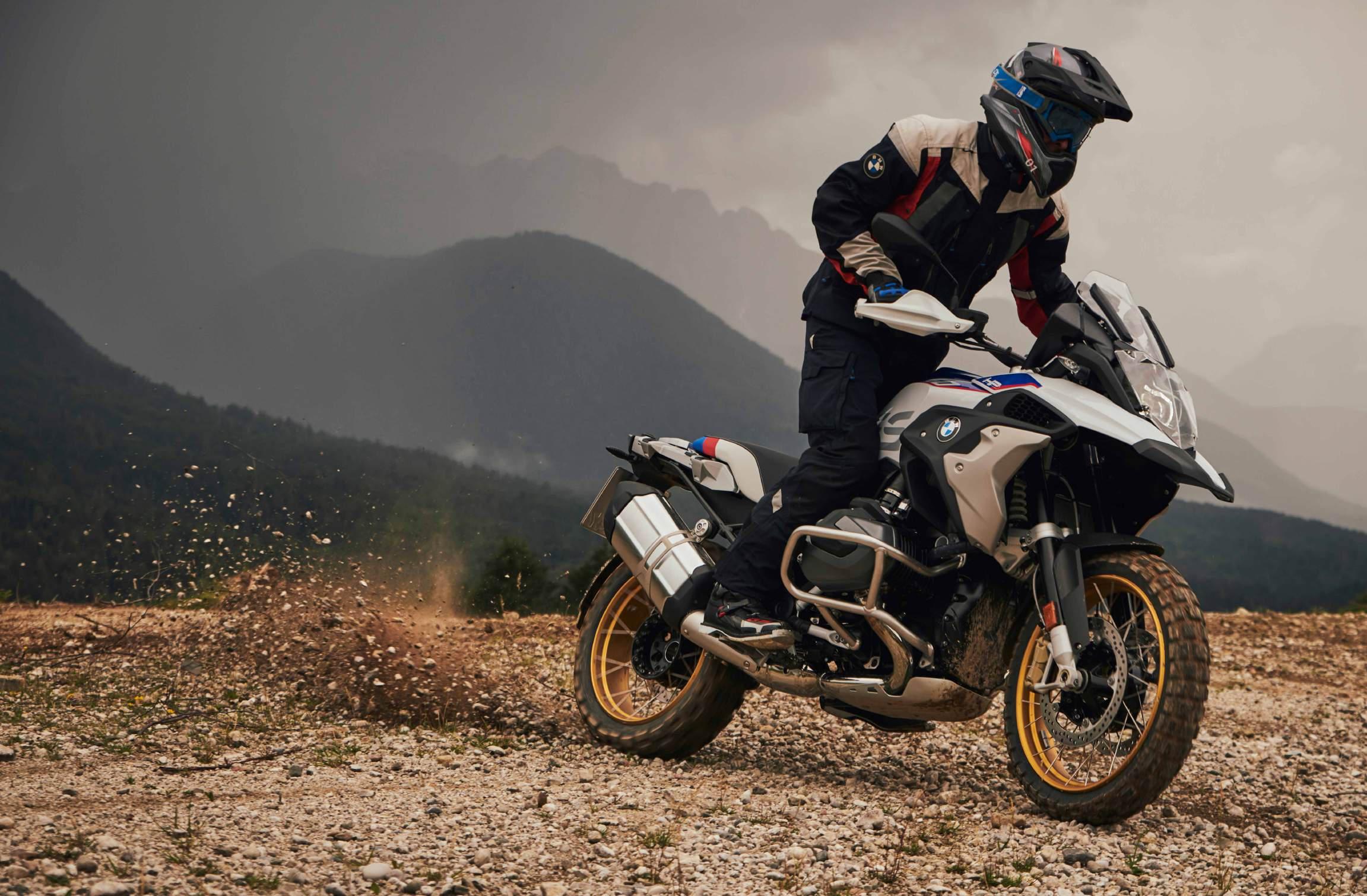


Publisher Kurt Quambusch
Editor Tom Foster
tom@maynemedia.com.au
Group Sales Manager
Mitch Newell
mitch@maynemedia.com.au
Phone: (02) 9452 4517
Mobile: 0402 202 870
Production Arianna Lucini arianna@maynemedia.com.au
Design
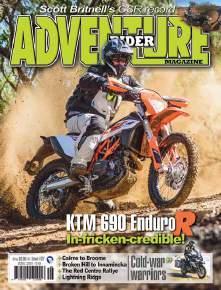
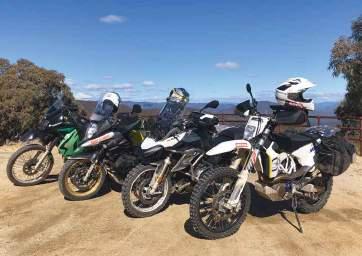
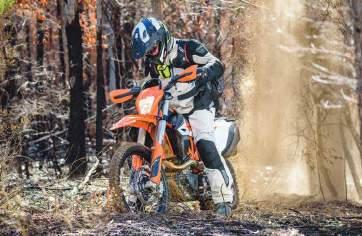
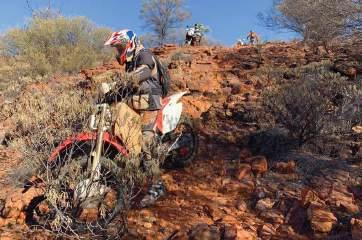
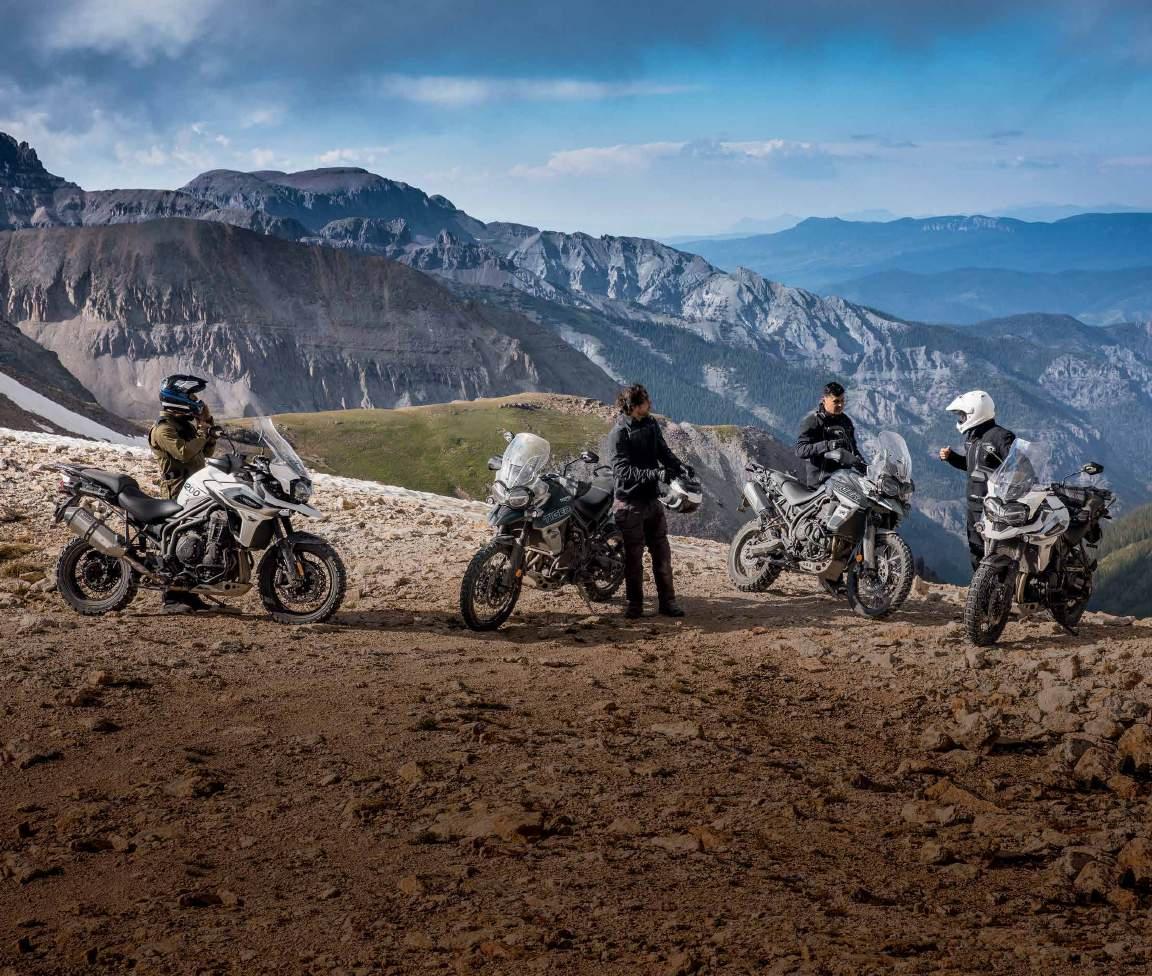
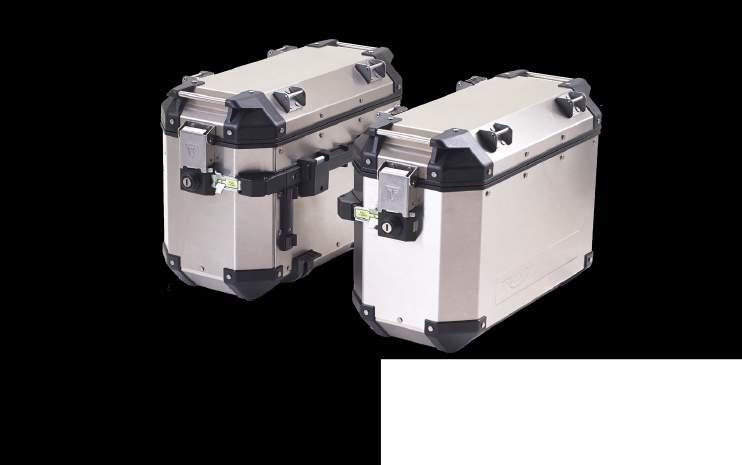

8 advridermag.com.au
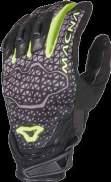
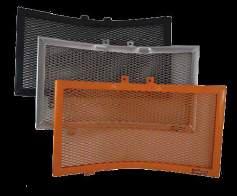
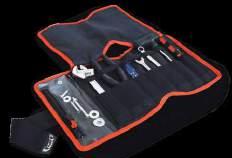
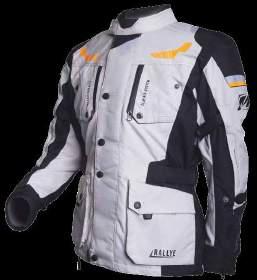
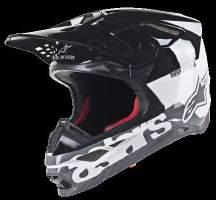
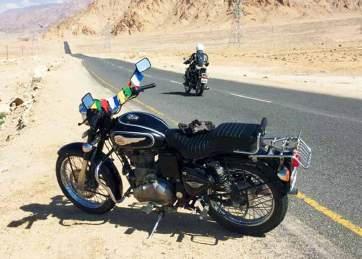
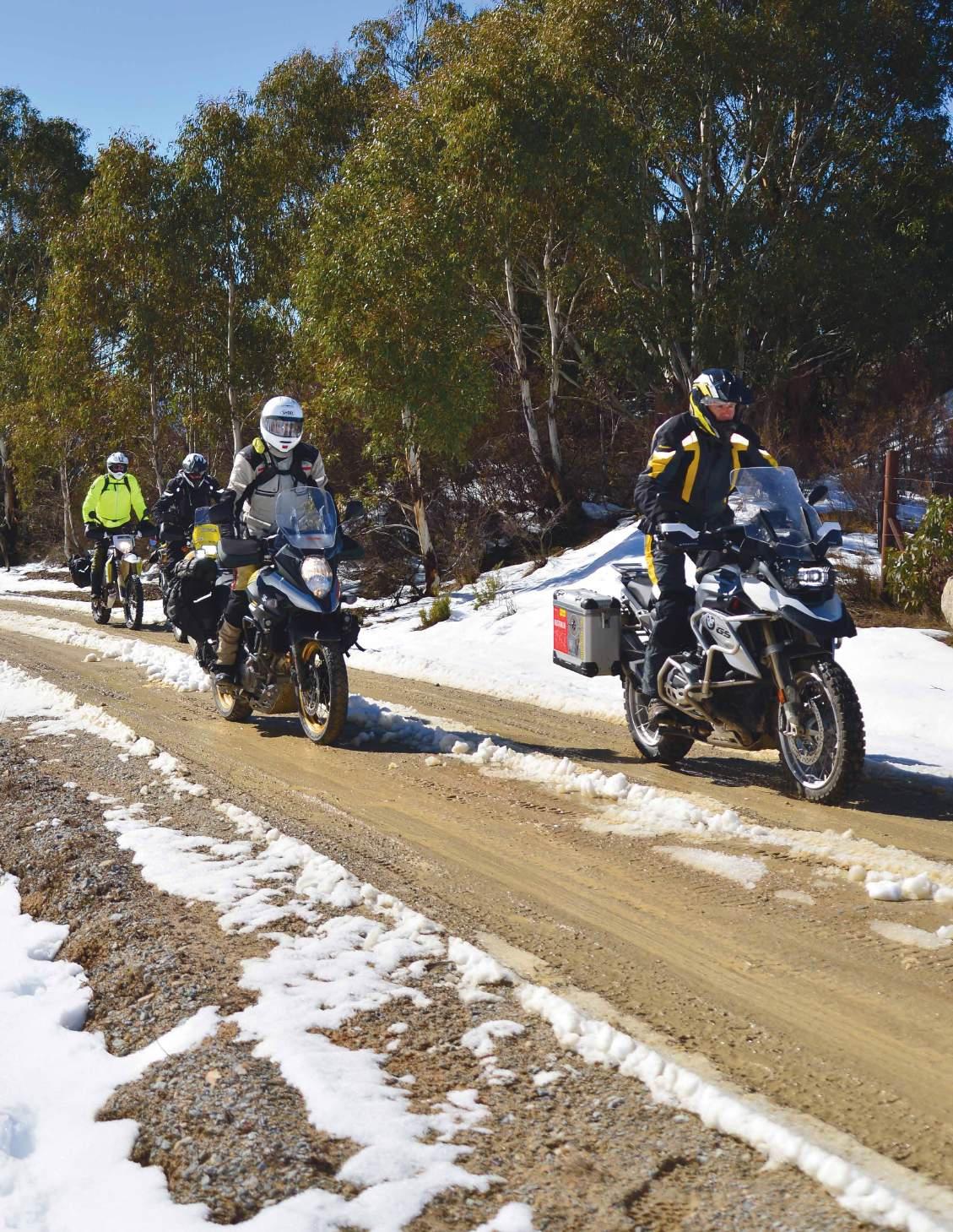
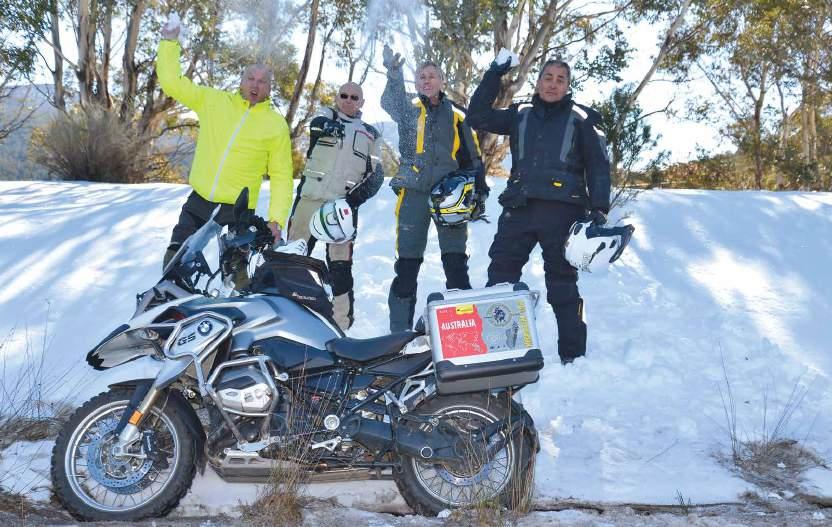
Kurt, The Boss, was naturally included. Anyone who works for a magazine and doesn’t include the owner of the publishing company on a ride as good as this one clearly doesn’t value their job. He and his DRZ, kitted out with some interesting accessories, were certainties. But then came the real deal. Robin Box, importer of Touratech and manufacturer of Safari Tanks, rolled in on his Beemer, decked out with primo Touratech gear of all kinds. Robin’s ridden the deserts and frozen wastelands of the world – he’s from Victoria, which is pretty much the same thing – and he’s a gnarly bastard. Andy ‘Strapz’ White, also from
Victoria, but a different part where it’s still cold and shitty a lot of the time, loaded up his V-Strom with awesome gear, Quad
Locked his phone to the ’bars, activated the Anti-Shrinkage app and headed for sunny NSW.
Andy’s officially a gnarly bastard, too. He’s earned his stripes on some serious two-wheeled adventures, including crossing The Sunburnt Country with Robin Box.
Like all great rides, the plan was simple. Everyone was to be in Jindabyne on Tuesday arvo. Wednesday morning early,
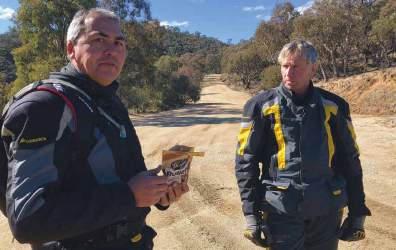
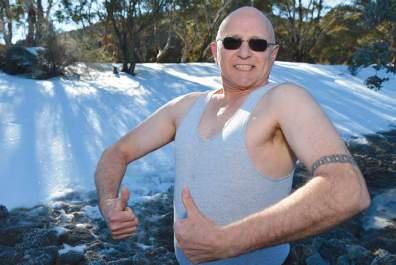
everyone was to mount up and head along Barry Way and Snowy River Road to Suggan Buggan and McKillops Bridge. At the McKillops campsite riders could picnic and wander around while photos were shot and ideas and products discussed.
Simple.
In issue #36 Miles Davis gave an excellent rundown on dealing with riding in low temperatures. Although the worst of winter is over as you read this, we thought to back up all the theory we’d nominate a destination, get some trustworthy people to ride in, then strip them down to see what’s what in the real world.
At the time the ride was proposed temperatures were still balmy, but it was a fair bet the NSW ski fields would be cold in the middle of winter so there was no room for chickenhearts. Only riders who could be trusted to look after themselves could be considered.
Not everyone invited was available of course, but those who did ride into Jindabyne at the base of the NSW ski fields that midwinter afternoon were steely-eyed hombres, ready for a challenge. First in was the editor. Everyone
agreed he wasn’t all that steely-eyed unless there was a good supply of strong coffee, but someone had to take the pics and do the work to justify the whole thing. He appeared to love the idea of riding his Touratechprepped KLR from northern NSW to the NSW ski fields and back again. Next up was Ad Manager Mitch, something of a newbie to adventure riding, but keen as all get out. Secretly everyone was pretty sure he really didn’t know a whole lot about handling the cold. Watching him on his Husky 701 with no screen or heated grips or anything was likely to be fun. Ha!
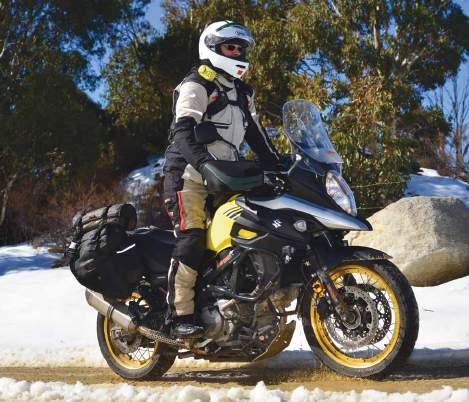
Far left: A crystal-clear day, but still chilly enough to cause alarming shriveling and shrinkage.
Above left: A good bunch of hard-bitten adventure riders.
Above top: Both Robin and The Boss wore Touratech Companero suits, and both seemed to cope well.
Above: These Victorians are tough! Andy showed he could hack the low temperatures, with or without high-tech gear.
Left: Andy had an amazing amount of gear on his ’Strom. It was like a rolling retail outlet.
But at breakfast on Wednesday morning someone declared, “We should go up to the snow,” and before the editor could say, “Eggs benny, please,” everyone was suiting up, mounting up and heading up Mt Kosciusko as if there’d never been a plan at all and nobody had ridden in a day earlier to do the ride out to McKillops and make sure the road was in good shape and plan photo locations or anything.
As the altitude increased the temperature decreased, and the snow drifts which lay in hollows beside the road near Jindabyne quickly became a white blanket covering the landscape. Despite beautiful clear skies and blazing sunshine, the instruments on the BMW and Suzuki showed low single figures. Any exposed skin felt the air as a sharp, stabbing cold, a sure sign the atmosphere needed to be treated with respect.
A suitable area was found where bikes could be parked without threat to the environment and, shivering in the clear, icy air, the riders ran through their coldride set up and equipment.
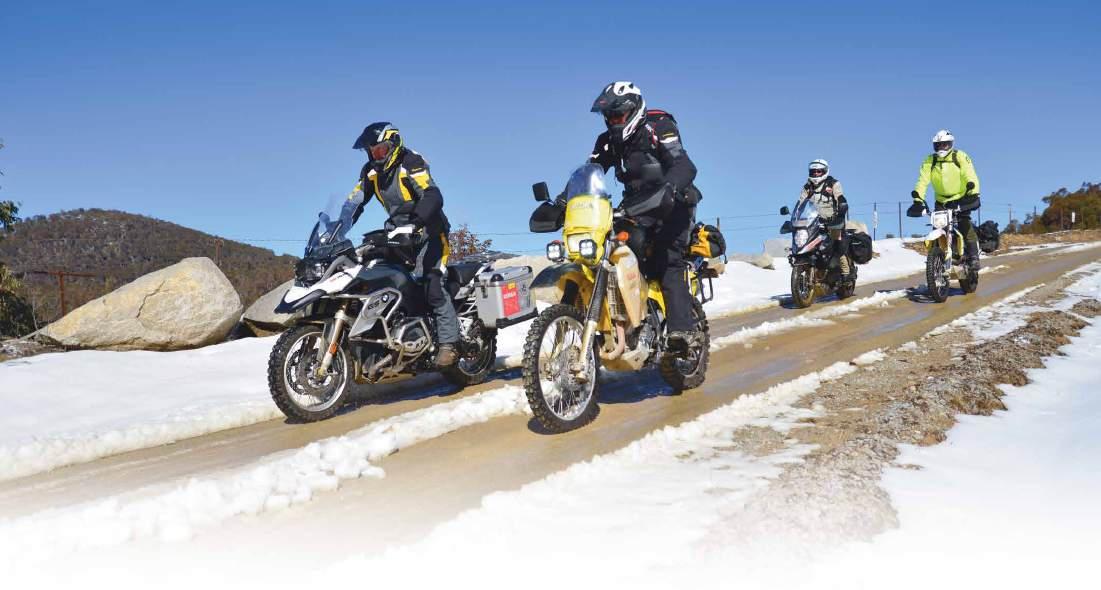
It was all very professional and some excellent work was done.
Interesting
There were a couple of surprises at this early stage of proceedings.
First was Mitch. Not only did he not seem to struggle in the cold, he appeared to enjoy himself. The Husky, the same bike which had proven itself so exceptional as a long-termer with the magazine, continued its display of faultless and amazing performance. Better still, as the cold morning wore on, Mitch produced a thermos filled with hot, life-giving coffee and proceeded to endear himself to everyone by offering a cup of steaming wonderfulness to anyone who wanted one. So that was good.
The Boss began eyeing off Robin’s Touratech overgloves and seemed to be angling himself into position to make a grab for them. Robin must’ve spotted the ploy because he pulled on the paw protectors and folded his arms.
Andy unpacked the V-Strom to reveal a veritable warehouse of amazing clobber, gear he either made or sold, and suggested making ‘snow angels, just for
fun’. While the editor worked quietly and efficiently behind the camera, maintaining the level of professionalism cognizant with the reputation of a fine publication like this one, some sort of
“ The riders pulled up to don whatever they could find…extra shirts, balaclavas, heavy gloves, inner gloves, outer gloves, glove puppets …anything.”
giggling committee meeting was held and instead of everyone falling in the snow and waving their arms about, large, knobbly snowballs were hurled in the direction of the photographer as the shutter dropped.
Much backslapping and selfcongratulation followed before heading back down the mountain for lunch.
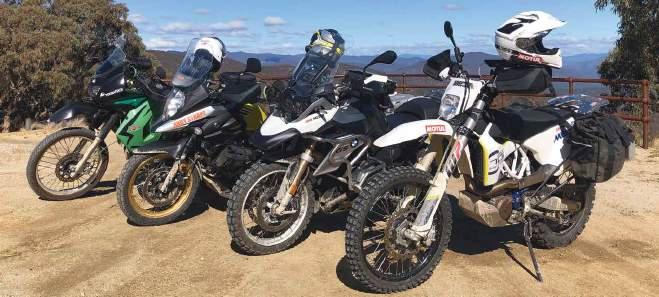
With the work effectively covered, Andy declared he needed to be back at Strapz HQ the next morning and that he was going to make use of the daylight to head home via Suggan Buggan, Bruthen and Bairnsdale. Seeing as the first 120km or so of that journey was also the route to McKillops Bridge, it was decided to ride along with Andy then check out the bridge and see the river. All went well. Andy was farewelled and hunkered down to the magnificent swervery on the road to Buchan. The remaining riders kicked down the sidestands at the McKillops Bridge rest area. No problem.
But then, with the sun perilously close to the horizon, Robin put forward the idea that returning the same way wouldn’t be as interesting as if he led everyone back via Bonang and Delegate, which he assured everyone was, “Just there.”
It wasn’t far, and from there a run along the Bonang Highway to the Monaro Highway in fading daylight was glorious, even though the full moon was blazing from the early-evening sky and it was really frigging cold.
But not as dark and cold as the run along Snowy River Way.
PHONE: (03) 5729 5529
WWW.TOURATECH.COM.AU
EMAIL: INFO@TOURATECH.COM.AU
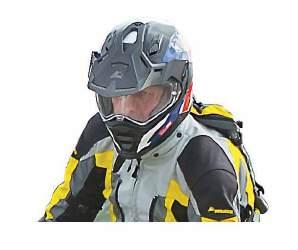
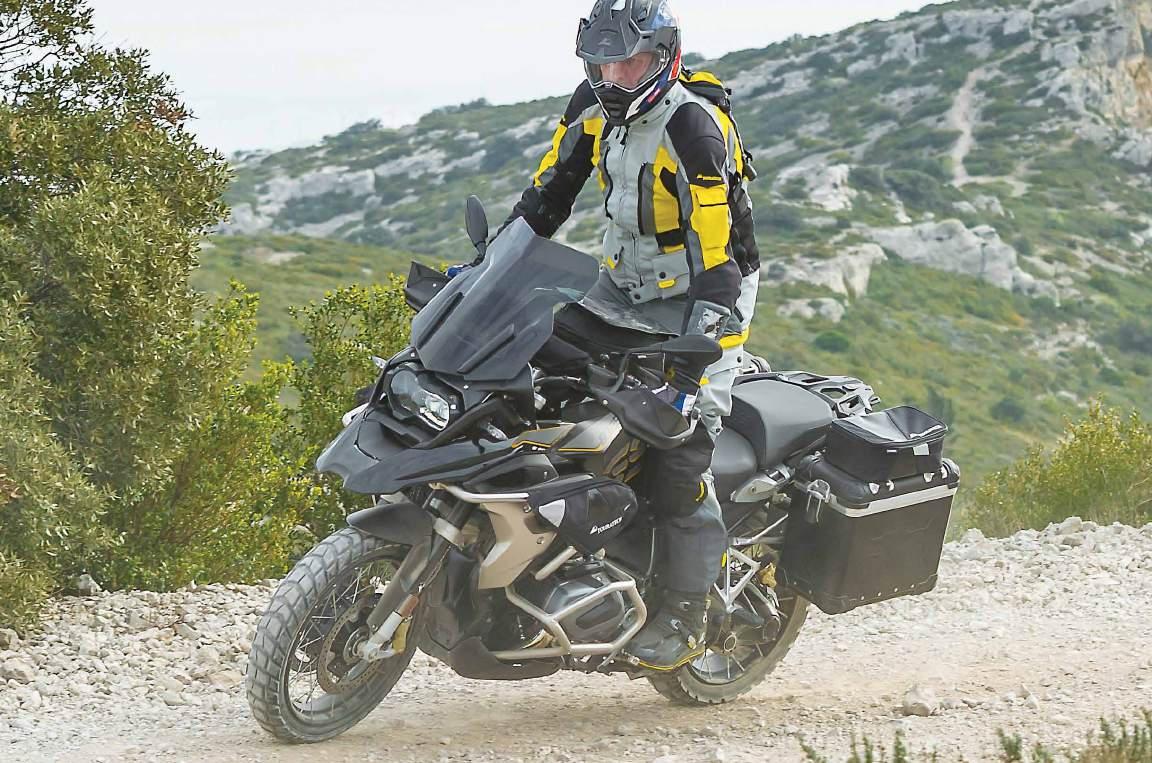
Despite the incredible, impossible majesty of a new windfarm on a ridge, backlit by a sumptuous, velvet-orange twilight sky, the cold became serious. Not only the cold, but the unlit road with no edge markings or cat’s eyes, and alive with wildlife, raised the stress levels until finally Robin called a halt. With teeth chattering and genitalia long-since shrunken to some internal place of refuge, the riders pulled up to don whatever they could find…extra shirts, balaclavas, heavy gloves, inner
The result of millions of kilometres, and many hundreds of thousands of panniers made! Over 25 years of experience with luggage for motorcycle adventures make these panniers perfect for your trip!
Even more robust
Even safer
were very popular. u
Even more comfortable Order now
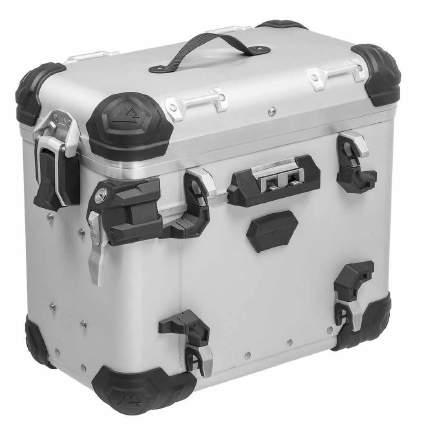


gloves, outer gloves, glove puppets…anything that could be somehow fitted over or under anything else was donned in a dark, roadside frenzy. A quick discussion confirmed everyone was in good shape, and Robin’s Beemer guided the cavalcade safely back to the warmth and sanctuary of the accommodation at Jindabyne.
When the night cold did make itself felt there were a couple of interesting things emerge:
3 Everyone, without discussion, increased the number of clothing layers. Nobody removed some clothing items and replaced them with others
3 Mitch had a pair of Five HG1 heated gloves, and as he rode along he insisted on waving them about to show everyone the pilot lights indicating the chosen heat level. It was like a rolling rave party as he drew groovy shapes in the air and the softly glowing lights showed their different colours
3 Robin’s claims of the Touratech Companero suit being ‘all you need’ seemed to be proved. While everyone else looked like Michelin men with the amount of gear they wore, he seemed comfortable in just the Companero
3 The Boss was in a Companero suit as well, but nobody could see what he was doing because of the spotties on his DRZ. Anyone caught in the glare was stunned for several seconds and unable to speak or think coherently for some time
3 All riders had opted for adventure-style helmets with visors. Nobody showed up with a motocross helmet and goggles.
As riders cracked themselves off their iced-up bike seats and bolted for the hot showers it was agreed it’d been a fabulous day and, despite the relatively short distance, a genuine adventure.
Andy reported he rolled into home base around 9.00pm, so a long day at the office was had by all.
Have a wander through these pages to find out the lessons learned and ideas shared…
Adventure Rider Magazine’s ad manager often jokes about being a ‘45-year-old L-plater’, but he had done some riding as a junior motocrosser, and as much as the other staffers look forward to him making rookie errors, he constantly disappoints his colleagues in that regard. This ride was a good example. It was assumed he’d pull on a motocross jersey and a pair of goggles and suffer. In fact, it was Mitch who possibly had the biggest find of the trip: the Five brand HG-1 heated gloves.
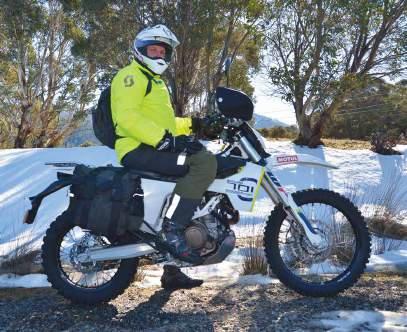
“For the first half of the ride down I wore a pair of Held Air’N’Drys, which are awesome,” said the Sydneysider, still stuttering after the night-time run from Delegate. “I have my Klim Inversion Pro gloves, but use them more in spring. So when it cooled right down around Goulburn I switched to my trusty DriRider Adventure 2s. But to be honest, the saviour for me today, and a real eye-opener, was the Five HG-1 heated gloves.
“I learned the lesson again today. I didn’t have enough layers, not being experienced in this sort of extreme cold. Both Robin and Andy warned me that if my body felt cold, no gloves would make my hands feel warm. But the HG-1s were awesome. They don’t make your hands hot, but when it got really seriously cold, they kept my hands in great shape.”
Mitch also had a Scott Dual Raid DP suit, Sherpa merino thermals and balaclava, a couple of motocross jerseys and body armour. Over the top of all that was a Scott Ergonomic Pro DP rain jacket, which was not only high-vis–very high-vis – but was waterproof, windproof and had enough stretch built in to be comfortable for all-day wear.
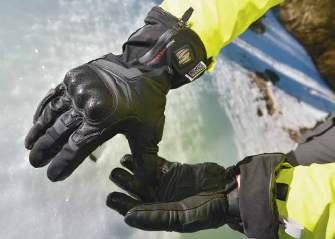
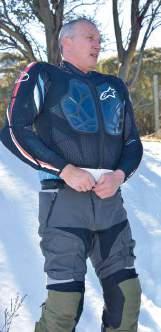
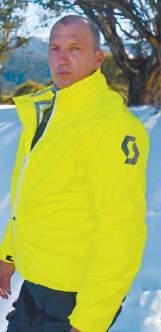
Did all those layers do the bizzo?
“It still wasn’t enough,” he gritted through chattering teeth.
“Five years I’ve been adventure riding, and I’m still learning every time go out.”
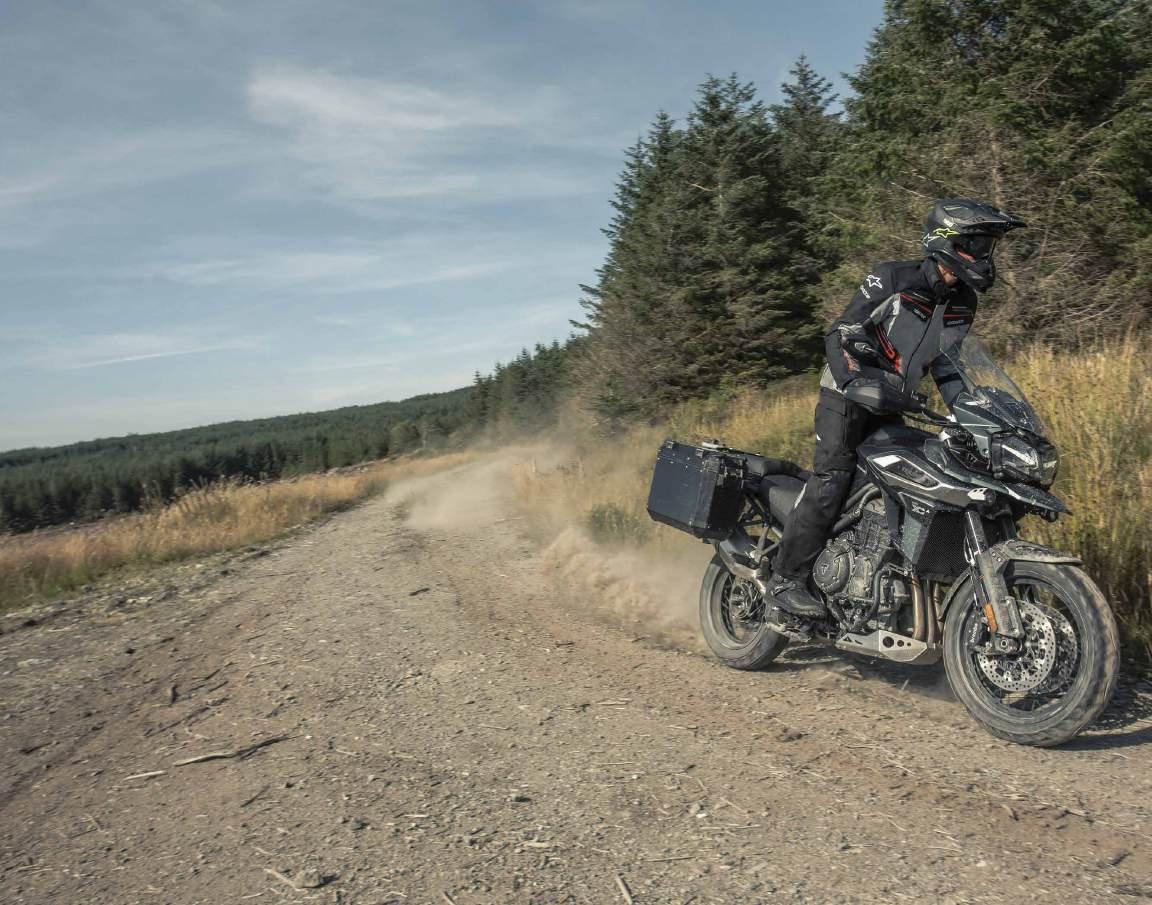
Left: The find of the tour: Five HG-1 heated gloves. They look a beautifully made glove to start with, but with a rechargeable battery and heating elements in each, these things were incredible.
Far left: An Alpinestars safety suit formed one of the layers, along with a couple of motocross jerseys and a set of merino thermals. Mitch still felt his inexperience left him colder than he needed to be.
Left: The Scott Ergonomic Pro DP rain jacket was another great find. Waterproof and windproof, Mitch raved about how comfortable it was. Unlike most waterproof jackets, the Pro DP is quite stretchy. The high-vis colour is a really excellent safety feature. u
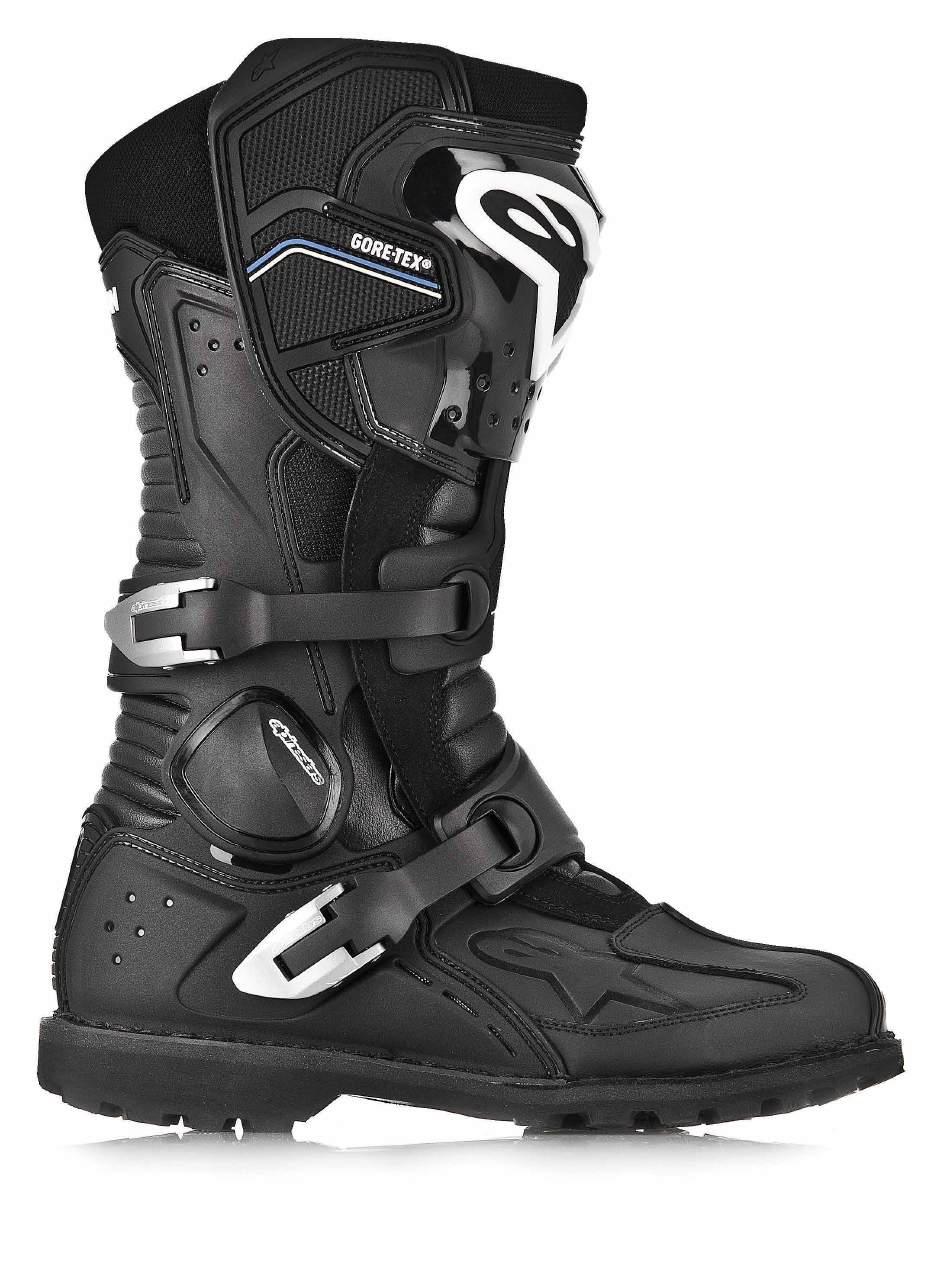



1: Andy’s a big fan of Held gear. The Carese 2 jacket is very flexible. The liner can be removed and used as an external shell and packs down really tight, and the venting and clever design make it a very versatile proposition.
2: Andy Strapz Thermalz tops and bottoms. These shouldn’t needn’t any explanation. Andy makes them and they’re brilliant. Made from superfine merino and designed especially for riders, they’re standard in the riding kit of a huge number of switched-on adventure riders.
3: Andy’s not a big fan of balaclavas. He prefers this helmet liner made at Strapz HQ. It’s superfine merino of course, and Andy says, “It keeps earplugs under control and keeps the helmet lining clean. It regulates well, too. When you start working hard on the bike it allows some breathing of the scalp.”
4: Rain-offs are a semi-stretch, welded-PVC overglove. They’re waterproof, a great wind blocker, and an ideal external layer when it gets seriously cold or wet. Available in one-finger or two-finger configuration.
5: Inner gloves. These are made from superfine merino. They’re a good glove inner liner and great if it’s not wet, just cold. Andy will often wear inner gloves, gloves and Rain-offs when conditions are especially uncomfortable.
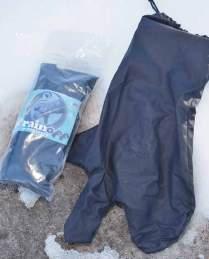
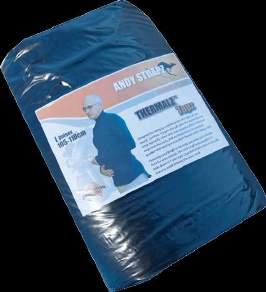
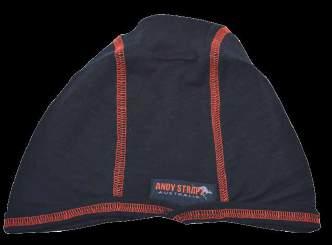
6: A Nekz is superfine merino on the inside, polar fleece on the outside. The big blood vessels in the neck can lose a lot of body heat with the wind rushing over the skin. A scarf or neck warmer of some kind should be considered basic kit for cold riding. Andy makes this one too, and it’s a corker. It turns into a beanie and has stretch cord around the edge for best fit.
7: The Sea To Summit Reactor sleeping-bag liner is an interesting bit of gear. It has a few good functions, but for this discussion, it’ll add about eight degrees to the survival rating of a sleeping bag. It packs up really small and can even be used as a summer-weight bivy bag when it’s warm.
8: “This Helix jacket is one of the best things I’ve ever worn,” beamed Andy. “It’s a wadded wool with a water-resistant outer shell. That makes putting your outer jacket on and off really easy. It blocks wind, it’s very presentable, it’s very well cut…it’s a $300 jacket, but it’s worth every cent.”
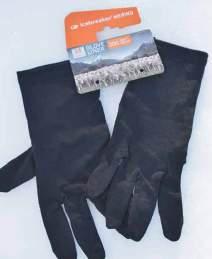
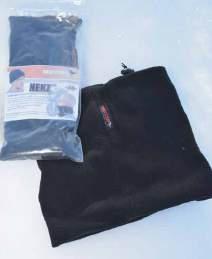
Andy Strapz product, and Andy himself, are well known to Australian riders. Andy’s policy of refusing to sell anything which hasn’t met his high and exacting standards in real-world testing is well known.
“Setting up for the cold depends on the bike and what a rider’s planning to do,” said Andy. “Whether the rider’s after a stop-gap measure to get them through a cold ride or whether they live in a cold place and need to be ready for cold all the time, that’s a big consideration.”
He went on to remember stuffing newspaper down sleeves and jacket fronts, wearing rubber washing-up gloves under regular gloves and other measures used before technology advanced to offer some of the amazing gear available today. His bike set up is aimed at keeping the wind off his head and body, so the screen and Barkbusters Blizzards are important. He’s also a fan of natural fibres rather than synthetics in apparel. The range of products Andy has available for coldweather riding is big. He says it’s almost a ‘sub-specialty’ for his business. Here’s a selection…
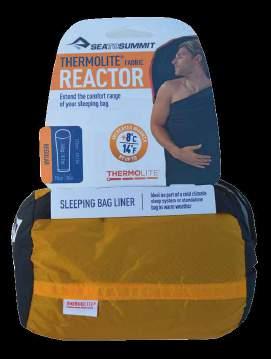
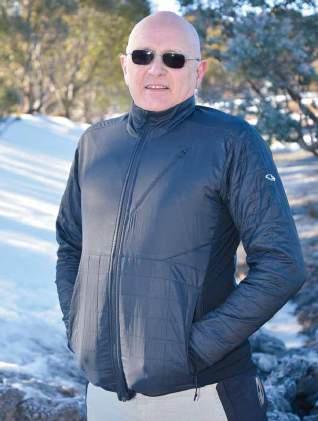
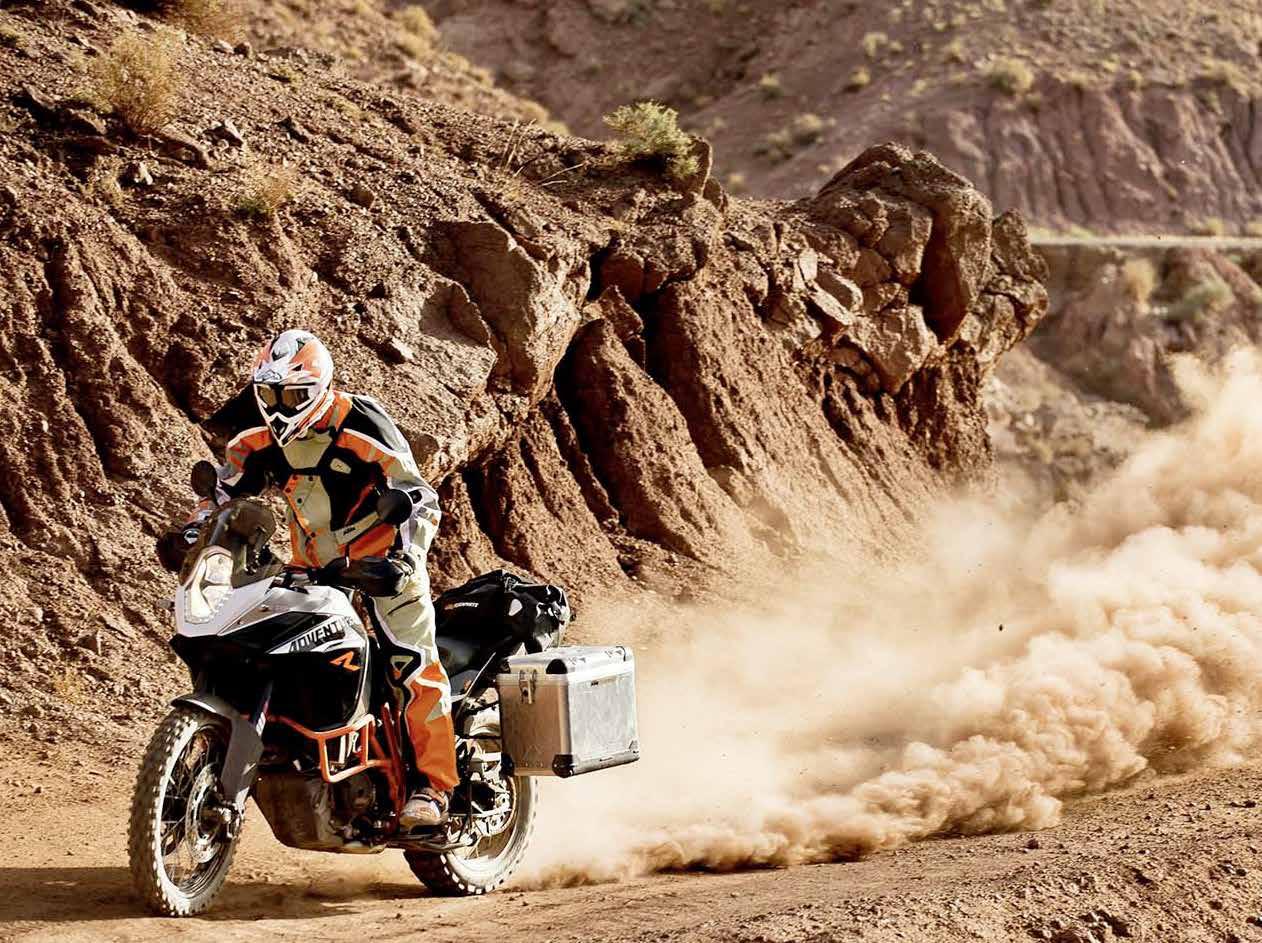
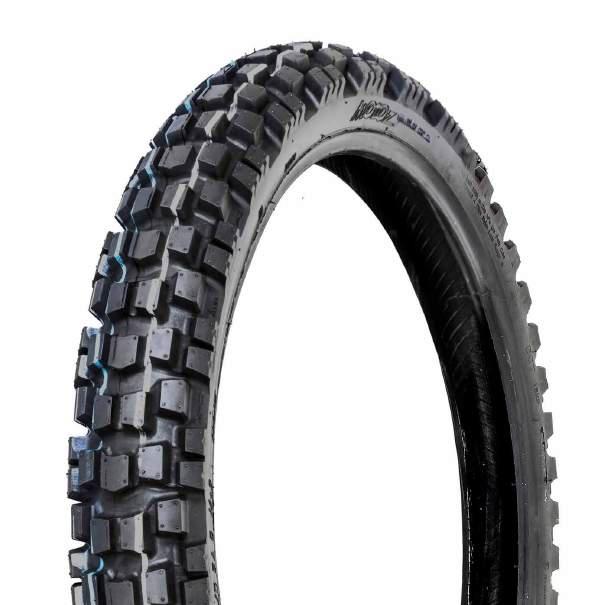
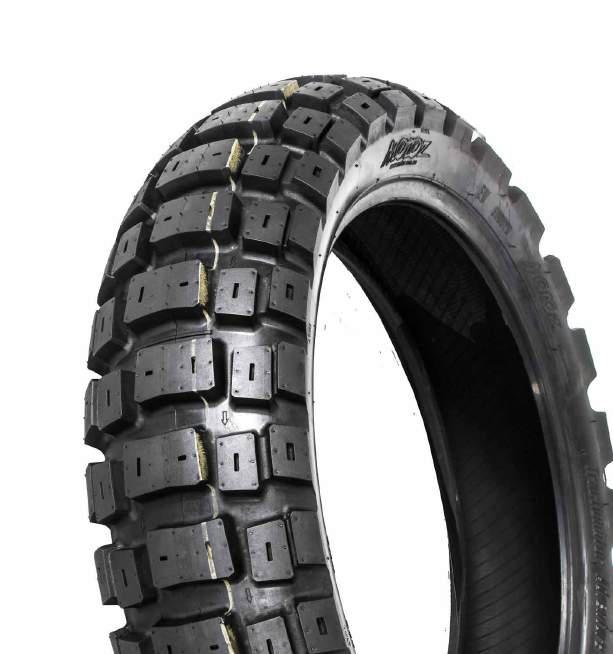
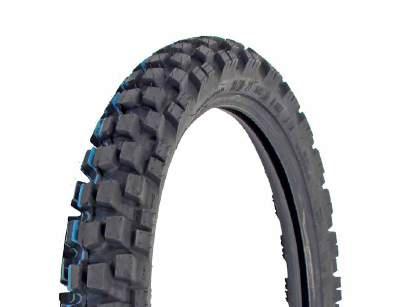
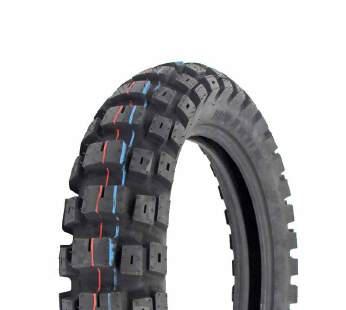

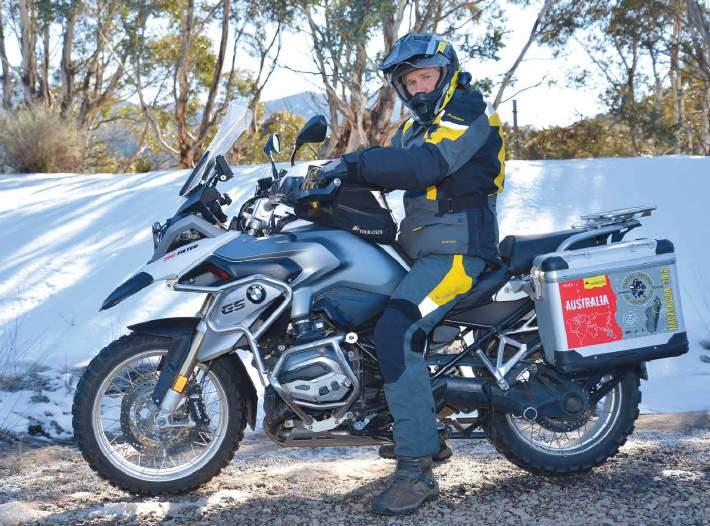
Below: Robin’s Companero is a four-season suit, so although Touratech makes plenty of cold-weather product, the Companero and a few bits and pieces is all he needs, no matter what the weather does. No balaclavas for Robin. “A helmet’s a pretty warm thing if you can stop the wind getting in around it,” he said.
“The Companero was made to fit the wish list of what an adventure rider would want. They want something as comfortable as a pair of jeans, that will cope with extreme heat – like plus 40 degrees – and down to as cold as you’re
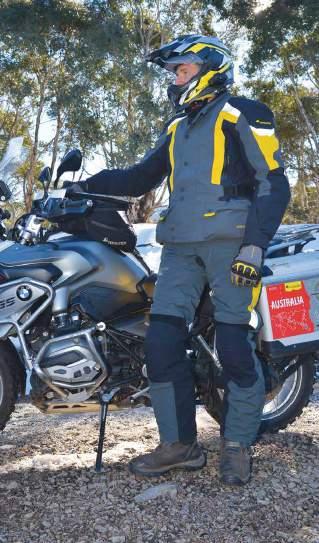
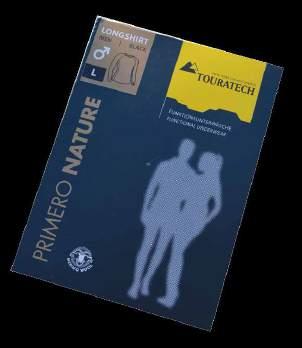
ever likely to be riding in. The Goretex, the waterproof layer, is laminated to the abrasion-protective cordura, the outer layer. The cordura won’t melt, even if you skid down the tar. So you can ride in the rain and you won’t get wet, and you’ll still have excellent protection for a fall.”
Left: For severe cold Robin uses superfine merino thermals. “You’ve got two types of thermals,” he explained.
“There’s synthetic and merino, and they’re both good, but they work differently. The synthetics need to be quite snug fitting, while the merinos need to fit a little looser.”
Below: Winter gloves tend be bulky and reduce feel for the rider. These days, with heated grips, Robin has a different approach. “I use the standard Touratech glove – what call a summer glove. It’s a kangaroo leather with a synthetic back and knuckle protection. If it’s cool I just add a silk inner glove. If it’s raining or extremely cold use a waterproof overglove.”
We’ve summed up Robin Box fairly well in the main story. He’s ridden all around the world and in some very extreme climates, and he’s a thinker who puts concepts, ideas and products to the test before he’ll accept them. He’s very strong on pointing out riders can deal with the cold at very low cost if they’re only looking to deal with a specific ride or situation. Gear from a supermarket or disposal store will get a rider through a tough day or ride. The warm gear used for hiking, or even just layers of nonspecific clothing, will make a cold ride achievable.
Riders looking to be constantly, or often, in the cold are the ones who’ll probably make more expensive purchases. Options like the Companero suit prove their value over long-term use, especially for a serious rider who needs to be prepared for anything, often without warning.
Robin also had a very interesting way of gauging the apparel needed for a day’s ride.
“You can be standing or sitting somewhere, ready to ride and feel okay,” he explained. “So you think you’ve dressed correctly for the day. But if you take a long breath in through your nose, and if your nose gets cold as you inhale and you begin to feel cold inside, you will need to do something to deal with the wind-chill factor when you start riding.
“If there’s no change in the temperature during that long inhale, you’ll be comfortable on the bike as far as temperature goes.”
Robin had more good advice than product, but he did have a few bits and pieces on board…
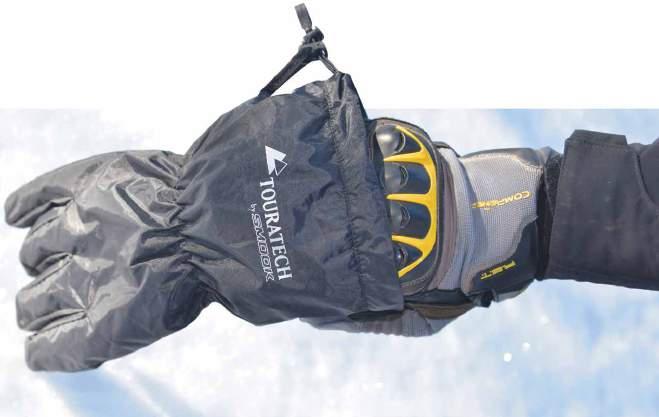
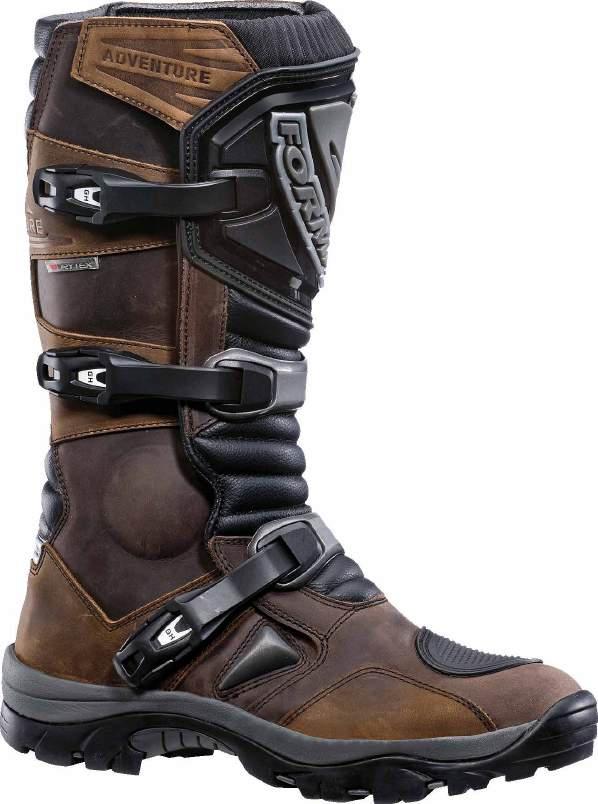
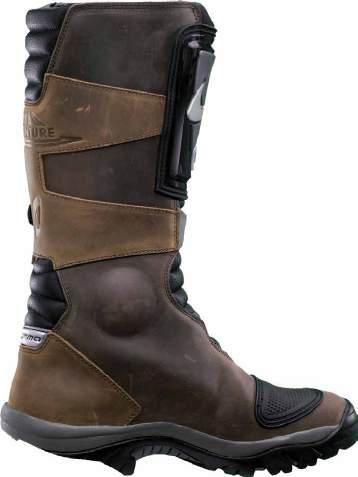
Full-grain
Drytex® waterproof
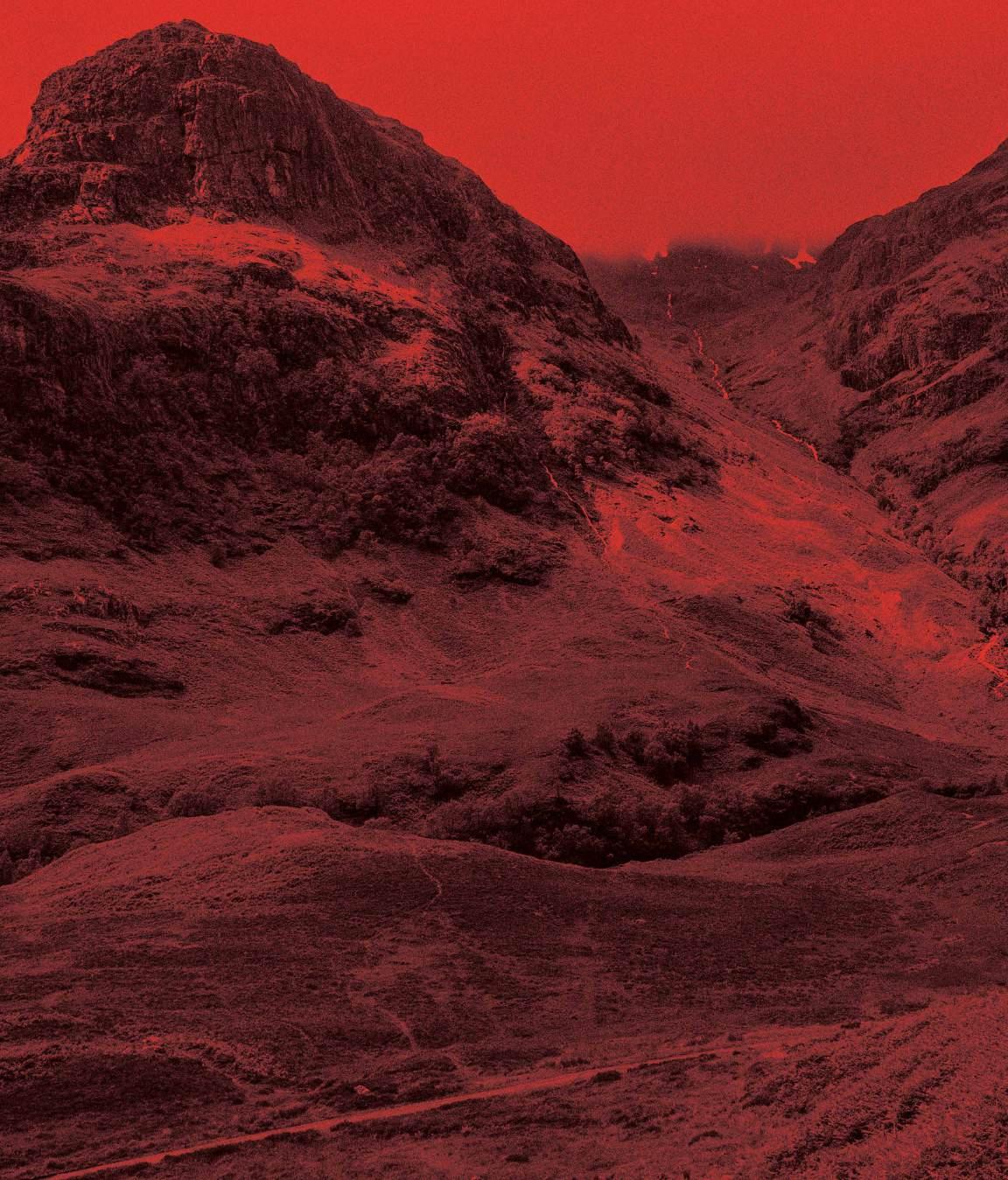

Adventure anti-slip sole Stainless steel shank
Injection molded shin plate
Plastic gear pad protection
Unbreakable GH® buckles
TPU reinforced ankle area
Extra soft polymer padding
Anti-bacterial insole European production
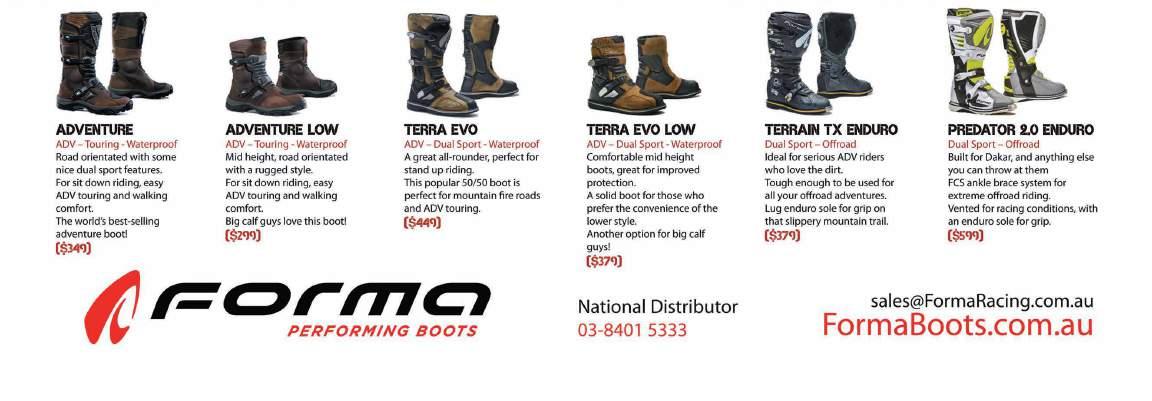
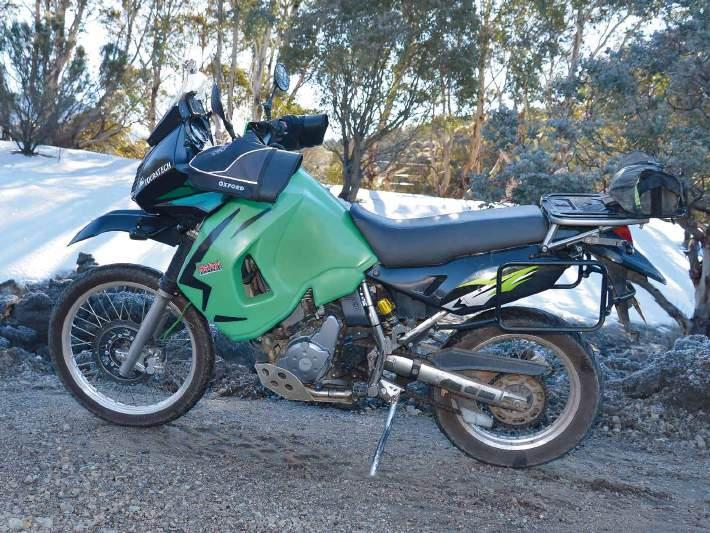
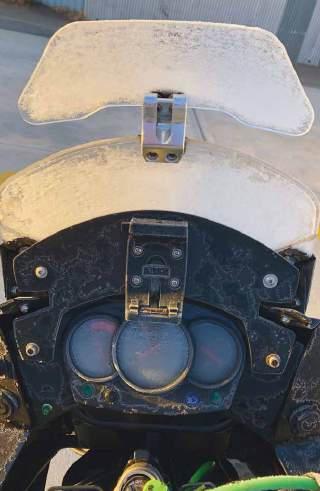
All agreed
Above: The Touratech KLR is set up for covering distance. Part of that is deflecting as much air as possible, and that’s good value in the cold.
Left: The screen is actually a stock KLR item, but it’s elevated, and the aerofoil on the top means the rider’s pretty much shielded from fast-moving air.
Below: TF’s been using muffs – or mitts – for years. They mightn’t look too stylish, but they’re very effective. Below right: Macna Talon gloves and the X.Wed 2 helmet are favourites.
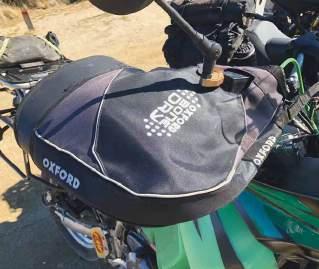
We don’t want to cover too much old ground, but we don’t want to miss important basics of dealing with the cold, either. To keep things tight, here’s a few concepts all riders agreed on or had in regular use.
3 Everyone was layered up. Andy Strapz thermals were a popular choice for a base layer, but one way or the other, everyone had several layers of clothing
3 Everyone had an external waterproof and windproof layer, including either gloves or overgloves
3 All bikes were set up to keep wind off riders. Barkbusters Blizzards were very popular. The editor had the Touratech KLR fitted with the Oxford muffs he’s been using for some years, and Robin had his BMW fitted with Touratech hand guards sporting wind deflectors
3 Heated grips were popular, but not universal. The Boss was half-and-half, because only one of the grips on his DRZ worked.
The editor has a stack of gear and plenty of riding suits, and for this trip he went for the Macna Ivory Pro jacket, Macna Fulcrum pants and a pair of Macna Talon gloves. Under the suit he had Andy Strapz Thermalz, a manky old T-shirt and a neck buff. The X.Wed2 helmet seems a permanent part of his kit these days.
“I have some great suits to choose from,” said the mag’s wordsmith. “I grabbed the first suit that came to hand. Fortunately, the Macna’s a great cold-weather option.
I wore it on a cold ride with RideADV in Lithgow last year. That was really cold, not like this luke-warm pussy run,” he sniggered, not winning any points with the others.
TF said he set up the Touratech KLR for covering distance, and part of that is deflecting as much air as possible. It also means in the cold he can get by with less apparel.
A big screen, Oxford handlebar muffs and the bulbous front end of the KLR make a huge contribution to coping with low temperatures…although he didn’t look too flash with frozen snot on his lip after the night ride back to Jindbyne.
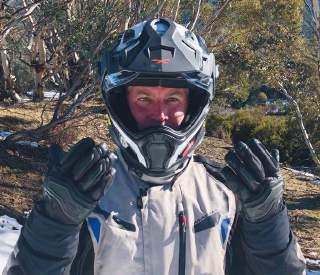
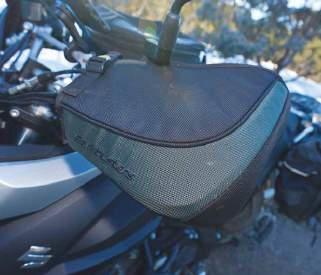

Above: Barkbusters Blizzards were very popular.
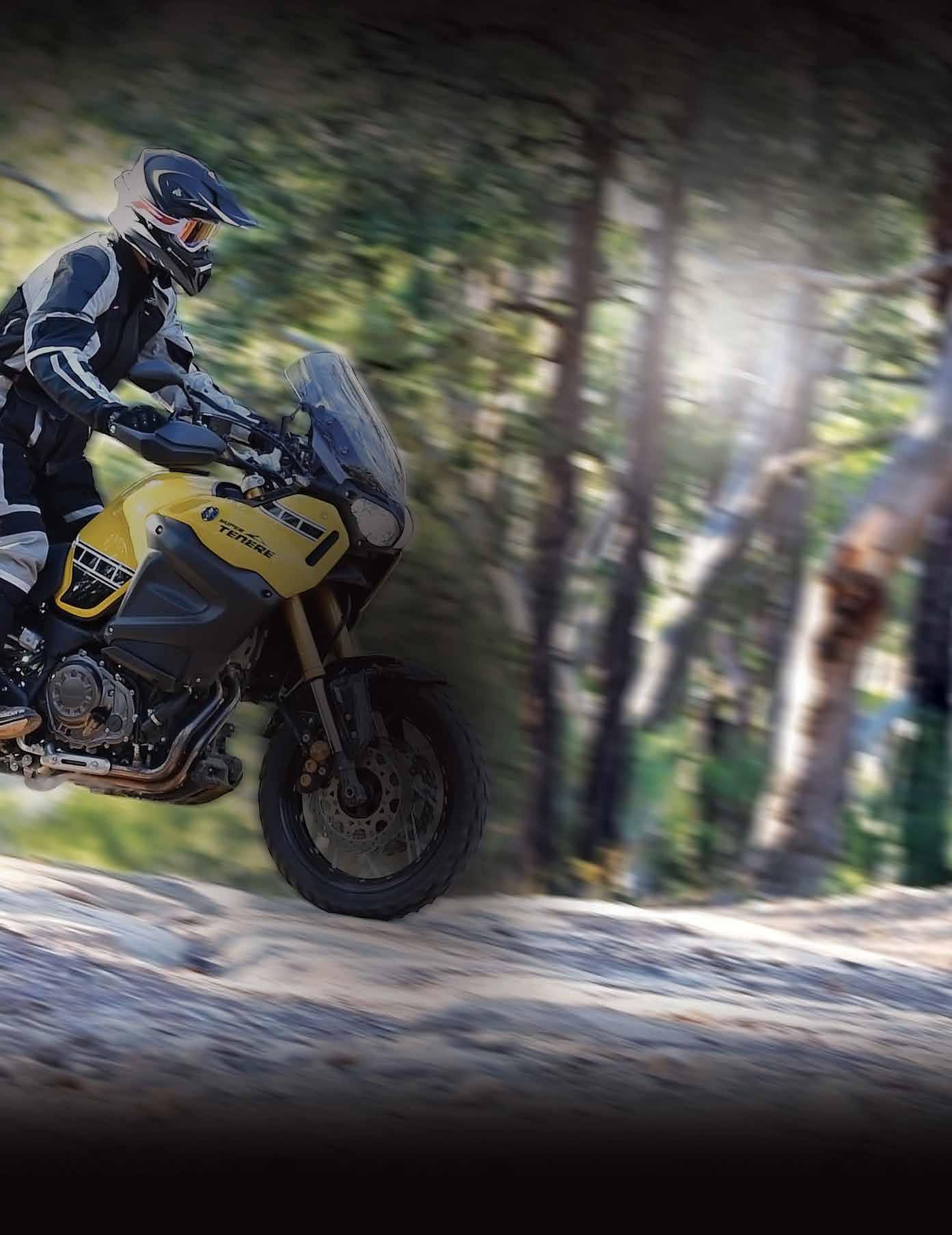
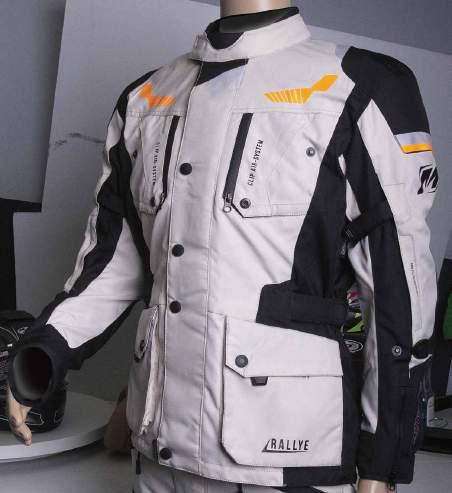



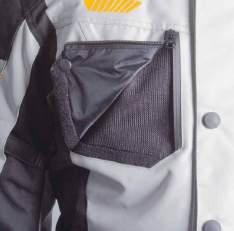
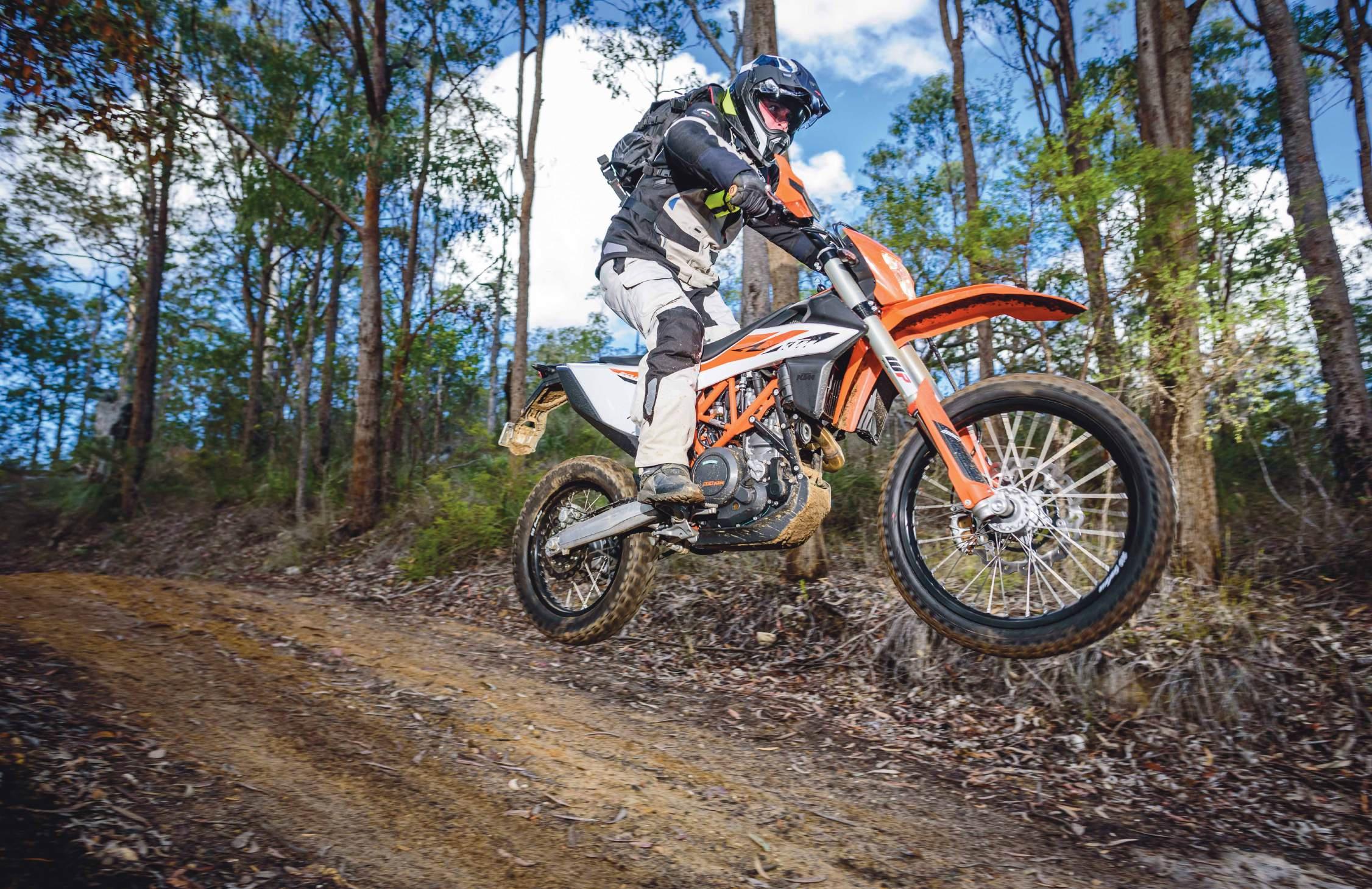
KTM continues its run of amazing bikes. The 690 Enduro R is a wet dream on wheels.
Before we get to the guts of the 2019 690 Enduro R we need to make sure everyone understands what we’re talking about here. This isn’t a comfortable, long-distance adventure-tourer that’ll cope with some trail work. This is a razor-sharp off-road weapon that’ll happily and politely drone along several hundred kilometres of freeway, then, just as effortlessly, frighten the bejesus out of any hard-core enduro bikes silly enough to throw out a challenge on a tough off-road course. Consequently, the bike is slim, the seat narrow and hard –but surprisingly comfortable – the riding position aggressive and the performance…oops. Just thinking about it has caused a wet patch on our office chairs.
Are we exaggerating?
No. The 690 Enduro R is that good.
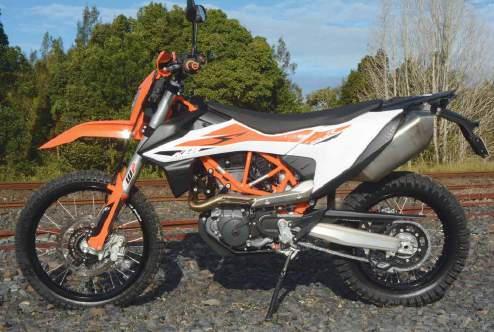
In a nutshell
The 690 has had a few ups and downs over the years. Clogged fuel filters and fuel-pump glitches in the early models got plenty of space on web forums, but we knew plenty of owners who had a trouble-free run. The performance of the various 690s was beyond question though, and the new model has set the standard even higher.
“ The KTM was clearly dirt-focussed, but the overwhelming majority of adventure riders will need their bike to do some bitumen distance.”
The motor is still a 690cc, liquid-cooled single with the two oil pumps we’ve seen on the LC4 motors for quite a while now. KTM claims the engine is ‘the world’s most powerful production mono engine’ and we’re not going to argue. Power output is 74hp with 73.5Nm of torque. We thought the Husky 701 had similar figures, but no doubt KTM would answer it’s basically the same engine. The 2019
Top right: The tougher things get, the better the 690 performs.
Below: Colour-coded clickers for compression on one fork leg and rebound on the other.
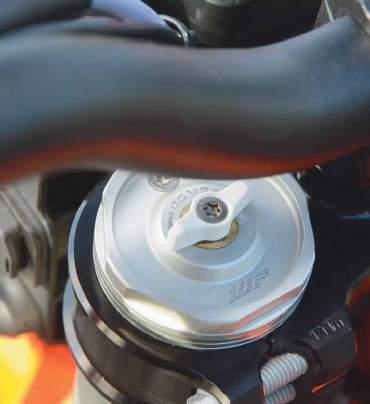
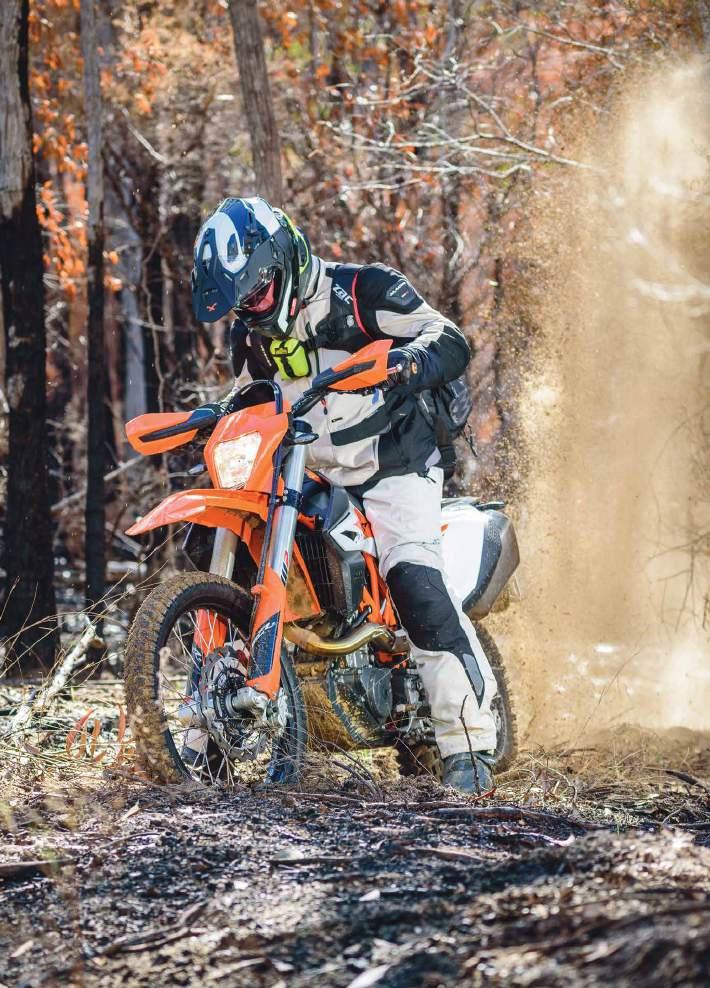
690 does have a couple of modes called ‘Street’ and ‘Offroad’ in the marketing material but showing on the bike as simply ‘1’ and ‘2’, and the electronics include lean-angle sensitivity on both ABS and traction control.
Suspension is adjustable both ends, as would be expected in a bike offering this kind of performance. The front sports a WP Xplor fork with split-damping system – which we think refers to compression on one leg and rebound on the other – while a WP Explor shock takes care of the rear.
There’s a fair bit going on around the bike and we’ll look at things as we go, because we’re busting to tell about riding the thing.
We had always intended to do road kilometres on the 690 because that’s what happens with adventure bikes. The KTM was clearly dirt-focussed, but the overwhelming majority of adventure riders will need their bike to do some bitumen distance. We were lucky enough to find photographer Danny Wilko available, so we set out on a sunny, gorgeous winter morning to a rendezvous about 100km up the road. We figured that’d give us an idea of the 690’s asphalt manners. We scurried along some country backroads and found the bike every bit as capable as we expected it to be. Rough, crap, secondary roads presented no problem whatsoever. The suspension
u
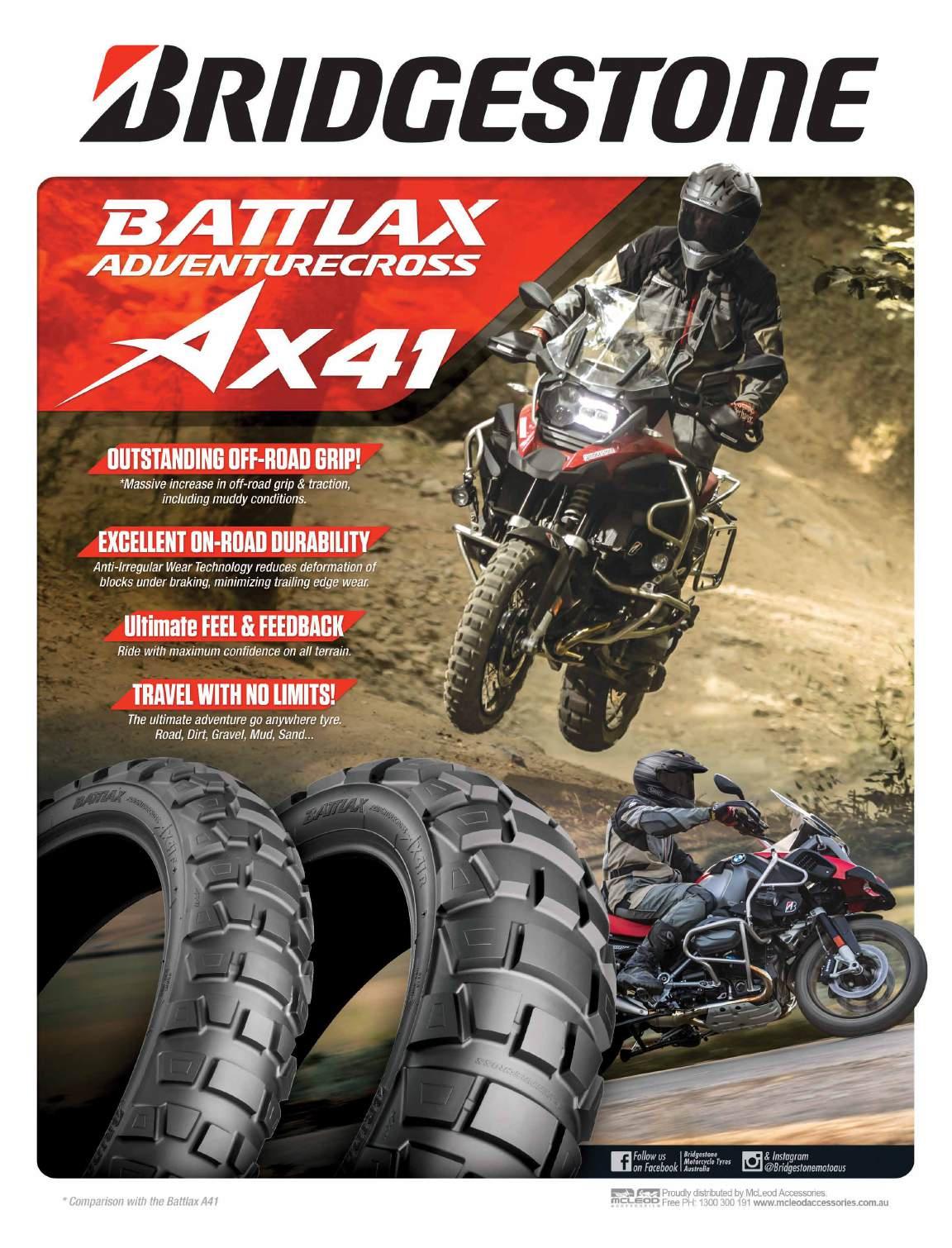

was hard, but it worked well, braking was fantastic, though very strong on the rear, and clutch and gearbox were as smooth as. The only aspect of the bike which caused us any discomfort was the number ‘1’ setting on the modes. It makes the throttle just a little aggressive and grabby. Getting through towns and in low-speed zones throttle response became noticeably snatchy. The solution was to select mode ‘2’, which calmed everything down nicely and became our choice for all road riding.
It’s worth mentioning changing between modes is as simple as thumbing the button on the left-hand ’bar. The lit number flashes a couple of times, then, with the throttle closed, it swaps to the other mode. Simple as that, stationary or on the fly.
One interesting facet of the 690’s operation is that when the key is turned on, the ABS and traction-control lights come on and stay on. They stay lit until the bike’s moved a couple of metres and the sensors pick up where everything’s at. It made no difference to anything, it was just interesting.
But then came the part of our rigorous and relentless testing program we always dread: the freeway. The seat on the 690 is quite flat front-to-
rear, and narrow. There’s no screen and the ’pegs are in a position to give excellent advantage to a rider standing up. We gritted out teeth and set our minds to coping with a tough 50km or so, but as it turned out the KTM was surprisingly comfortable. We kept pace with all the other law-abiding citizens and found very little windblast, lots of room to move around on the seat and an amazingly willing motor. Sitting on 110kph was effortless. Those traits all made the freeway section quite enjoyable.
“ That meant a very useful 320km or so from the 13.5-litre tank on road rides.”
We rolled into the rendezvous only to find a text from Wilko to say his flash new 790 had a flat, and the thought of another 70km or so on the road was actually quite pleasant.
The 690 is unquestionably a good option for covering road distance, and no doubt the Mitas 07s, standard on the bike, played their part in that. They’re a
very smooth-rolling option compared to a full knobby. We were surprised to see fuel consumption of something like 24km per litre for that part of the ride. It seemed too good to be true, but we checked it on the home run and had the same result. That meant a very useful 320km or so from the 13.5-litre tank on road rides.
The 690 was certainly amiable on the road, but once it hit the dirt all bets were off. It’s where the bike shines, and it shines very, very bright. It’s hard to know where to start.
The suspension which had seemed a little hard on the road was frigging glorious. Every erosion mound was a cause for celebration and rough, offcamber corners were a bonus. Both front and rear soaked up everything we could throw at them, and it was obvious the bike was ready for far faster, tougher riders than us.
The motor was a rorting, snorting gift of point-and-shoot lunacy. Seriously, we were left wondering if we’d allowed ourselves to get way too far out of touch with good competition bikes. We can only
Above: KTM’s competition heritage and focus is very obvious. u
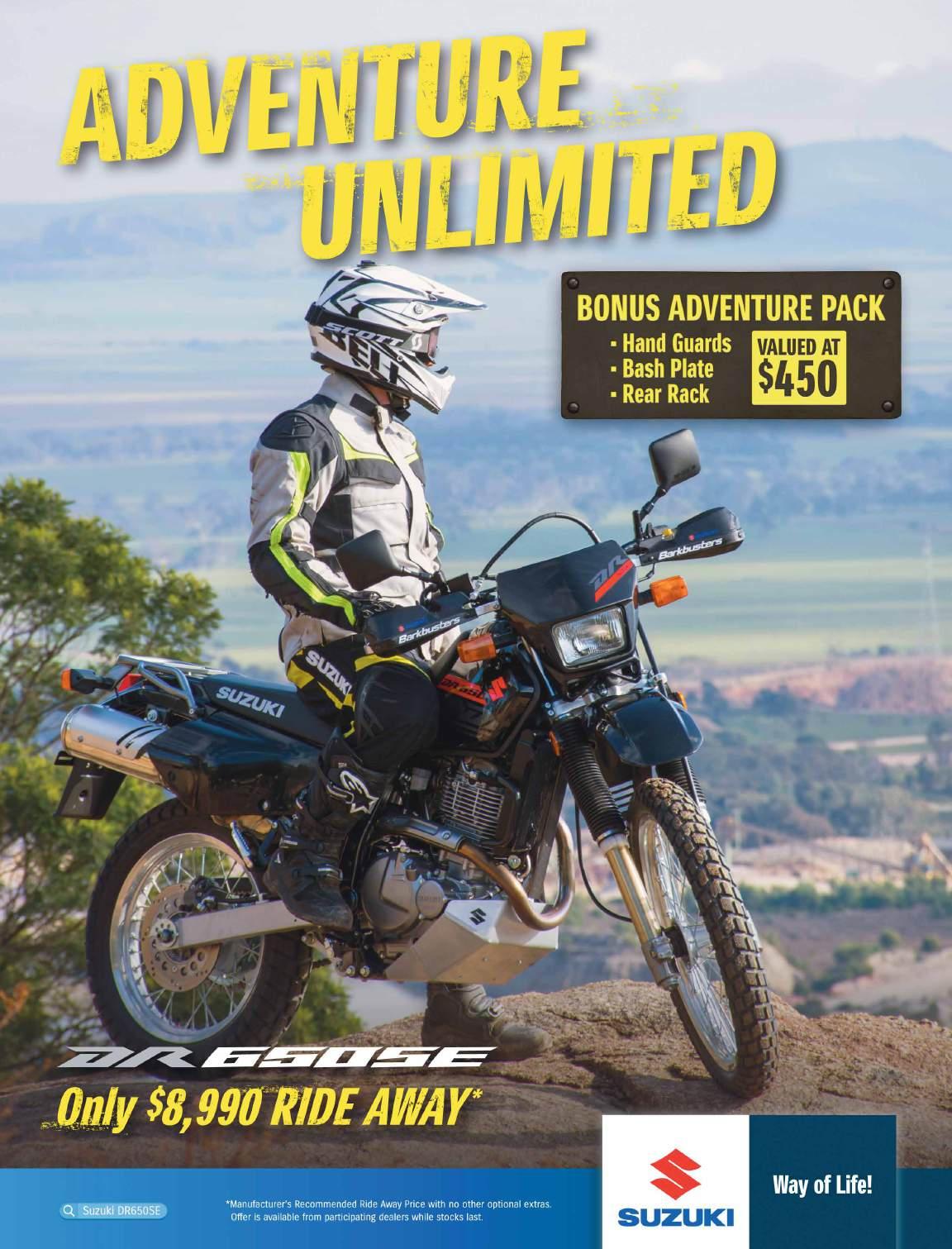
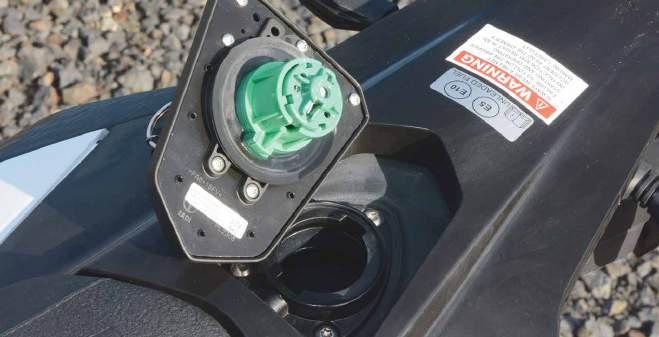
Above: We’ve had past owners tell how the dirt sits all around the cap waiting to fall in the tank when the cap’s removed. It’s fairly horizontal, so we made sure we blew the dust away before opening.
Right: The rear of the bike is snag-free, but there’s no grab handles or any way of attaching luggage. There’s an indent in the plastic tank on one side under the edge of the tank that makes for a hand hold to haul the back of the bike around.
Below: Mechanically the bike is totally comfortable chasing far horizons. Fitting luggage for long distances might take some thought, though.
imagine – and drool a little at the thought – what KTM’s current crop of two-stroke EXCs must be like.
In any case, back in the real world, with the traction control off and mode 1 selected the 690 rocketed through the bush, throwing its front wheel up, hanging the rear out at the turn of the throttle and hurling itself off rock steps and erosion mounds at every opportunity. At speed over rough ground? Forget about it. The thing’s a missile.
We also tackled some deepish, wet, slimy clay, and in mode 2 with the traction control off were able to show some impressive control. The throttle is very sensitive and easy to use and the motor’s response excellent.
While the bike really was incredible, there were couple of things we, as hard-bitten, not-easily-distracted adventure riders, noticed. The first is there are no grab handles or frame rails or much of anything else on the rear of the bike, so trying to strap anything to it will be a bit of a challenge. As far as we can tell looking at KTM’s media information there’s no OEM luggage or rack being offered either. There’s a tankbag, and we expect Giant Loop-type bags would strap down to the pillion ’pegs without a problem, or an Andy Strapz AA Bagz with some creative mounting

maybe, but that style of luggage will cover the fuel cap, which is half a pain. We’d also be wary of the sidecover pushing on to that whopping muffler. The other niggle we had during our time with the bike was the traction control refused to turn off after a while. We’d love to be able to say we were just so hard on the bike it couldn’t cope, but we very much doubt the bike was ever challenged by anything we asked of it. It certainly didn’t seem to be trying hard no matter how close to exhaustion we were.
u
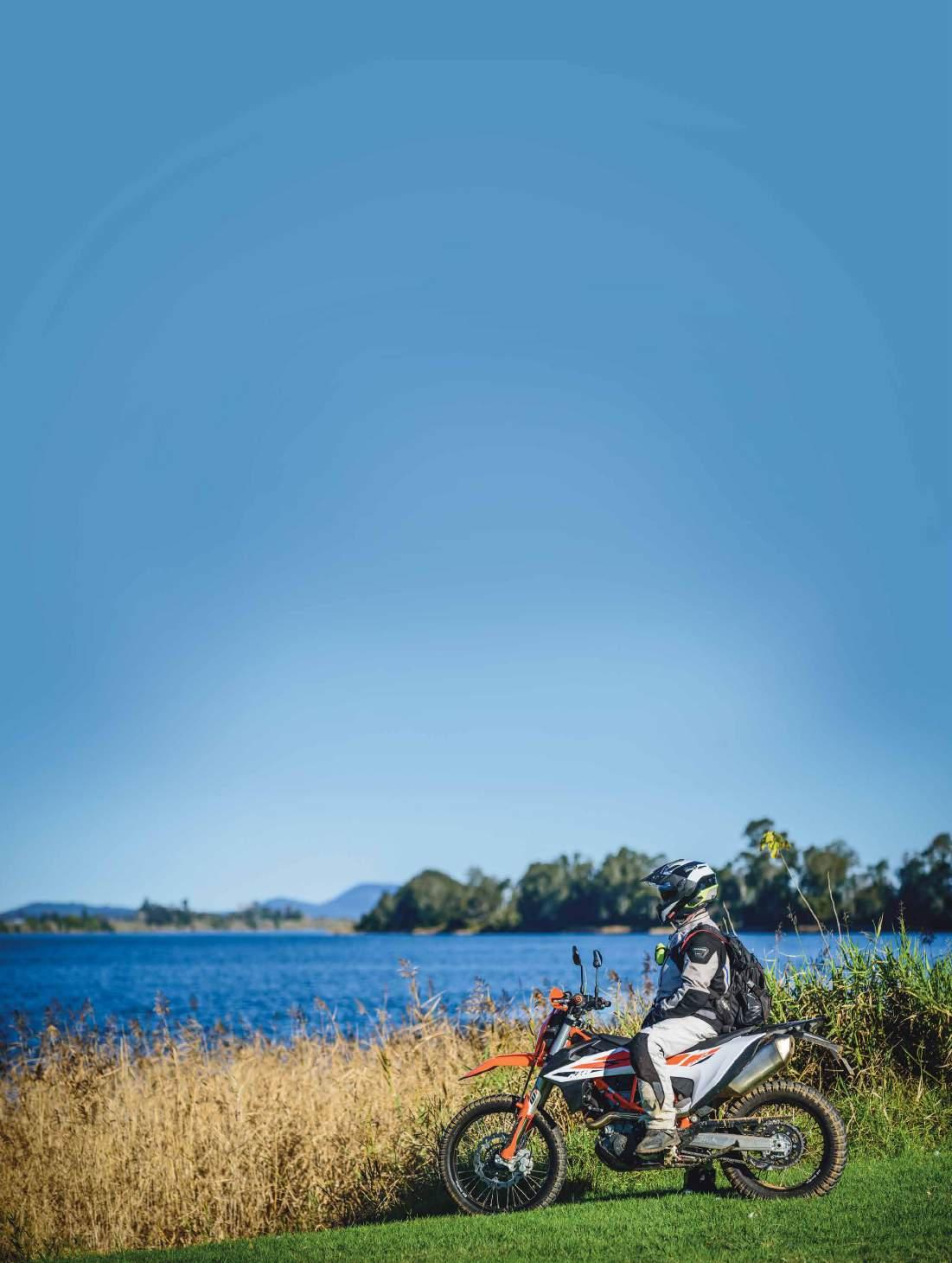
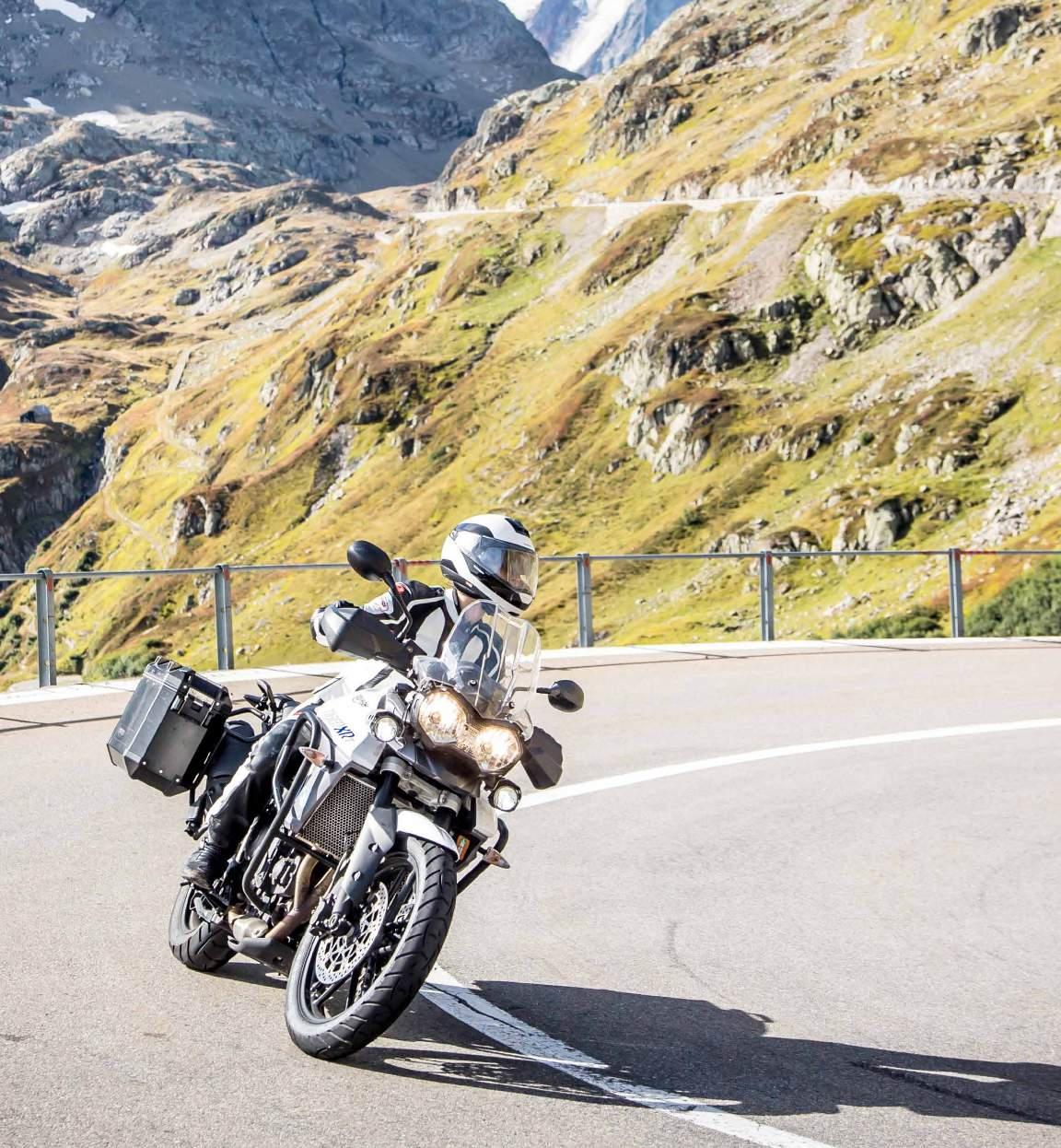
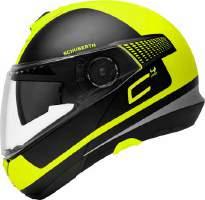
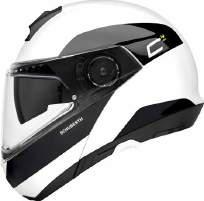
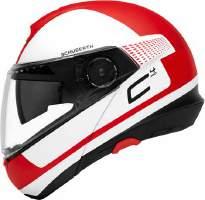
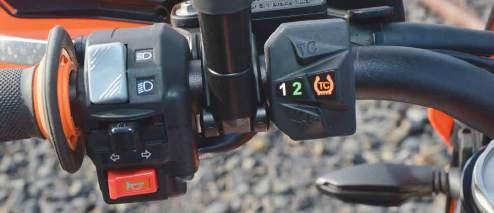
Above: The switches for the modes and traction control are a strange shape. They’re the triangles above and below the illuminated numbers in this image. Below: The instrumentation looks the same as we remembered it on previous models. It’s functional and does its job, and the owner doesn’t have to panic about the replacement cost of a TFT screen.
This was just a weird little gremlin.
The switching for the modes and traction control is a funnyshaped rubbery arrangement, and suddenly it didn’t seem to matter hard we tried, the traction control just wouldn’t switch off. Because of the funny shape of the switch we tried without gloves, and we tried all different angles, but it just stayed on. We put in a call to Rob Twyerould, KTM’s head tech man, and he suggested disconnecting the battery for 20 seconds. We did that, but nothing changed. Then, as we were demonstrating to another rider how the thing was stuck on, it just started working again. We didn’t have any further trouble with it. That’s it. Everything else about the 690 was superb.
We know we’ve raved on about this bike, but we don’t feel we’ve said anything it didn’t deserve. If you’re looking for a strong, aggressive, dirt-oriented adventure bike, the 690 Enduro R is an absolute lock-down winner.
We didn’t talk about braking, clutch, gearbox and other things we normally cover, because they’re all as good as we’ve come to expect from KTM, and that means absolutely top-notch. The slipper clutch is extra light and beautiful to use, and while we’re not convinced about the need for a quickshifter on an off-roader, there’s no doubt it makes fast gear changes even easier. The ABS seemed good to us and was really easy to switch on and off, and the ignition modes and the variations they gave in other systems were great.
But it’s the heart and soul of the bike that won us over. It’s so damned ready to attack and conquer it’s just a hear-breaker. That it’s so capable on the road over distance is a huge asset of course, but in the dirt with the throttle wide open and the terrain getting rougher by the second…that’s home turf for the 690. And when it’s at home, it rules.
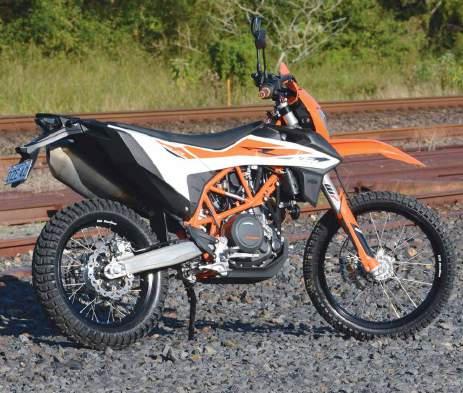
Web: www.ktm.com/au/
Recommended retail: $15,995 plus ORC.
Engine type: Single-cylinder four-stroke
Displacement: 690cc
Bore/stroke: 105mm x 80mm
Power: 74hp (55kW) @ 8000rpm
Torque: 73.5Nm @ 6500rpm
Compression ratio: 12.7:1
Starter/battery: Electric/12V 8.6Ah
Transmission: Six gears
Fuel system: Keihin EFI (throttle body 50mm)
Control: 4V/OHC
Lubrication: Pressure lubrication with two oil pumps
Cooling: Liquid cooling
Clutch: PASC slipper clutch, hydraulically operated
Engine management system/ignition: Keihin EMS with RBW, double ignition
Traction control: MTC (two-mode, disengageable)
Frame: Chromium-molybdenum-steel trellis frame
Subframe: Self-supporting plastic tank
Handlebar: Aluminium, tapered, Ø28mm/22 mm
Front suspension: WP-USD Ø48mm
Rear suspension: WP shock absorber with Pro-Lever linkage
Suspension travel front/rear: 250mm/250mm
Front brake: Brembo two-piston floating caliper with Ø300m disc
Rear brake: Brembo single-piston floating caliper with Ø240mm disc


ABS: Bosch 9.1 MP (incl. cornering ABS and offroad mode, disenegageable)
Wheels front/rear: Spoked wheels with aluminum rims, 1.85 x 21-inch;
2.50 x 18-inch
Wheelbase: 1502mm
Ground clearance: 270mm
Seat height: 910mm
Fuel tank capacity: Approximately 13.5 litres Dry weight: 146kg
Weight (fully fuelled): 158.6kg
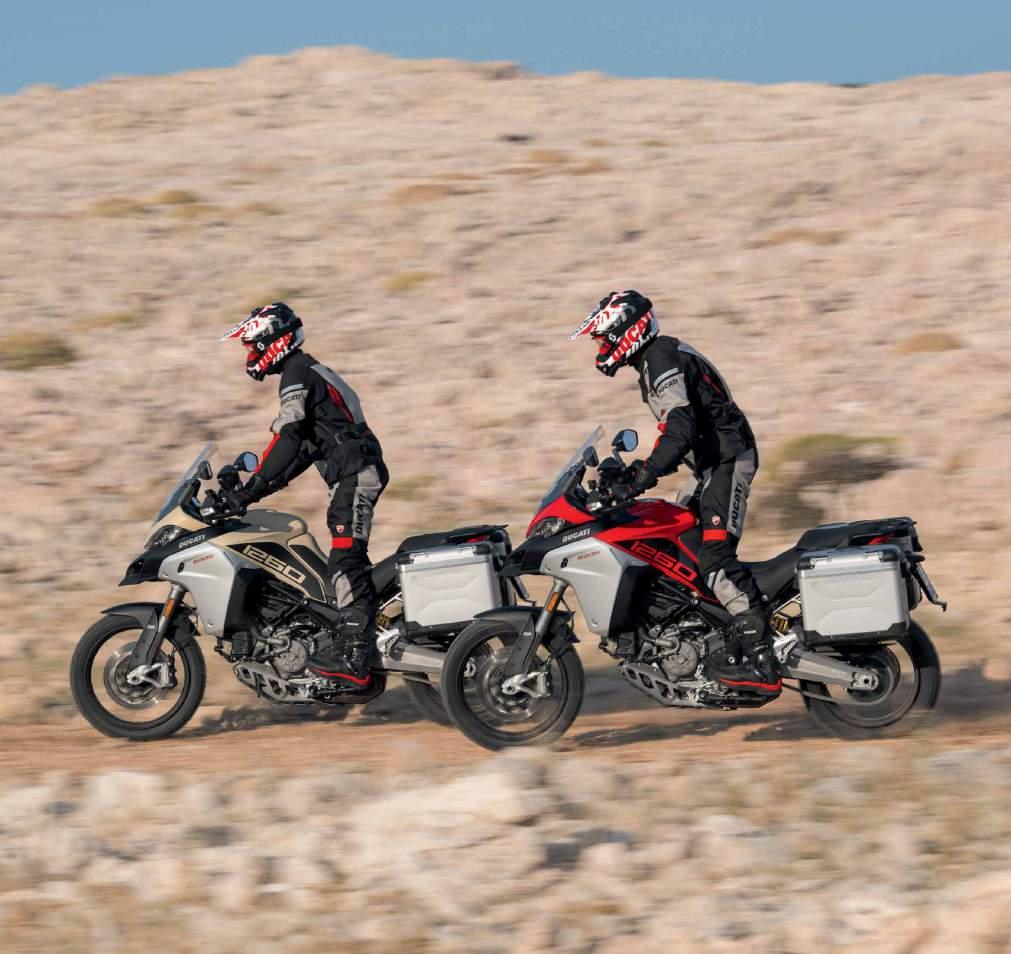
Avoid simply travelling. Exceed your boundaries with the Multistrada 1260 Enduro, the new Travel Enduro from Ducati. Thrilling performance is guaranteed thanks to the substantial torque supplied by the 1262 cc Testastretta DVT engine, always at the ready. Redesigned ergonomics ensure comfort and control in all conditions. A high-res dashboard with new graphic interface allows you to make simple and intuitive use of the numerous adjustment options, for a configuration to best suit your needs.
Avoid simply travelling. Exceed your boundaries with the Multistrada 1260 Enduro, the new Travel Enduro from Ducati. Thrilling performance is guaranteed thanks to the substantial torque supplied by the 1262 cc Testastretta DVT engine, always at the ready. Redesigned ergonomics ensure comfort and control in all conditions. A high-res dashboard with new graphic interface allows you to make simple and intuitive use of the numerous adjustment options, for a configuration to best suit your needs.
No destination will seem far enough on board the new Multistrada 1260 Enduro. Let yourself go beyond your boundaries.
No destination will seem far enough on board the new Multistrada 1260 Enduro. Let yourself go beyond your boundaries.
For information on all services, visit www.ducatiforyou.com
The Savannah Way connects two of Australia’s most popular tropical getaway destinations: Cairns – gateway to the Great Barrier Reef in FNQ on the east coast – and the pearling hub of Broome in northern Western Australia on the west coast. With just under 4000km through some incredibly remote locations, it can be a very challenging journey. Compass Expeditions’ Jerry Cook covers some highlights.
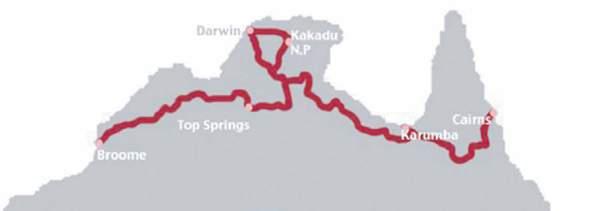
Dakar legend Simon Pavey, along with UK Off Road Skills instructor Neil Hawker, were in Cairns to lead a 21-day motorcycle tour to Broome with riders from New Zealand, the UK, South Africa and different parts of Australia. Bikes were from the BMW GS range – and a lone Suzuki DR650 –and support staff from Compass Expeditions included Victorian paramedic Sarah Taylor and me as support driver. Sarah and I travelled with the group in a customised Toyota LandCruiser, suitably named ‘Truckasaurus’, and pulled a trailer that carried the necessary supplies for the trip. This included the riders’ luggage, camping equipment, spare parts, tyres, first-aid equipment, food and water. Truckasaurus was fitted with GPS tracking, satellite phone and CB radio, making it a very suitable support vehicle for a trip of this nature.
Riders and bikes went through the final stages of preparation then left behind the restaurants, bars, beaches and comforts of Cairns to hit the Atherton Tablelands and Gulf country on the first ride day. It takes time to fully appreciate these spectacular regions. Riders must get off the bike and explore the attractions that draw people from all over the world. We marvelled at the world’s longest lava tubes in Undara and took a boat ride in the ancient geological formation of Cobbold Gorge. It was there we had our first encounter with local residents, the freshwater crocodiles.
Karumba, a major fishing destination and industrial port in the Gulf of Carpenteria, and was the first overnight stop. With a population of under 1000 it seemed there were more kangaroos and wallabies
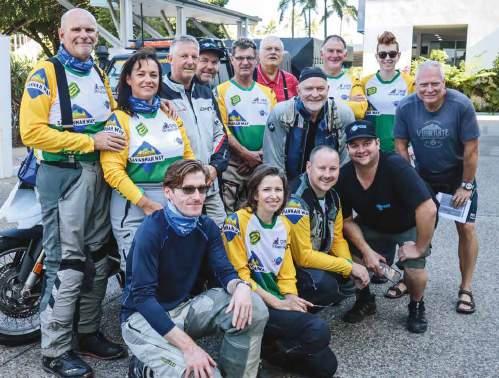
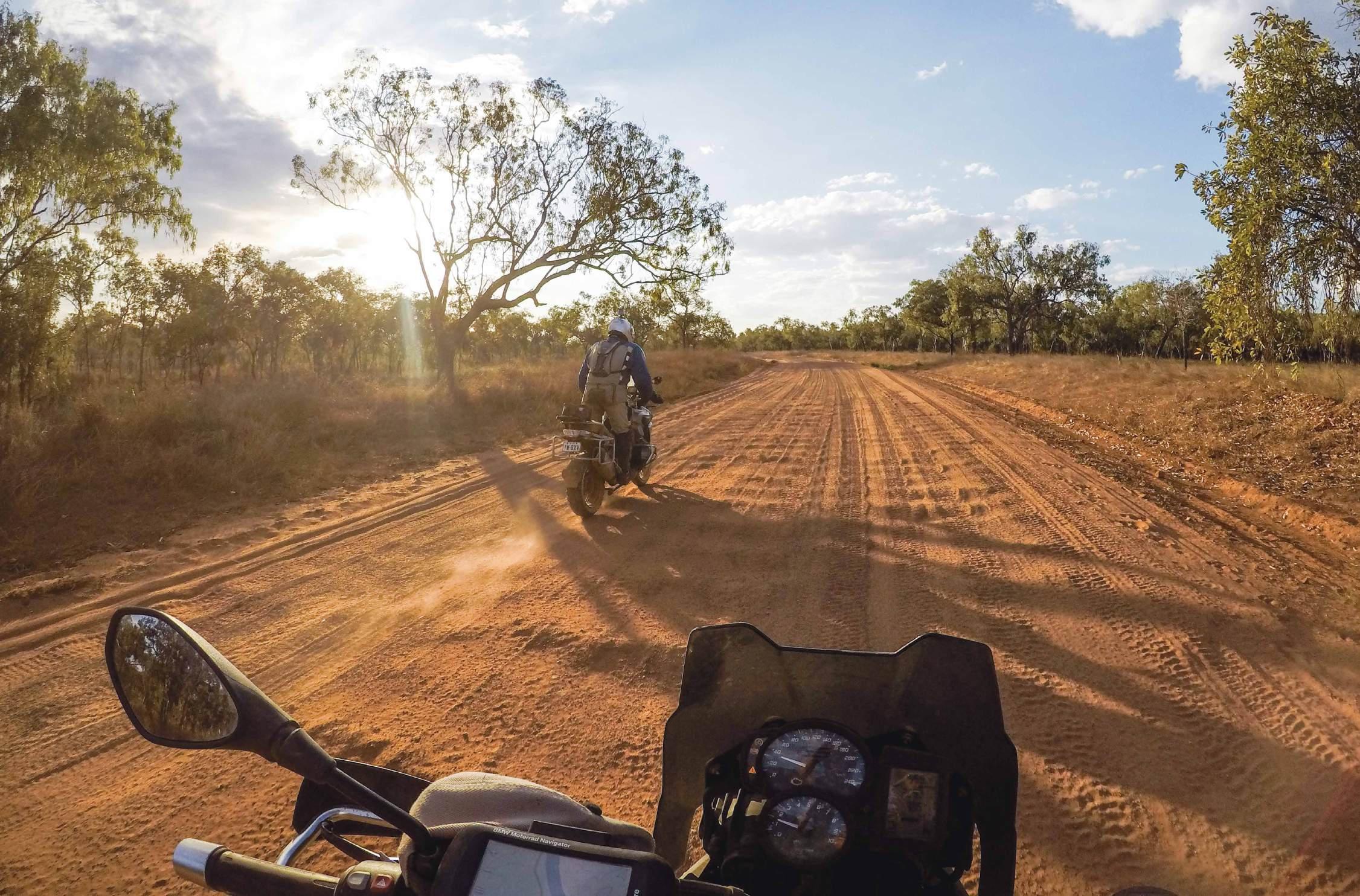
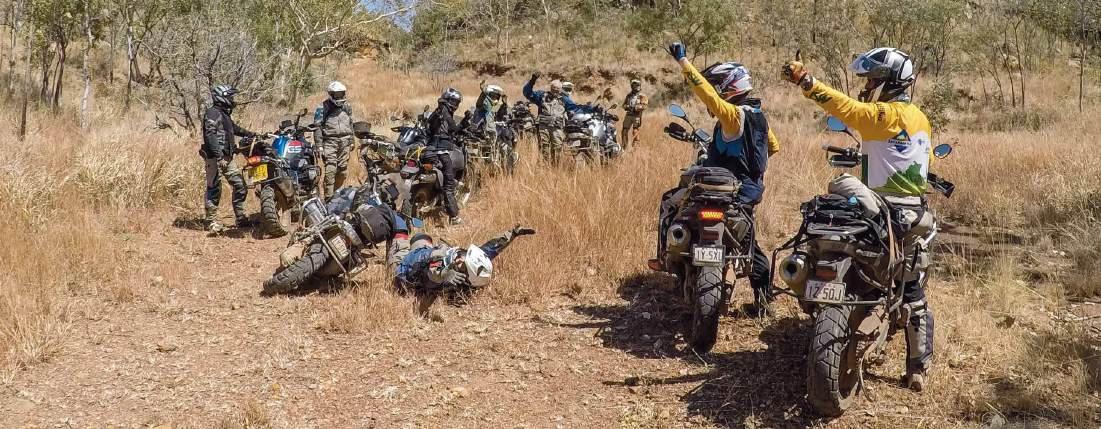
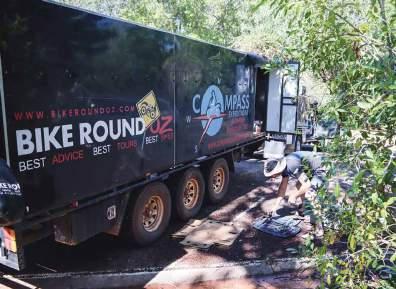
than people as we rode into town. We tried the fresh local prawns while enjoying a cold beer at the pub and took in one of the best of the many sensational sunsets seen on the tour.
Boned up
Riversleigh in Queensland is home to Australia’s most famous fossils and a World Heritage-listed site. It’s interesting to see remains of ancient mammals, birds and reptiles that roamed the area millions of years ago.
After riding through the Savannah country, littered with termite mounds and a harsh outback sun pushing temperatures into the high 30s, it was a
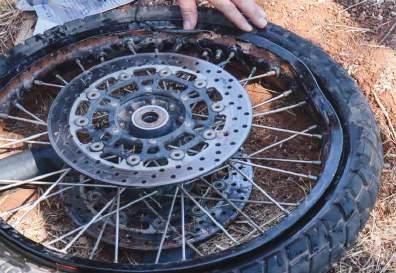
Below
Bottom
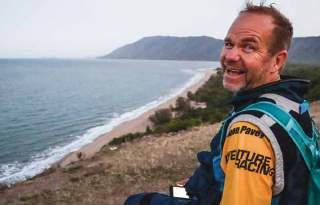
delight to arrive at Lawn Hill Gorge and enjoy an afternoon canoe ride. It was the perfect way to cool down after a dusty day’s riding and the overnight camp was at nearby Adel’s Grove.
Originally gazetted as a miner’s homestead lease, in 1920 Albert de Lestang took up the property as an experimental botanical garden, making it a very beautiful place to camp.
Spring time
As the end of the first week approached the tour was ready to enter the Northern Territory.
With a population of 250,000, ‘The Territory’ has some of Australia’s most beautiful National Parks. It’s also home to many laid-back and interesting characters, and maybe that has something to do with them drinking over three times the world’s average of alcohol each year. The day’s ride was over 500km and travelled past an outback roadhouse called Hell’s Gate. It did seem like the entrance to Hell as the temperature was incredibly high and bushfires on a nearby property had local landowners worried.
In Borroloola the trailer experienced the first of its mechanical problems.
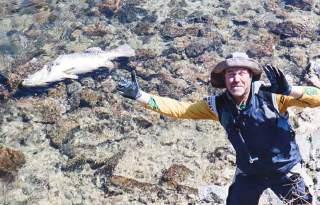
The corrugation had taken its toll on one of the roller rocker arms, and it wasn’t the only vehicle with problems. Local mechanics were booked out for days with repairs to 4x4s, trucks, trailers and caravans. The roads out there are tough on all vehicles.
Replacing the trailer rocker became a job for the support crew. With no workshop available, the work was done on a patch of grass under the shade of a gum tree, and after a few hours of sweaty labour the show was back on the road and left town around midday. Alcohol is a real problem in the outback and a random breath test in the middle of the day is quite the norm. Luckily, we hadn’t started early on that day because I was tested on the way out of town. We reunited with the group at the overnight stop in Lorella Springs, a massive property of over 4000 square kilometres, 29km north of the Savannah Way. The ride into the homestead provided
Street. Dirt. Adventure. Touring. Whether your ride of choice is tarmac or trail — or equal parts of both — Arai has the perfect helmet for all of them the XD4. Renowned for years as the industry standard for comfort, quality and protection, the XD4 features Arai’s proprietary FCS ® cheek pad design, class-leading venting, a fully removable and washable interior, and a sleek shell shape and high-flow peak and side cowl vents that deliver excellent aerodynamic stability at street speeds.
The Arai XD4. Standard- setting performance, on road and off.
u
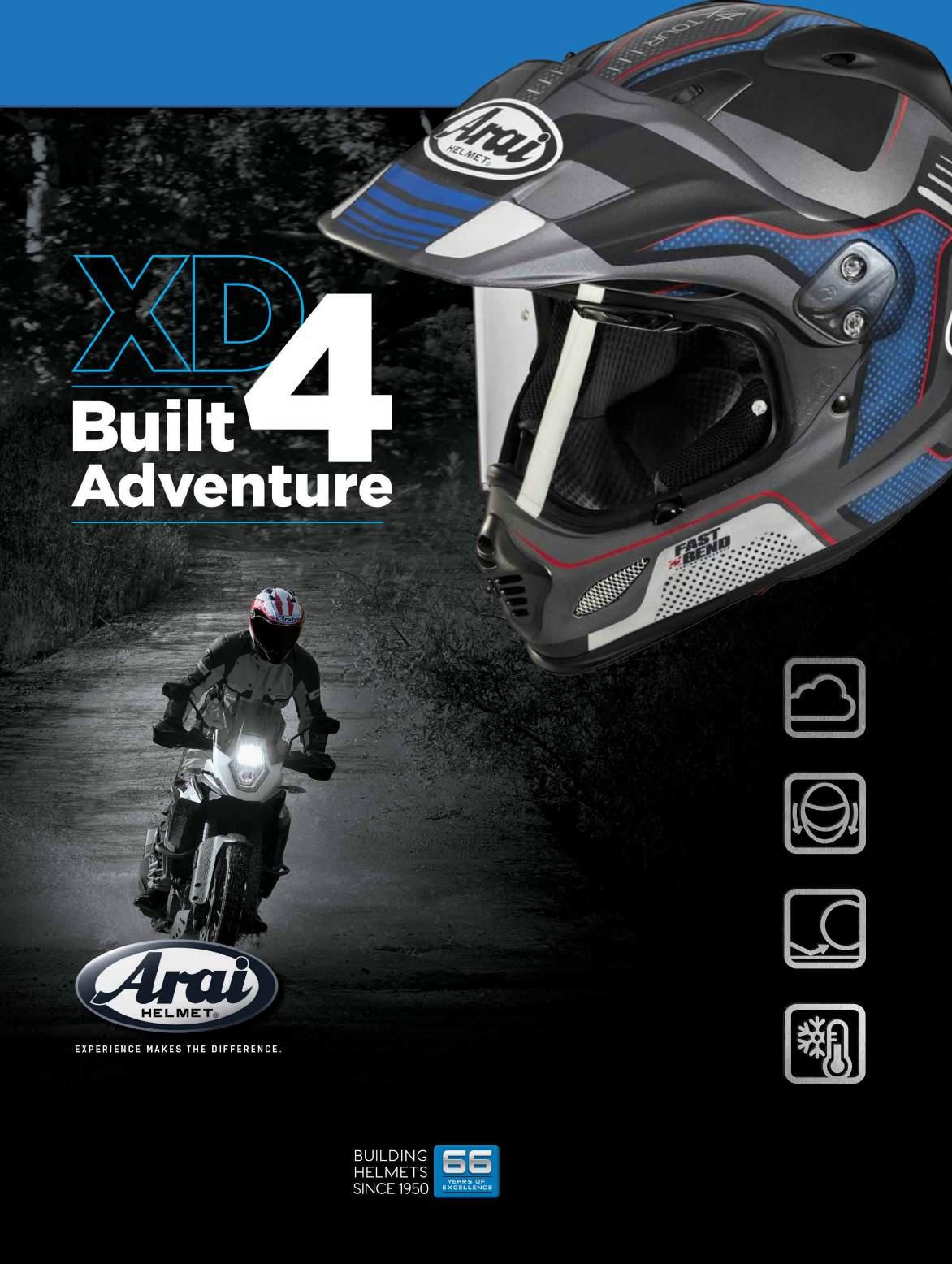
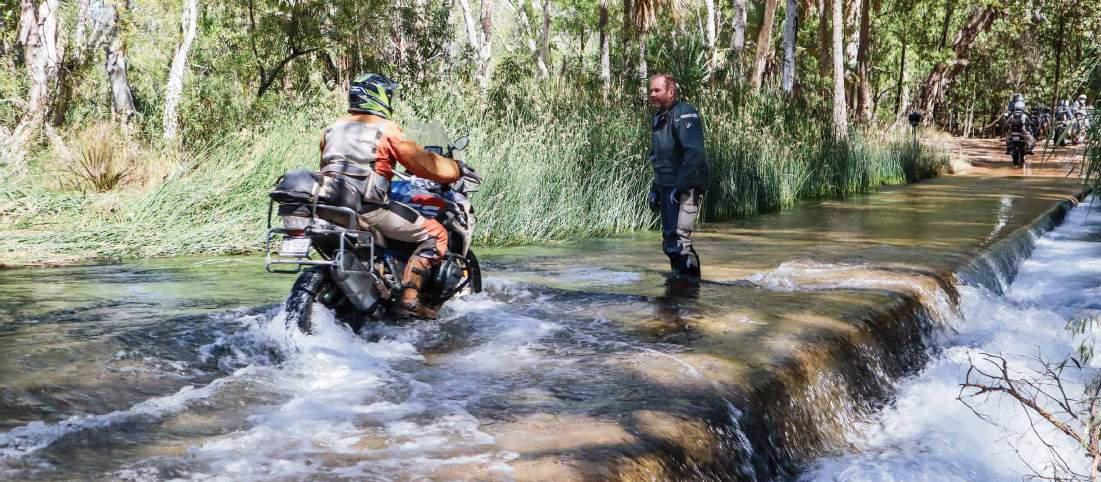
a tricky section to end the day with tired riders fighting through patches of bulldust and dry, rocky creek beds. A delicious outback barbeque provided by the friendly station hosts, Rhett and Maree, a few cold drinks and a dip in the healing magical springs ensured everyone slept well and was rested up for the next leg of the adventure.
Thirst for knowledge
Steve and Ben at Mataranka Homestead welcomed the Compass crew.
ATV and took great joy in taking riders for a hair-raising spin on tracks around the property and Steve joined us on our morning ride as we left Mataranka, showing us some of his favourite trails.
Kakadu National Park is Australia’s largest National Park, and everyone enjoyed a Yellow Waters Sunrise cruise with our entertaining local guide, Dennis. According to Dennis all animals in The Territory are out to kill you. This ensured everyone kept their hands inside the boat as it navigated through estuaries observing and photographing the abundant bird life and some of the largest saltwater crocodiles in the world.
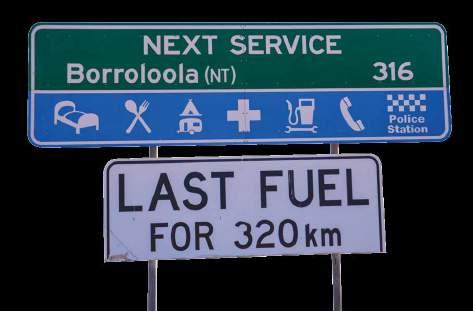
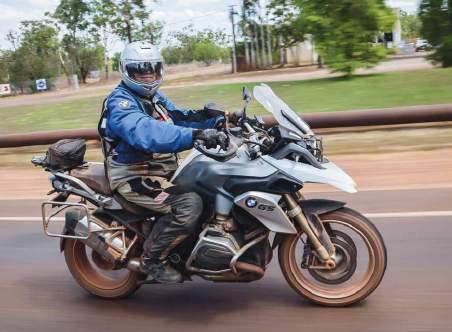
Dennis, however, did go on to note that more people die of dehydration than from crocodile attacks.
Lunch was at Adelaide River, home to the famous jumping crocodiles. It’s amazing to see these massive creatures, with almost their full body out of the water, feeding on pork knuckles and chickens being dangled above them from the safety of the boat.
Riding into Darwin, the NT’s capital, revealed the first traffic
Top: With Simon Pavey’s tips and support no obstacle was insurmountable.
Above left: Distances between services are big in the Northern Territory. Good support is essential.
Left: The red of the outback gets into everything.
anyone had seen in over 10 days. There were spare parts for the bikes waiting at the hotel as two of the BMWs had bent stanchions that needed to be replaced. With access to bike parts and specialised motorcycle mechanics limited in the remote regions, having parts delivered via courier from Compass Expeditions in Melbourne, and Simon and Neil at hand to do the work, ensured the bikes could be repaired overnight and continue safely.
Riding out of Darwin meant 20km of fun gravel roads through Grove Hill Heritage Park, part of the old Stuart Highway and North Australia Railway. Katherine, The Territory’s fourth-largest town, and the nearby Nitmiluk Gorge are both big highlights of the NT and a must see. Our barbeque dinner at the lookout on the escarpment above the town offered us a fine view over the Victoria River and the surrounding countryside. There’s an Anzac Memorial which reminded us of the bravery of the soldiers who kept guard on the Australian coastline during World War II, and on what many considered to be one of the top off-bike activities of the tour, the Nitmiluk Sunset Dinner Cruise was a relaxing boat ride and walk through three of the ancient sandstone gorges, topped off with a remarkable sunset and barbeque dinner.
From Katherine the route passed over the mighty Victoria River and on to Timber Creek, the only significant settlement between Katherine and the Western Australian border. With a population

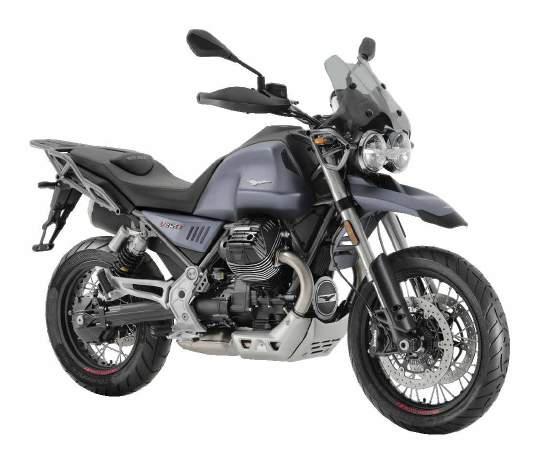


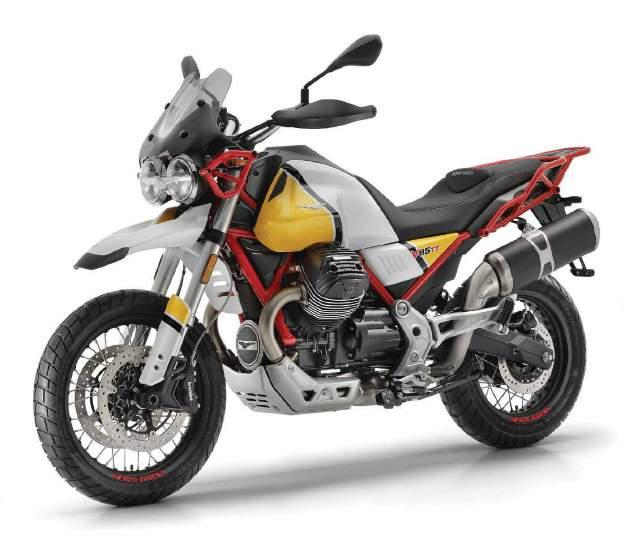
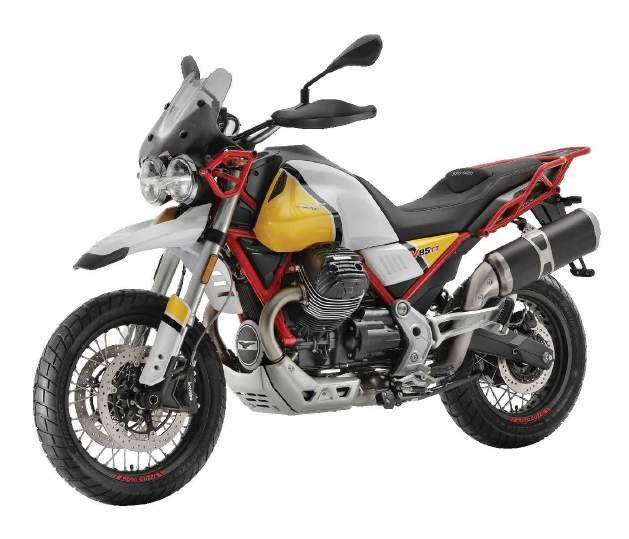
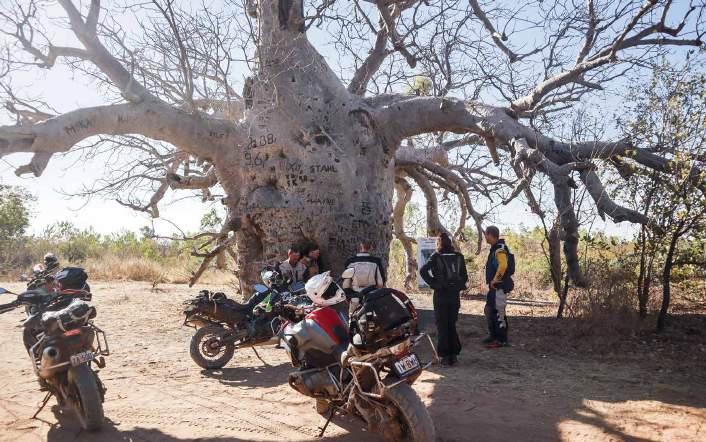
of just over 300, it’s a quite a small town. The riding was incredible and so were the destinations. Lake Argyle is Western Australia’s largest and Australia’s secondlargest freshwater, man-made reservoir. The reservoir is part of the Ord River Irrigation Scheme and located near the East Kimberley town of Kununurra. After some short off-road sections and a visit to the historic Durak Homestead, we parked up the bikes at the Lake Argyle Cruises office and headed out on our overnight adventure, camping on one of the lake’s islands. A 360-degree view of the sunset over Lake Argyle was breathtaking. A campfire, fish tacos and a couple of drinks saw us to the end of another wonderful day. It was also a very memorable day for Neil – he couldn’t believe he saw a crocodile eat a fish. He couldn’t stop talking about it and hasn’t to this day.
Cave man
The next morning after an amazing sunrise and a refreshing swim – well away from the freshwater crocodiles – there was a short stop in Kununurra for fuel and grocery supplies. We were into the beautiful East Kimberleys, and an interesting off-road section, including some challenging riding on the salt flats, had the bikes into Wyndam for a barbeque lunch supplied from the support vehicle at the town’s lookout.
The next two nights were spent at the luxurious Home Valley Station, which gave the crew and riders time to work on bikes, vehicles and do trailer maintenance, all of which were important preparation for the Gibb River Road.
Left: The famous Prison Tree, a 1500-year-old boab which was used as a lockup for indigenous prisoners. Bottom: The border between the NT and WA near Kununurra.
late 1800s when Aboriginal leader and ‘outlaw’ Jandamarra used the Cave of Bats as his hideout.
Leaving Home Valley, it was just over 100km of gravel to Ellenbrae Station where the group (especially the UK riders) enjoyed a morning rest stop with Devonshire tea and scones. It was a little surreal to be enjoying a Devonshire tea in the middle of the outback.
Manning Gorge is about halfway along the Gibb River Road and was an ideal overnight stop. It’s a beautiful setting with a safe swimming hole located right at the campsite and the nearby Mt Barnett Roadhouse has fuel and ice. The group tackled the six-kilometre return walk from the campsite to the gorge in the early morning to avoid the heat and were well rewarded with a refreshing swim. Neil also saw his first brown snake hiding in a nearby rock crevasse.
A bushfire at Tunnel Creek, a million flies and some very hot weather shortened our stay at this historical site. The main feature of the park is a 750metre tunnel the creek has worn through the Napier Range, making the oldest cave system in WA. It became famous in the
There were some final corrugations for riders to endure, but as the group closed in on Derby the road became much smoother thanks to some recent grading and roadworks. We arrived at Derby right on sundown for another amazing Kimberley sunset and dinner and drinks on the deck at the Derby Lodge. It was hard to believe day 21 had rolled around already as we awoke for the final leg of the ride to Broome. We indulged in coffee and pancakes for breakfast before a short ride out of town to see the famous Prison Tree, a 1500-year-old boab with a girth of almost 15 metres which was used in the 1890s as a lockup for indigenous prisoners on their way to Derby for sentencing.
Cable Beach is a 22-kilometre-long stretch of pure white sand set against a backdrop of red ochre cliffs and fringed by stunning turquoise waters, and it made a truly fitting end to our Savannah Way adventure. Everyone rode triumphantly up the beach to Broome and a welcome party provided by Chris and Fiona from Ozbrero.
With a backdrop of the tourist-laden Broome camels marching their way up the beach at sunset, riders had a celebratory drink and a wash in the Indian Ocean before riding into town and enjoying a final group meal. The drinks had never tasted so good as everyone reminisced on the past three weeks and planned their next adventures.
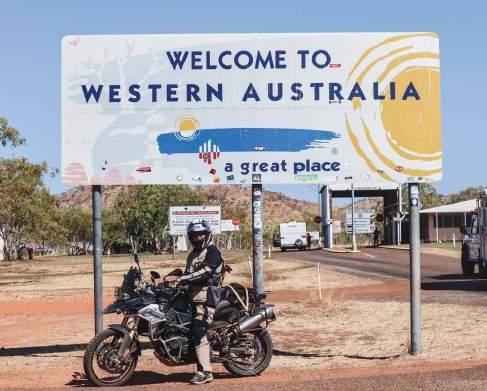
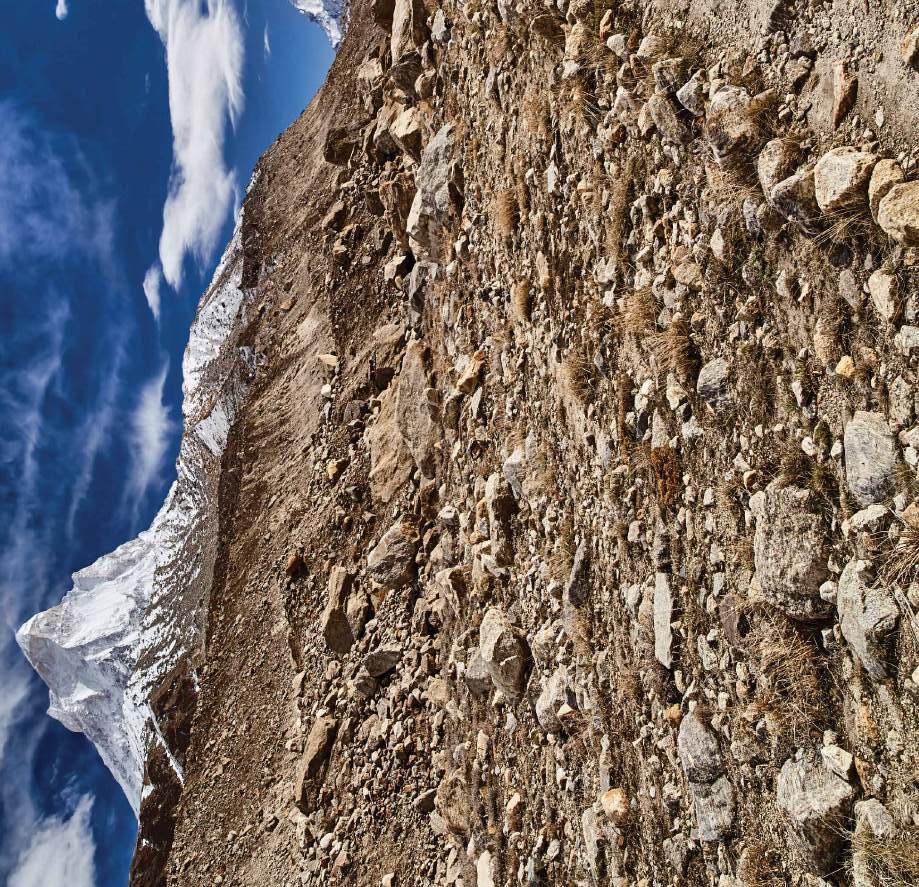
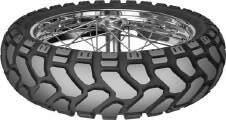

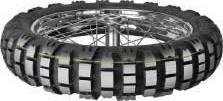

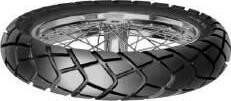





A big congratulations to all the riders and thanks to all who made the Savannah Way Tour such an epic adventure and success. We hope to see you riding this adventure with Simon and Compass Expeditions when the trip runs again in August 2020. For more information visit www.compassexpeditions.com/ tours/the-savannah-way-withsimon-pavey.
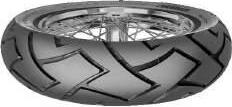



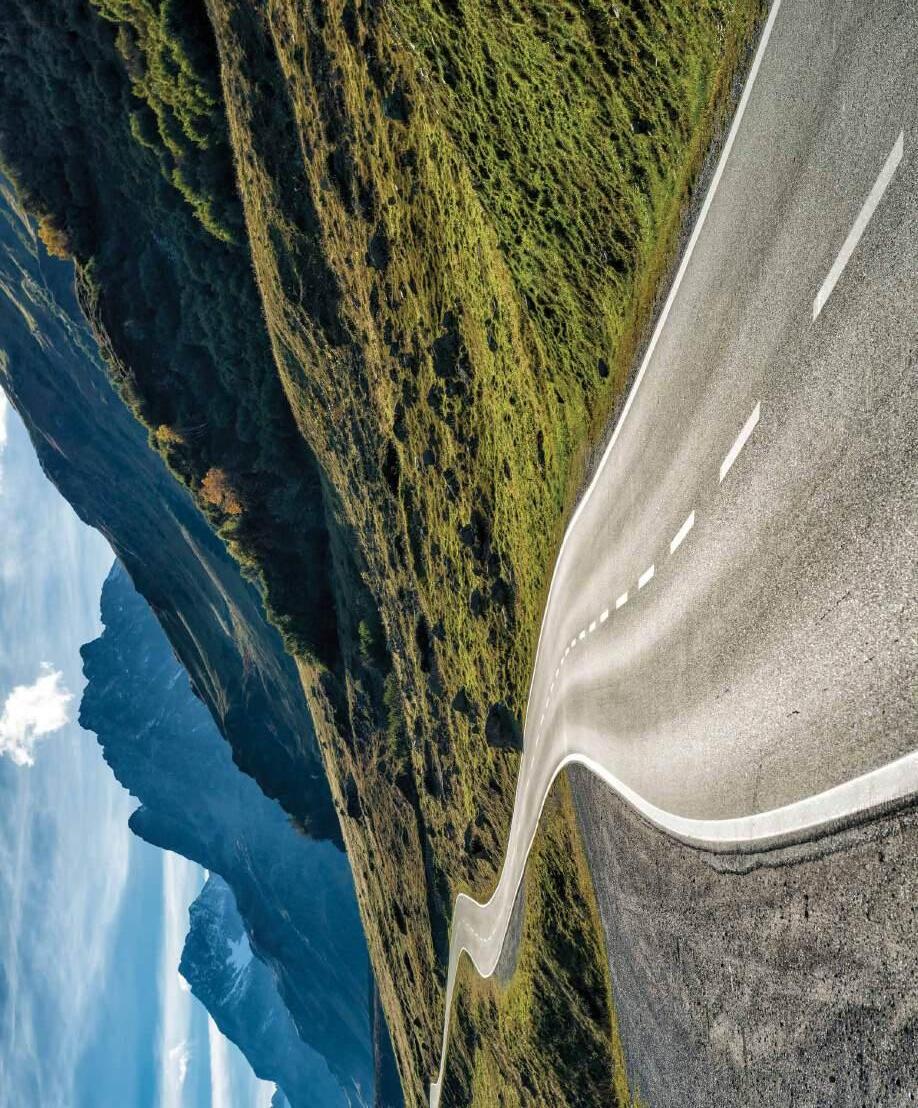

Greg Dunn and a group of mates spent a leisurely five days exploring the NSW mountain region.
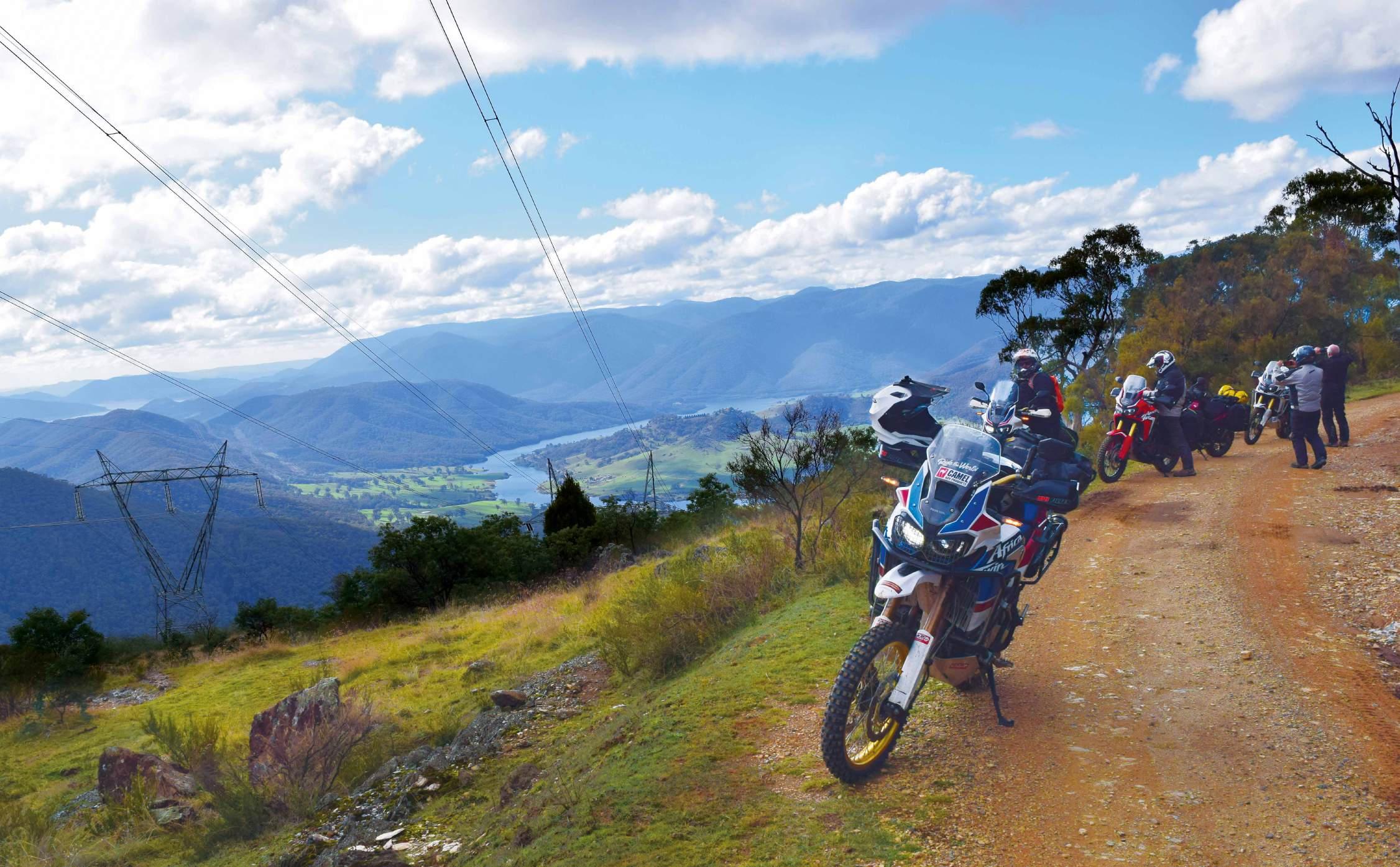
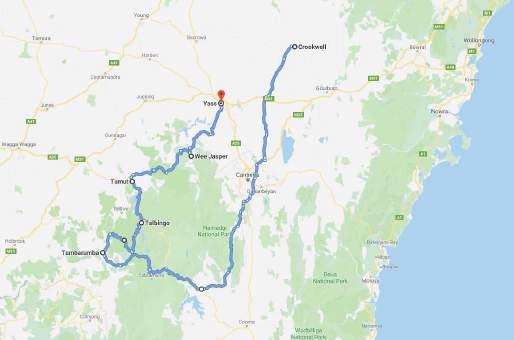
Picking up a 250kg adventure bike can be a real challenge. But good technique – and of course trying to get the bike upright before your mates can get their cameras out – makes it easier. But that’s getting ahead of myself.
On Wednesday The Big Fella, Drew and myself set off around midmorning for the drone down the M1 and the Hume. We were headed for Yass, and time constraints meant tackling the highway stretch. We wanted to make the most of our time in the NSW high country. Over the next four days we set out to explore a part of the country new to us. I’d created some maps and transferred them to my GPS. By only planning around 300km
u
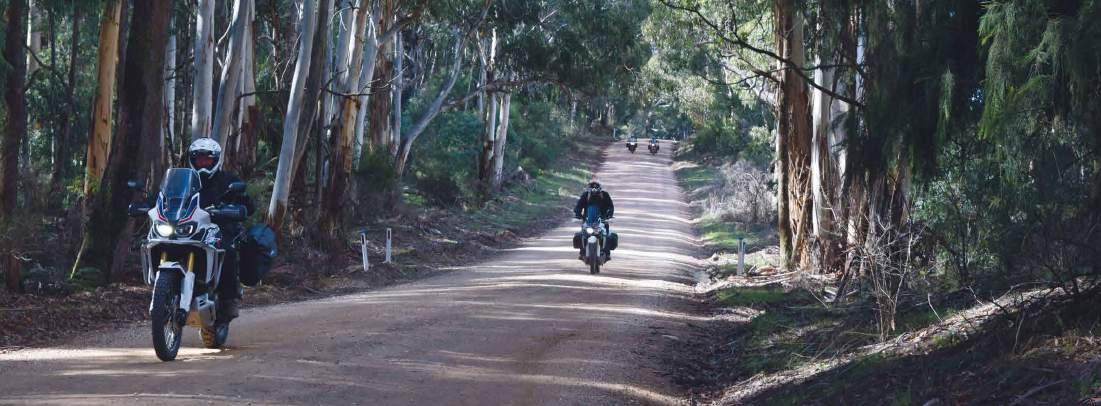
each day we gave ourselves plenty of time to really take it all in and explore if we desired. It was a change from our usual 500km-600km days where a couple of flats could mean getting to camp after sunset or arriving at accommodation in the dark without having time to take in the scenery.
All present
We arrived in Yass, checked in, had a wash and headed for one of the local watering holes. I spotted a familiar face as we walked in the front door of the pub. It turned out I used to sell tickets to the bar manager in my old job in Sydney with CityRail some 14 years ago. What a small world.
We ordered beers and perused the menu. The pub offered two meals for the price of one on Wednesday night. Winning!
While we enjoyed our beers, we
watched two bikes roll through town, heralding the arrival of the rest of our party. Dick on his red Africa Twin –meaning we had three Africa Twins plus
“By only planning around 300km each day we gave ourselves plenty of time to really take it all in and explore if we desired.”
my AT Adventure Sports – and Kev from up the road on his V-Strom 650. These two had enjoyed a day riding through the Watagans, down to St Albans, then across to Colo, Bilpin and south to Yass on as much dirt as they could find.
After brekky on Thursday morning we headed south to Wee Jasper and followed the road around the bottom of Lake Burrinjuck and through Wee Jasper State Forest, stopping for photos and to enjoy the scenery. It was a beautiful 19 degrees with a few fluffy clouds in the sky and a perfect day to be out riding. Tumut offered a bite to eat and the boys were enjoying the relaxed pace. After lunch we rode down the eastern side of Blowering Reservoir and turned off for Talbingo looking for dirt roads. At Tumut 3 power station we stopped to look at the pipes, and, much to Kev’s dismay, no-one took photos. We followed the transmission track up the hill away from the water and copped some amazing
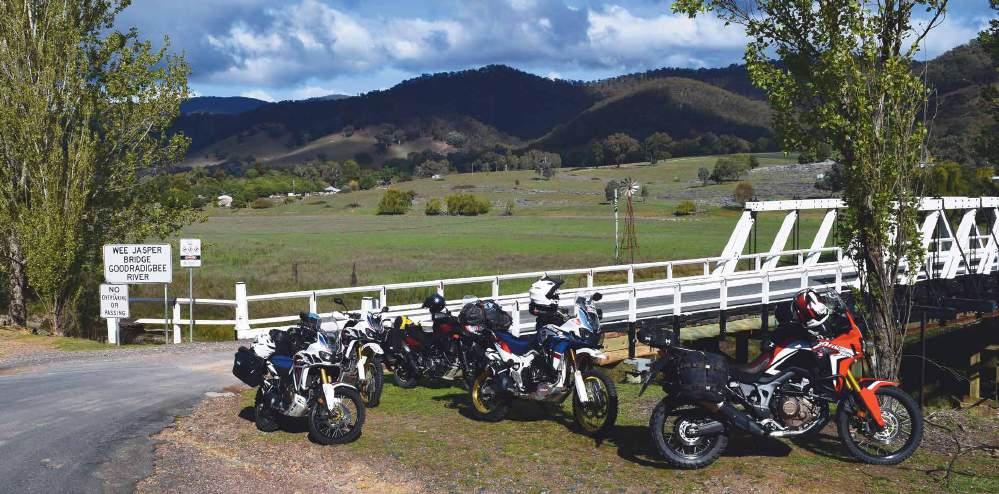

LIGHTWEIGHT, WITH FLEXIBILITY
DESIGNED-IN FOR ENERGY MANAGEMENT. PENETRATION
RESISTANCE THAT MEETS OR EXCEEDS THE BEST KNOWN COMPOSITES IN THE WORLD.
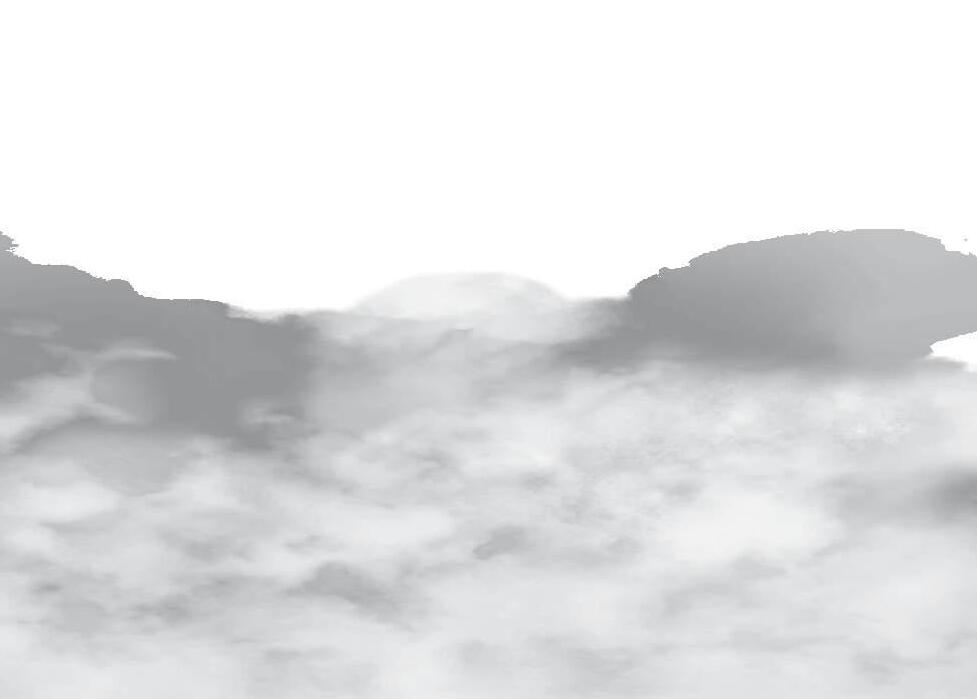
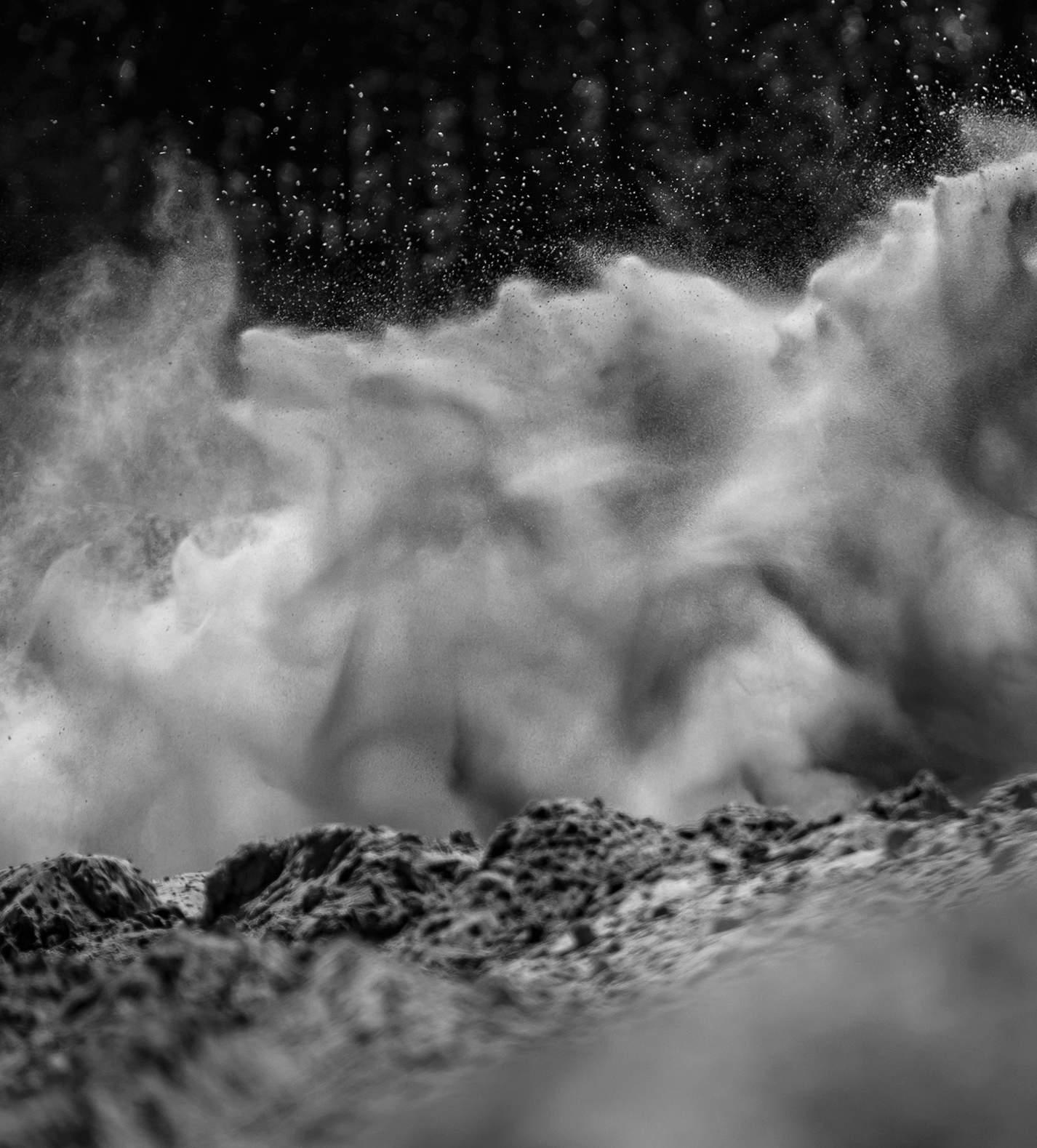
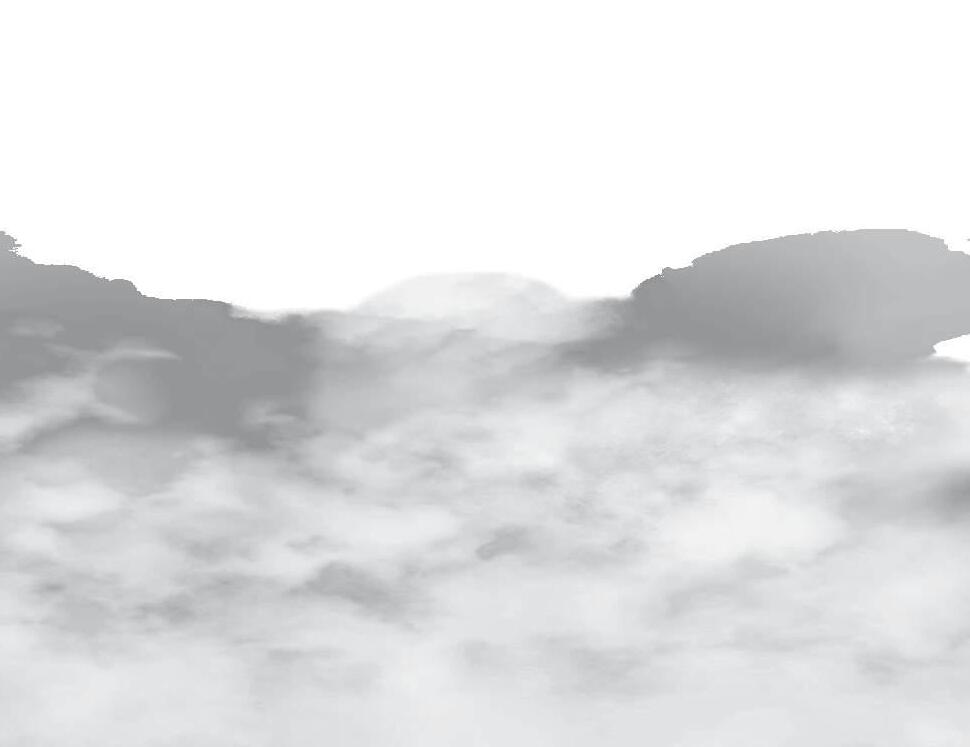
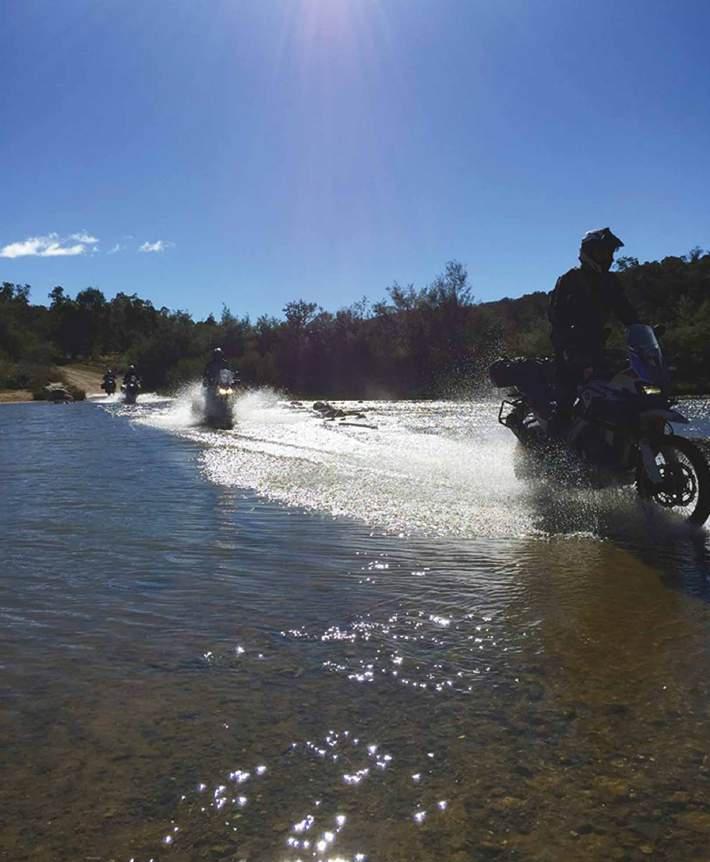
views. A slight detour led us over several downed trees, but we eventually returned to the transmission track. It soon turned into Powerline Road and eventually dropped us out on the Elliot Way, some 30km from our overnight destination, Tumbarumba. By 5.00pm we were all showered and enjoying a cold beer on the upstairs balcony at the pub. A cracking day had delivered some spectacular scenery and we had a few ales and a great feed before shoving off to bed around 10.00pm.
The weather was forecast to be questionable on Friday, so when we woke up to the sounds of rain, we weren’t surprised. We had a decent day planned and wanted to take on as much of Kosciuszko National Park as we could, but with an expected high of six degrees and more rain expected, the plan was soon changed to a long breakfast and a
Stars Saturday morning was crisp but clear and with the previous day’s rain we were confident the tracks would be in top nick. We headed east out of town to Bobeyan Road, which we followed for most of the morning. There was more snow on the side of the road than we would have
“By 5.00pm we were all showered and enjoying a cold beer on the upstairs balcony at the pub.”
liked, but the temperature was pleasant enough and we were rugged up. We stopped to check out Brayshaw’s homestead and a lookout overlooking Namadgi National Park, again soaking in the great panorama, and a detour took us to the site of the old Orroral Valley space dish.
Copped a spray
From there it was a bit freestyle, criss-crossing our way east. We rode the Angle Crossing and then crossed the Monaro Highway and followed Williamsdale Road onto Burra Road. I pointed my nose up Urila Road and The Big Fella urgently waved me back. This is where I started the story.
straight run over the mountain on the tar along Elliott way, Goat Ridge Road and the Snowy Mountains Highway to Adaminaby. We geared up and headed off around 10.30am, then stopped for a few minutes next to Three Mile Campground where we’d scheduled to camp when planning the trip. It was sleeting, a balmy three degrees and visibility was about 20m. We were all thankful we hadn’t camped there after all. We arrived cold but mostly dry at Adaminaby just after midday, grabbed a pie and a beer, and accepting the day would be more bench racing than actual riding. With rooms paid for we headed out back to park the bikes under a carport. Drew attempted a quick U-turn and toppled over in the driveway. No damage was done and we had him up and parked before heading for a hot shower then setting up camp at the bar. A mate lived about 40 mins away so he came down for a beer, dinner and a catch up.
The Big Fella had alerted me to a hidden box drain in my chosen path. Once I saw it I thought I’d just roll through and get back on the road, but as often happens when you relax, you get reminded you need to be on the ball. Over the ’bars I went, and after a fantastic barrel roll –which Drew scored at 9.5 – I did manage to get the big girl back upright before the cameras came out.
After a good laugh at my expense we were back moving towards Tinderry along more great roads with spectacular country. The views had Drew’s attention when he made a slight miscalculation and went bush for a minute. Dick was there to laugh and, of course, make sure he got his bike out okay. Kev copped a proper soaking. He thought a water crossing was only 25mm or so deep, but the spray of his 650 as he charged through the 15cm deep puddle was quite impressive.
A flat rear on my AT halted our progress. While I changed the tube with help from the lads, Dick took a nap on the grass. At least the scenery was still beautiful.
Once going again, we passed through Captains Flat and made our way to Braidwood for a late lunch.
That left just 130km to our destination of Crookwell. The temperature dropped and we again broke out the neck socks and warm gloves to ride through the wind-turbine farms on the way to Crookwell. They’re an impressive sight up close.
We arrived, checked in, showered and again went looking for a beer. It was a night of ups with top company, everyone in good spirits, and great pizza for dinner …and a night of downs because I had to watch my football team lose.
I awoke to a cold foggy morning, found my way downstairs with The Big Fella and grabbed brekky at the local takeaway. Kev and Dick showed up while we were eating and plans for the day were hashed out. The Big Fella was coming down crook and decided to beeline it for home on the highway, Dick and Kev decided a leisurely ride back was in order and Drew was looking at a mostly tar ride. I decided to take
off solo and headed across to Taralga and up through the Abercrombie River National Park, taking it easy on the beautiful tar roads as the fog still hung quite low. I made my way into the Blue Mountains then ran mostly dirt roads to Colo and St Albans before heading up and over the Watagans. Even at a casual pace I still managed to have a wee off and laugh at myself. Once again there was no damage and I continued on.
Top left: Only planning around 300km each day gave time to really take it all in and explore. Below: A flat rear on the author’s Africa Twin slowed things up.
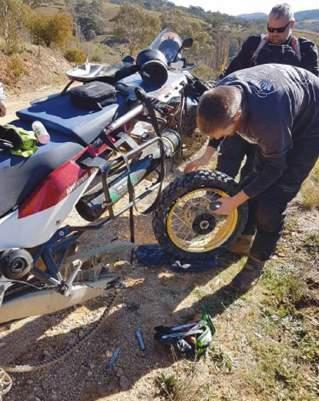
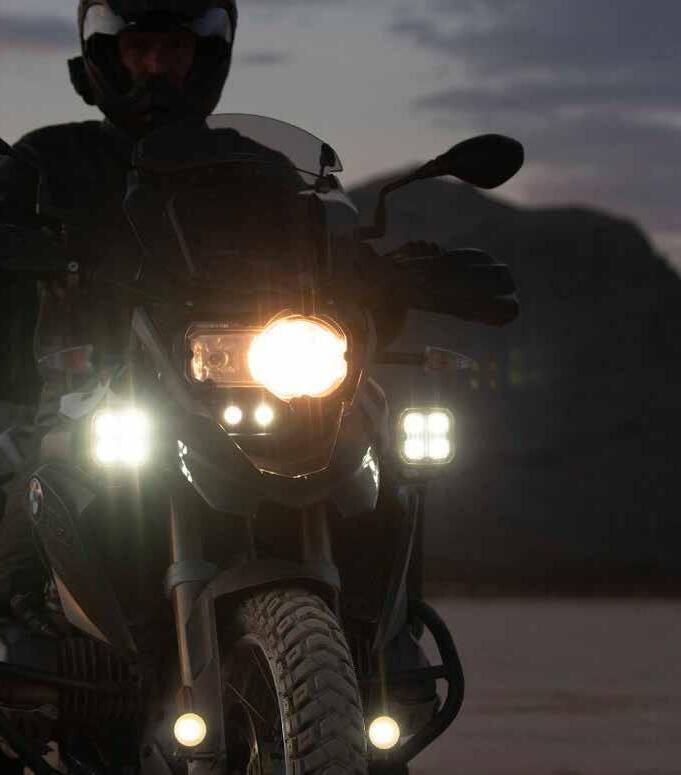
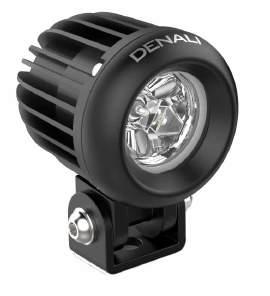


I arrived safely home around 4.30pm and found a message from The Big Fella. He’d also got home safe, and over the next few hours so did everyone else. It was a top few days, and once the weather warms up I’ll definitely be looking to head down that way again. Versatility really is one of the strong points of these big adventure bikes. They can sit comfortably on 110kph on the highways and then take on the dirt roads and firetrails when off-road fun presents. I only did around 1600km in the five days, but enjoyed the casual pace and travelled through awesome country. Now it’s time to break out the map and see where to next.







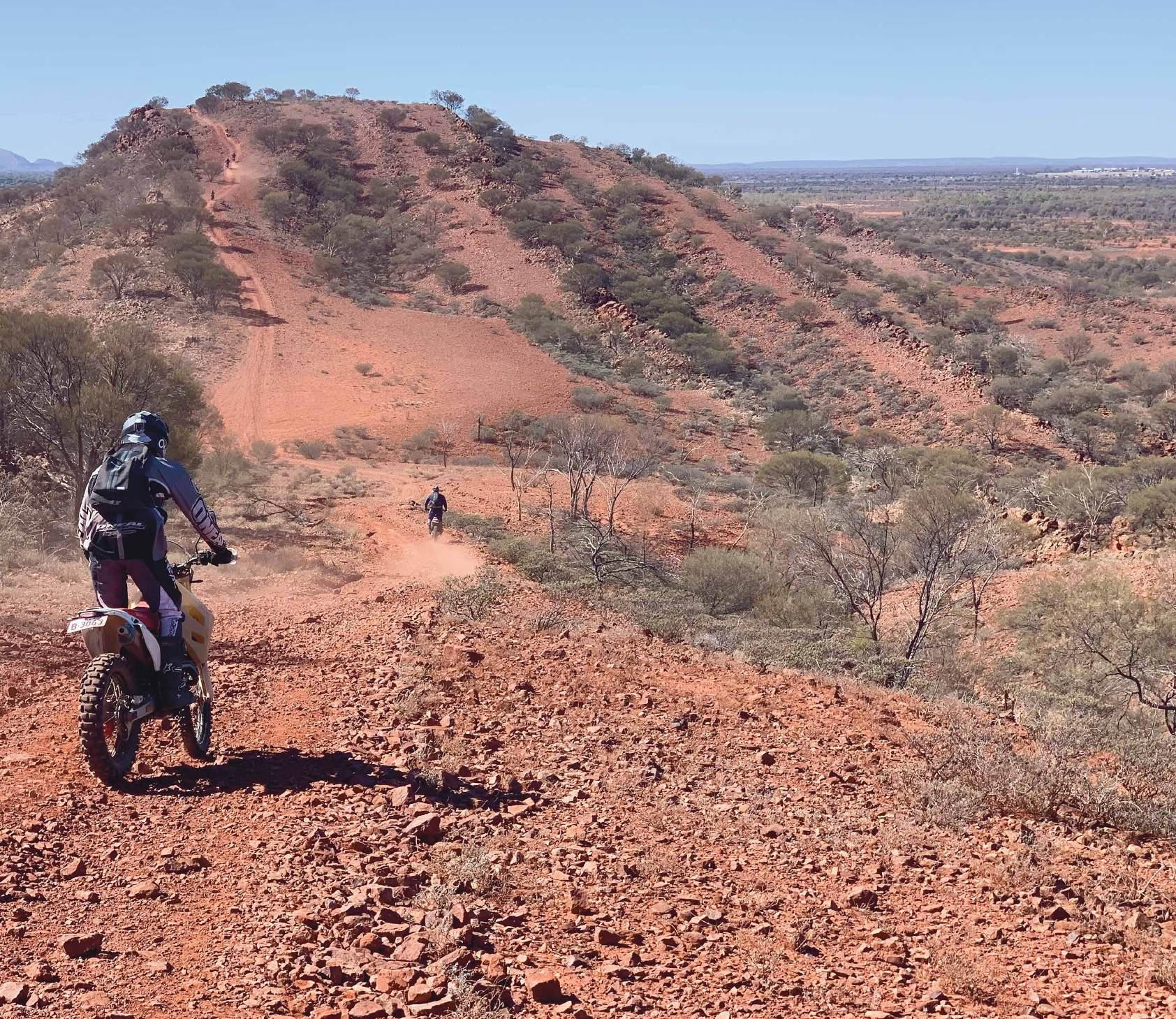
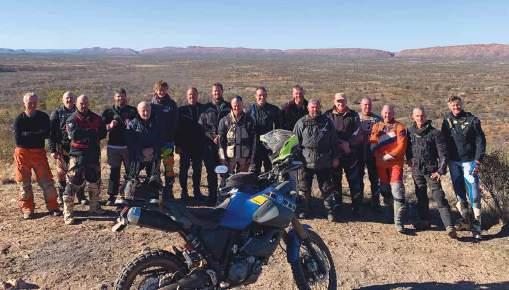
About two-and-a-half years ago, Alice Springs residents Damian McGrath and Michael Vroom agreed their home town was on the doorstep of some of the greatest adventure-riding country Australia had to offer. They thought it was about time they shared some of it and Outback Motorcycle Adventures was conceived. The Red Centre Adventure Rallye, an event that showcased the raw, untamed Red Centre, came into being. Damo has the story on this year’s ride.
We were delighted to have Adventure Rider Magazine join us for a segment of the inaugural 2018 Rallye (see issue #31 – Ed) Luckily for us, the mag had nothing but praise for the Rallye’s first run.
Fast-forward to 2019 and 23 riders signed up for the second event. We started off with a welcome dinner and briefing on the Sunday evening before things got serious and the riding commenced on Monday. There were three father-and-son combinations in the group, along with two riders from New Zealand. Bikes were varied and ranged from a KTM200EXC smoker right up to a sprinkling of KTM 690s and Africa Twins, with pretty much everything else in between.
The Red Centre Adventure Rallye is a five-day event that covers about 1300km, with the selected routes
Left: Spectacular scenery, although some saw more of it than others, depending on how hard they were fighting their machines.
Top: 23 riders signed up for the 2019 Red Centre Adventure Rallye, including three father-and-son combinations and two riders from New Zealand. u
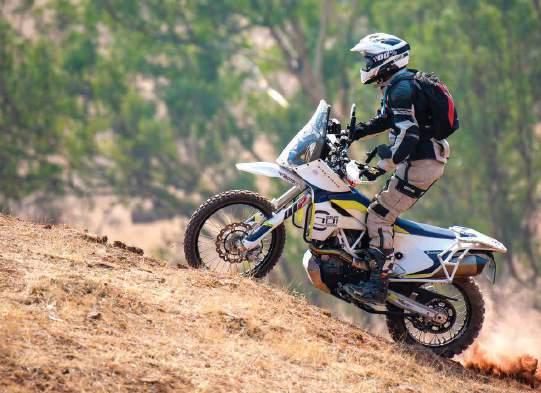
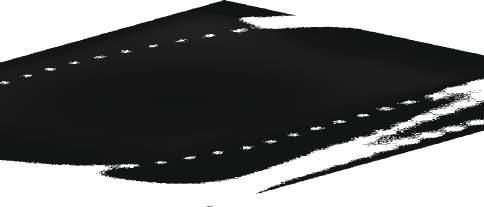
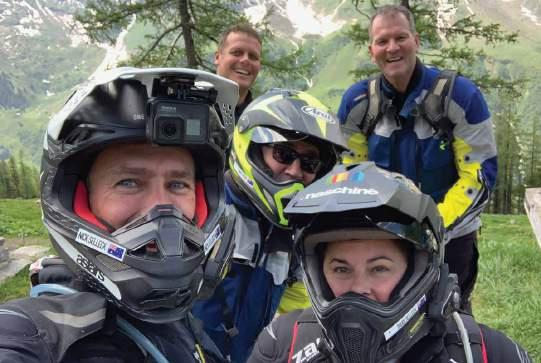
looping out in a different direction from, and returning to, Alice Springs each day. In 2019 riders could choose from either the standard ‘adventure’ route – which meant a nice, cruisy, not-too-difficult ride – or the ‘challenge’ route, which, as the name suggested, was designed to throw in a few curve balls to keep everyone on their toes.
The first day dawned as another perfect, albeit chilly, centralAustralian day. The Darwin contingent scrambled for anything that would keep the cold at bay and Jack Norris resorted to wearing his backpack as a frontpack for the initial transport section to try and avoid the wind chill.
The days’ planned ride was to head out into the East MacDonell Ranges via Ross River, through to Arltunga and the spectacular Ruby Gorge, with lunch at Hale River Homestead.
Man down
There’s one thing every sweep rider hopes never happens, and only four kilometres into the first dirt section of the day my worst fear was realised. A group of riders surrounded a motionless body sprawled in the dirt.
Brad, Josh and their father Joseph Pace had brought a shipping container on the back of their own semi and driven all the way to Alice Springs to share a week-long adventure together. Unfortunately for Brad on the 200EXC – in that initial excitement and nervousness we all experience at the start of a ride
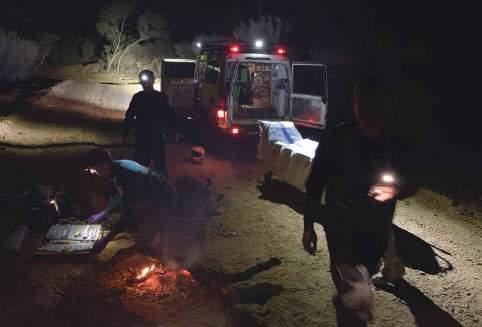
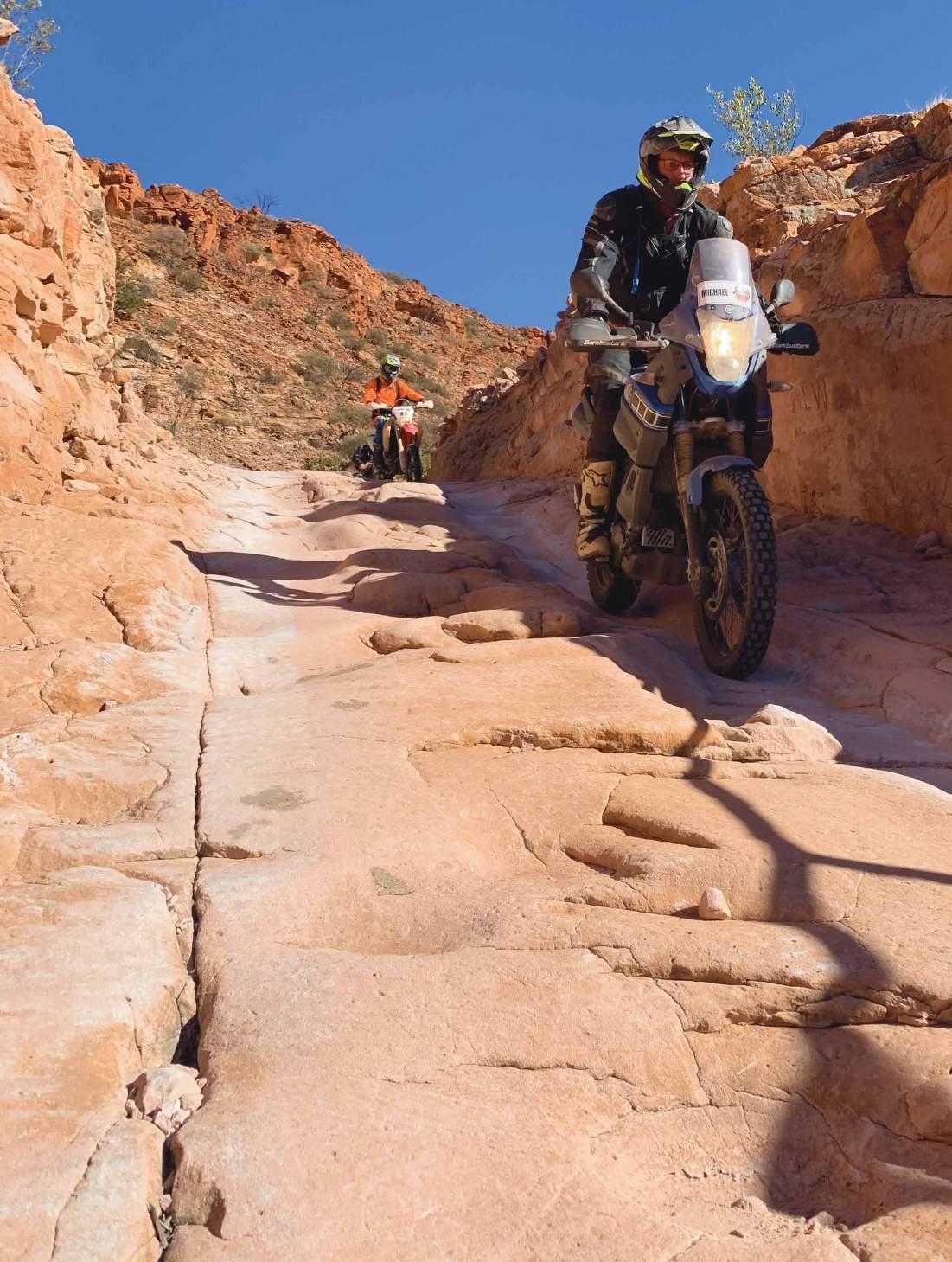
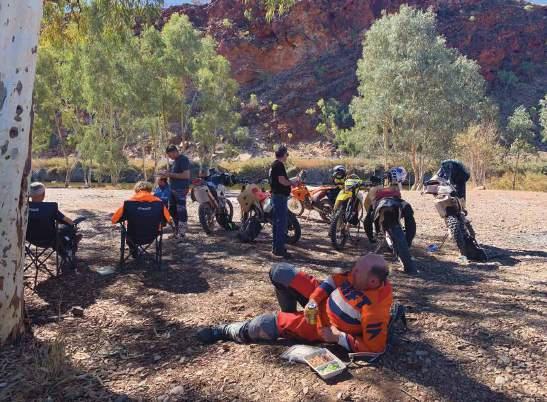
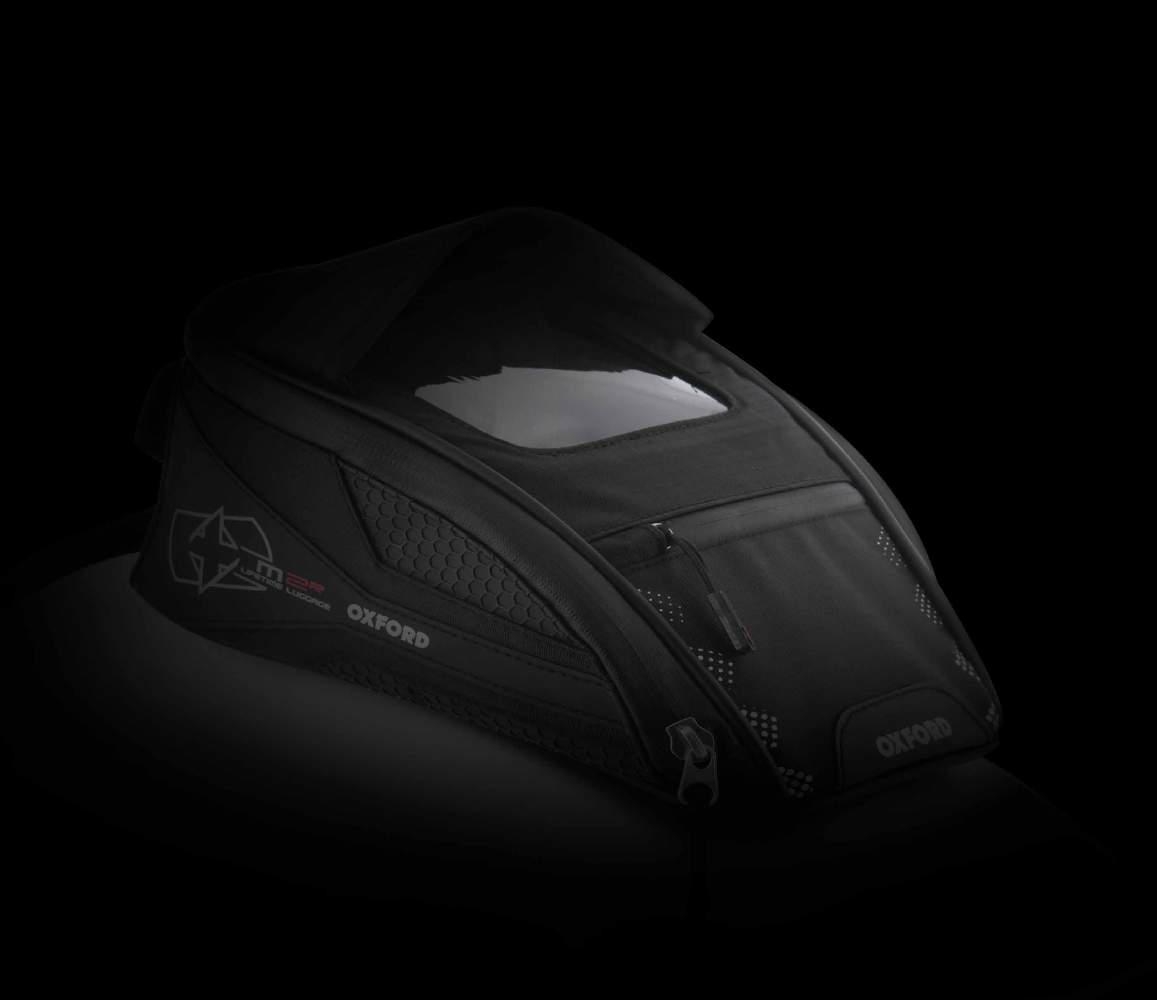
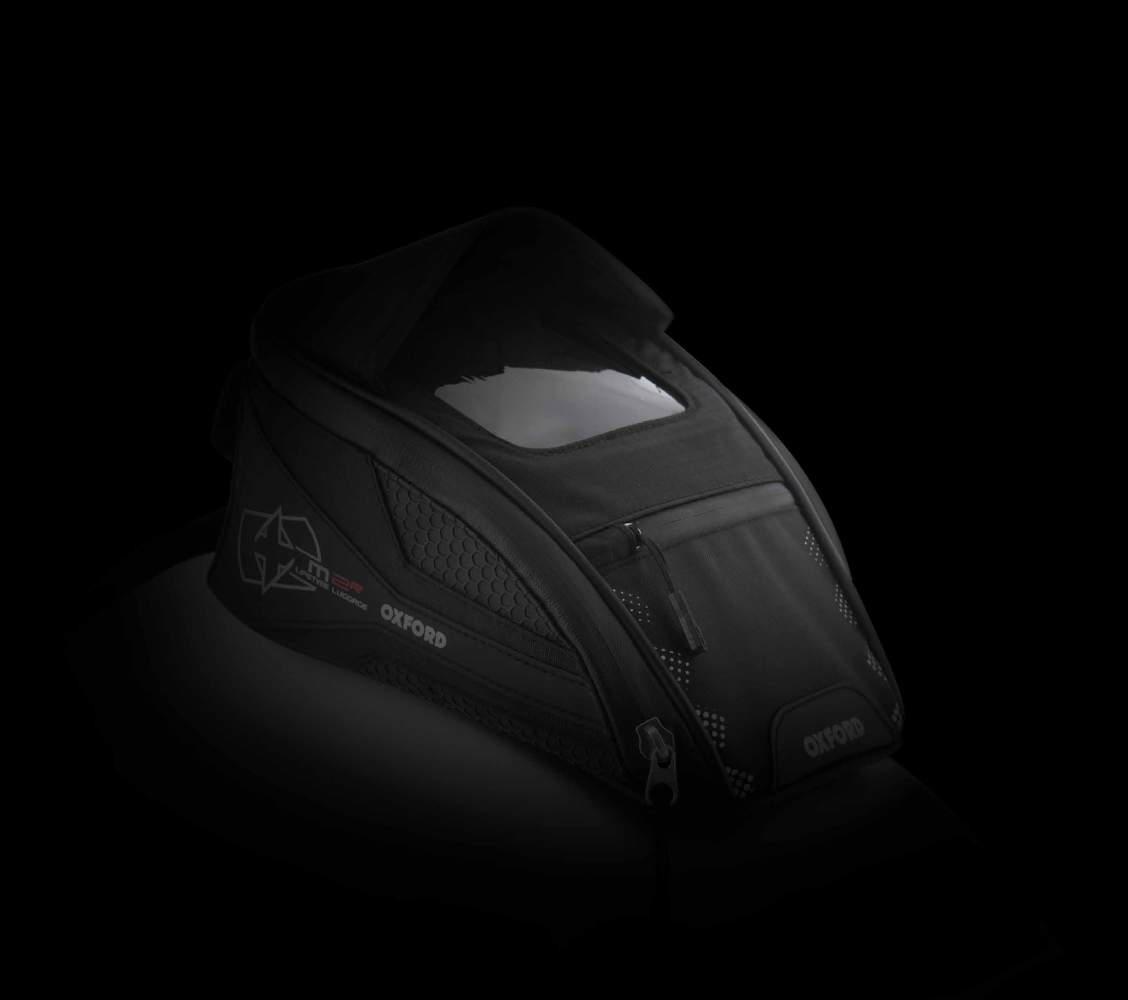
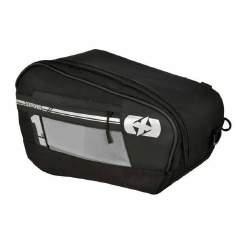
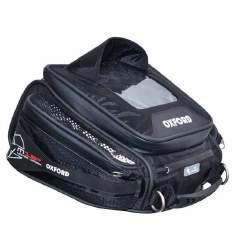
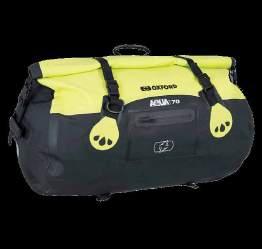
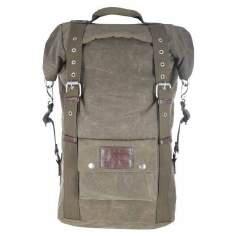
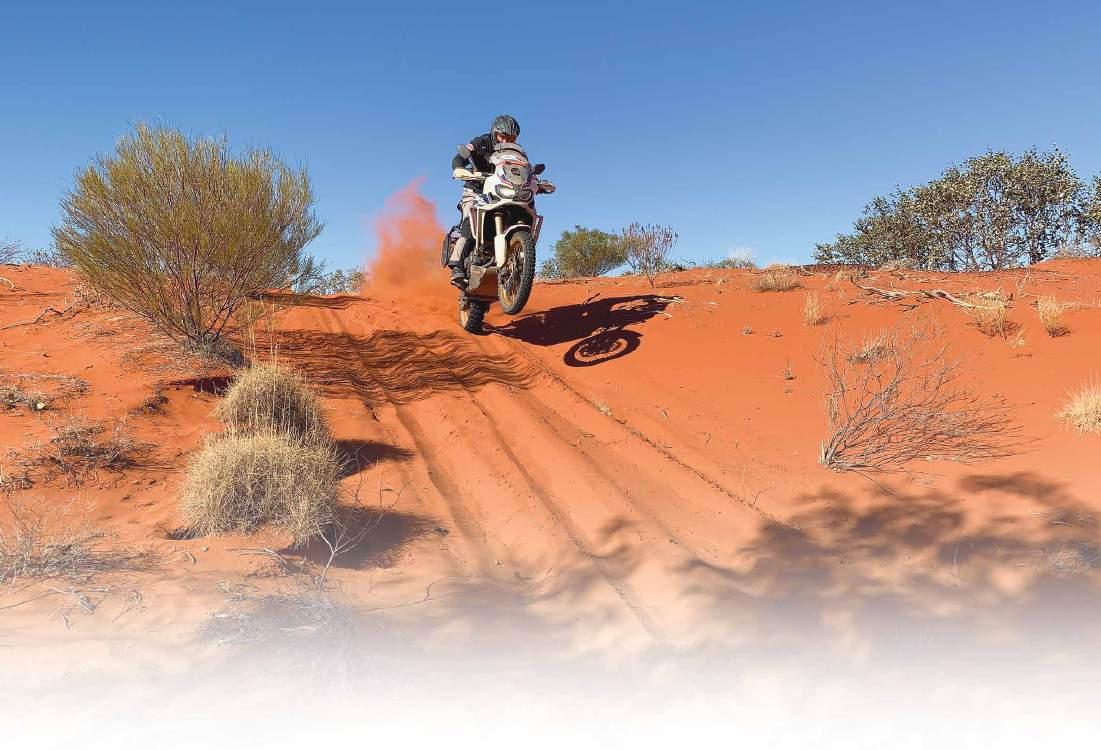
– he missed a corner in some hanging dust and barrelled headlong into a 1.5metre washaway. After a brief nap he awoke to a broken leg and a trip to the Alice Springs hospital.
Once Brad was in safe hands, Josh, Joseph, fellow sweep rider Scott and I scrambled to make up time and managed to eventually catch up with the rest of the group enjoying a hearty lunch at Hale River Homestead. As I approached the homestead on those winding dirt roads, there was a big grin on my face as I noticed tracks made by the earlier riders. There were some serious power slides taking place! It looked like everyone was having fun already.
The earlier accident and comfortable surroundings for lunch meant we were a little behind schedule, but all things considered, there was enough time to be back in town well before sundown.
After enjoying the sights at Ruby Gorge, Joseph Pace piped up and warned everyone to ‘take it easy and don’t do anything stupid on the way home’. Five minutes later he was eating his own words,
Top: Marek ‘Muz’ Pryde on the throttle.
Above right: When you ride in central Australia, you’re going to encounter sand. Lester Hamilton made it look easy.
Right: Wednesdays’ route, covering over 230km of dirt alone, was the most technical and had some very remote sections. u
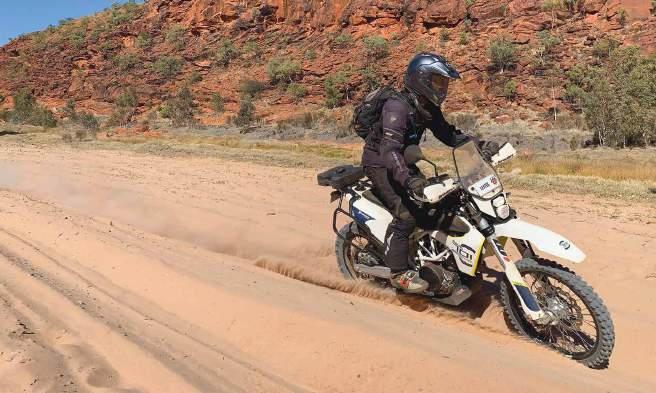
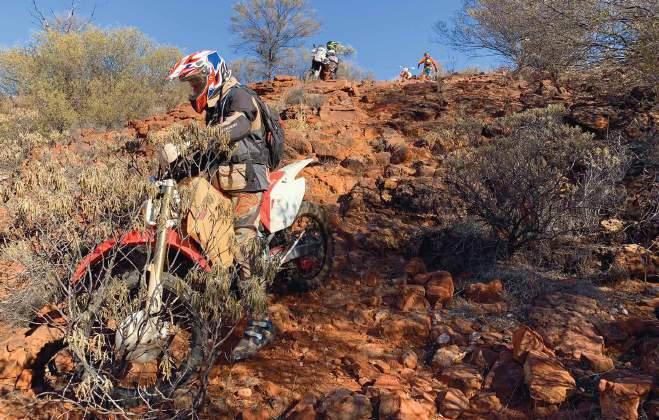
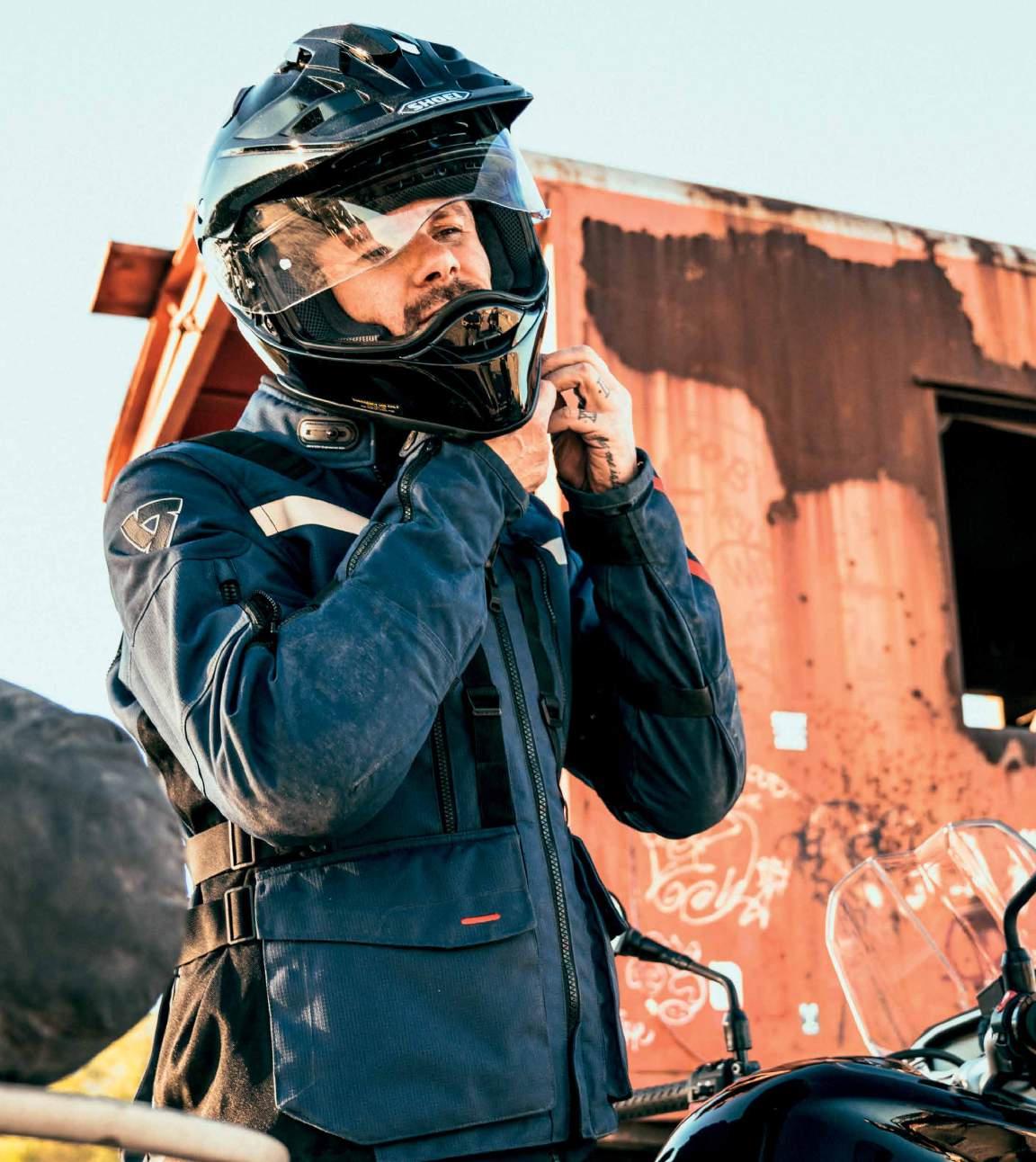








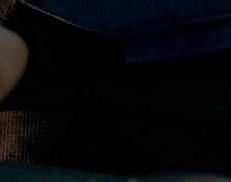

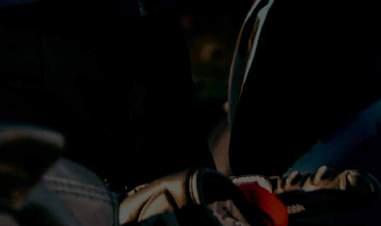
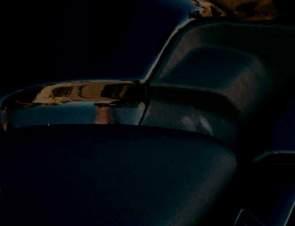
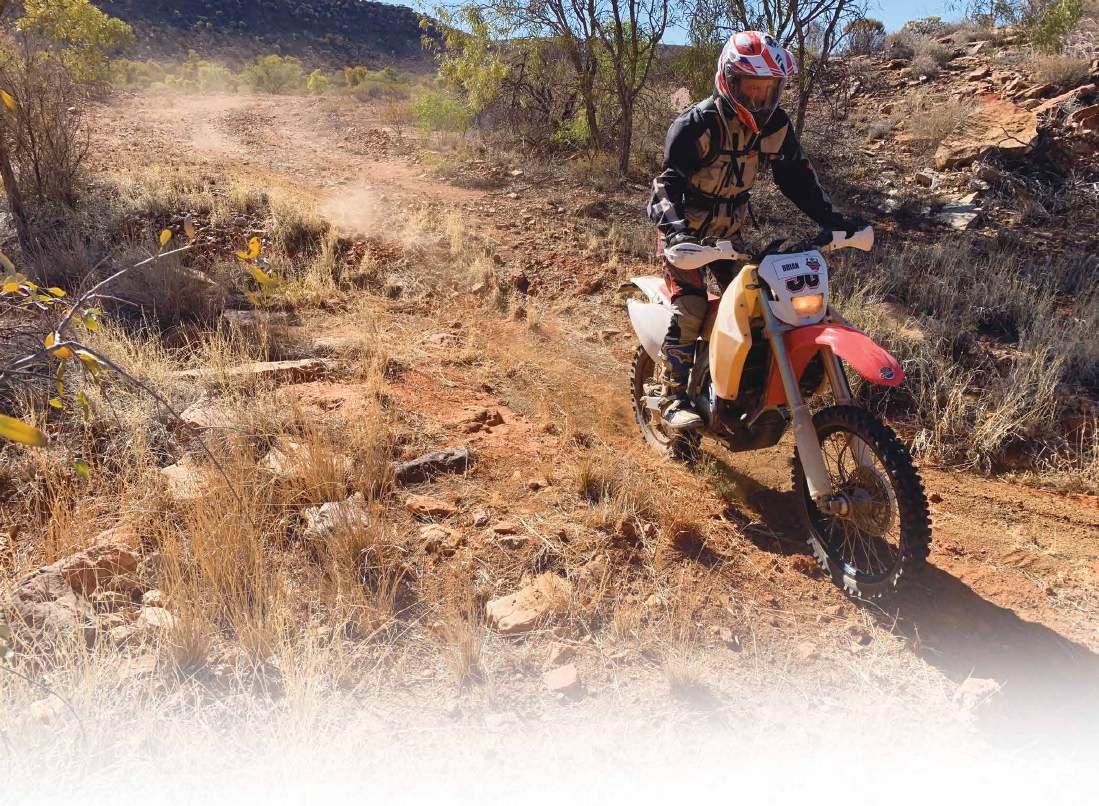
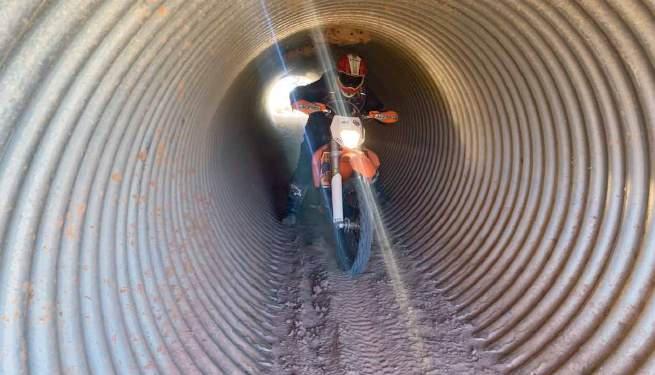
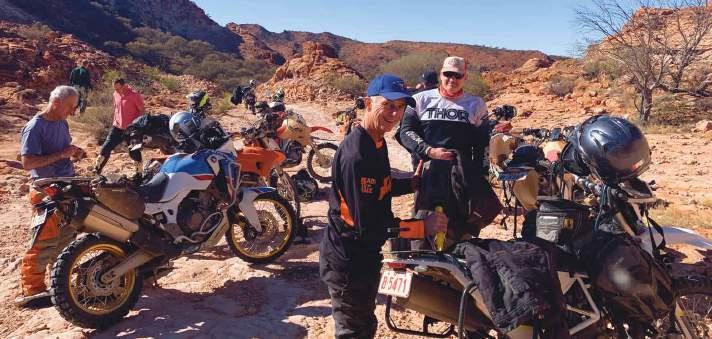
overshooting a corner and coming to grief in a cloud of dust. It was dirt nap number two for the day and resulted in a shattered collarbone and bruised ribs. One could’ve said it wasn’t turning out to be a good day for the Pace family. This delay meant the rest of the group got to sample the effectiveness of their headlights and see just how big some of the kangaroos were – all part of the adventure, though.
Day two’s route headed south and included highlights like the Finke Desert Race track, the Hugh River and Rainbow Valley. If there’s one certainty when you ride in central Australia, it’s that you’ll encounter some sand. Gavin Hain, a farmer from Queensland, had recently purchased an Africa Twin and this was his first foray into some soft-sand riding. After a lifetime of riding smaller bikes he struggled to come to grips with the different riding
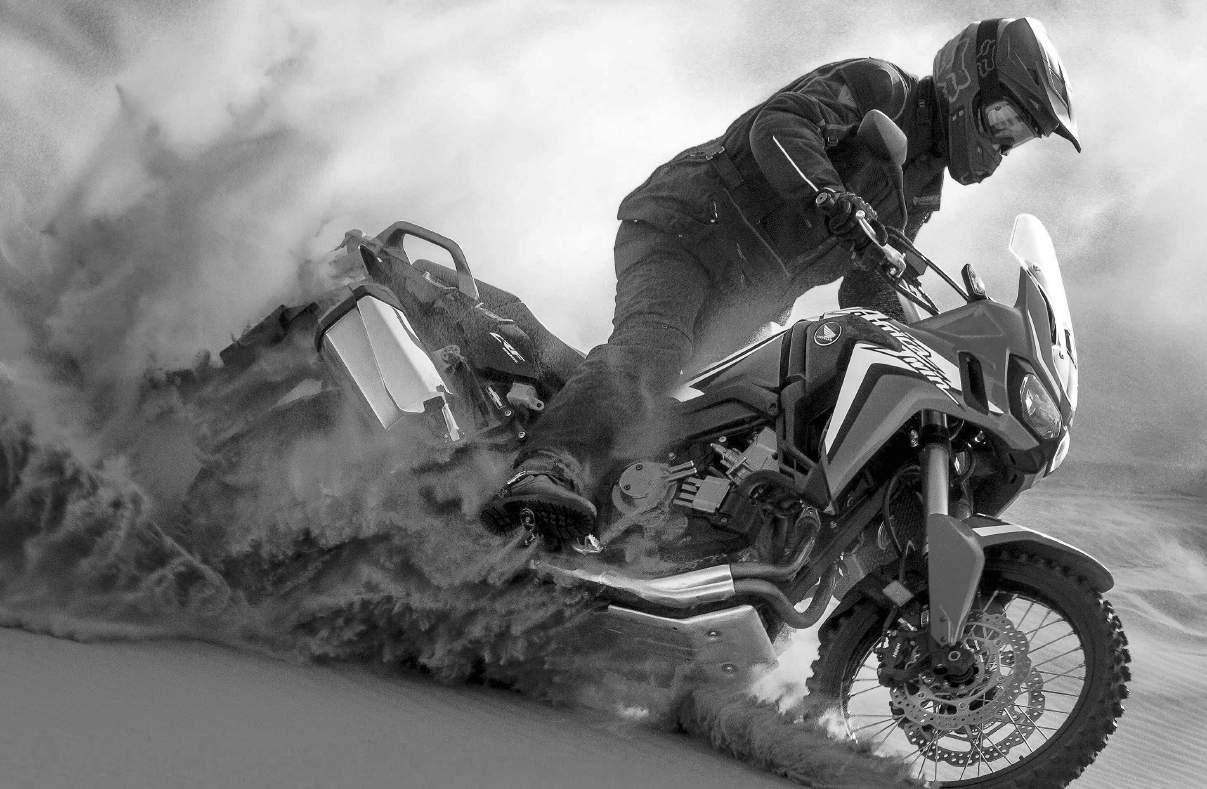
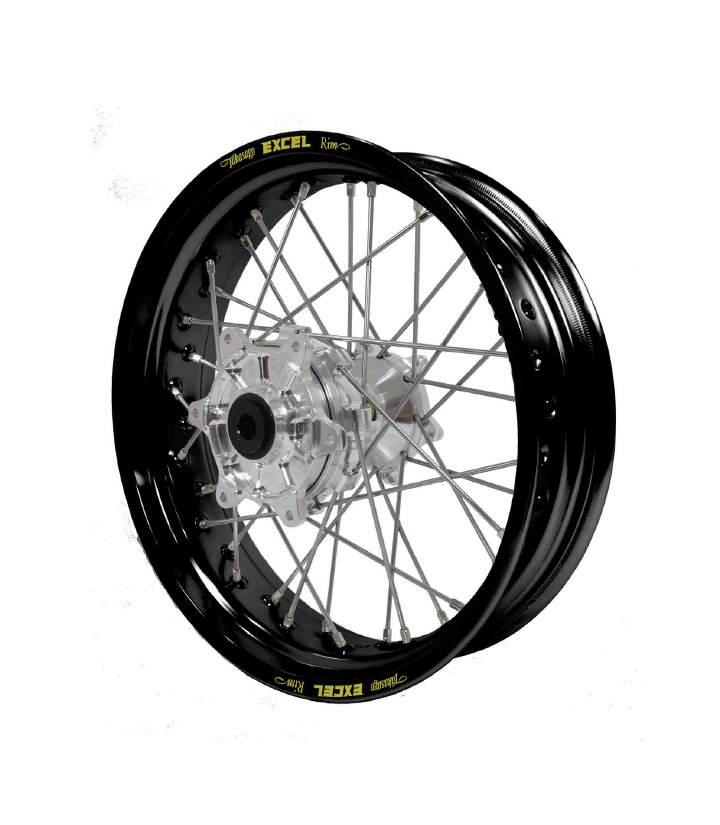
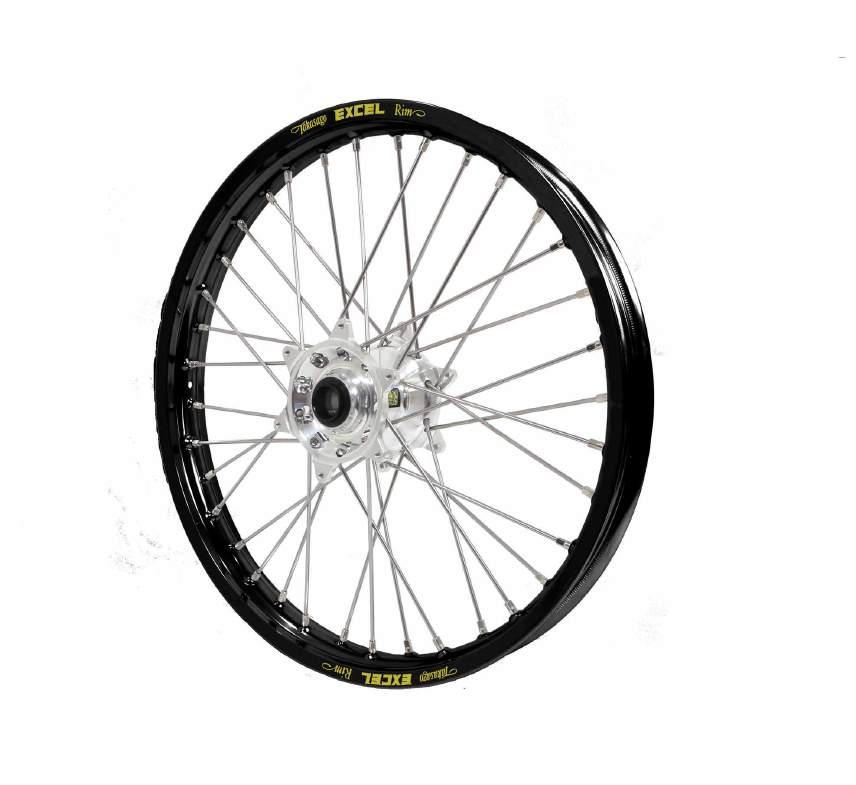
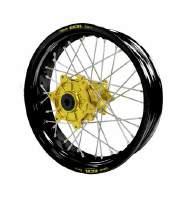
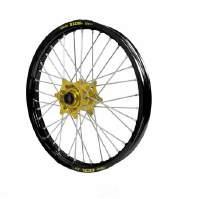
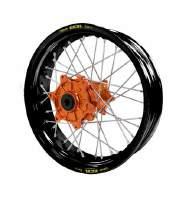
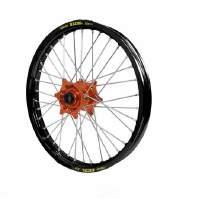
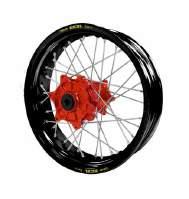
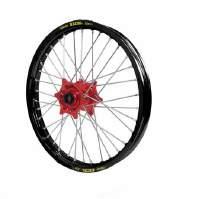
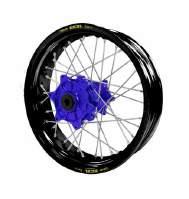
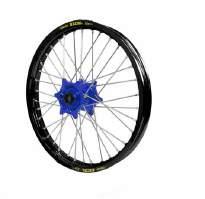
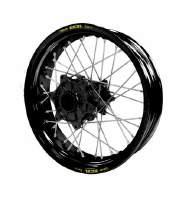
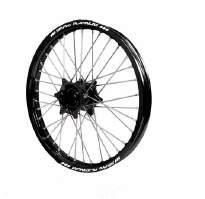
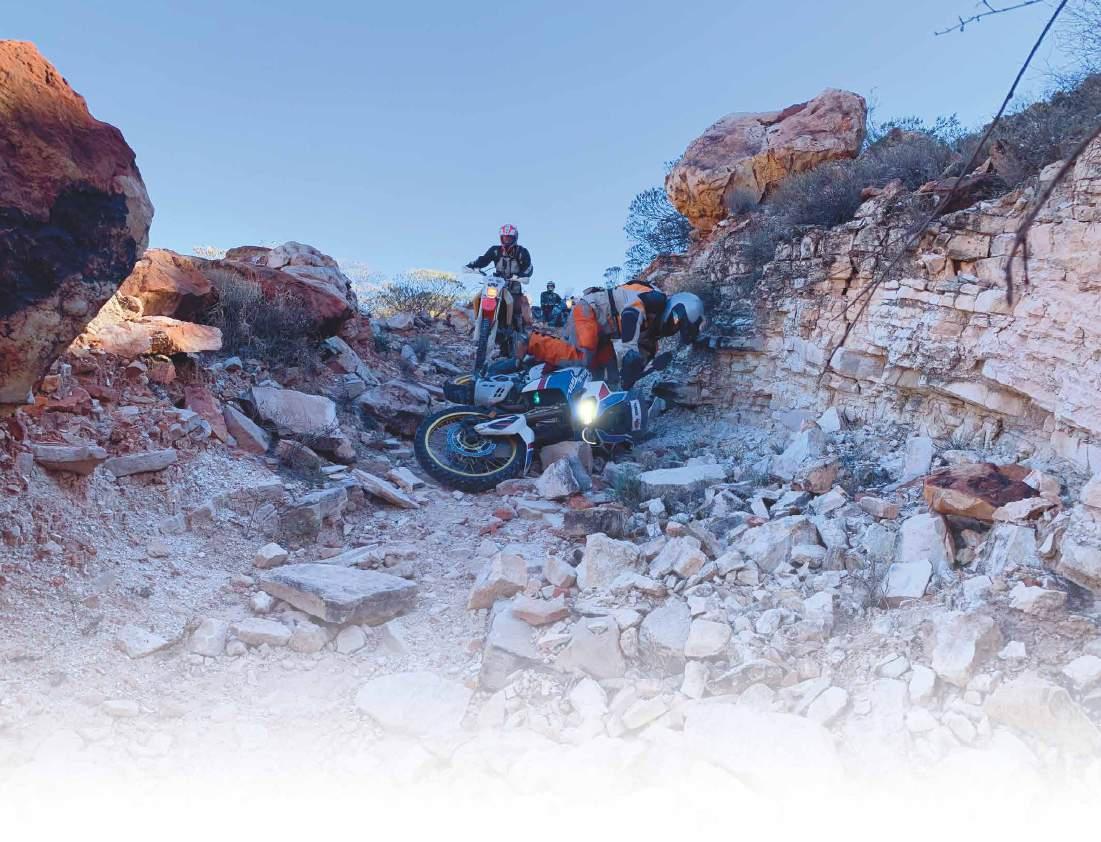
style required to get the big girl across the sand effectively. Scott and I offered encouragement and the odd riding tip, and Gav kept on trying. I reckon there would’ve been more than one occasion on that day where Gav would’ve liked to throttle us both. But to his credit, he kept at it, shared a laugh with us along the way, and by the end of the week there
was no sign of him near the back of the pack – he had the technique mastered.
Wednesday’s route, covering over 230km of dirt alone, was the most technical and had some very remote sections. We really wanted to show the riders some of the sights that regular tourists just don’t see –
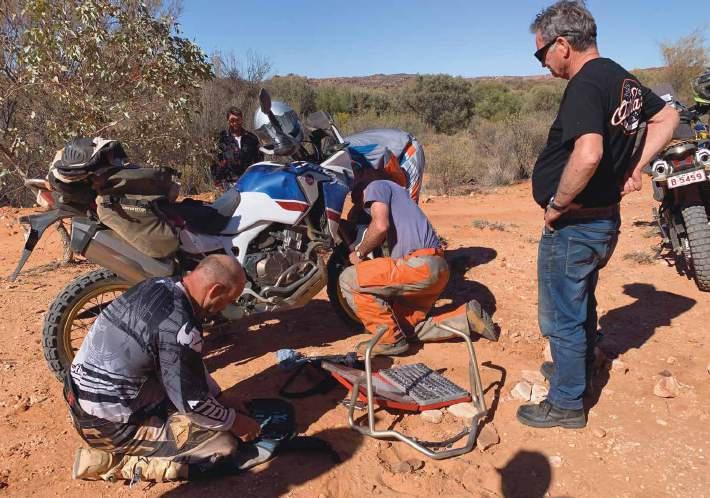
seem to mind hitting the Africa Twin’s rev limiter regularly. I can’t remember a time throughout the whole week where either of them didn’t have a smile on their dial, even though it meant a day of maintenance after the event to fix blown fork seals, a holed radiator and numerous other bent and cracked parts on the two bikes. These guys were living – and loving –every minute of it!
As we kicked back and enjoyed a cold beer together at Rallye HQ that evening, the riders were relieved to learn the following day was to be a bit easier. A visit to Santa Teresa Community and some fast, flowing station tracks in the afternoon would have everyone re-invigorated for the final day’s ride.
Rockin’
Friday came around quickly, and although just under 200km was to be covered, we wouldn’t be any further than 30km from the centre of Alice Springs throughout the day.
The mornings’ route allowed the riders to enjoy some spectacular views of the MacDonnell Ranges from numerous vantage points around the town. More than a helmet or two copped a scrape when we crossed under the Ghan railway line via a small tunnel, and after a beautiful lunch at Ooraminna Homestead, there was one final challenge awaiting – editor Tom would remember the section from last year as I’d dropped my 1190 in the big rocks right in front of his camera. This year it was Hamish’s turn to be captured on film at the precise point his Africa Twin laid down on its side.
the trade-off was that it could be a logistical nightmare to recover a broken bike or body if something happened in certain areas during the day’s ride. After reinforcing this danger to everyone before we set off, the day turned out perfectly. The highlight was some spectacular scenery in the Finke Gorge National Park, although some saw more of it than others, depending on how hard they were fighting their machines in the soft sand of the Finke riverbed. Marek ‘Muz’ Pryde and his father Hamish had ridden from Perth to Alice Springs on their Africa Twins for the Rallye, then, after the event, they were heading down to Melbourne via Oodnadatta and the Flinders Ranges. One would’ve thought they would be gentle on their equipment given the distance they still had to travel. But alas, they were quite the opposite, taking on any challenge with gusto – particularly Muz, who seemed to be fearless. He also didn’t
This final section left more than a few of the riders with sweat on their brow and all had a sense of accomplishment as we returned to Alice Springs that afternoon via the banks of the Todd River.
Another Rallye was complete. New friendships were forged. Unforgettable memories were made. This is what riding a bike was all about.
The 2020 edition of the Red Centre Adventure Rallye is scheduled for August 31 to September 4, and entries are limited to only 30 riders. Log on to outbackmotorcycleadventures.com.au for all the information and entry details.

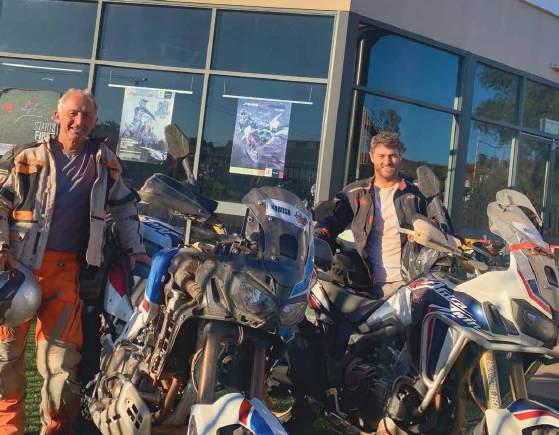
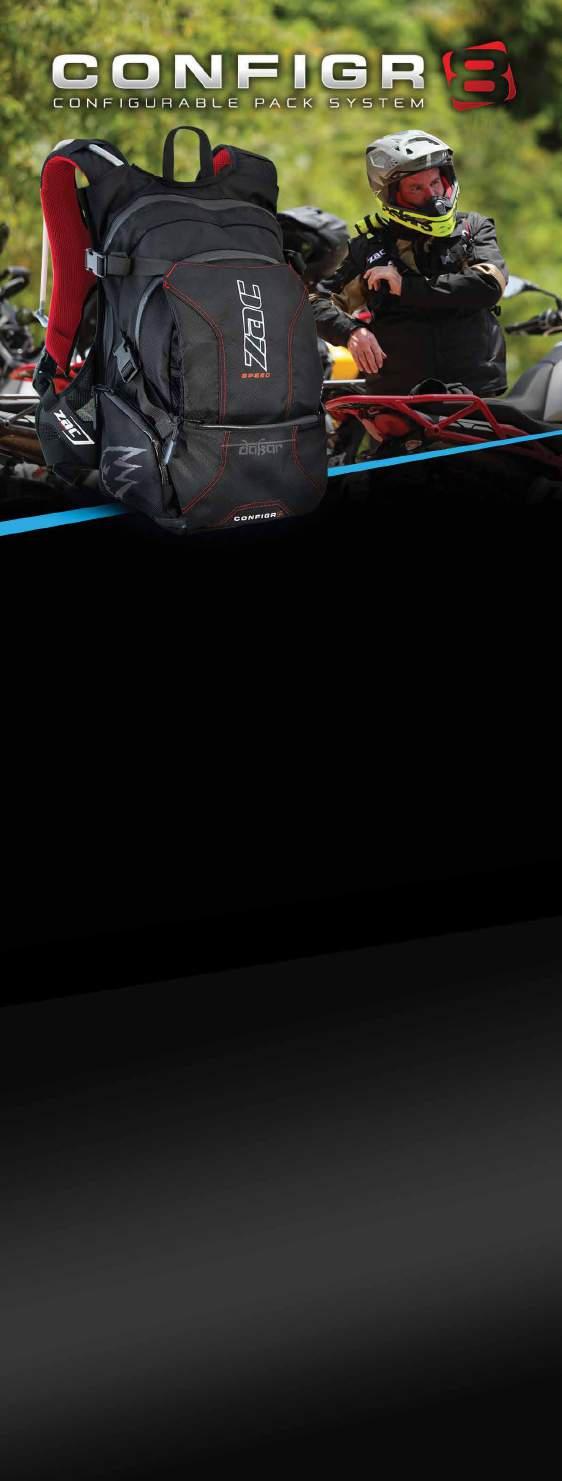

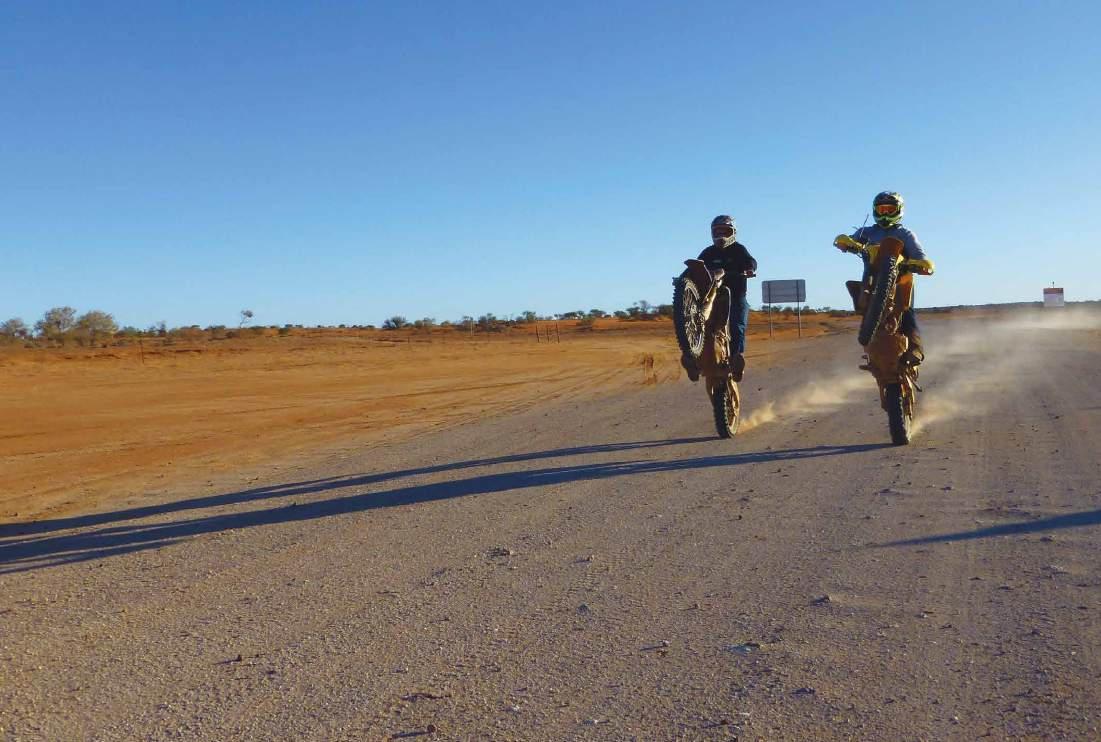
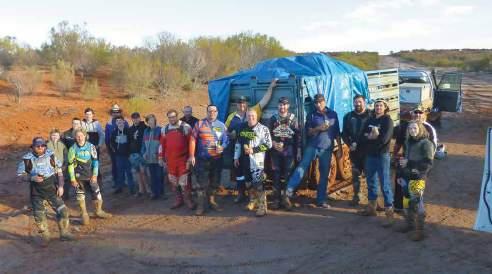
Jason Ferguson and a hardy bunch tackled a tough few days and loved it.
The idea was conceived by mates who had been on a few similar rides together, only on a slightly smaller scale (overnighters to Cameron Corner and Milparinka). Our group was very fortunate to include blokes who’d grown up in far-western NSW, knew just about every property owner along the way, and had either worked in the region most of their life or owned their own property. This was what made our trip so unique. We had
“The ride took six months to plan and in that time we didn’t see a drop of rain. Of course, the night before we left we got 35mm. Un-be-lievable!”
access to routes not commonly used and property owners keen to offer us generous hospitality ranging from hot showers to warm damper and even parts to repair one of the trailers.
Top: A quick photo and a mono comp at the border.
Top insert: Camp was in the middle of the road. It was too soft for the 4WDs to pull off the side.
Below left: Things became a little eventful. Below: All in great spirits, despite some unexpected rain. u
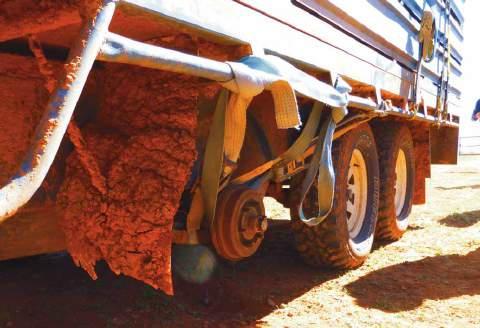
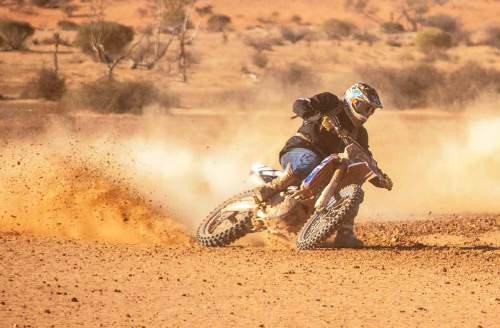
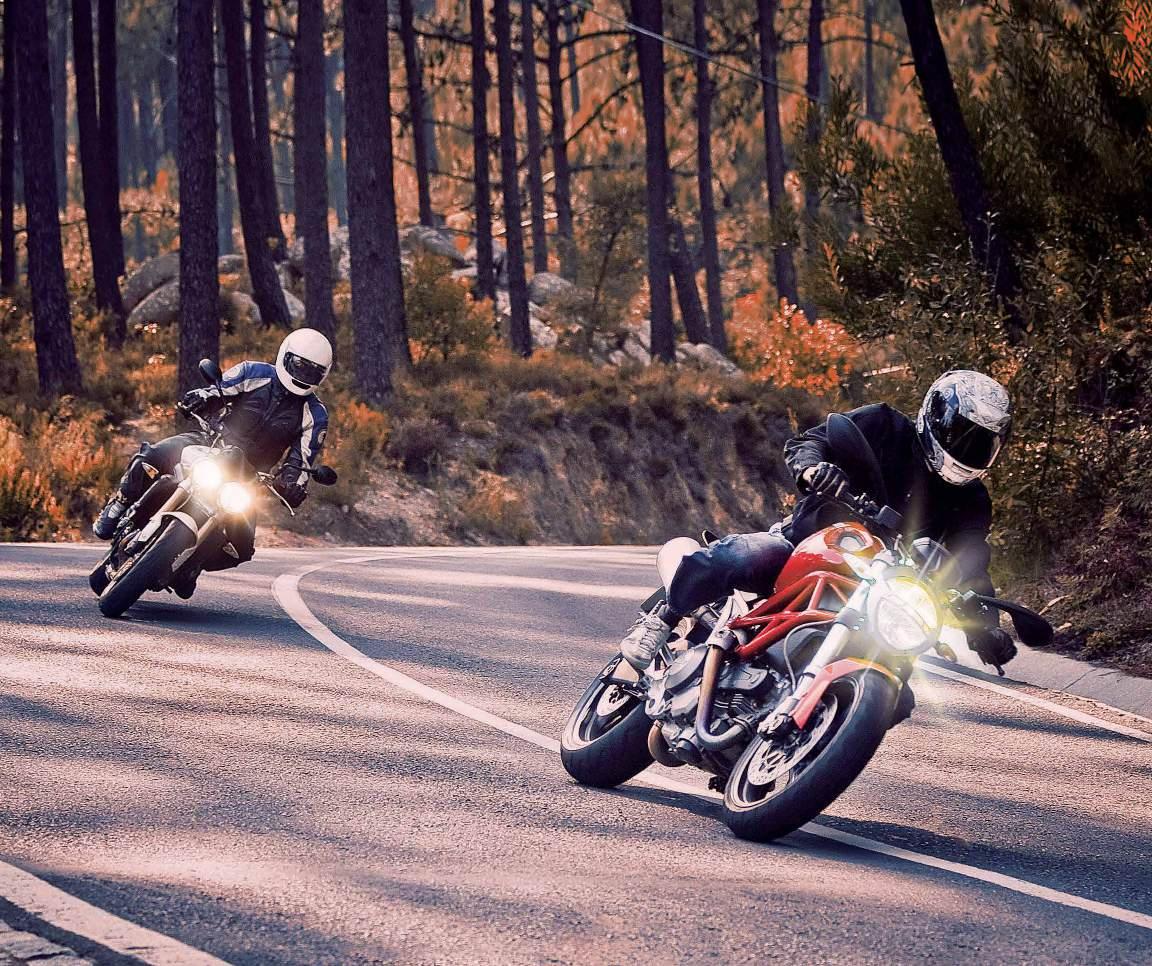

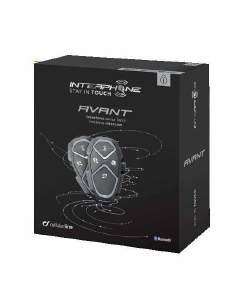
Dual Bluetooth® module
Conversation between intercoms with radio / gps / music in background
Group conference up to 8 intercoms
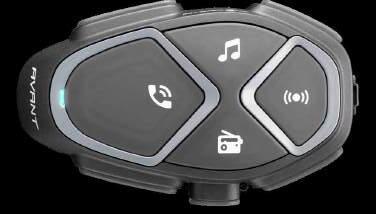
Interphone Avant is the result of studies and research in the technological field to offer a peerless product to the market.
The double Bluetooth® module ensures very high communication standards, the innovative design is imagined not to interfere with the style of the helmet.
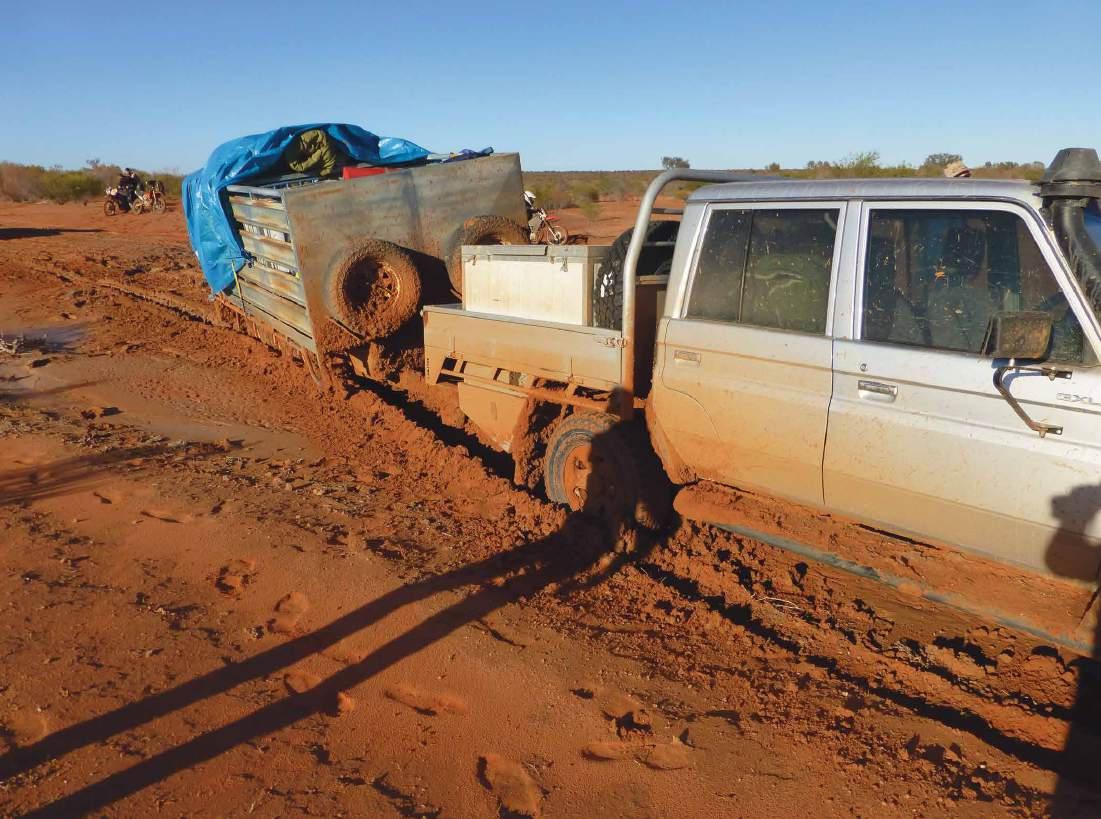
The ride took six months to plan and in that time we didn’t see a drop of rain. Of course, the night before we left we got 35mm. Un-be-lievable!
After a few phone calls to check how much rain had been received further north, it seemed our starting point at Wendalpa Station, near Broken Hill, had had the heaviest falls. We ended up hitting the track just before lunch.
Our five-day ride was half a day behind schedule before we started, but we were all in great spirits and off we went: 18 riders and three back-up vehicles.
It ended up being a pretty tough day with 180km covered and two bikes on the trailer. Out came the tutus for these unlucky riders who, by mutual agreement before the ride, had to wear them until someone else stuffed up.
It was hitting dusk when we pulled up and
Above: The snatch strap was needed three times during the first day and at least another eight times for the trip.
Below: The 230 Gang – all under 15, with their mums’ permission to miss school for a couple days and get some life lessons from their dads.
Right: Another mono comp on a massive clay pan that could’ve landed a jumbo jet.
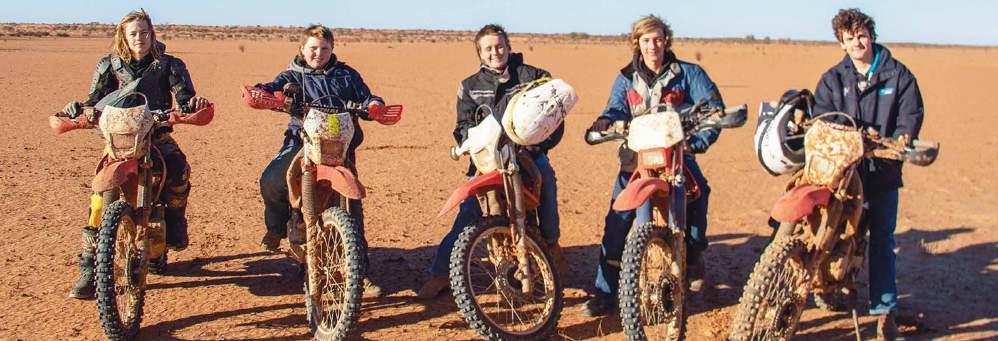
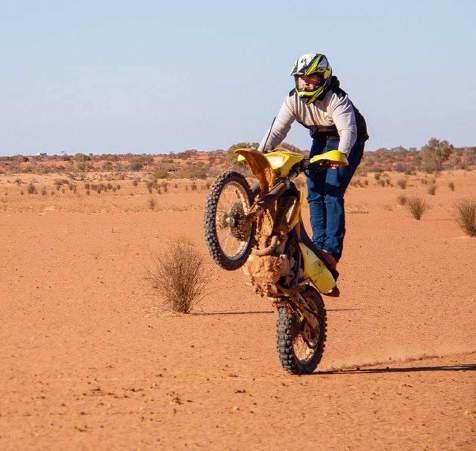
made camp in the middle of the road as it was too soft for the 4WDs to pull off the side. The lead vehicle had done a power of work getting through bogholes and running creeks, and we’d got the snatch strap out three times during the day. It was needed at least another eight times for the trip, and I tell ya what, those boys knew what they were doing!
Damper pamper Day two got off to a flyer.
We headed over the first crest and, yep, out came the snatch strap again.
“We pulled up and made camp in the middle of the road as it was too soft for the 4WDs to pull off the side.”
We were pretty sure this area had had some rain late the afternoon before, and it made the first couple of hours a little slow and challenging for both drivers and riders, until a slight detour headed across to show the young fellas the dog fence (not the only education they got over the five days, I can tell you).
The ‘young fellas’ – also called The 230 Gang – all under 15, with their mums’ permission to miss school for a couple days and get some life lessons from their dads. These young lads formed a pack behind the lead vehicle and, no matter how hard a few of us tried to get into the gang, we were quickly brought back to reality and forced to return to the pack. One of these bikes ended up on the trailer after about 100km another after 800km, but the other four rode the whole way: 1240km. Not to mention ratting around before and after our riding day started and ended. They were bloody legends!
We arrived at Cameron Corner, took a quick photo at the border, had a mono comp and beer at The Corner pub, then
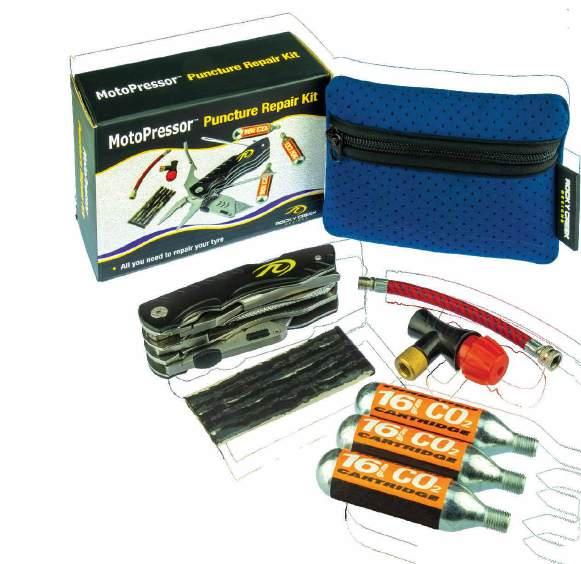
This kit contains our award winning MotoPressor Puncture Repair Tool, 5 pre-glued vulcanized repair strings, an inflation tool and 3 x 16g CO2 canisters and a neoprene bag. The bag with its contents, will take up a small amount of room in your pannier or pocket and the kit is all you will need to get you out of trouble if you get a puncture. The size of the bag containing the kit is only 13.5cm wide x 10.5cm high x 4cm depth and weighs just 582g.

Available from Rocky Creek Designs or all good motorcycle stores through Pro-Accessories
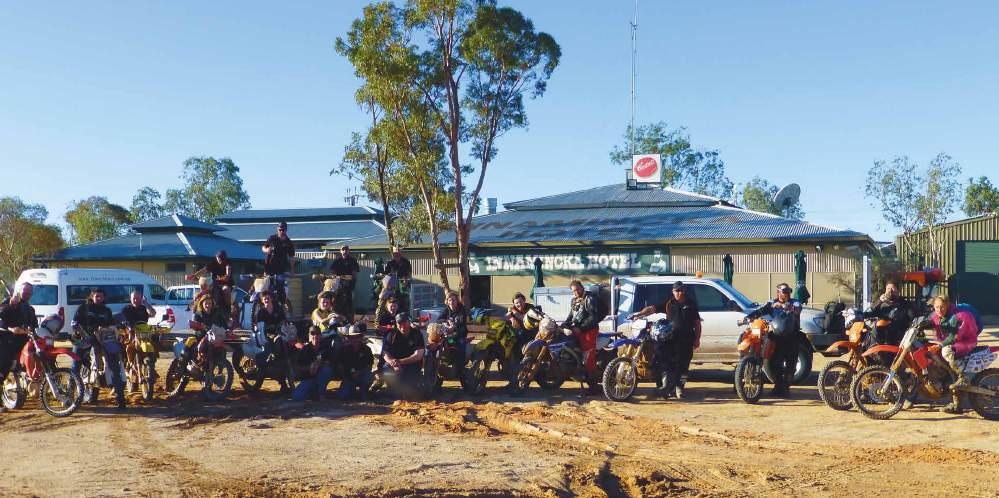
bolted up the road to Bollards Lagoon for the night. We owe a big, big thanks to Grant and Gina Rieck for their generous hospitality, with warm damper on the table waiting for us and a hot shower the perfect reset for the next day.
Day three began with a photo session out the back of Bollards and another mono comp on a massive clay pan that could’ve landed a jumbo jet. We had to make up some time to ensure we got to Innamincka well before dark, so apart from dodging a few boggy marshes and some running repairs to a couple of bikes, the day ran fairly smooth. If one of the bikes broke down we were taking parts off that one to get another one going. This went on for the five days, with bikes rotating on and off the trailer and riders wearing the tutus. Good stuff!
Into the Innamincka pub we went for a well-earned beer.
We had four bikes on the trailer by then
and some funny stories about our get offs and close calls, but most importantly, we all got there in one piece.
We’d come a long way so we took the opportunity to get a few photos as we passed Rams Rock and Copper Creek running over the road, then out to Nappamerrie Bridge to camp for the night. In the morning we rode out to Durham and checked out the Burke and Wills Dig Tree and took in some Australian history.
The next two days travelling back to Broken Hill was where things became a little eventful. We lost a rider to a couple of broken ribs and one of the trailers was missing the bolts holding the axle to the springs. We stopped in at Epsilon station to catch up with Graham and Sharon Betts, and they were happy to lend us tools and parts to repair the trailer (there wasn’t much they could do for the ribs).
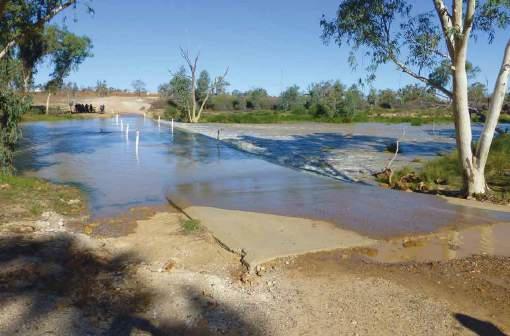
Above: Four bikes were on the trailer by the time the group arrived at Innamincka. Bottom left: After six months with not a drop, 35mm dumped on the night before departure. Below: Celebration at The Corner pub.
We reached Omicron Station where Mitch Rodgers put us up for the night. Another great feed and hot shower had us ready for the final stretch the next morning.
The last day was a big day. We had to cover 400km to get back to our starting point at Wendalpa Station and it included another casualty along the way, this time a broken thumb. It put a bit of a dampener on the day, but the boys stayed switched on and we got home just as the sun was going down.
A big thanks to our back-up drivers Will Thomas, Dick Maiden and Gary Milnes. Without those blokes the trip would not have been possible. Lastly, thanks to the brains behind the whole ride, Mr Innamincka, Todd Ferguson.

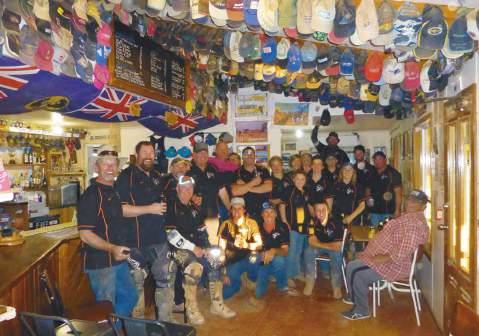

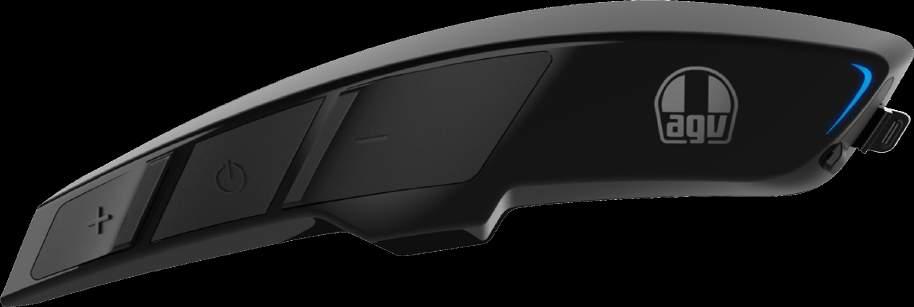
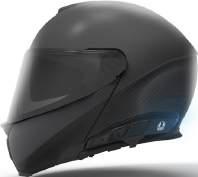
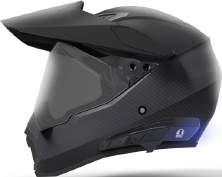
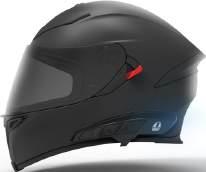
AGV ARK is here and ready to change your ride. Seamlessly communicate with up to 4 riders simultaneously, with only the click of a button. Designed specifically for AGV helmets, it allows you to talk to riding companions up to 1.6 km away, take calls, listen to music and more.
The longest stock route in the world covers over 1700km through the Gibson, Great Sandy and Tanami deserts between Halls Creek in the north and Wiluna in the south of Western Australia. It’s one of toughest rides on the planet. Dakar finisher Scott Britnell set a record for riding the CSR a few years ago. When he saw the record broken earlier this year, he decided to have another crack it. Here’s his story in his own words…
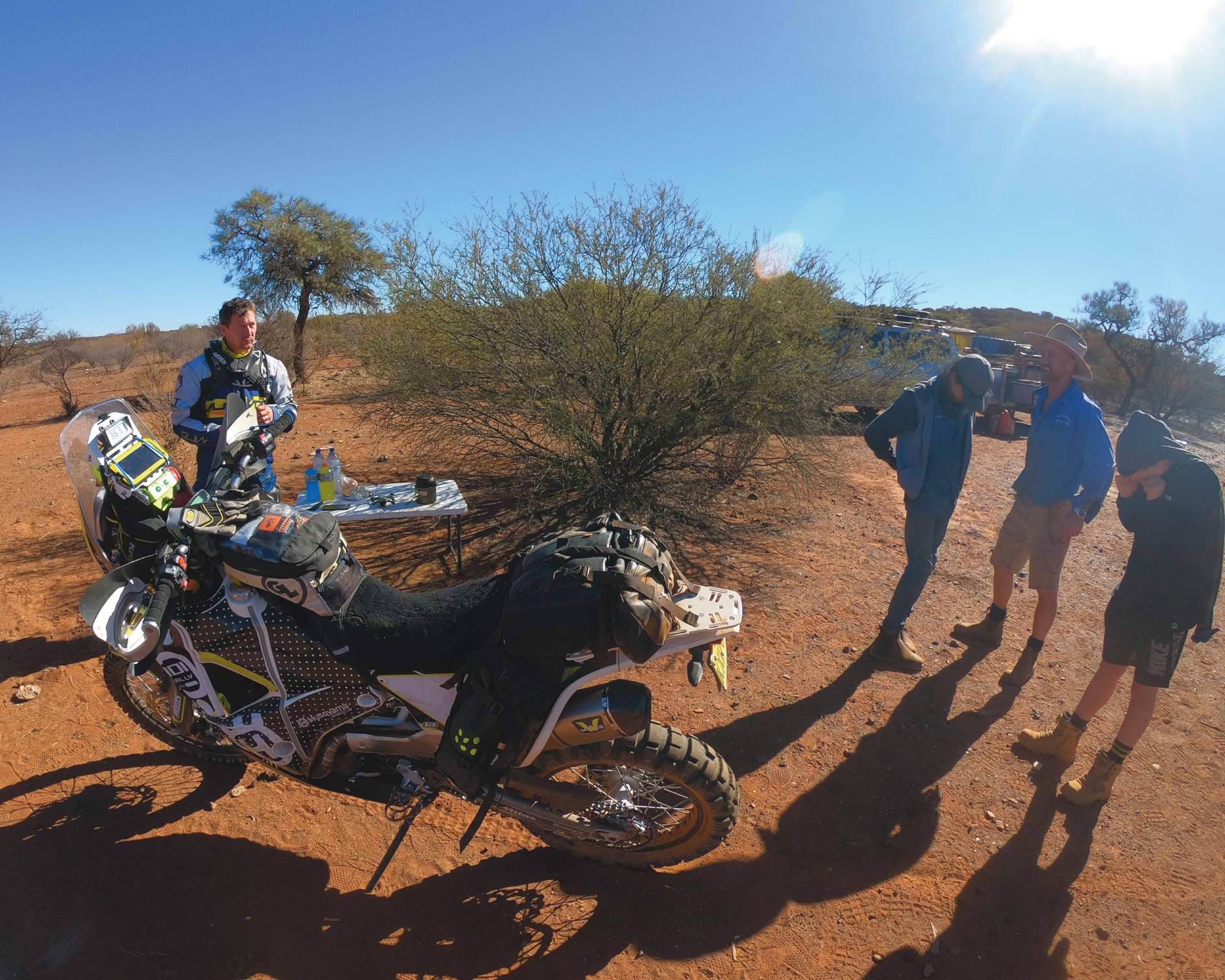
Back in May 2015, purely as a personal endeavour to push the boundaries, I decided to tackle the Canning Stock Route in a continuous, solo and totally unsupported ride. Seven months prior I’d had the opportunity to have fuel buried in nominated locations by some friends. They took a GPS fix and drew me a simple sketch from an identifiable marker on the track. I’d never ridden the Canning and had no concept of the terrain, or if the fuel would still be okay after a full, blistering summer in the desert.
When the day came I lined up at the southern end, full of apprehension. I’d put a lot of effort into my research and planning, but I knew that if it all went
to custard it wouldn’t be an easy or timely recovery. As I wheeled onto the stock route proper at Well 2, the weather immediately took an unexpected turn for the worst. Just on100mm of rain is not a great day on a bike at the best of times, but out there where help is always hard to find, I didn’t feel great about what lay ahead.
I literally waded through the multitude of flowing creek crossings and the muddy salt pans prevalent in the first 300km. What should have taken me between five and six hours took me 12 hours, and by the time I reached my first refuel cache at Well 9 both sets of brake pads were totally gone.
Well 9 was my last opportunity to bail out by heading east through better terrain and back to Wiluna,
Left: Well 9 refuel. Good to see the boys and have a hard-earned coffee and biscuit.
but with no foreseeable opportunity in my work schedule to get back for another run, I decided to grit my teeth and push on.
The track was still very wet, and after 23 hours of constant runtime I arrived at my second fuel-and-water cache, only to find fuel had leached out of the plastic jerrycans, through two layers of plastic bags, across a clear metre of soil and into my water bottles.
Finally with some dryer conditions, some shit-tasting water, and a couple of cans of tuna for good measure, I pushed on to Kunawarritji Community and all the way to finish the ride at Bililluna Community after a continuous 47.5 hours in the saddle. It was an epic and memorable
“By the time I reached my first refuel cache at Well 9 both sets of brake pads were totally gone. ”
ride, but one that didn’t really give me the satisfaction I was looking for. I already knew a clear run in dry conditions would set a much better time. The only real satisfaction was knowing I’d pushed myself harder and for longer than I ever had on a bike before. It was a time to just let it be and move on.
Six weeks later I was riding across Kazakhstan, Russia and Mongolia filming Motonomad 2.
Four years later, in May 2019, Garry Connell, a veteran of several Dakar campaigns and a local Sandgroper who knew the track better than most, laid down his hand. After more than two years of planning and patiently waiting for the conditions to be right, he took on the Canning. At 63 years of age, Garry put in a massive and commendable effort with a hassle-free run to finish up in a time of 38 hours and 51 minutes. I was quick to offer a well-deserved congratulations, but equally as quick to assess if I could put
u
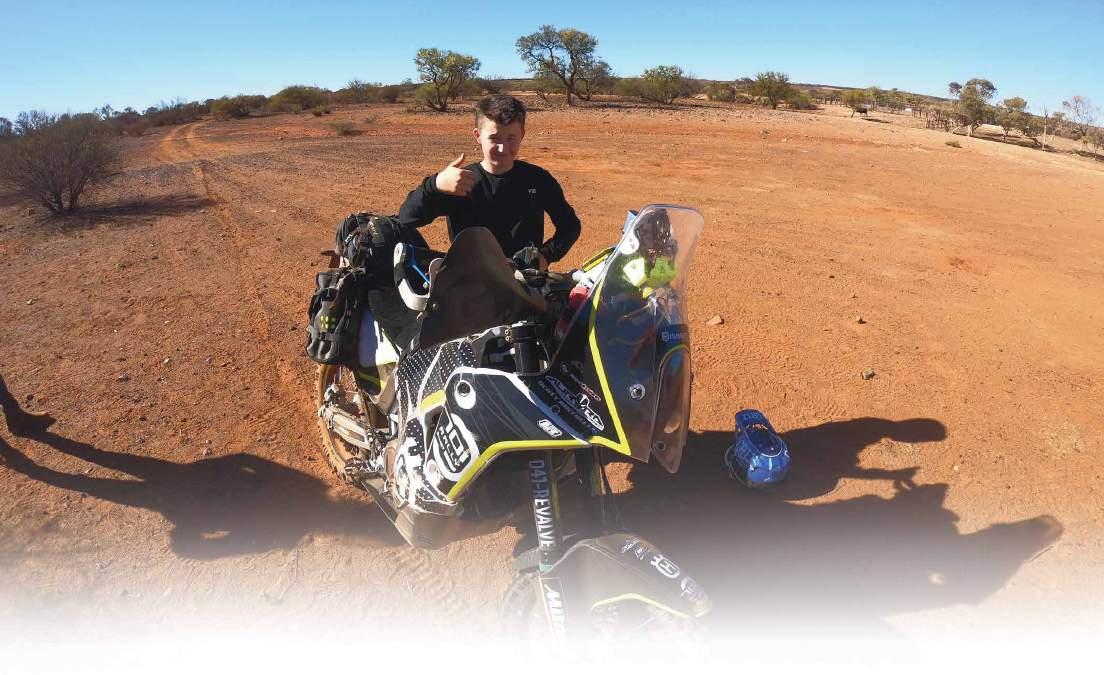
things in place for a rapid counter. It was time for action!
Fortunately I’d recently finished building a Husky 701 adventure weapon, so a plan all hinged on logistics. A 1650km track through the middle of Western Australia’s more remote territory is not an ‘easy do’. In simple terms, even a basic plan requires getting your bike and self to a start point, having fuel placed at strategic locations, decent mapping, a contingent of people ready to crash out the door in the event things go wrong, and of course a bit of physical and mental preparation for the hard slog.
A couple of quick calls to mates all around the country netted me the support needed to confidently hit the ‘Go’ button.
The plan was:
Step 1 – Get the bike to Darwin (thanks Bikes Only)
Step 2 – Lock down a couple of mates to drop their lives and converge on Newman, head out into the wilderness and lay some fuel (thanks boys)
Step 3 – Fly into Darwin, have a quick barbeque with a few locals. Tell some stories of previous riding exploits. Hitch a lift with another mate towards Halls Creek
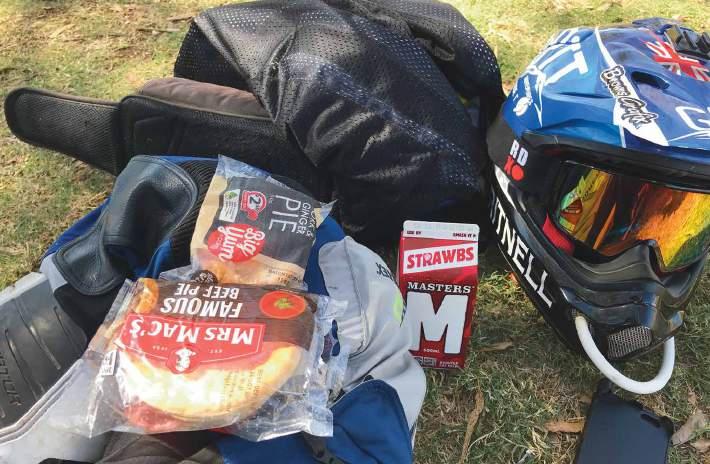
Left: Scott’s son Jade in on the action and giving his thumbs-up approval of the trusty 701.
Below left: Preride breakfast of champions. Right: That Dakar mousse had done its job. There’s nothing like a sub-zero roadside mousse change with a pair of stumpy levers!
leak like a bush shower. It was time to do some serious maths to see just how little fuel coud be allowed for a laden 701 in the sand to make it the 650km to the next fuel stop. Crikey. I had to buy a five-litre fuel caddy and shift my entire gear load to find a spot for it
(thanks Tim Walker of ‘Bike You’ in Darwin)
Step 4 – Ride the last 350km of tar to Halls Creek to confirm the bike was running as sweet as she looked
Step 5 – An obligatory rough night’s sleep on the ground in the local caravan park
Step 6 – Get the call from the boys that the fuel cache was in place at Georgia Bore. I was told, “There’s a sign at the entrance to Georgia Bore. It’s 17 paces
“Did some more math on the fly. I wasn’t sure I was going to make it. ”
behind the sign on a bearing of 120 degrees, under a bush. You can’t miss it mate.” What could possibly go wrong with that plan in the dark? Boxes ticked. Ready to proceed
Step 7 – Get a good last feed before heading down to Bililluna Community at the top end of the CSR. That was a massive fail. Never rely on a good meal in Halls Creek where you can keep an eye on your hardware. A pie and a strawberry milk had to do
Step 8 – Ride down to Bililluna and fill the bike with the ultra-low-octane OPEL fuel. Oops. The extra fuel bladders I hadn’t used since Mongolia in 2017 seemed to
Step 9 – Ride out of town just far enough that the local dogs couldn’t smell my preride dinner of canned tuna and crackers. Spend another night under the stars in nothing more than an emergency sleeping bag and make some serious decisions about what to leave behind to make room for the new fuel can. Out went the spare front tube, survival blanket, half the emergency water and food.
There was no room for error from then on. It was time to suck it up and just toss the dice.
That’s how we roll!
After the usual very average sleep, another can of tuna and an apple for brekky, I hit the SPOT tracker and set off from Bililluna in the dark at 4:00am. I disciplined myself to keep things ‘steady as she goes’. needed to conserve energy and just run a smooth line. I had to keep my eyes peeled for those little ant hills in the long grass just waiting to break an ankle or foot. I had to stick to my wheel rut, and not start thinking the other was
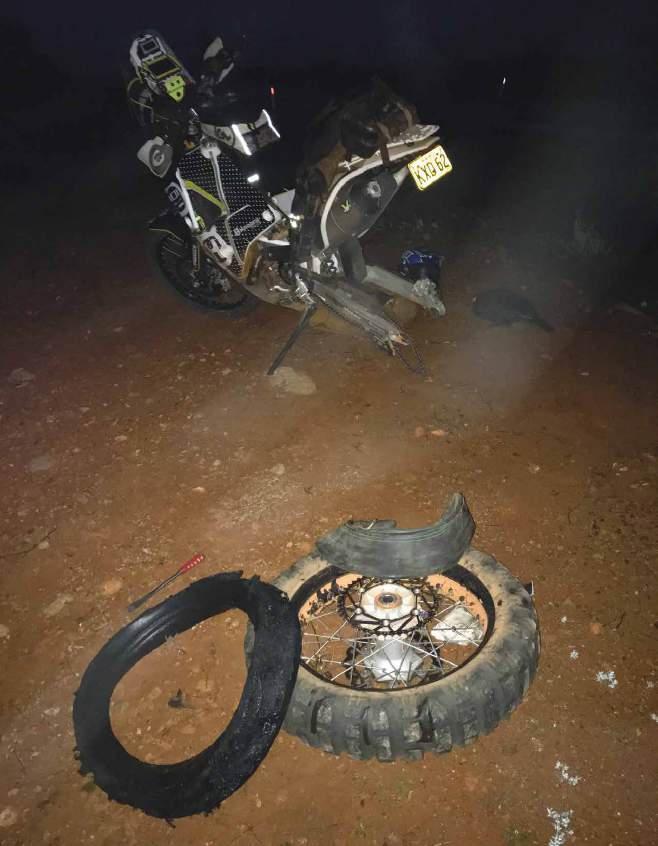
better – those ant hills were in the middle of the track as well.
After a quick fuel transfer and redistribution of weight at Well 49 I kept up the steady pace. I just needed to keep moving and make the Kunawarritji Community servo before she closed for the night. The bike seemed to be drinking the outback
OPEL fuel faster than I thought and I did some more math on the fly. I wasn’t sure I was going to make it.
When I didn’t see any vehicles for quite a while I thought it might be time to take it easy on the throttle, and by Well 38 I knew I definitely wasn’t going to make it to my next fuel cache. I’d blown the
u





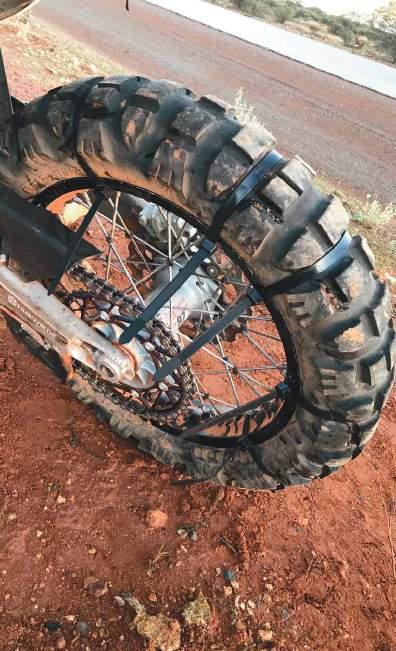
a quick refuel and a very average Cornish pasty and a Powerade to recharge. Then it was time to make hay while the sun was still shining.
The next section was way more overgrown than remembered, but just as rocky. There was no sightseeing – just pure focus on the section of track just forward of the front wheel.
The Georgia Bore refuel – hidden 17 paces behind the sign – came into sight an hour later than planned. There was no time to fix the Camelbak that hadn’t played the game since lunchtime and hydration was for pussies anyway.
I powered on until a soft glow appeared ahead.
“Evening gents,” I called to some campers. “Do I go left or right here?”
“Left,” was the reply. “Want a coffee mate?”
“Hell yeah! White and bloody sweet please. Can I sit near your fire while you make it?”
“No worries. Want some leftover loaded baked potato as well?”
“You bet do. Can I have another spoon of sugar for good measure? I’m on a bit of a mission. I’d better get on the move before I get too comfy.”
By 2:00am the pace had slowed and it seemed to be taking forever to knock
down the miles. Fatigue made it hard to focus and was off into the bushes from time to time. The fingers wouldn’t work and the legs were starting to cramp.
By 4:00am I’d been on the go constantly for 24 hours. I couldn’t seem to stretch out the cramps in my stomach and I decided to stop and get my shit together.
open up. I lifted the pace and daybreak, open dunes and an easier section allowed me to get back into the groove. I knew it was time to push and make something of this ride. There was only another 120km to the final refuel where the boys would be waiting…maybe they’d even have a coffee ready.
After two broken cable ties and an argument with a washout the boys did get to town before me. But that didn’t matter. What mattered was my time: 35 hours and 17 minutes. You little ripper!
Not bad for a rough plan and a bunch of mates ready to drop things to lend a hand.
deal in the first 12 hours.
There was no point stressing. I just kept plugging away and hoped for the best.
Meet’n’greet
Some fresh bike tracks appeared, and then a group people.
“Hey boys,” I called out when I found them. “How’s your ride going?”
“Yeah, not bad mate,” came the reply.
“We’ve got six in the group ahead of ya.”
“Any chance of a few litres of fuel? Think I’m running a bit lower than planned.”
“No sweat, let me radio the support truck.”
“Good man. I owe you one.”
That was the bit of luck I needed. It was much appreciated.
With more fuel on board it was time to up the ante.
made good time in to Kunawarritji for
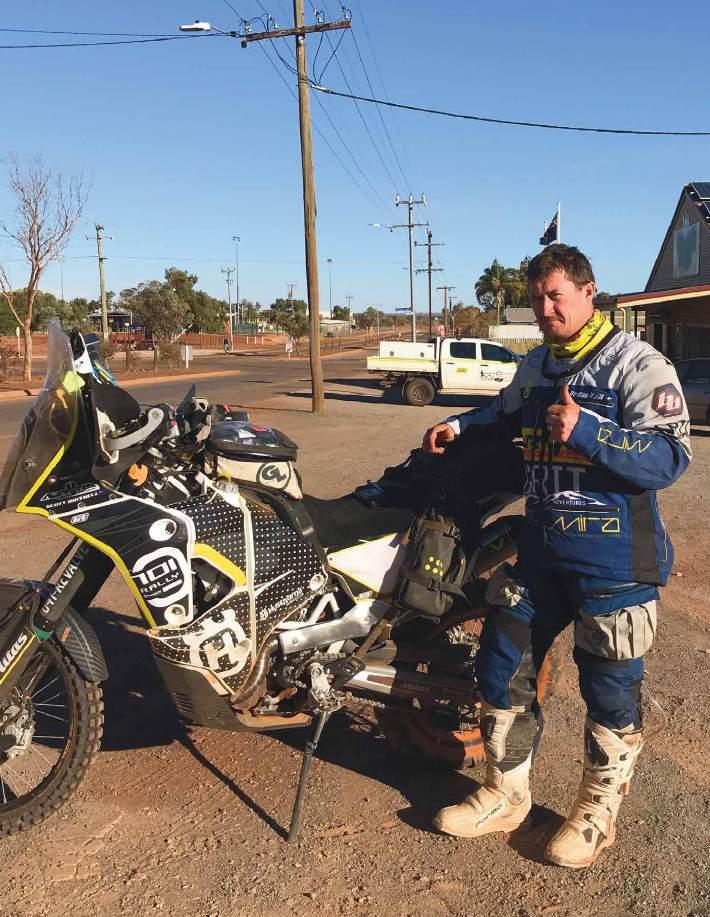
“No time to fix the Camelbak that hadn’t played the game since lunchtime and hydration was for pussies anyway. ”
At 5:00am it was time to stop rolling around on the ground like a dead fish.
“Suck it up princess!” I told myself. My tired mind ticked over some more math on the fly. I was on track. I just needed to get through the current section of dunes and the track would
At Well 9 I was one minute ahead of schedule and things were looking good. There was no need for an F1 pit stop. This game wasn’t a matter of seconds. Besides, I’d been pissing through a tube the whole ride just to have time to say hello! I needed to get off the bike, eat something and stretch my legs.
From there it was an easy 300km to Wiluna. I could smell the end. I figured I should be on my third beer by the time the boys got into town via the easy road to the east.
But the track wasn’t the way I remembered it. It seemed it would never open up. The rocks and creek crossings were relentless.
“There’s no need to panic,” I told myself. “Keep it together. You’ve got this.”
I should probably mention not making it down to Perth without incident.
A suspect rear mousse I still had in the shed from Dakar, one I knew I shouldn’t have used but did anyway, finally let go and destroyed the tyre along with it. It was time to send that random Facebook SOS (thanks Pete). So what’s next?
Unfortunately that was my one week of riding for the year spent. I am now in full swing, planning our GRIT Adventures’ Mongolia Tour for May 2020. We have most of our slots full, but if you’re quick, you might just get a look in.
Check the Scott Britnell Go Ride It Facebook page for details.

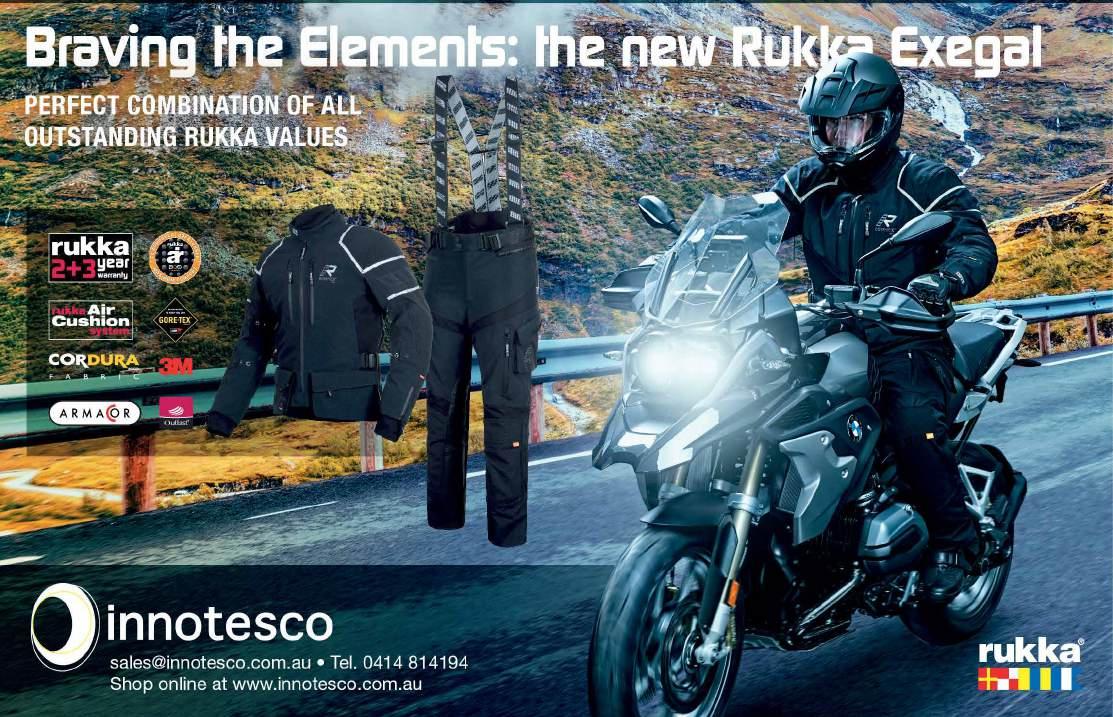
Rainbow, Mt Turner, Black Range, Mt Cole and the townships in between are well-known Victorian landmarks. Graeme Sedgwick strung them together to make an adventure-ride through history.

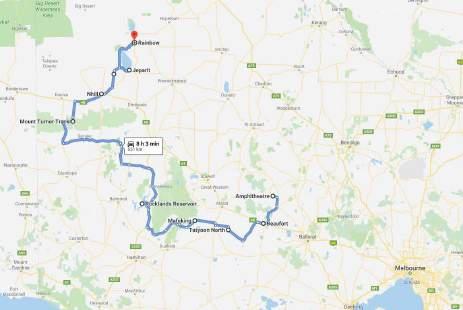
What I didn’t expect out front of the Royal Hotel in Federal Street, Rainbow, was to be greeted by a bloke from the Australian Defence Force’s Bridges Barracks wearing bright-red braces.
“Welcome,” smiled Roger Aitken. “If you’re after a beer and somewhere to crash, this is the place.”
Named after a curved sand dune covered with wildflowers in the shape of a rainbow, the mallee metropolis sits in the heart of serious wheat country spiked with grain silos visible from kilometres away. It has personality, and that’s probably
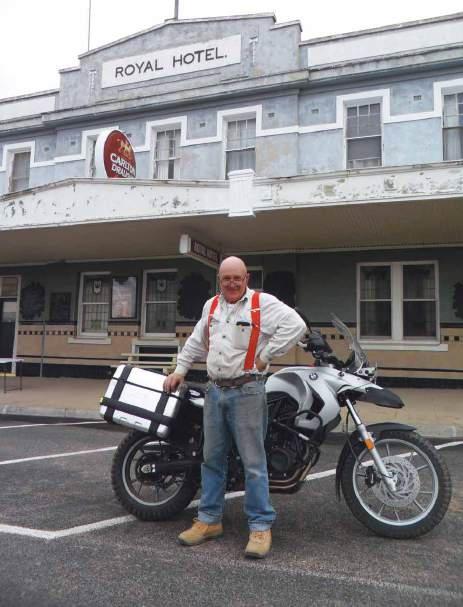
why it gained some exposure in an episode of ABC television’s Enough Rope with Andrew Denton in 2006.
Mid-year mornings in these parts can be icy and mixed with pea-soup fog until things warm up, often to reveal cloudless blue skies. The clear skies and sunshine can lull travellers into a false sense of everything being okay, when in fact these parts need rain to survive.
From Rainbow the route tooled along unsealed roads flanking Lake Hindmarsh to Jeparit on the Wimmera River. A place notable because one of its sons, Robert Menzies, became an Australian Prime Minister. Jeparit commemorates the achievement by way of a spire topped with a monument resembling a Scotch thistle in the main drag. Sir Robert’s ashes and a memorial bust proudly mark the local boy’s contribution to the nation.
Next up on the Western Highway, halfway between Adelaide and Melbourne, was the township of Nhill. It was an important stop because Nhill has a great map shop which offered quality reference material for an excursion to Little Desert, population five, about 17km south of Nhill. Interestingly, Nhill was the first Victorian town after Melbourne to be supplied with electricity and also served as a major RAAF training base during the Second World War. Today the town’s major employer is Luv-a-Duck, a duck-meat grower and processer sourcing birds from more than 30 farms, including five of its own in the region.
Off the Western Highway south into desert country I went. Under no illusion that a sense of adventure often comes from
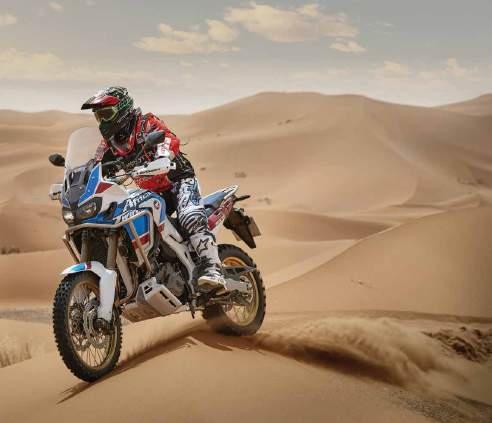


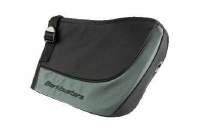

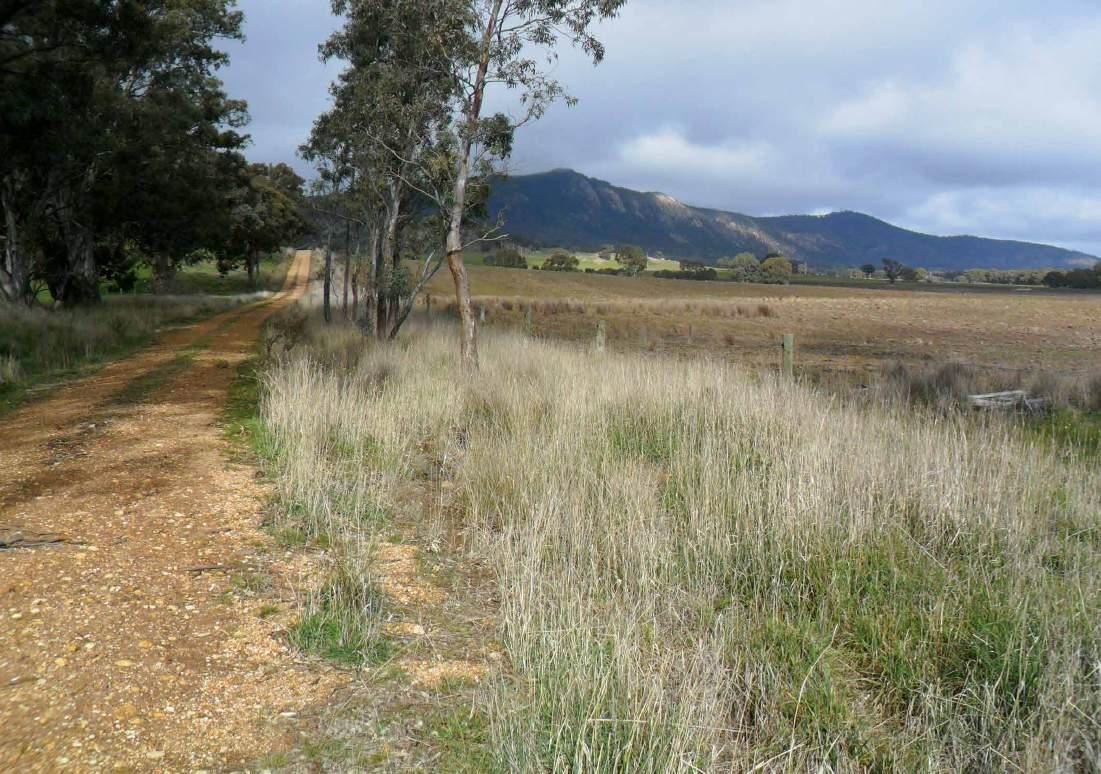
the difficulty in achieving it, I had the map sorted, and, loaded with ambition, I knew the more terrain I could cover the more my saddle experience would grow. Initially things were pretty straightforward, but the road surface deteriorated into loamy sand. Eventually it looked like more sand than I’d ever faced before, and the ‘experience’ stretched my skills.
In a blink the game had changed. It’s not that it hadn’t occurred to me it might happen. It’s just that when reality kicks our arses – or more precisely before we ROOT (run out of talent) – it measures our capabilities against what was intended to be a ‘straightforward’ ride. My riding style morphed into more of a ploughing style which, if nothing else, was at least in sync with what farmers do best in the open spaces in the west of the State.
Mt Turner
Body and soul awash with adrenalin fuelled by the bike’s bucking and flicking, a consequence of my complete lack of sand-riding talent, it was a glorious day to be out amongst it all aiming for Mt Turner. Inspired – if that’s the right
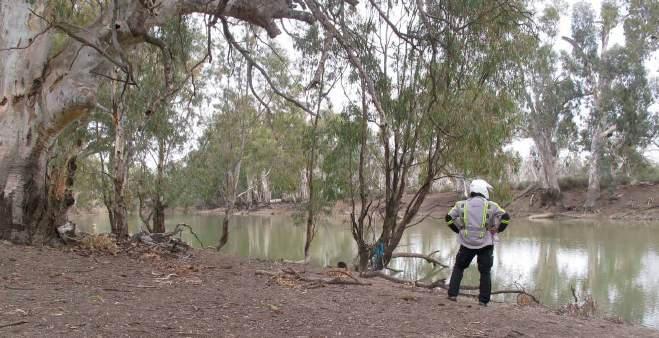
expression – by energy deep within that there was a glimmer of hope, I slowly overcame the difficulties of the adventure I’d dumped myself into within Little Desert’s 132,647-hectare wonderland. Surrounded by agriculture, western Victoria’s Little Desert sits in an almost featureless landscape. It consists mainly of deep, low-fertility sandy soils interspersed with pockets of clay, occasional rocky, sandstone outcrops and buckshot rises broken into three blocks: western, central and eastern. The blocks are split by two north-south roads, and the whole thing sits between the Wimmera River and South Australian border near Naracoorte. Mt Turner was conquered and my passage then headed along the line on the map signed ‘McDonald Highway’. It was no highway as I understood the
term, but figuring I’d learn a great deal in the heavy going I kept on until hit some more positive surfaced roadways.
With the desert country behind me a zig-zag journey wandered cross-country, passing the abrupt rises in an otherwise flat rural landscape known as Mount Arapiles in Tooan State Park. Arapiles is one of Australia’s premier rock-climbing sites, along with the nearby Grampians, which I approached from the west along some of the surrounding Black Range’s many unsealed tracks skirting Rocklands Reservoir. The dam also offers any number of excellent spots to camp and fish. Into and through the Grampians I rode, with more ups and downs and trail options ranging from tame to daunting. I chose to
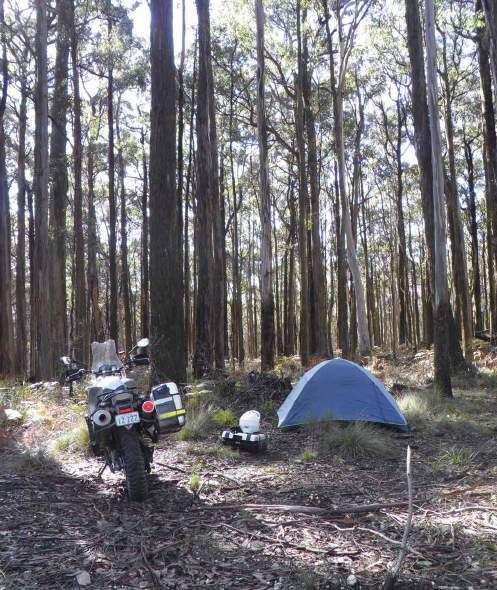
Left: Looking toward and along Mount Cole State Forest western region. Left insert: Quiet time at the Wimmera River. Above: Camp at Mount Cole.
avoid the unknown trails having listened to the exploits of a very capable rider mate, ‘Davo’, who’d thrown his Husky 501 up and down what he’d called ‘some very marginal choices’.
I continued east from ‘The Gramps’, through towns like Mafeking, Watgania, Kia Ora, and Tatyoon North, sticking to a network of unsealed back roads. The roads led toward Buangor from the southwest and on into Mount Cole State Forest.
Part of the Great Dividing Range’s southern reaches, the Mt Cole area could also be described as a gateway into the Pyrenees district of the Grampians, sitting slightly northwest of Beaufort, just north of the Western Highway.
Covering an area of 12,150 hectares, this peaceful forest sits on a plateau about 760 metres above sea level, above grassy agricultural plains with its high peaks of Mount Buangor at 1,090m, Mount Cole at 899m and Ben Nevis at 877m. Mount Lonarch towers southwest of Amphitheatre and collectively it’s an area that offers an assortment of forestry country loaded with riding options.
The region has some spectacular hide-away places to set up camp, either to enjoy the serenity in the many stands of messmate, manna gum, blue gum, yellow box and red stringybark, or simply kick back among the kangaroos, wallabies, echidnas and koalas. It’s a perfect place to recalibrate priorities and, more significantly, chart the next adventure.

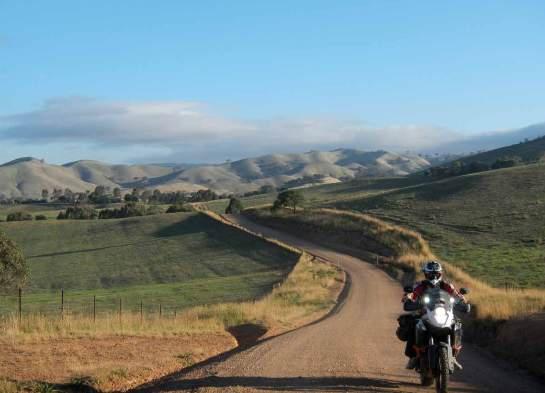
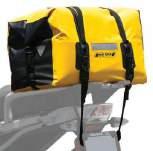
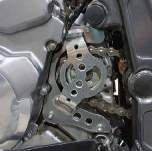
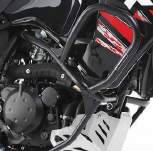
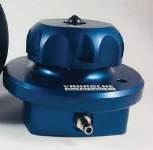
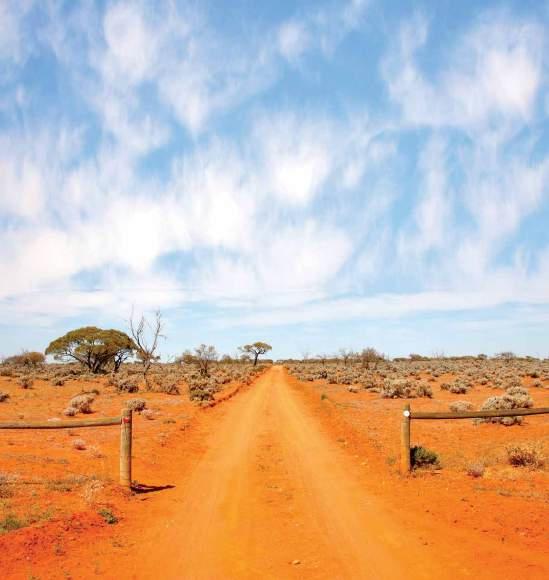

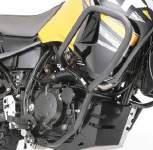
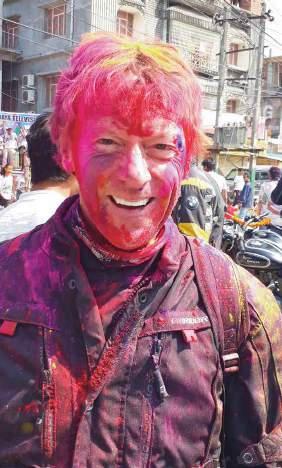
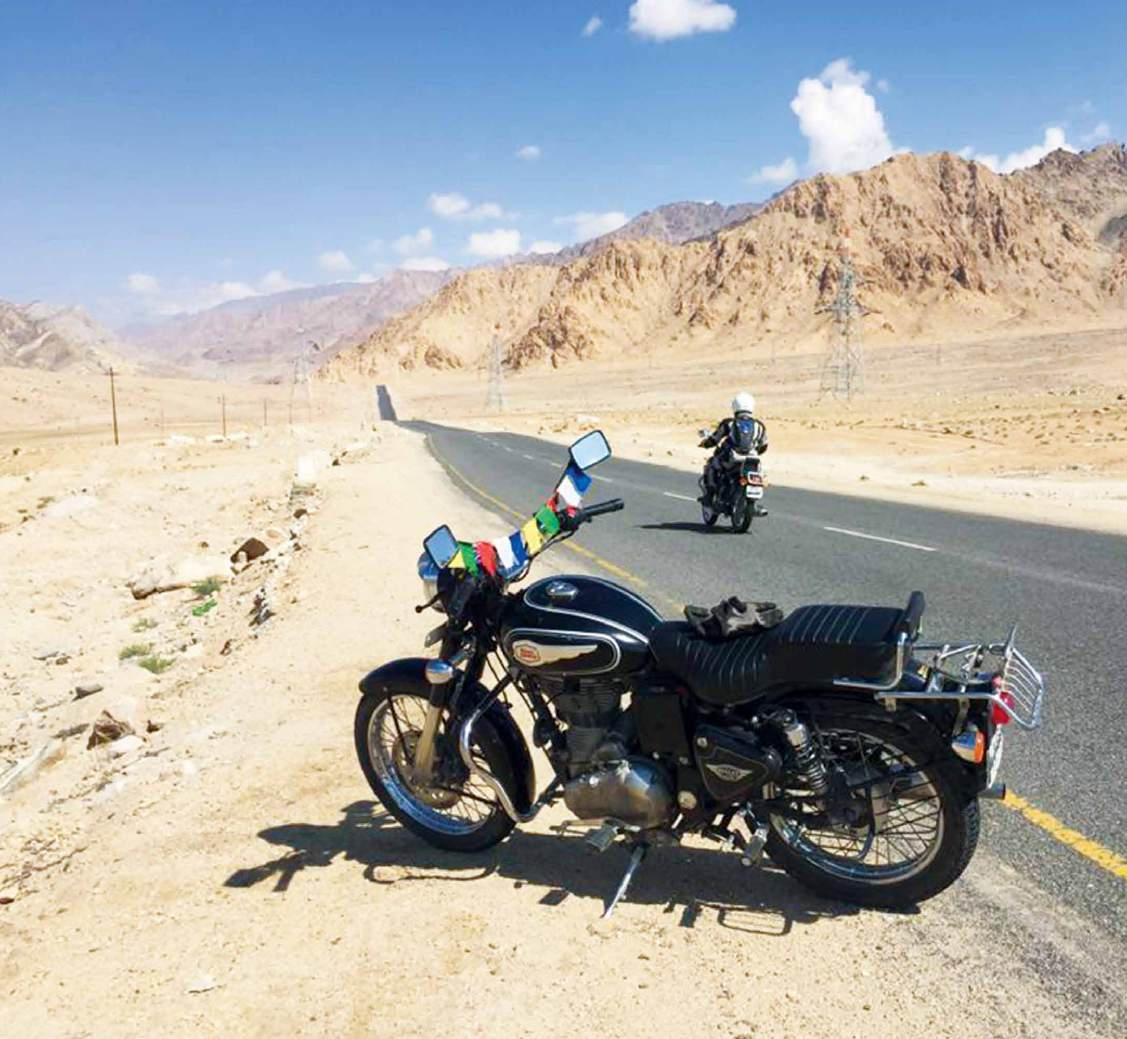
Kashmir has long been a troubled place full of turmoil. Official maps of India and Pakistan overlap and both include all of Kashmir, while on the ground their armies eyeball each other across territory claimed by both. In mid 1999 the situation exploded and 135mm artillery bellowed into lethal action while helicopters provided air support, and into this cauldron of warfare rode the Ferris Wheels Himalayan Heights Motorcycle Safari. Tour leader Mike Ferris had to make some decisions.
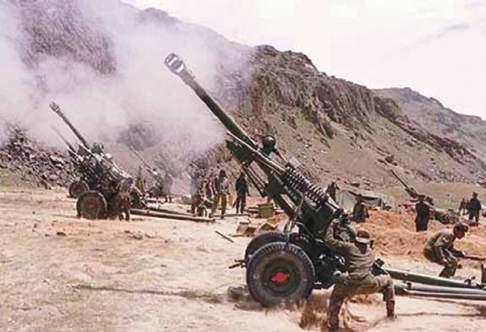
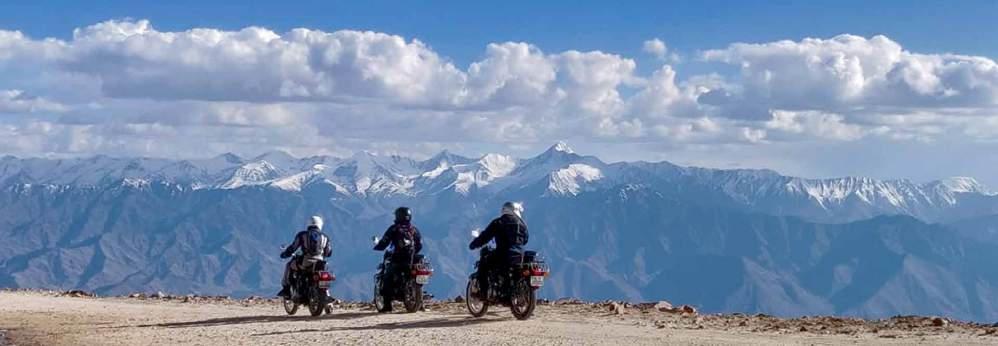
We were aware of the situation of course and had been monitoring proceedings very closely. When we reached the Ladakhi capital of Leh, 200km east of Kargil, we were advised there was ‘an escalated level of activity’ in the region. Common sense seemed to indicate a gracious retreat was in order for our tour, rather than continuing on the intended route through Kargil and into Kashmir. called together the riders for our own little council of war and advised that, in my professional opinion, we should abandon plans for visiting Kashmir. We could use our Plan B and return to Manali via an alternative route, taking in the picturesque lake of Tso-Moriri and some beautiful arid desert scenery across the Moreh plains.
Left: The road was still open to civilian traffic, but the situation could change minute-by-minute.
Below left: Indian gunners were unleashing 135mm artillery shells from their Bofors guns with huge percussion shockwaves felt 30 metres away.
There was an extended moment of silent reflection before one rider summed up what appeared to be the sentiment of the group: “I didn’t come here to see another dumb f*#&ing lake. I came to see Kashmir. Is the road closed, or is it still open?”
I had to concede our advice was that the highway was actually still open despite it being right in the centre of
the excitement. Indeed, it appeared the road was a main target of the Pakistanis, being the primary military supply route to the frontline. We had been informed the road was still open to civilian traffic, but the situation could obviously change minute-by-minute.
The mood of our riders was apparently
Above: Into the abyss.
Below: They wanted to continue with the tour as originally planned, war or no war.
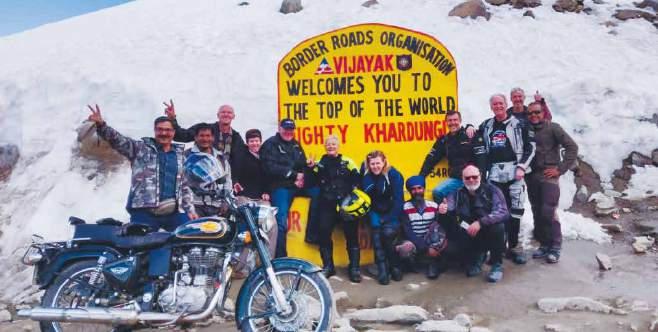
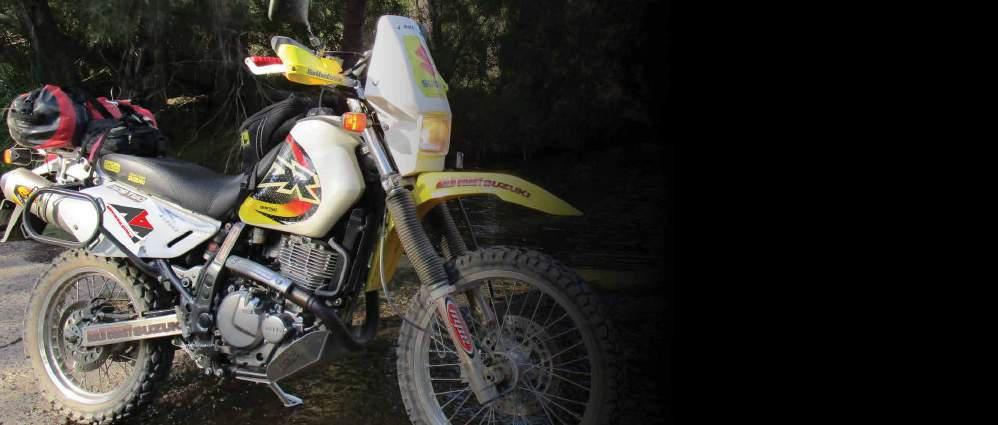
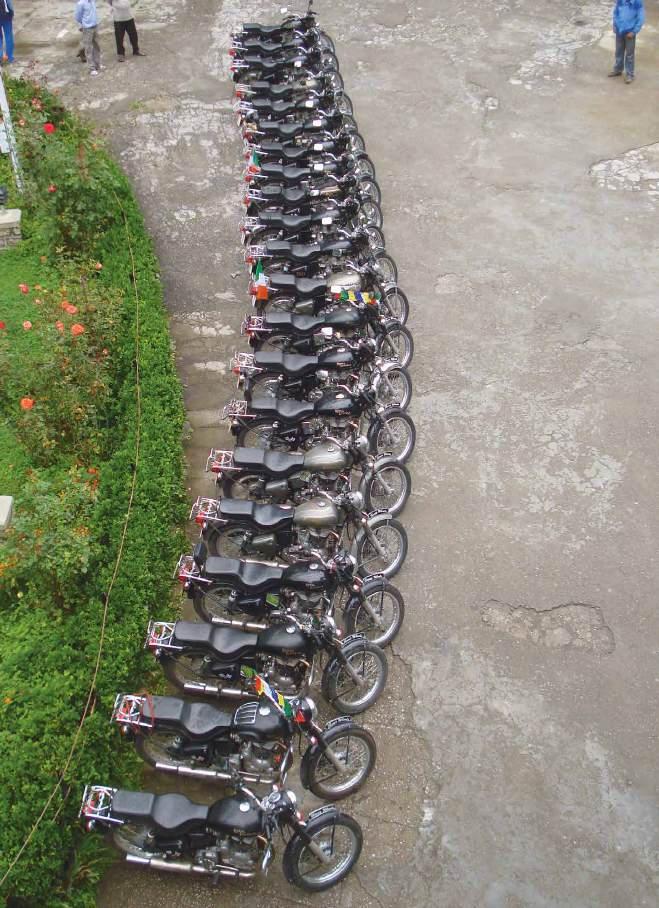
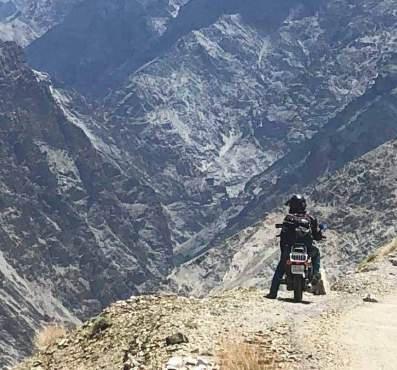
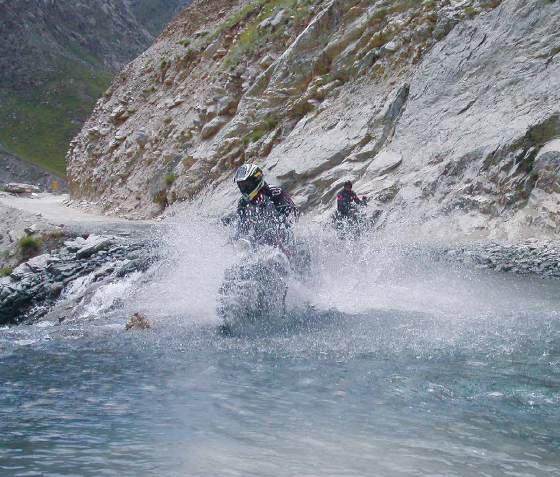
Left: Bullets as far as the eye can see. Below left: Being on the edge isn’t always a bad thing. Right: A definite bucket-lister. Above: The Royal Enfields hack the tough going.
checked our papers, and simply waved us on. We reached the town of Kargil and the military presence was overwhelming, but once again the soldiers at the checkpost gave us only short shrift before waving us straight through. We could hear the unmistakable sounds of heavy-artillery fire from not very far down the road, so I sought clarification from the officer in charge.
“Are you sure the road is safe for us to pass?” I queried.
“Yes,” he replied. “Please go! But it is best that you perhaps travel quite smartly.”
one of bullish adventure and they wanted to continue with the tour as originally planned, war or no war. I’d have risked a mutiny if I’d tried to pull rank and insist on withdrawal, so I chose the only other course of action available. I had them all sign a hastily drawn-up disclaimer promising they wouldn’t sue if they went and got themselves killed, and we proceeded on the original route.
I was secretly certain we wouldn’t get within 100km of the festivities.
There were several military checkposts on the approach to what was being called ‘The Active Zone’. Each one stopped us,
should continue. There was more madness as the bikes were turned around once again, then we literally found ourselves in the thick of it.
Incoming Pakistani shells were landing on our left. Indian gunners were returning fire from our right, unleashing 135mm artillery shells from their Bofors guns with huge percussion shockwaves we could feel 30 metres away. Then they turned and stood gaping, open-jawed, as a colourful group of foreign tourists scrambled through the middle of their war. The surface of the roadway was littered with spent shell casings, still smoking, which made for rather edifying obstacles on a bike. The acrid smell of cordite hung in the air. Soldiers were running every which way and I nearly ran into one. I smiled at the potential irony of an infantryman finally seeing active service, only to be killed by a lunatic tourist on an Enfield.
regained the lead and raced the group through as quickly as I dared. After only perhaps five kilometres we were in the
clear, but I kept going until we made it to the next little town 10km further on.
As we regrouped and caught our breath, we attracted the attention of a TV news crew sent to the region obviously to cover the war. Someone pointed them in my direction and suddenly I had a camera in my face and a pretty young thing with a microphone was asking, in effect, what the hell we were doing there. I managed to regain enough composure to put on a nonchalant voice and reply we’d heard Kashmir was an exciting destination and wanted to see it for ourselves.
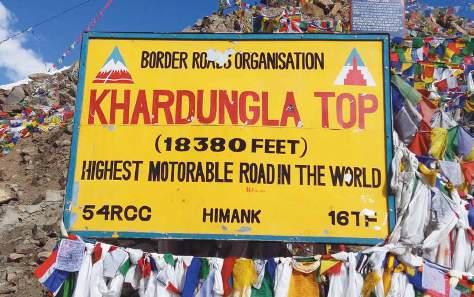
It was too close for comfort. I don’t mind living on the edge occasionally, but clinging by the fingernails is taking things a bit too far.

A few hours later, in the safety of their home in Delhi, my business partner Amar’s family turned on the television just in time to see his Australian tour group make the six o’clock evening news.

Our group needed no further encouragement. By the time I’d put on my helmet and started the Enfield, they were haring off down the road and I found myself tail-end Charlie rather than fearless intrepid leader.
But just two kilometres further on an incoming Pakistani shell exploded into the hillside no more than 200 metres from the road. I saw 15 brake lights illuminate simultaneously and chaos ensued as the guys tried hastily to do U-turns. One fellow stalled his bike and another laid his down gently in the confusion. And then an officer appeared out of nowhere and yelled that we were almost through the danger zone and we

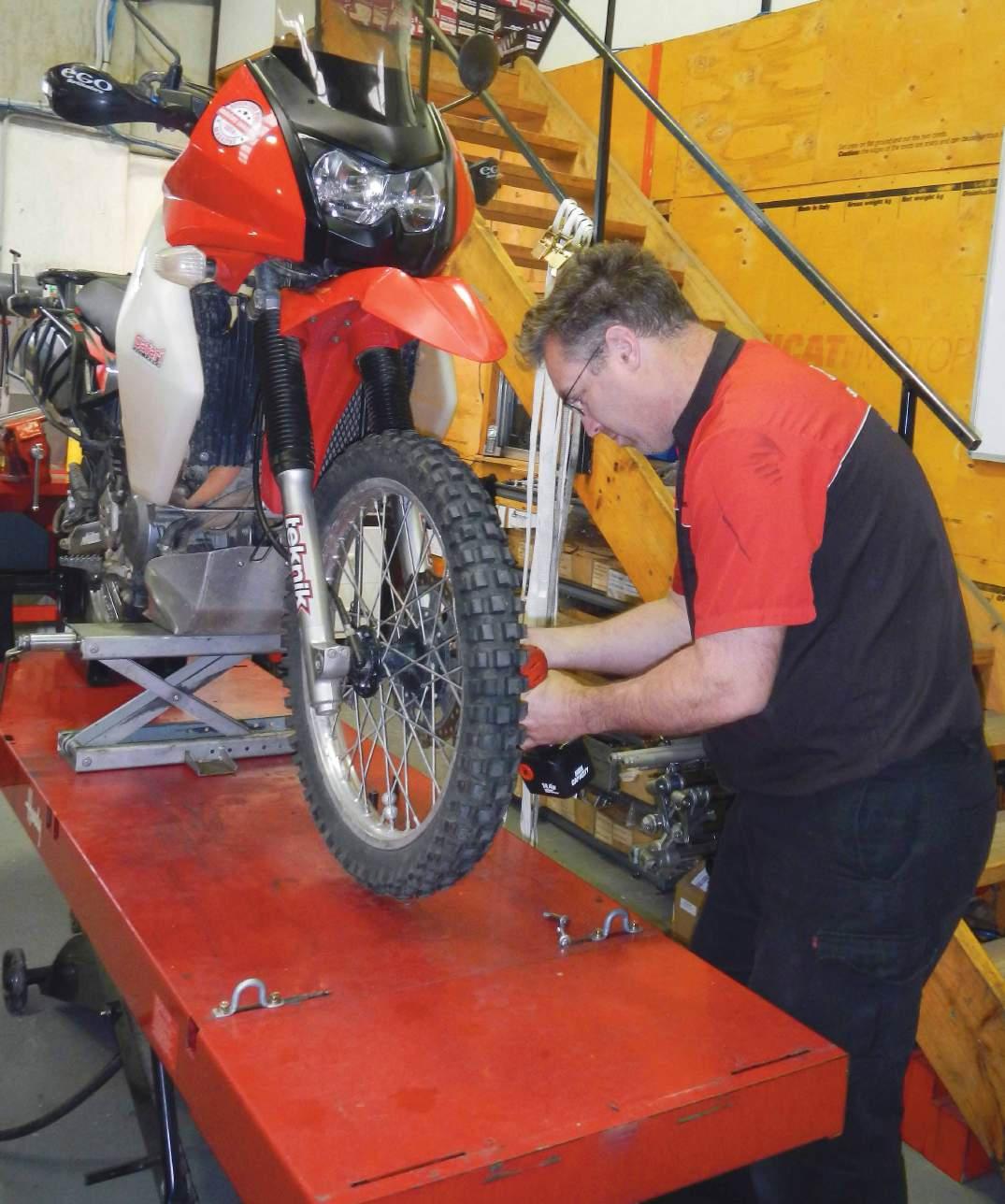
Left: When we took the KLR to Nick Dole he had to use an oxy to get old collars out. That’s very specialised and highly technical work.
Right: Deterioration of the steeringhead bearings can be difficult to spot, and that makes a periodical checking of them even more important.
Below: Here’s one we prepared earlier. The steering-head bearings go on the steering stem, seen here between the fork legs and between the upper and lower triple clamps.
There’s probably no single high-use component on an adventure bike that gets less attention than steering-head bearings. These are the bearings which allow the smooth, free turning of the ’bars/forks/front wheel from lock to lock, and, as the name suggests, they’re
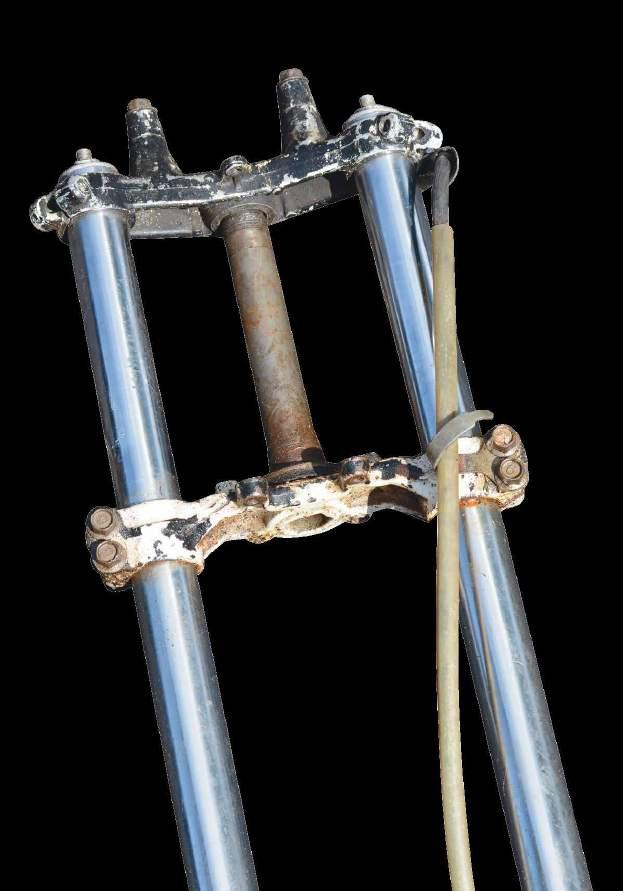
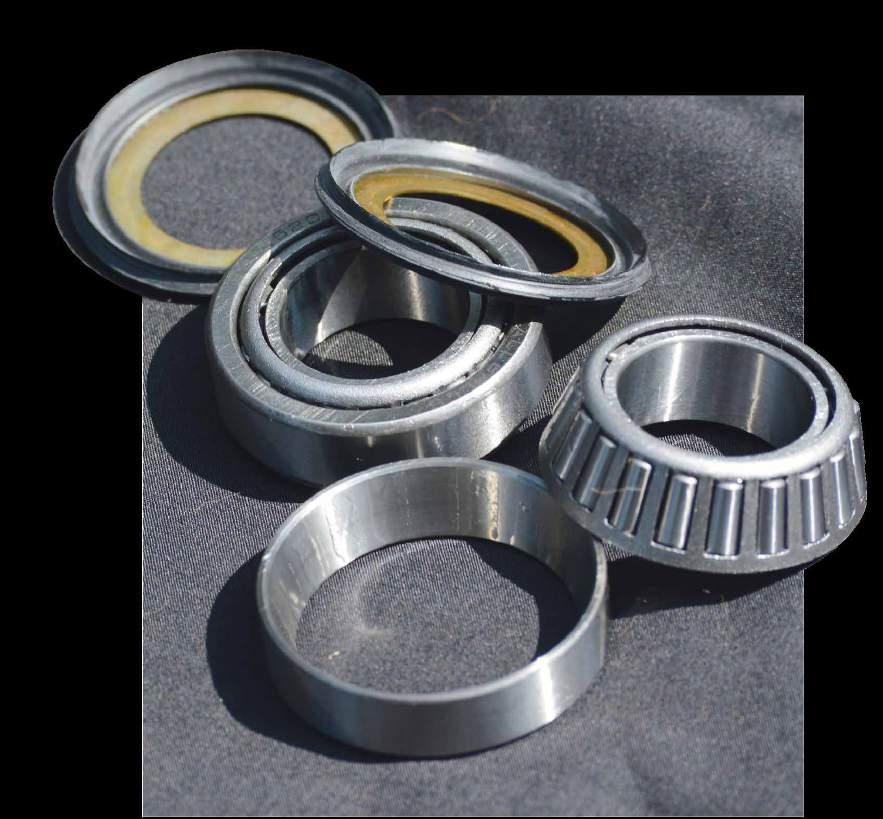
the steering stem connecting the top and bottom triple clamps. The reason the bearings are so often neglected is because they usually deteriorate very gradually, and a rider who’s on the bike day-to-day doesn’t notice.
We’ve never heard of a steering head actually seizing on a bike in regular use, but we’ve ridden a few where the steering-head bearings were in bad shape, and it can be a very unpleasant experience.
The symptoms of excessively worn steering-head bearings are fairly clear to anyone not used to a particular bike.
The most common is a gritty feel when
turning the ’bars. Sometimes it’s a consistent slight resistance at certain points when turning the ’bars from lock to lock. We did ride one bike where everything seemed fine until jumping over erosion mounds, at which time the very audible ‘clunk’ of the steering stem moving around in the flogged-out bearings was a dead give-away. But otherwise the bike seemed to handle okay.
A couple of years ago work’s KLR was doing sterling duty with ad man Mitch. It wasn’t until someone who wasn’t used to the bike rode it and noticed a problem. The steering-head bearings were checked and found to be in an absolutely appalling state.
So the deterioration of the steeringhead bearings can be difficult to spot, and that makes a periodical checking of them even more important.
Obviously having a good mechanic check the state of steering-head bearings
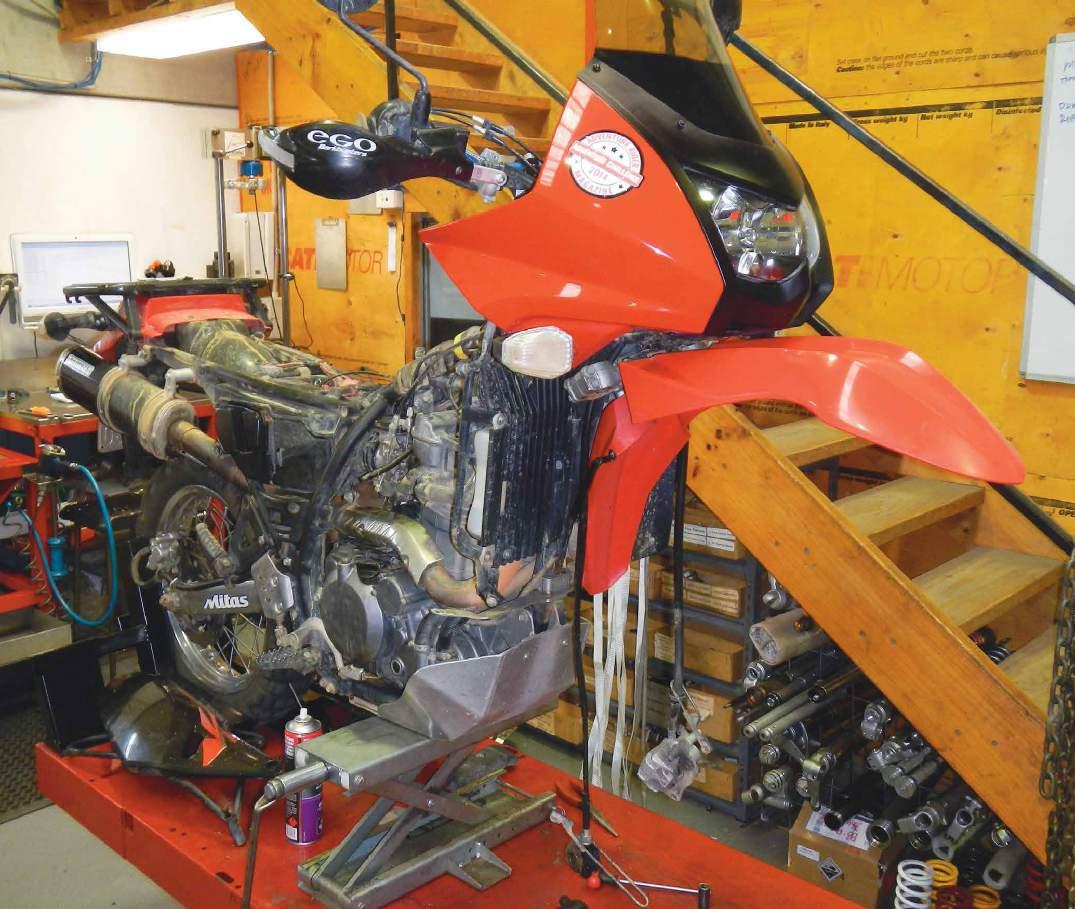
– or any part of the bike – is the best option, but anyone with a centrestand or work stand can get a fair idea of the state of play with a quick and easy test at home.
Put the bike up on a centrestand so the wheels are off the ground and the bike stable. Crouch down in front of the bike, grab a fork tube in each hand and try and move the fork legs back and forth. Not side-to-side. Back and forth.
If there’s any fore-and-aft movement, the steering-head bearings need to be checked by a pro. If there’s clicking or clunking, they need be replaced, the sooner the better.
If the fore-and-aft check is all clear, grab
the ’bars and move them gently from lock to lock. There should be no resistance, gritty feel or clicking noises. Any of those mean the bearings need to be checked.
Don’t jump to conclusions
If you’re all clear with that quick check, chances are those steering-head bearings are at least not in danger of failing in the short term and you’re good to go riding.
But we remember a very prominent tech shaking his head and telling us, “There’s never any need to check. Steering-head bearings always need replacing.” He was talking about bikes more than about two years old, and he was lamenting riders generally ignoring that maintenance.
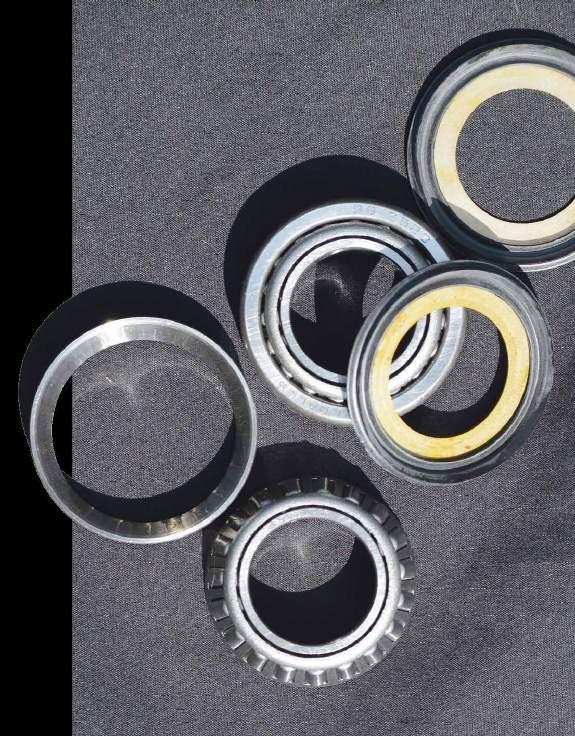
Left: Adventure Rider Magazine strongly recommends the replacement of steering-head bearings is a pro job.
Above: The bearings are so often neglected because they usually deteriorate gradually, and a rider who’s on the bike day-to-day doesn’t notice.
accessible and removing and replacing the steering stem isn’t a job for someone who isn’t confident in what they’re doing.
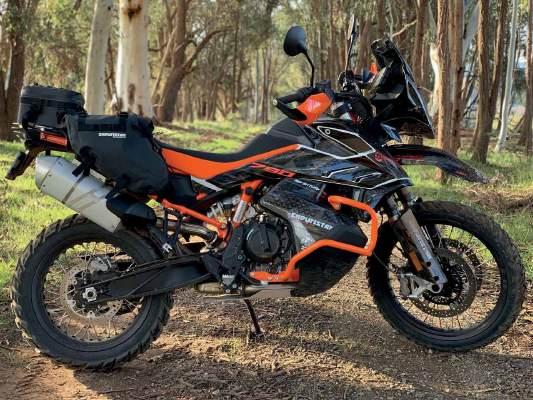
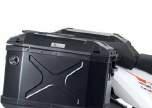


We also remember one of the motocross race-team techs demonstrating that unless the front end would fall untouched from the centre position to full-lock on either side when the bike was on a stand, the steering-head bearings were replaced without hesitation. That won’t work so much on adventure bikes because we often have so much gear bolted to our bars, but it’s interesting to see that’s how a pro race tech assessed the situation.
What can adventure riders do to keep the steering-head bearings in good shape? Not much. The bearings and collars aren’t easily
That said, removing the wheel, fork legs, ’bars, top triple clamp and steering-head nut is straightforward enough for anyone who’s reasonably skilled. That allows removal of the steering stem and bottom triple clamp, and bingo, there are the steering-head bearings, top and bottom.
Where we’ve seen plenty of drama is in removing and replacing the bearings and collars themselves. In theory it’s only a matter of knocking them out and carefully packing and inserting the new ones. In reality we’ve seen really gruesome use of drifts and cold chisels result in serious damage. When we took the KLR to Nick Dole he had to use an oxy to get old collars out.
That’s very specialised and highly technical work.
With the big adventure bikes and the advanced technology in suspension and electronic systems on bikes, Adventure Rider Magazine strongly recommends the replacement of steeringhead bearings is a pro job.


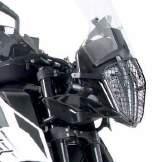


What we’re hoping to do here is get you to check them regularly, and have them replaced at the very earliest signs of wear.
In issue #31 Peter Haydon introduced us to his mates and their annual adventure ride. In 2019 the group hit north-western NSW.
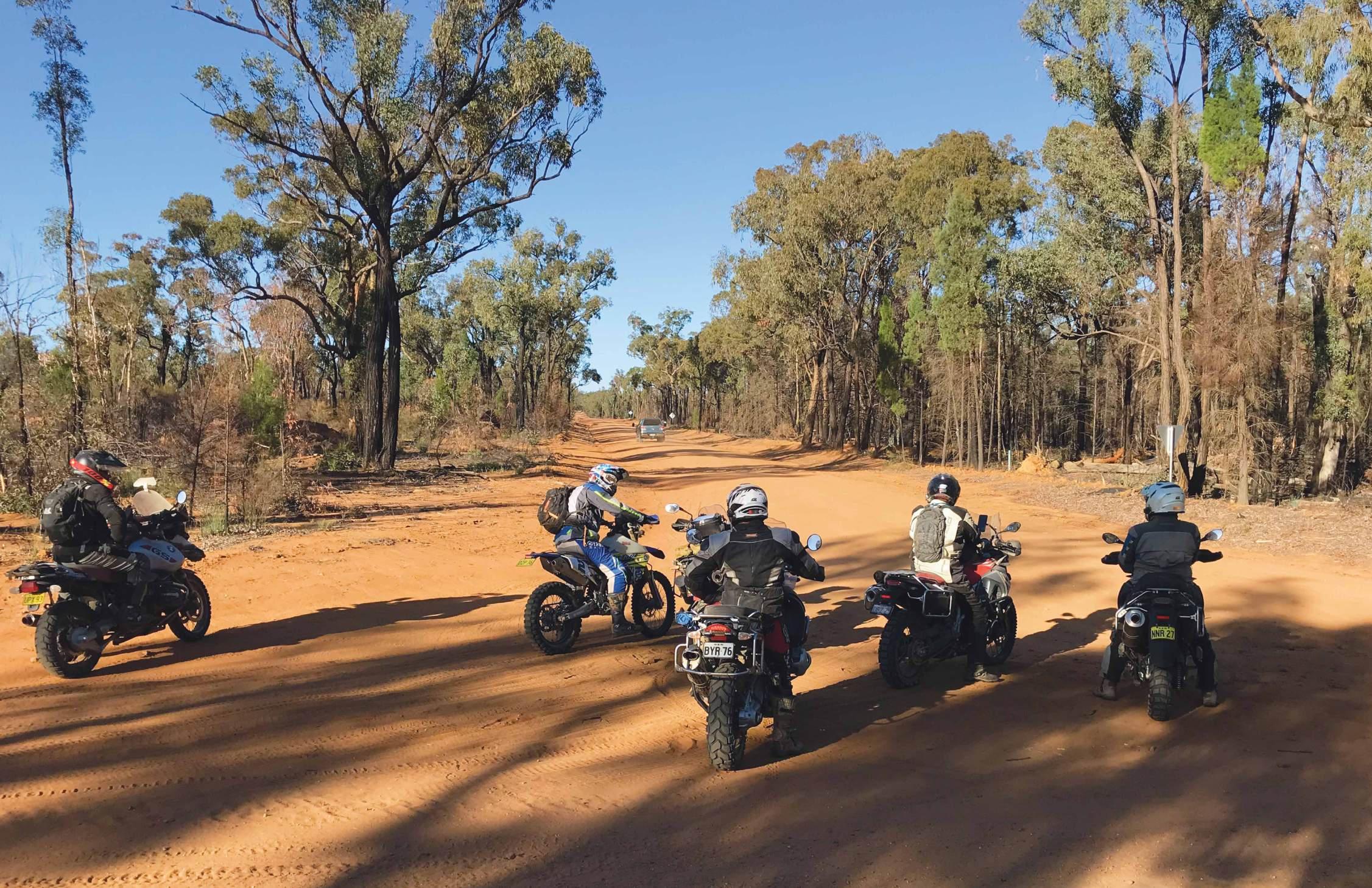
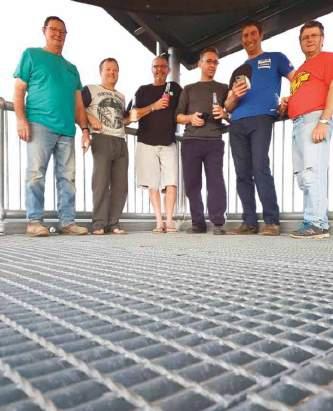
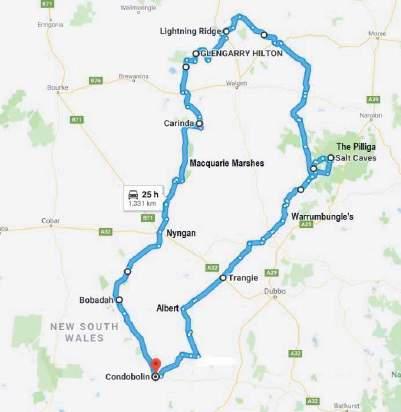
Main: The Pilliga Scrub. Locals say you’d have to be completely crazy to be in there after dark.
Above left: Beers and sunset on the tower at the Pilliga Salt Caves picnic area.
Above right: The plan was to traverse the areas of Lightning Ridge, the Pilliga Forest and the Warrumbungles. u
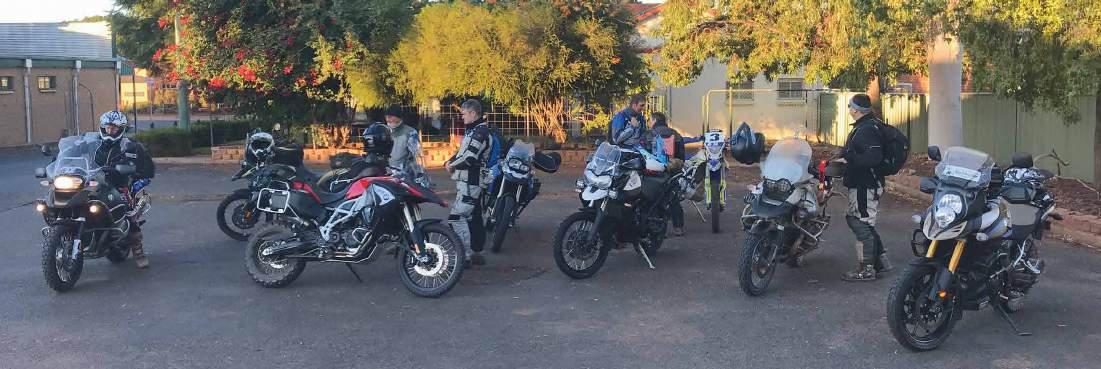
Thud!
The unmistakable sound of metal crash bars hitting the pavement began our first day. Gaz had kicked away the sidestand on his Beemer and it toppled over.
We hoped the incident wouldn’t set the tone for the rest of the ride.
Central-northern NSW was the setting for our seventh annual adventure ride.
The plan was to traverse the areas of Lightning Ridge, the Pilliga Forest and the Warrumbungles. We trailered our bikes in and based ourselves at Condobolin.
The 2019 crew was made up of eight bikes and a support vehicle, with myself on my Tiger 800XC, Timee’s GSA1150, Col’s GS800, Scooter’s GSA1200, Geevsie’s WR450 and Gaz’s GSA800. There were two new riders, Spider on a V-Strom 1000 and John on a GSA800. Lid and Ron again drove the recovery vehicle and kept the esky stocked.
The long-range weather forecast suggested rain for the northern black-soil country and it had us worried. However, the weather gods came to the party and the sun shone on a warm autumn morning
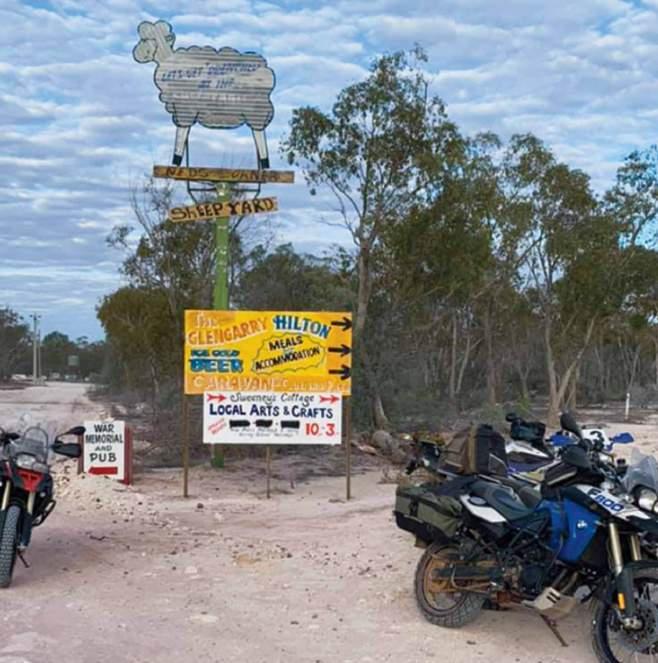
as we eagerly departed for a 200km stint to Nyngan.
After a short blacktop run we were soon on our first dirt section, and at around 100km hit Pangee Road at the remote locality of Bobadah. It was along this road we passed the station ‘The Overflow’, made famous in Banjo Paterson’s poem Clancy Of The Overflow Paterson once worked as a lawyer and was asked to send a letter to a man named Thomas Gerald Clancy care of The Overflow, a sheep station 100km south-west of Nyngan, asking for a payment. A reply came back written with ‘a thumbnail dipped in tar’ that read: ‘Clancy’s gone to Queensland droving, and we don’t know where he are’. It was the inspiration for the poem. With 200km of fast, easy dirt under our wheels we arrived in Nyngan, in the Bogan Shire of NSW, to grab some fuel and take a short break and photo opportunity with the town’s main tourist attraction. The ‘Big Bogan’ is a five-metre tall steel structure portraying a bogan guy standing proud with his mullet, stubbies, singlet and fishing rod. An esky at his thonged feet provides a posing seat for the many passing grey nomads, and of course the odd adventure rider. From there we continued north and hit the Canonbar and Carinda roads before turning off on to Gibson’s Way into the Macquarie Marshes, a system of channels and floodplains at the end of the Macquarie River. A fast, black-soil road led inland to a platform which gave an elevated view of the surrounding
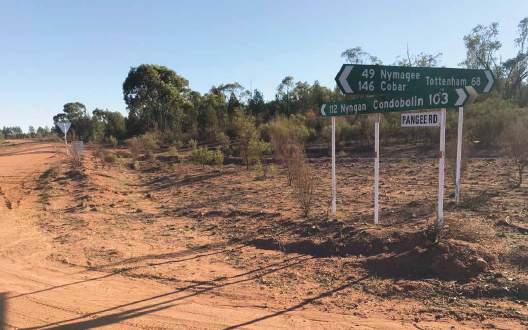
natural wildlife and wetlands.
The temperature had steadily climbed so we’d stopped to regroup in the shade and take in the countryside when a call came in from Spider on the V-Strom. He was having starter problems back at the turnoff where he was doing cornerman duties. The recovery vehicle was organised to deal with that issue and we set off north on Sandy Camp Road to the little town of Carinda for fuel and lunch.
Shall we dance?
Carinda was where we’d planned to meet another rider, Steve from Brisbane, on his Africa Twin. I’d met Steve through his ‘Big Bike Adventures’ Youtube channel. He’d put out a call for some local knowledge while travelling through Condobolin and I’d given him what I thought was some great advice…but let’s just say sometimes local advice doesn’t always turn out the best advice.
But that’s another story.
Carinda is probably best-known as the location of David Bowie’s music video Let’s Dance. Bowie visited and filmed his iconic music clip way back in 1983. The pub was the main setting for the vid and still provides good meals, a cold beer and of course a chance to take in the David Bowie memorabilia. As we mounted our bikes a guy with an uncanny likeness to the man himself appeared out of the blue. Well, so I thought.
Maybe I’d just been staring at Bowie’s picture too long back in the bar.
Fuel was available across the road and the servo opens weekdays from 6.00am to 6.00pm (cash-only when we were there).
It’s no Hilton
From Carinda we again headed north, crossing the Kamilaroi Highway to tackle Narran Lake Road to the Grawin opal fields.
The early parts were predominantly fast, black-soil road and it was evident from the wheel ruts it’d seen a bit of rain in previous weeks. Thankfully it was dry for us, although Narren Lake Road had the most varying surface of the day. It offered everything from sand and rocks to loose gravel, and as we hit the turn to the opal fields off Kurrajong Road the landscape turned lunar white as the overspill of years of underground opal mining lined the roadways and scrub.
The Grawin opal fields are about 70km west of Lightning Ridge and could be best described as a shanty town with tin shacks and white overburden mine piles scattered over a
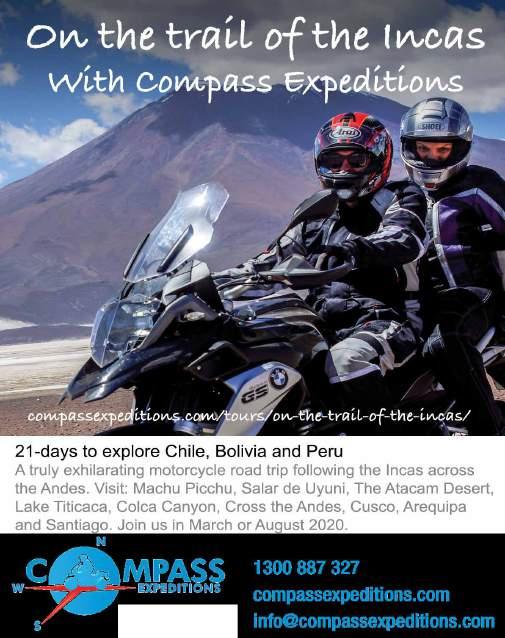
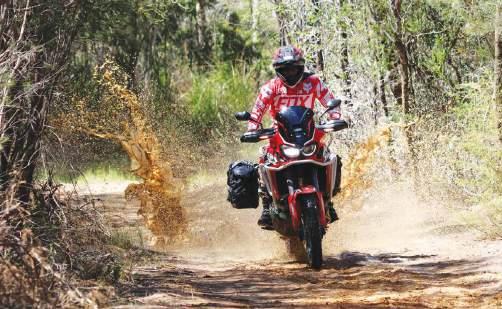
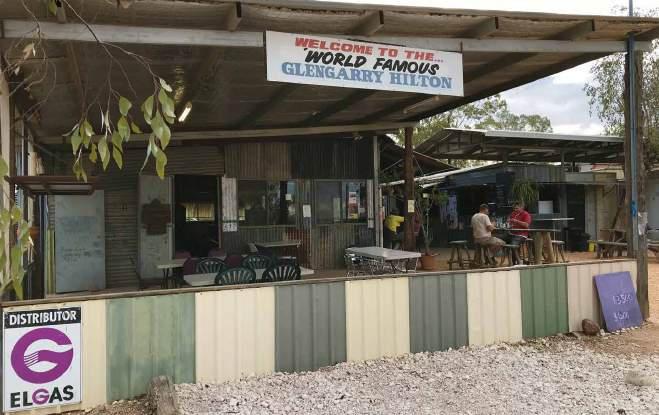
large area. Hidden within the piles are well-signposted pubs, the first being the Sheep Yard Inn, then The Grawin ‘Club In The Scrub’ and the famous Glengarry Hilton, and it was there we camped for our first night after a 500km day. Accommodation options were shared dongas, a couple of double rooms or free camping. We opted for the latter and asked the barmaid where we could set up. “Just over there near those piles of dirt,” she said. “But don’t go anywhere past them cause you might fall in a hole.”
Geevsie and I turned to each other with raised eyebrows.
After a few cold ones the crew scattered in and around the dirt piles and bushes, clearing away rocks and pebbles. The search for a hot shower had us wooing the old local ladies as we stood in the bar in our undies, towels over shoulders. The procedure was to grab a bucket of hot water – purchased from the bar for $4.00 –proceed to the tin shower stall, fill the overhead canvas shower bag, top it up with another bucket of cold water, twist the shower head and, hey presto!
A hot shower.
It was a primitive way to wash off the
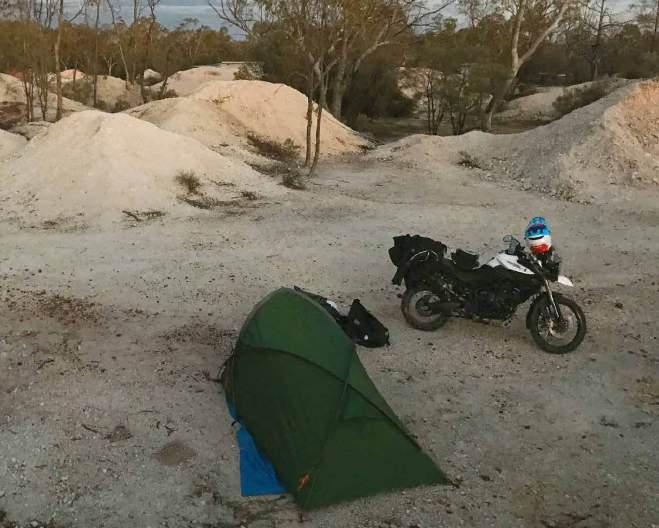
day’s dust, but a unique and welcome experience all the same. The pub itself was basically two sheds linked by a common roof. One side held a bar and the other a great indoor area with pool table, TV, jukebox, ATM and seating area with an onsite ‘food truck’. The crew enjoyed a good hot meal, a few cold ales, some raffles and a poker draw, then slowly succumbed to tiredness, retiring to camp among the opal mines. Not so for the locals. Thursday night turned out to be the town’s party night. The jukebox thumped out across the opal fields into the wee hours of the morning.
Everyone rose early to catch the trip’s first outback sunrise, followed by a camp brekky. That had everyone ready for a 350km day.
After a short ride-through tour of Grawin we no other option but to blacktop it into Cumborah and Lightning Ridge for fuel, coffee and a visit to a couple of local attractions. We also used the time to look at Spider’s continual starter problems on the V-Strom. Col and Geevsie were all over it like bull ants on meat and before long they had a crude but effective bush fix to keep it going for the rest of the trip. Allowing ourselves around two hours, we visited the Chambers Of The Black Hand, an underground mine that’s got be seen to be believed.
Through a small tin shelter a long, steep staircase descends 12 metres underground to arrive at the reception and opal-shop area where a guide gives a quick rundown of the mine and its history. From there you’re on your own through the many tunnels, marvelling at the 800 or more hand-carved sculptures. You name it, it’s been carved into the walls and tunnels down there, and all done by one man with a butter knife and a fork.
Before leaving town, I took the group to a special art gallery. There were a few raised eyebrows and looks of irreverence as we parked outside, but once inside the group’s preconceived ideas of having to
Top: The famous Glengarry Hilton, camp for the first night after a 500km day.
Left: The landscape turned lunar white as the overspill of years of underground opal mining lined the roadways and scrub.
Right: The 2019 crew was made up of eight bikes and a support vehicle.
tilt the head to one side and study squiggly lines and splatters of paint soon subsided. Instead the admiration was clear as they marvelled at the unique art style of John Murray, a very talented outback artist who paints the most amazing photorealistic landscapes and humorous wildlife characters.
Local colour
We set off from Lightning Ridge for the Pilliga Forest just before lunch, covering 85km of fast, open dirt to Collarenabri for fuel and lunch from the local cafe. From there we wove our way through the expanse of wheat fields on the Marlbone and Bugilbone Roads to eventually emerge at Pilliga. As we stopped on the edge of town to regroup a friendly, tattooed, long-mullet, gap-toothed bloke on a DRZ pulled up for a chat. “Howz it garn?” he grinned.
It was at this point we knew we were in Pilliga country.
See it all
There’s no fuel at Pilliga itself, but it does have a pub, a café and the hot-bore baths camp area.
We headed deep into the Pilliga forest. Over 200mm of recent rain in the region made for interesting riding through rutted, narrow, tree-lined laneways and dry, built-up, sandy creek crossings before emerging at the Pilliga Salt Caves picnic area. An information board at Pilliga had suggested camping wasn’t available, but an opened gate beside the picnic area had a sign saying ‘Camping Area’, so we promptly set up.
Roughly in the centre of the Pilliga Scrub, the salt caves were once 30 metres deep. Local women collected the salt which hung in columns like stalactites from the roof to cure their meat. The caves are an important Aboriginal site and an excellent example of shelters used by the traditional Gamilaroi people.
As the day came to an end we quickly set up camp and then, with beers in hand, made our way up the fire tower on top of the caves to take in the vast, 360-degree views of the Pilliga Scrub and marvel at a beautiful setting sun. It made a perfect backdrop while Skyping our families back home.
The Pilliga Scrub is a massive expanse of thick bushland in the central upper half of NSW and covers an area about 80km x 120km. Much has been lost in there never to be found
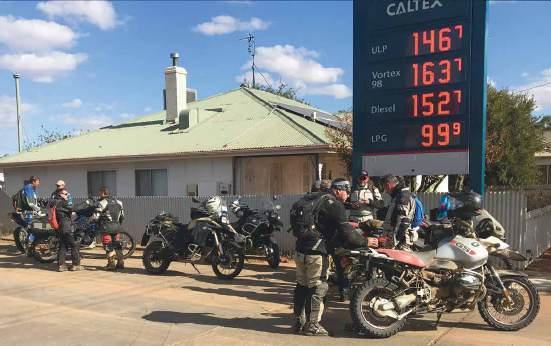
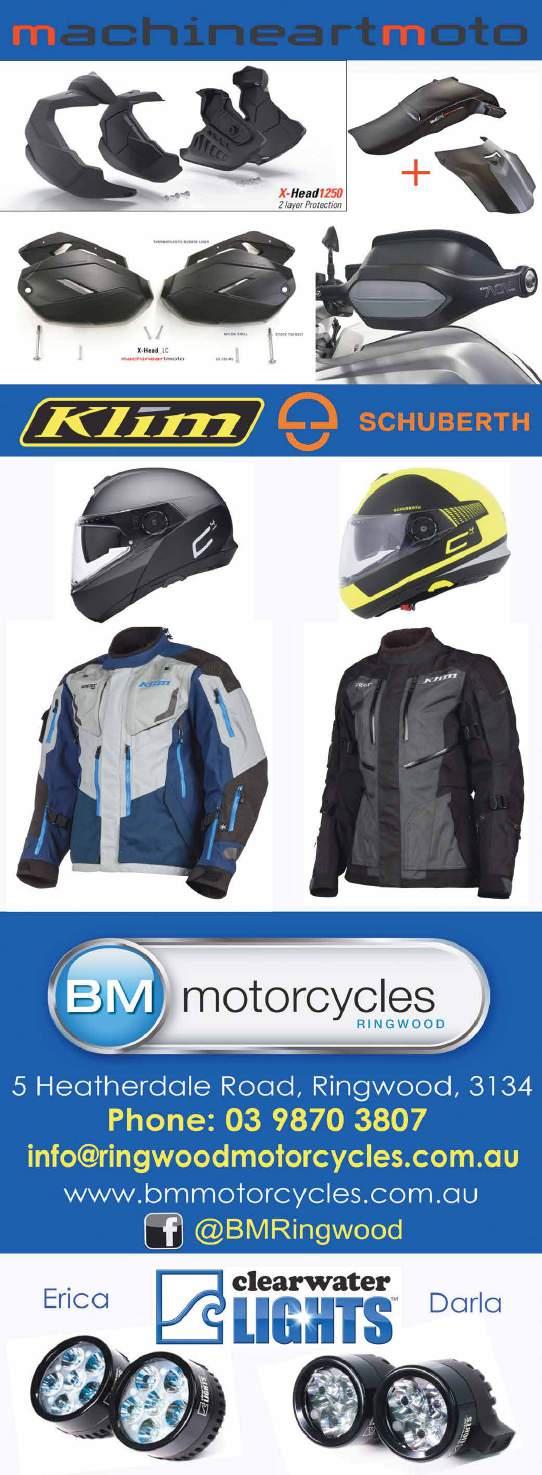
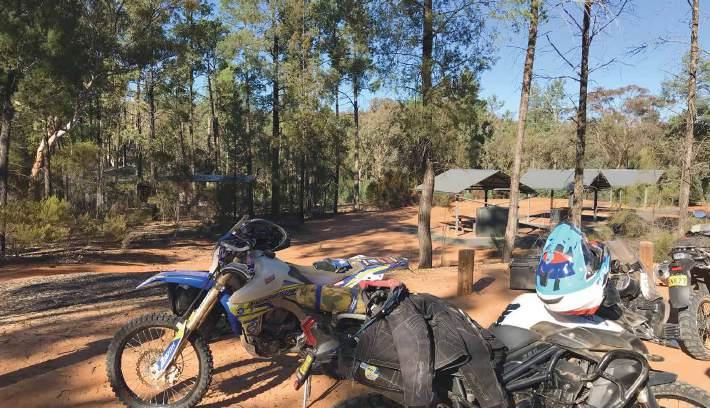
again, from sheep and cattle to people and vehicles. Locals say you’d have to be completely crazy to be in there after dark. There are also legendary tales of the infamous Pilliga Yowie and The Pilliga Princess, a grey-haired, crazy, bag-lady who once lived in the scrub. She was often seen with an old, battered shopping trolley loaded with her belongings along the road. Truckers would see her at night walking in complete darkness so they dubbed her ‘The Pilliga Princess’. One night in 1993 The Pilliga Princess was hit by a truck and killed, and ever since other drivers swear they’ve seen her walking her trolley at night, just as she had done for years before her death.
As a full moon rose we’d settled around a campfire for umpteen beers, port and steaks, when out of the scrub a small, furry, moonlit figure emerged ever so quietly creeping up on us. Our hearts stopped. Could it be the Pilliga Yowie? Nah. It was just a hungry fox looking for a quick meal opportunity, the cheeky little bugger. We at least knew it wasn’t the ghost of The Pilliga Princess because, hey, there’s no way she could push that loaded shopping trolley across the
sand that far to reach us, right?
Unperturbed, the fox stayed in the shadows all night and could be heard sniffing about the tents.
We quickly emerged from our tents on the morning of the third day and beelined it back up the fire tower in the dark to witness a stunning Pilliga sunrise.
After another cooked brekky and campsite clean-up we set off through the lower part of the Pilliga Scrub before entering the Dandry Gorge and ‘The Sculptures In The Scrub’.
A two-hour walking loop gives a bird’seye view of the stunning gorge and then every so often a sculpture. Each sculpture is the result of an artist collaborating with local Aboriginal elders on a piece that tells a story of local Aboriginal history and culture.
Time was short, so a few of us made a quick trek up the gorge to the first sculpture and grabbed a photo, agreeing it would be a great place to bring the family.
There’s a camping area with barbeque shelters and toilets beside the car park.
Left: Dandry Gorge has a camping area with barbeque shelters and toilets beside the car park.
Below: Carinda is probably best-known as the location of a David Bowie music video.
Right: The base of the Warrumbungles offered some stunning scenery and fast trails meandering through surrounding farmlands.
Far right: Umpteen beers, port and steaks around the campfire.
We took the remaining 30km of dirt out of the Pilliga to Baradine for fuel and coffee before heading to the Warrumbungles, the home of the Siding Springs Observatory. You can’t really admire the grandeur of a mountain range if you’re on top of it, so we rode around the base of the Warrumbungles and were treated to some stunning scenery and great photo opportunities, and with some fast trails meandering through the surrounding farmlands. We took in more views of the majestic mountains in the distance before emerging on to the Oxley Highway for a quick run into the Collie pub for lunch. This fantastic roadside pub is a welcome sight in the middle of nowhere and provides great meals and cabin accommodation.
Surprisingly there weren’t any real dirt options we could take to our last night’s stop, so we had to blacktop it into Albert. However, as we approached the outskirts of Trangie, Gaz took us on a surprise off-road detour along a powerline track that had us tearing up the scrub endurostyle on the big girls, swooping under and around trees, power poles and tree stumps before popping back out and into Trangie for fuel.
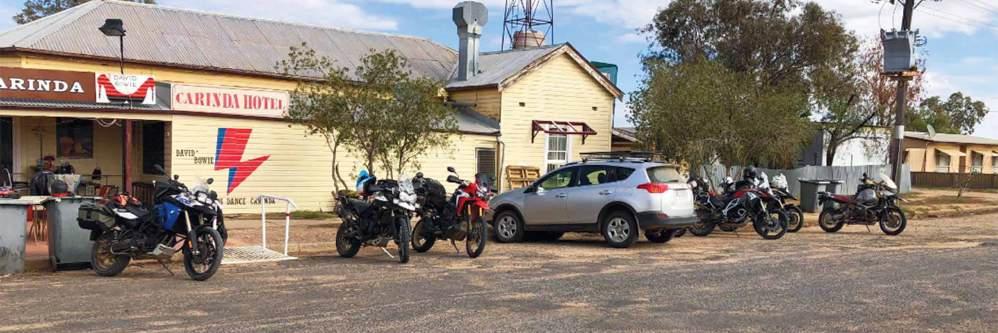
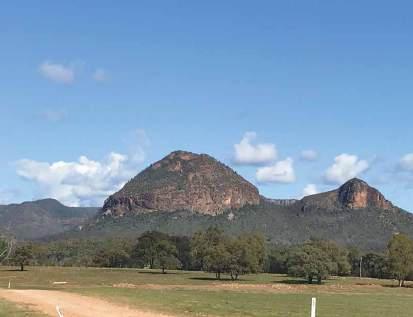
Nearing day’s end we rolled into the little town of Albert located near Tottenham in central NSW and called stumps at the iconic Rabbit Trap Hotel. It features a 9.5-metre-long rabbit trap on the roof and had the options of free camping with a hot shower or a clean ensuite cabin room for $60. After three days of off-road riding the choice to take a comfy bed for our last night wasn’t a hard one. A superb meal of crispy pork belly with sweet soy glaze and a few ales again had us winding down, and after
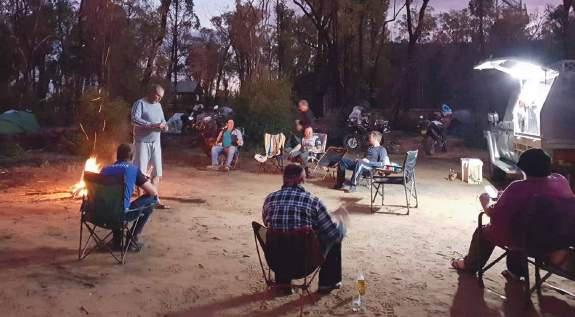
three days of early starts and long days and we were soon reverberating the throats in our snug little cabins.
If anyone was thinking of doing a similar trip to ours and was short on time, this place would be a great trailer-in/ trailer-out base camp to start and finish with plenty of space to park vehicles. Fuel is available 24 hours next door via a card-swipe machine.
The final day was a short, 120km dirt
an unusual art display of 20 old Aussie utes designed by various artists.
As we assembled for the final time at the local bakery for pies and coffee we reflected on another incredible and safe 1300km journey.
Ride meeting adjourned, rescheduled for May 2020.

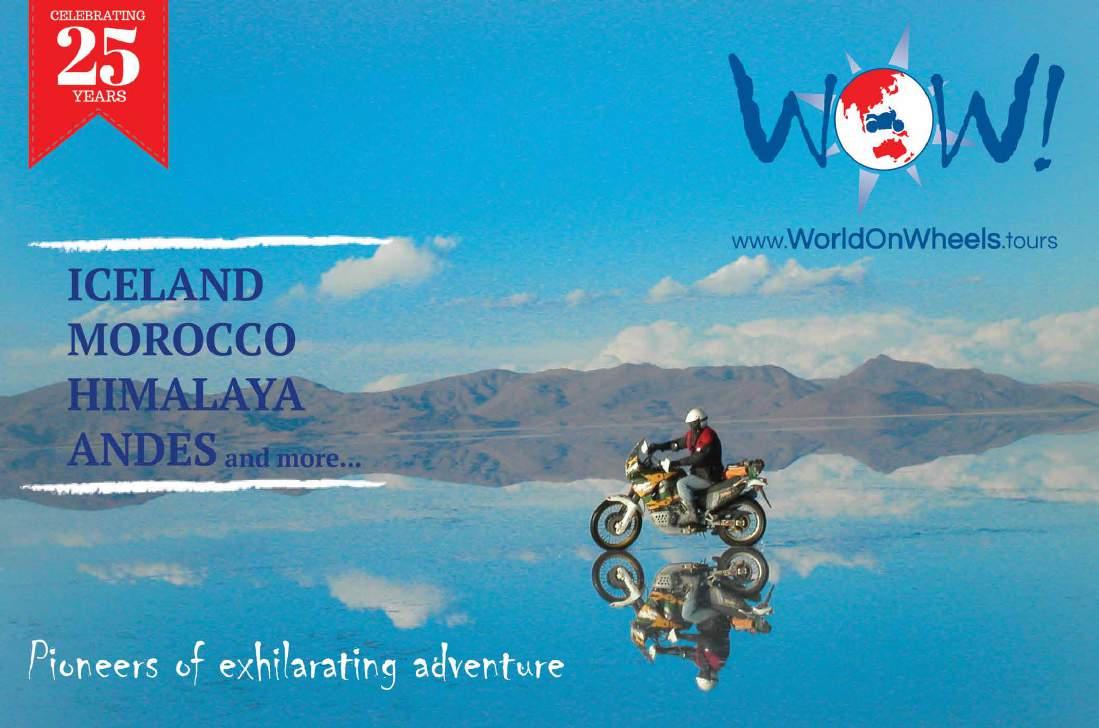



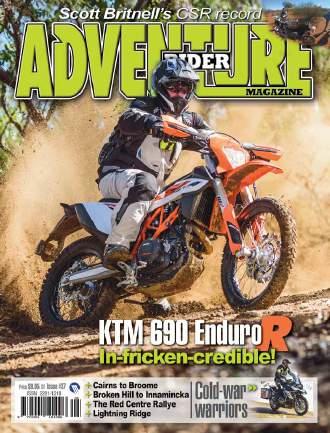





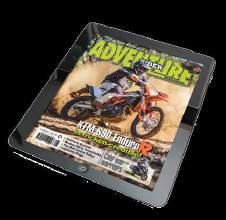
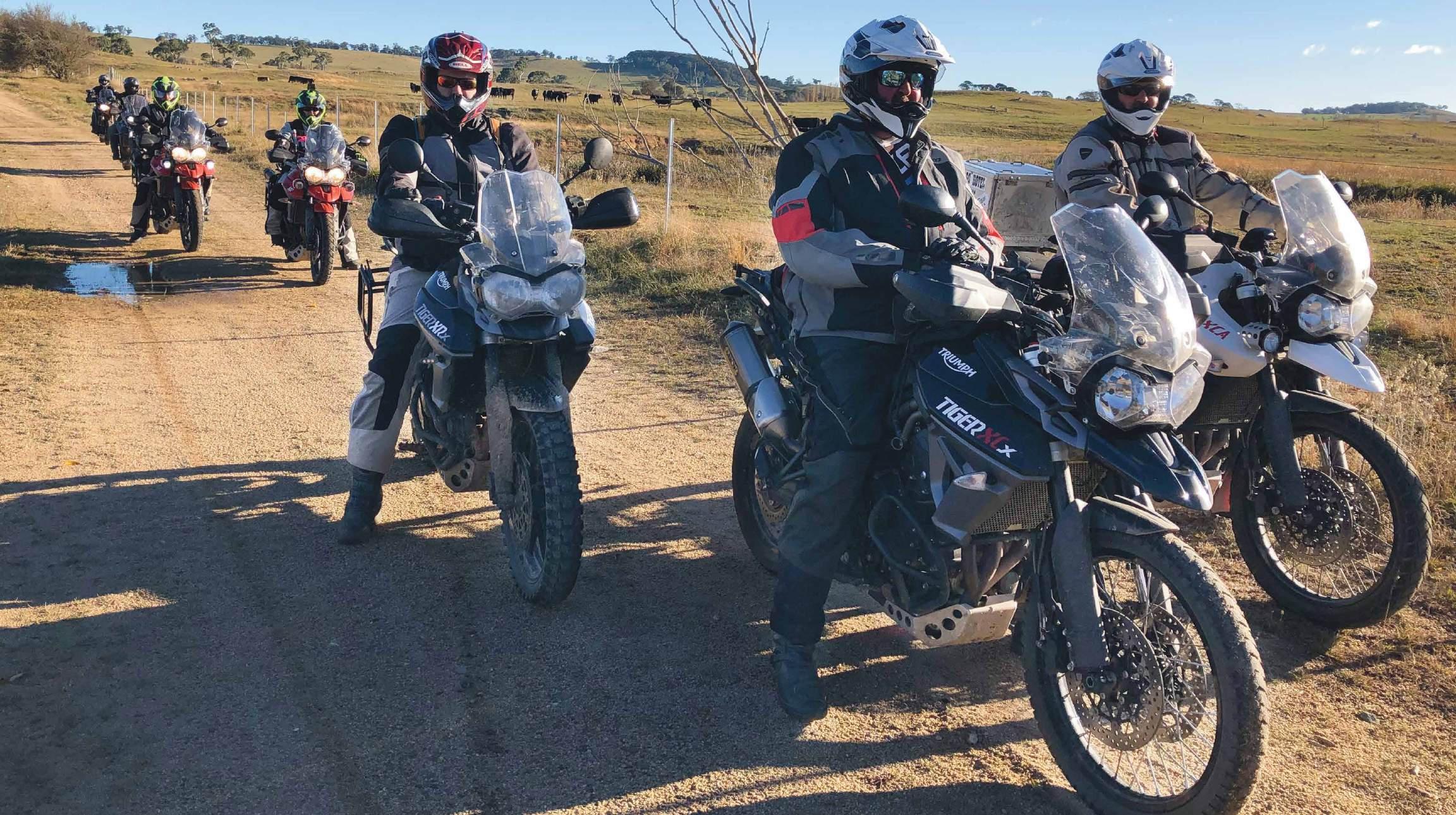
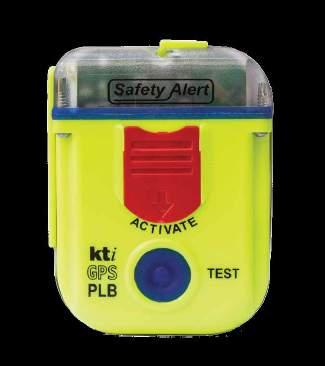
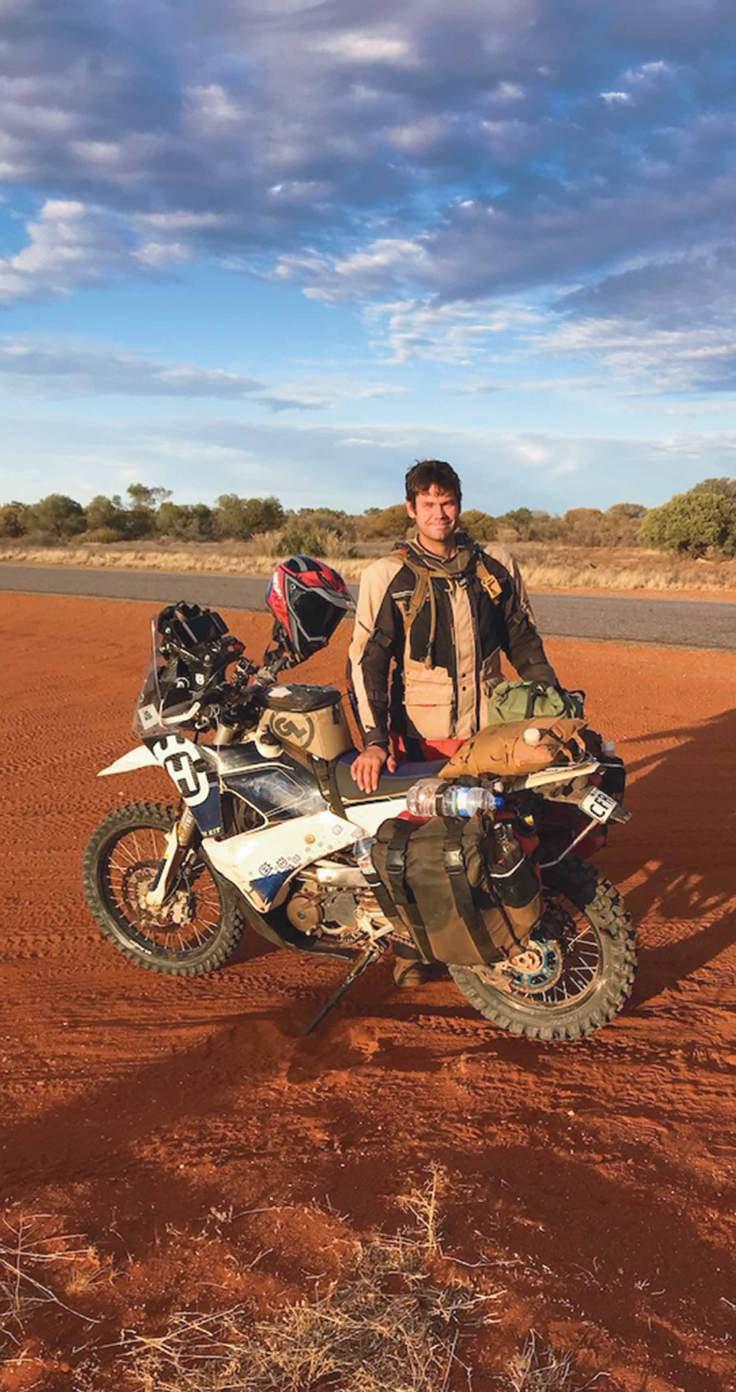
Brain Dick found himself in trouble on a ride in WA. His PLB was instrumental in his rescue. Here’s Brian’s letter thanking the supplier for replacing his PLB after the incident…
I was travelling around Australia and had already covered 9000km, passing the Gulf of Carpenteria through the Gibb River Road, and was Day 1 into a westerly point –easterly point crossing of Australia, from Steep Point to Cape Byron. Approximately 43km down The Butchers Track, the start being 27km south of the Overlander Roadhouse on the North Western Coastal Highway, I came to strife at approximately 100kph and landed very heavily. Upon coming to rest the bike was stuck on my leg and I was in immense pain. At that point I knew I needed professional help and I was not going to make it out on my own.
I crawled around to initiate the tracker on the bike and then activated my PLB and the SOS function on the Spot Tracker at around 8.30am. The PLB was affixed to my hydration-pack shoulder strap. I was easily able to remove it and place it in an area clear to the sky.
Through coincidence I had caught up with my mother in Carnarvon and had said goodbye at the turn off to The Butchers Track. She received a call from AMSA (Australian Maritime Safety Authority – Ed) informing me there had been an activation by me and they were responding. She turned around and sought help from the Billabong Roadhouse, who provided help in the way of an employee and the RFDS first-aid kit. She was first on site approximately 45 minutes later.
Flipper, a Billabong Roadhouse Employee, and my mother initially assessed the situation, moved the leaking bike away from me and decided to support and wait for assistance. Approximately one hour to one-hour-and-15 minutes later the SAR Challenger from Perth, dispatched from the JRCC (Joint Rescue Co-ordination Centre – Ed) in Canberra overflew and identified my location. The Challenger remained on station for a number of hours providing vital coordination to police, RFDS and next-of-kin.
Police arrived with a St Johns Ambulance volunteer from Shark Bay (Karen) approximately two hours after activation. It would be another two hours until the ambulance arrived. Karen provided immediate first aid in such a caring and professional manner, she calmed my mother and did her absolute best to ensure I was comfortable and the handover was as smooth as possible. Upon arrival of the ambulance I was loaded and the journey to the Overlander Roadhouse for transfer to RFDS commenced.
A further 4WD ambulance and paramedic arrived along the route, providing extra assistance to me on the approximately 70km journey. An RFDS PC12 aircraft arrived at 3.00pm, fiveand-a-half hours after activation, and I was transported to Royal Perth Hospital and due to RFDS diversions arrived at approximately 7.00pm after road transfer from Jandacott to Royal Perth Hospital, 10.5 hours later.
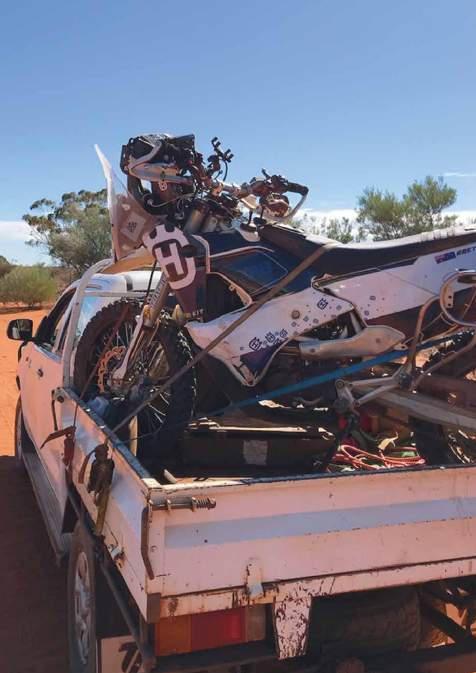
To put it into context, I had two means of viable communication. The PLB and the tracker. My phone, destroyed yet still operable, could not make a call as there was no service at that area.
JRCC in Canberra immediately activated the following:
3 Called me and left a message they would act on both activations
3 Called my primary NOK a number of times before moving to my mother who answered
3 They then called Denham Police and St Johns who responded to the best of
a plb is on its way to brian
KTI, Australia’s leading producer of quality PLBs, is offering a PLB to riders who share their rescue stories with Adventure Rider Magazine’s readers. In an emergency situation where minutes count, a PLB can mean the difference between timely help and something much worse, and KTI wants to see
had to wait four hours for the only passing vehicle to pass that day. As described by Harold, it would have been the only vehicle that day and potentially the week. I would have been alone waiting for SAR activation from concerned family and friends. was prepared with plenty of food and water, but I could not move as have fractured four vertebrae in my back, dislocated my shoulder and broken ribs, a testimony to the protective gear I wear. With these injuries, not life-threatening, my time spent laying in the sun and potentially my overall survival would have then been down to luck, a concerned family and a very wide search as my day’s plan that I had passed on was around 900km.
The PLB was instrumental in my recovery to Perth and an absolute life saver.
I would like to thank
3 Flipper, and the manager of the Overlander Roadhouse
3 Karen and the police (Duncan and another officer)
their abilities bringing a sat phone, first aid and three ambulances
3 They tasked Harold and Win Crawford of Nerren Nerren Station (the closest inhabitants) who arrived one hour before the police and were amazing, offering to transport and secure my motorbike
3 Dispatched a Challenger SAR aircraft which arrived and loitered on station providing UHF relaying and coordination to RFDS, police and ambulance.
Without a means of emergency communication or support, I would have
Adventure Rider Magazine’s readers properly equipped.
Do you have a good rescue story?
If so, send it to tom@maynemedia.com.au
KTi is so keen to see riders carrying emergency beacons they’re giving to give a free PLB to authors of rescue
3 Harold and Win Crawford from Nerren Nerren Station
3 Shark Bay (Denham) police and the volunteer St Johns Ambulance crews
3 JRCC
3 My mother.
Without these people I do not know what would have happened Again, thank you for offering to replace the PLB free of charge. I do not intend on quitting motorcycling, travelling and living my life without fear of the unknown. Regards, Brian Dick

stories we publish. It doesn’t have to be a story using a PLB, but preferably it should have usable pics. If you’ve been in trouble once, you should know how important a PLB can be. Share your story and make sure you’re prepared if it ever happens again.

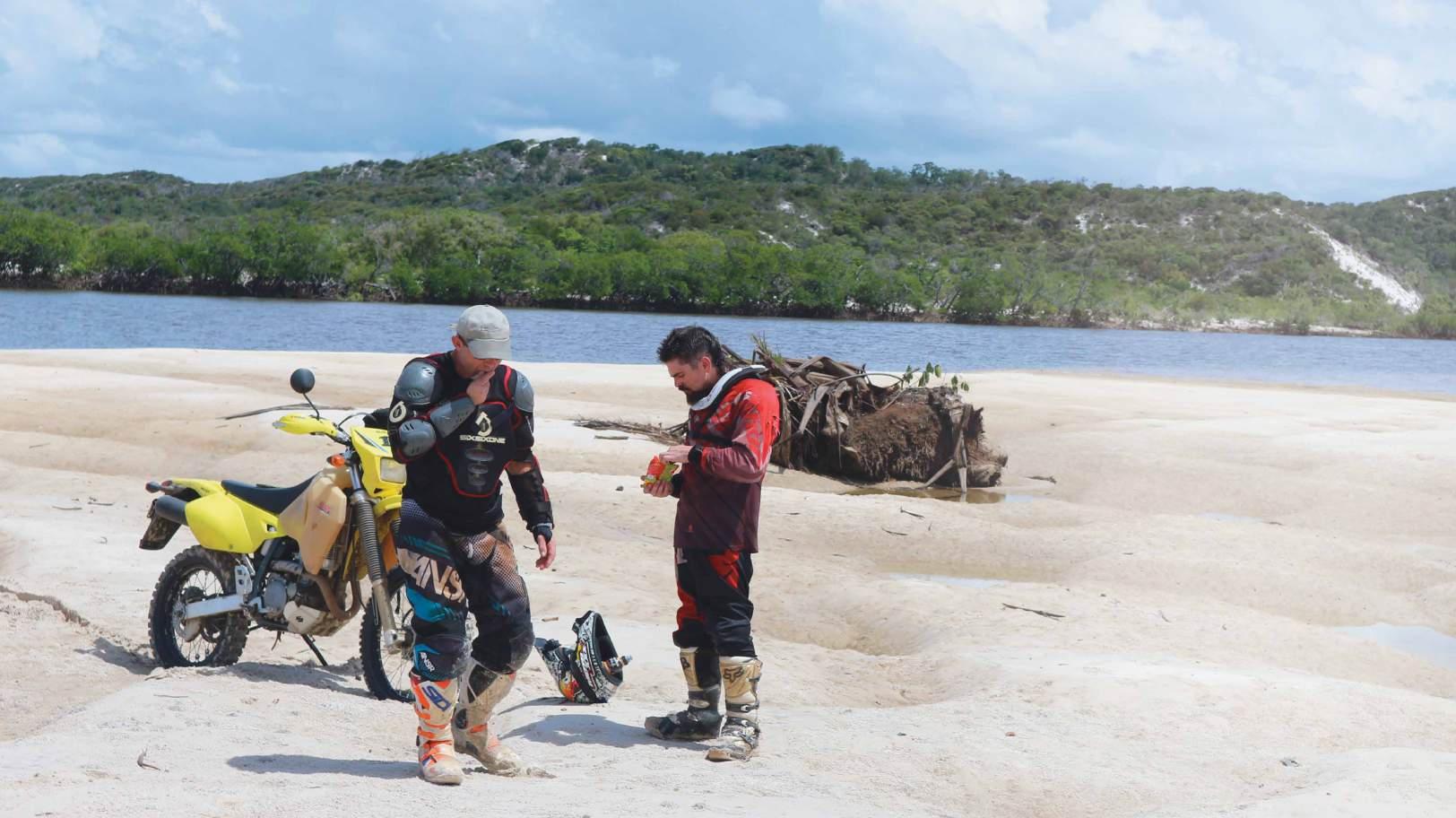
ape York. What a place to be. Whether you’re chilling out around camp soaking in a sunset or you’re out on the bike for the day, you’re feeling good!
So if you’re in need of a getaway or an adventure, the seven-day Cape York tour is the perfect relief, trust me! I’ve seen grown adults jumping around high-fiving like kids at Christmas time, and it’s great being a witness to it.
I’m still loving my new job too, in case you’re wondering. Every tour has its highlights and, man! Are there some crack ups!
We meet some absolute characters that put smiles on all faces. Even the support truck would laugh if it could.
Some groups have their own games that reflect on the day’s events, whether you drop the bike in the sand a few times or make a bad move throughout the day will get you nominated, and as a result, the rider with the most votes may just have to wear a rubbery, sausage-shaped object on the top of their helmet all day, or maybe carry an inflatable pillion strapped to their back.
It certainly gets a few laughs from the 4WD crews along the Old Telegraph Track.
I’ve had my first experience with the dark side of riding, too. The thick sand and bulldust of Starcke Track took a victim around 150km north of Cooktown. Thankfully the result was only a broken ankle, but that’s why we carry sat phones, right?
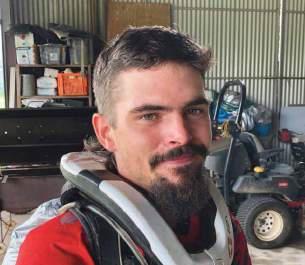
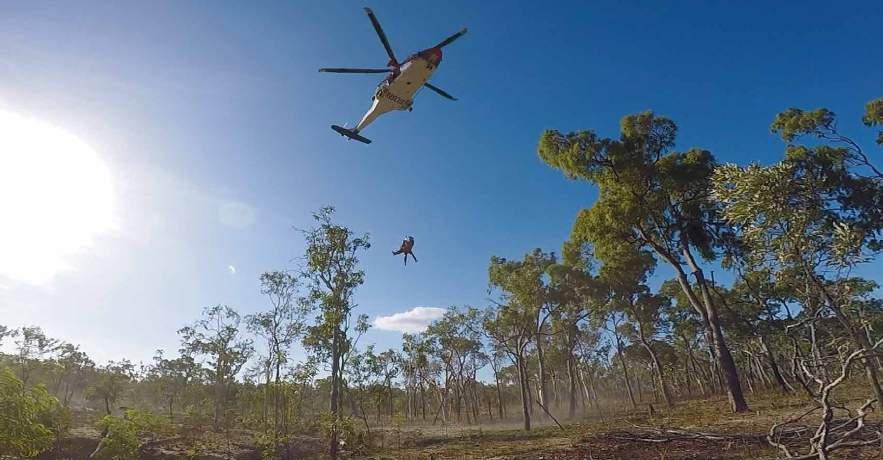
Jordy kept the group moving into camp while I stayed with the rider, Ken, on the track. A rescue helicopter soon came to my GPS coordinates, and as there were no safe places for them to land, Ken was winched up to safety between the trees. The girls who dropped down on the wire and suited up Ken did a bloody good job, no muckin’ around.
Then I realised I had two bikes and I was alone. I had to stash one in the bush! I headed out steady through the afternoon sun and into the night for the last couple of hours.
What a mission.
The retrieval of the stashed bike on the way home after the tour was an even bigger
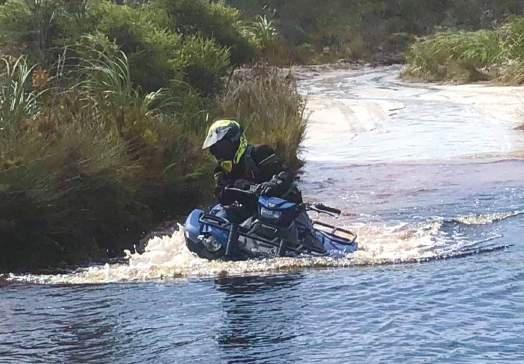
Main: It’s a great to just chill on the beach for a few days or fly up and down some great coastline at Cape Flattery.
Above: There were no safe places to land, so the rider was winched up to safety between the trees.
Below left: Kay cruised to the coast with ease and even pushed the quad through some deep-water crossings.
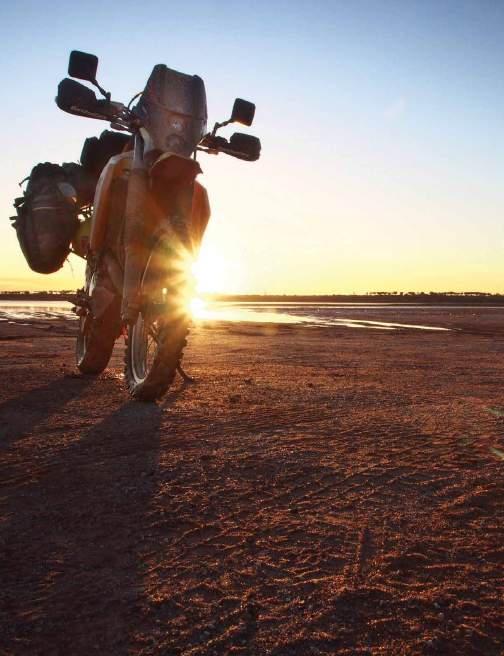
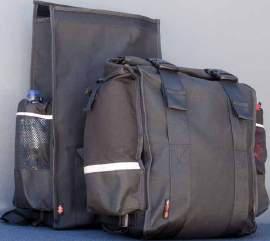
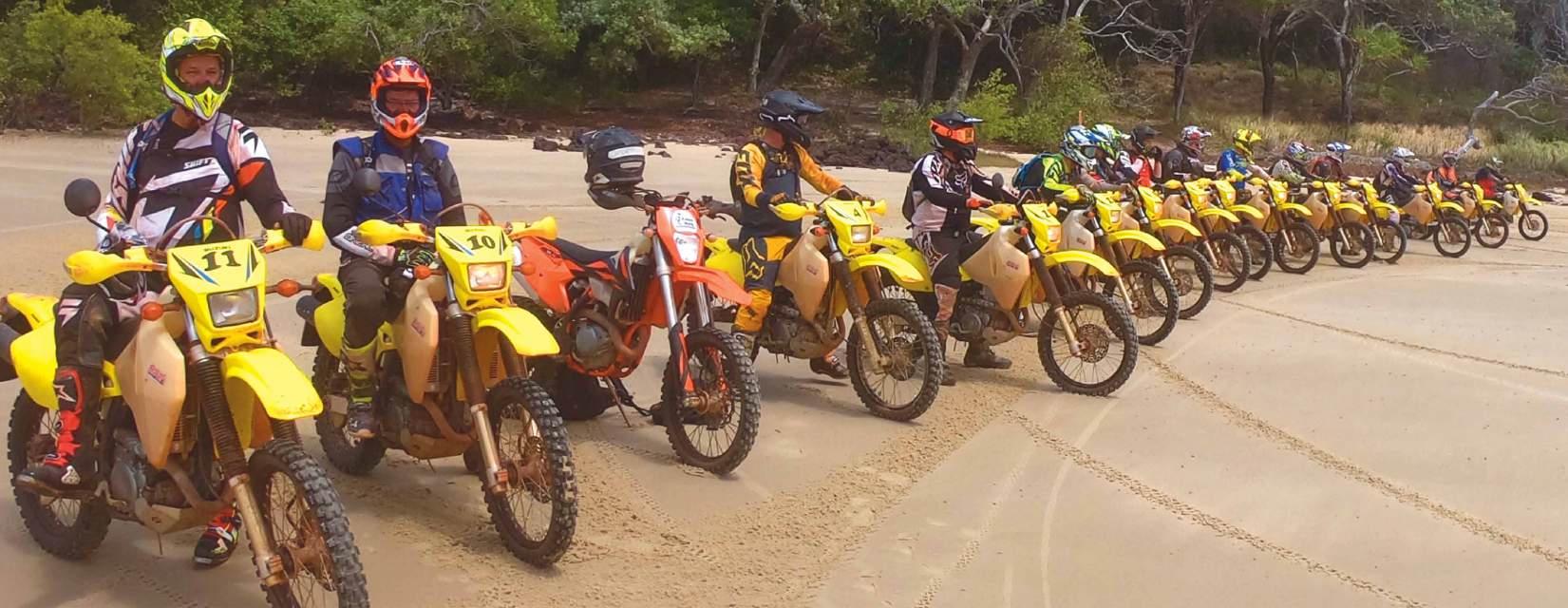
mission. Jordy dinked me around 60km into The Starcke, and the mission hadn’t started until 4:30pm after already travelling 500km or so in the truck. We finally got to the bike after battling through the sand, and a quick check of the oil showed the bloody thing was low. It worked okay because I knew where
there was an abandoned car. I sniggled a little oil out of it and we were away, riding the next few hours in the dark dodging dingos, cows, horses and even owls. We finally made it into the Lions Den Hotel near Cooktown at about 9.00pm. A couple pizzas and a few coldies went down a treat, I can tell you!
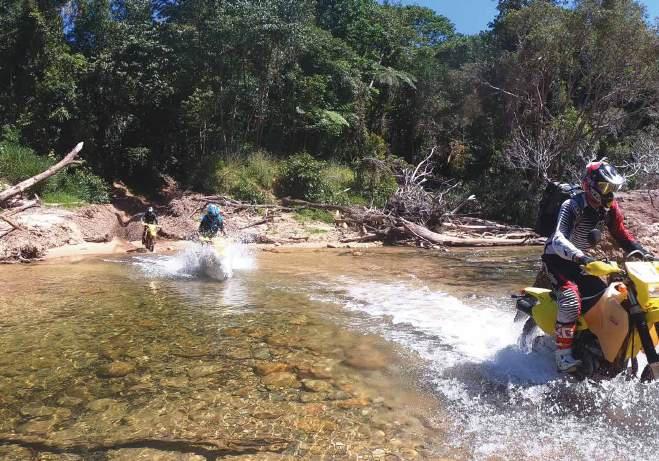
Above: Stop thinking about it. Give CYMCA a call and book yourself in.
Below left: You can be slow. You can be fast. It doesn’t matter.
Below: Another successful tour completed. Jeremy (left) and Jordy celebrate with a cold bevvy.
Right: There were barra, mangrove jack, queenfish and plenty of others caught, with a feed of mud crab to go with it.
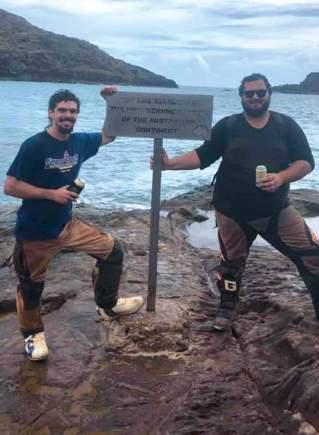
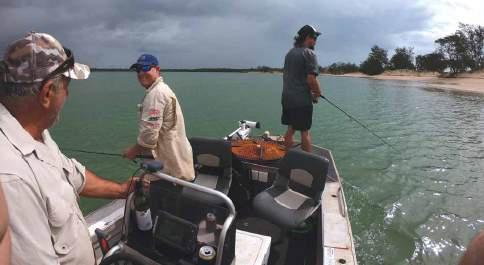
Hooked
Fishing?
Yep we do that, too. And our last six-day fish-and-ride was a cracker.
We bowled into Cape Flattery, two boats on the back of the support truck, and were away, with a night’s stay at the Lions Den on the way, three nights on the coast fishing and again at The Den on our way home. There were barra, mangrove jack, queenfish and plenty of others caught, with a feed of mud crab to go with it. It’s a great relaxing trip to just chill on the beach for a few days, fly up and down some great coastline or into the river systems, and of course the ride up from Cairns.
We had a pretty cool lady on this trip and she sure wasn’t afraid. Kay rode a DR200 to the Flattery track, but the sand was going to be too much for the little bike, so out came the quad bike from the truck and Kay cruised to the coast with ease! She even pushed it through some deep-water crossings.
Having said all this, it’s time you stopped thinking about it, gave us a call and booked yourself in. You can be slow. You can be fast. It doesn’t matter. We’ll cater for your needs and get you to your destination with a great time along the way and some magic country to see.
Catch ya then!
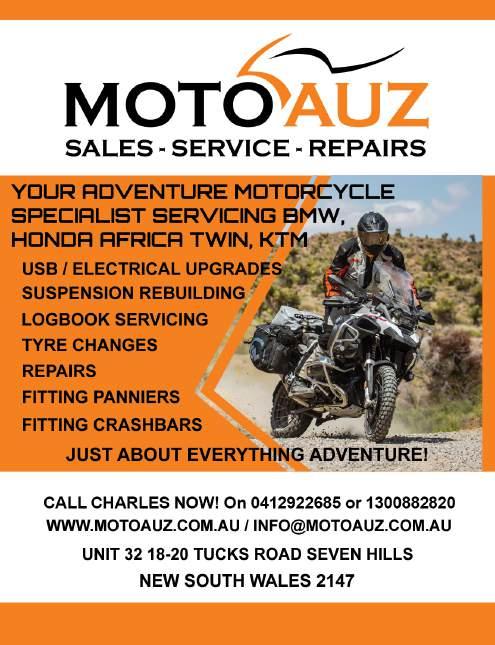
2013-10-29T12:17:20+11:00









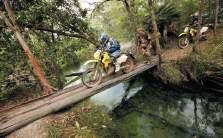




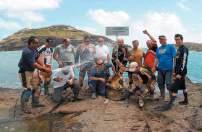
Miles has just ridden the BMW Safari Enduro.
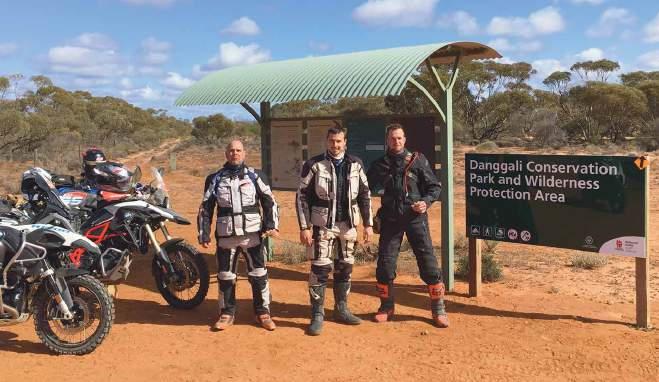
In the last week of August around 60 riders gathered in the river town of Mildura, Victoria, to embark on an ambitious but well-supported six-day journey through some of Australia’s most iconic outback locations. This was the 2019 BMW GS Safari Enduro. For many it was their first remote trip, for others it was an opportunity to tick a few more locations off their bucket list. There was a great mix of bikes from a G310GS, a G650 Xchallenge as well as the mix of 800/850/1200 and 1250GS models.
The 3000km route was carefully planned to provide the right mix of challenge, varied terrain, scenery and iconic locations.
Around 15 riders arrived in Mildura two days early to take part in a pre-Safari training course which took place at the local motocross track. Riding sand was one of the key topics as the route was going through some sandy terrain.
After registration on Sunday afternoon there was a buzz at the welcome dinner/riders’ briefing. The logistics were covered and conditions had been dry, so some
Left: The Arkaroola Backtrack.
Above: Dangalli has a special feel about it, almost like riding through African savannah.
Right: Everyone had a chance to either take in some of the sights or simply rest up for the next day.
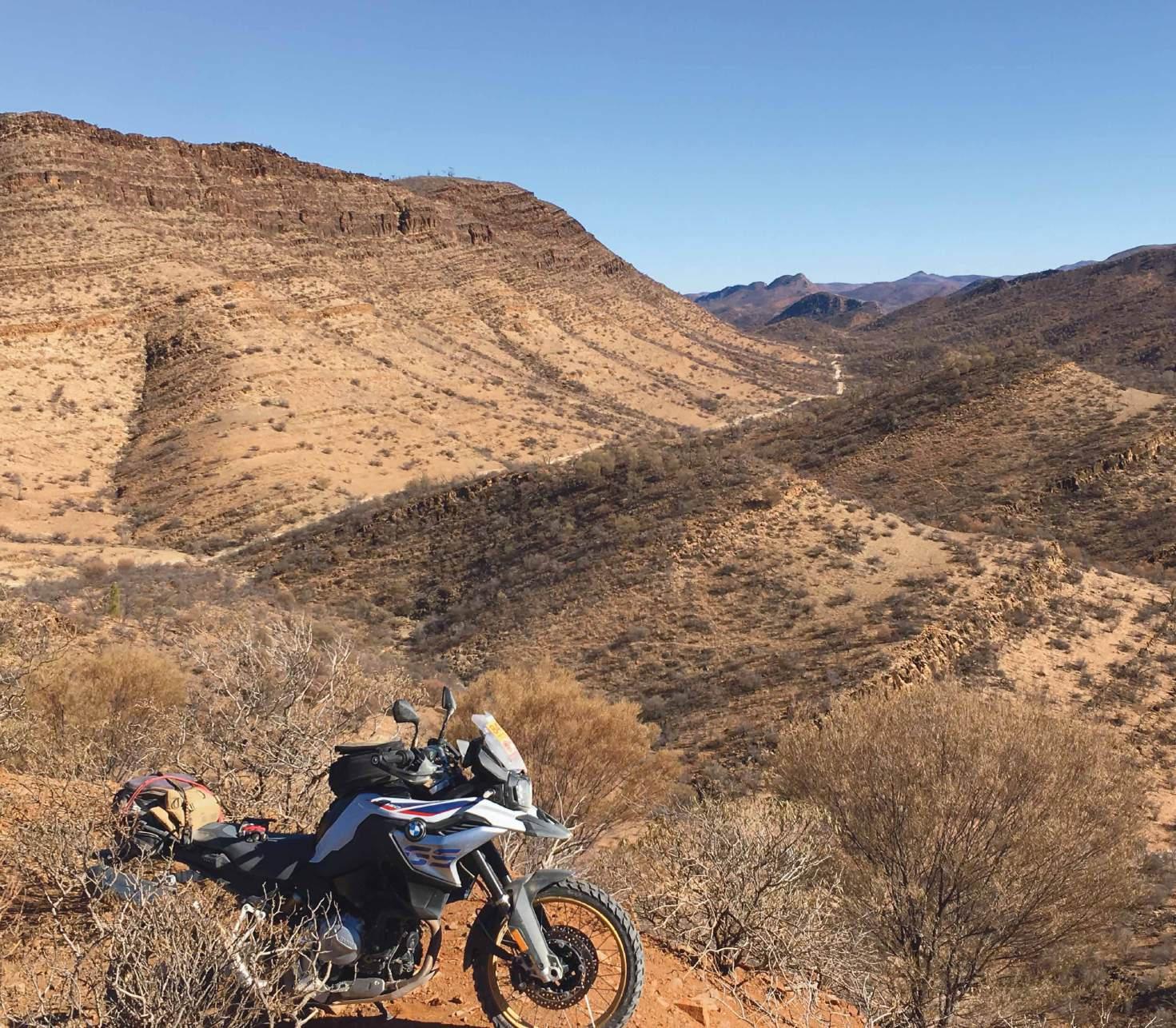
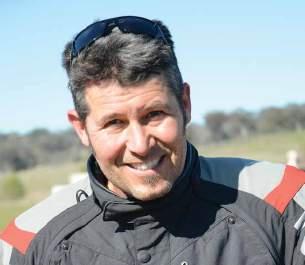
some of the riders while others were setting a solid pace and loving it. Dangalli has a special feel about it, almost like riding through African savannah.
important tips were given on how to spot and manage bulldust to help everyone make it to Alice Springs six days later. Riders hit the sack early as the first day was set to be a big one!
Leaving Mildura, riders crossed the Murray River and fuelled up at Wentworth. A remote fuel dump was planned 330km into the ride so it was imperative to have this range. The GS Adventure models had no issue with the distance, but some of the other models were cutting it fine, so riders were given advice on how to get the most out of their tank.
After about 100km of flat, open, tar and gravel the route headed north into the Dangalli Wilderness Reservation where things started to get exciting. Conditions quickly changed to lightly sandy double track with regular ups and downs and the odd sand dune. This definitely challenged
A sign to Broken Hill had everyone headed north on more 50/50 sand/gravel roads before many were relieved to get to the fuel dump. The tracks were generally a bit more mellow from that point, apart from some large bulldust pits marked with caution symbols. One especially was just over the crest on a potentially fast section and could’ve really been dangerous.
After a huge day a surprisingly lush, green Peterborough was a sweet sight. Many riders dropped by the pub with two bikes mounted on the awnings before heading to the local caravan park to set up tents.
The day was a baptism of fire for some, but everyone made it and was treated to some great catering by the Peterborough Rotary Club team.
Neil, the local publican and caravan-park owner, provided an excellent route to Hawker via some great tracks which rolled through the hills and creek beds.
u
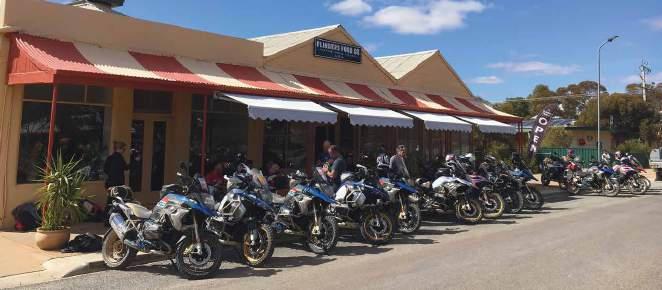
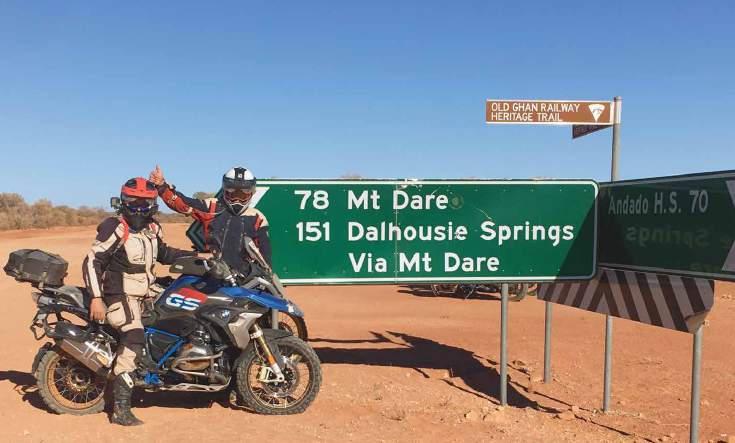
The dust was pretty epic at times as there was little wind to blow it away, so riders were on their toes. Hawker provided fuel and a great feed before heading north on the blacktop and up the eastern side of the ranges. If you haven’t been to the Flinders you definitely need to put it on your bucket list. It’s such a contrast to the flatlands around it.
The route headed off-road again and offered an optional section through the Nantiwarrina Aboriginal Conservation. This was definitely a highlight for many as the double track twisted over rolling hills and through dry creek beds, and with the regular bulldust patches there was little time to relax. Once again, the scenery was mind-blowing whenever there was a chance to slow down or stop for a break. About 100km of these tracks led to Copley Road, a smooth, wide, gravel road that winds its way up to Arkaroola Village. The village and the outback mountains around the area were talked up at the previous briefing and riders weren’t disappointed. After the briefing, an amazing meal was served under the outback stars and riders had a few refreshments around the firepits taking in the atmosphere.
The tracks around Arkaroola Village are endless. Some are a bit too hectic for adventure bikes as they are extremely steep and chopped up from 4WD traffic. The Vulkathuna Ranges loop was first up, and the riding was first class, with challenging ups and downs, loose, dry
creek beds and epic lookouts. Rain had been scarce and the tracks were much looser and rougher than normal. Aside from the bulldust, holes and pits were constant, so the route was much more challenging and took many riders longer than expected. After regrouping for lunch and a show of hands it was clear the morning had satisfied and the afternoon loop to Lake Frome would be dropped. This gave everyone a chance to either take in some of the sights or simply rest up for the next day.
As with the previous outback Safari, Arkaroola was a highlight of the whole event. The route went out the back of the village onto some of the same rough tracks which had really deteriorated from the loop day, and continued southwest onto Copley Road. There was also the option to take the main drag out of the village which was far easier and gave some the chance to get into William Creek early and possibly take a flight over Lake Eyre. After a pit stop in Copley for a famous outback quandong pie it was almost a dead-straight run up to Maree, past the historic ruins of Farina. This classic outback road is now 100-per-cent bitumen, which didn’t quite feel right, but is a sign of the times. After only a morning’s ride the terrain had flipped from extreme rough hills to flat, barren, outback plains.
A fuel up and snack at Maree was required before turning west onto the Oodnadatta Track towards the iconic William Creek Hotel. There was a lot of traffic, from grey nomads to road trains, so managing dust and safe passing was key. Along the way, highlights included Plane Henge and the amazing desert art, Lake Eyre South lookout and Coward Springs, where you could jump in for a splash and some therapeutic water-jet massage. The track was in pretty bad shape, rough and very loose in places, so it was no walk in the park.
Seeing 50 or more bikes in front of the hotel was amazing. Trevor, the owner, said it’s the biggest bike group they have ever had. They looked after the group with a great pub meal (the biggest lamb shanks I’ve ever seen) and a few drinks. Some went to bed early while others let their hair down and a few danced on the bar.
William Creek to Mt Dare: 443km
Departing William Creek it was a 200km blast west to Oodnadatta. The Oodnadatta Track was in better shape so it was a more relaxing ride. Riders could sit back and really take in the unique landscape.
After fuel and lunch at Pink’s
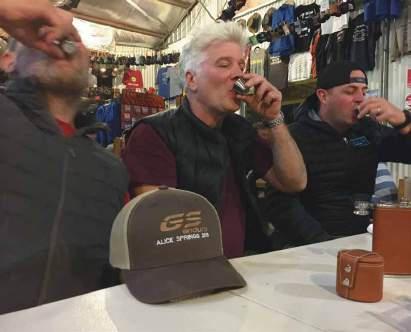
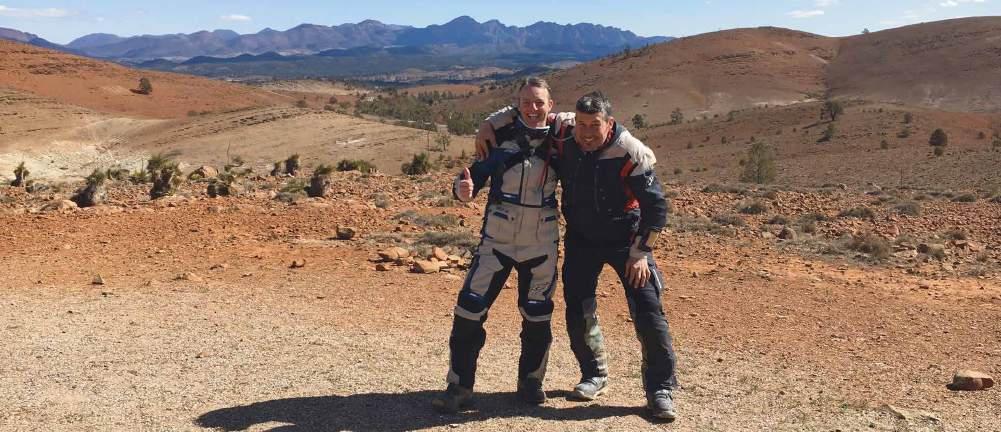
Roadhouse the route went another 15km before heading north onto Mt Dare Road where again the conditions became more interesting: narrow roads with light sand, dunes, and the odd mud plain. After Hamilton Station the route turned into a Mars-like rocky scene, with a winding gravel road that crossed the odd creek and even skirted around an outback lagoon at Euringa Ruins.
The final 10km into Mt Dare was a bit looser, but not as bad as we’d all been told.
Mt Dare is an old station that has been turned into a tourist camp, right on the edge of the Simpson Desert. This was also the second and final compulsory camp night, so we set up on dry red dirt for a night under incredible stars.
Mt Dare to Alice: 521km
The final day was a biggie!
Heading to the famous community of Finke, the track started off with more smooth, wide, gravel roads before turning into the deepest sand of the week. It was wide with occasional turns and nice banked berms. The first riders had playful fresh tracks while some others at the back battled in the chopped-up mess.
The plan was to take a small group of very experienced riders from Finke to Alice via the Finke access road/old Ghan line, which runs adjacent to the famous race track. The other option was to run directly to Kulgera on dirt and up the highway to Alice. The hard route was a very ambitious plan as the road is always
a challenge, and we had heard it was in terrible shape. But before we had a chance another challenge appeared, as they had run out of fuel at Finke three-quarters of the way through our group. Luckily, we had some fuel in the support vehicles and riders who had filled up their long-range adventure models were able to share fuel around.
So that challenge was sorted, leaving just the Finke Road.
I led a group of 25 who were briefed about the physical and technical challenge. The track was corrugated to hell and tough to ride. Around 25km into the track I pulled over for a regroup. The first 10 riders were not too far behind, but the remaining riders were doing it pretty tough and took a while, with one or two unable to come to terms with conditions.
Unfortunately, this was where I had to make the call to turn the group around and head back via Kulgera. It was simply
too risky and time wasn’t on our side. As I’d mentioned, it was an ambitious plan. The group was totally understanding, and I’m sure a few were relieved. Everyone was happy to have experienced some of the track.
The ride back to Finke was even tougher as it was already chopped up, but from there we cruised the 150km to Kulgera and had an easy run into Alice.
For many this was the toughest Safari they had attended, so there was a great sense of accomplishment and relief when they made it to Alice. The route was much more difficult in places than back in June when we did the recce, mainly due to the dry conditions. Of the riders, only one sustained an injury that put him out of the ride. Based on the conditions, varied level of skill and experience, that was quite an amazing result.

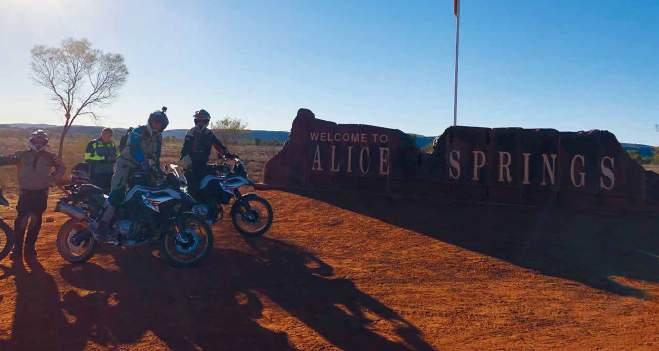
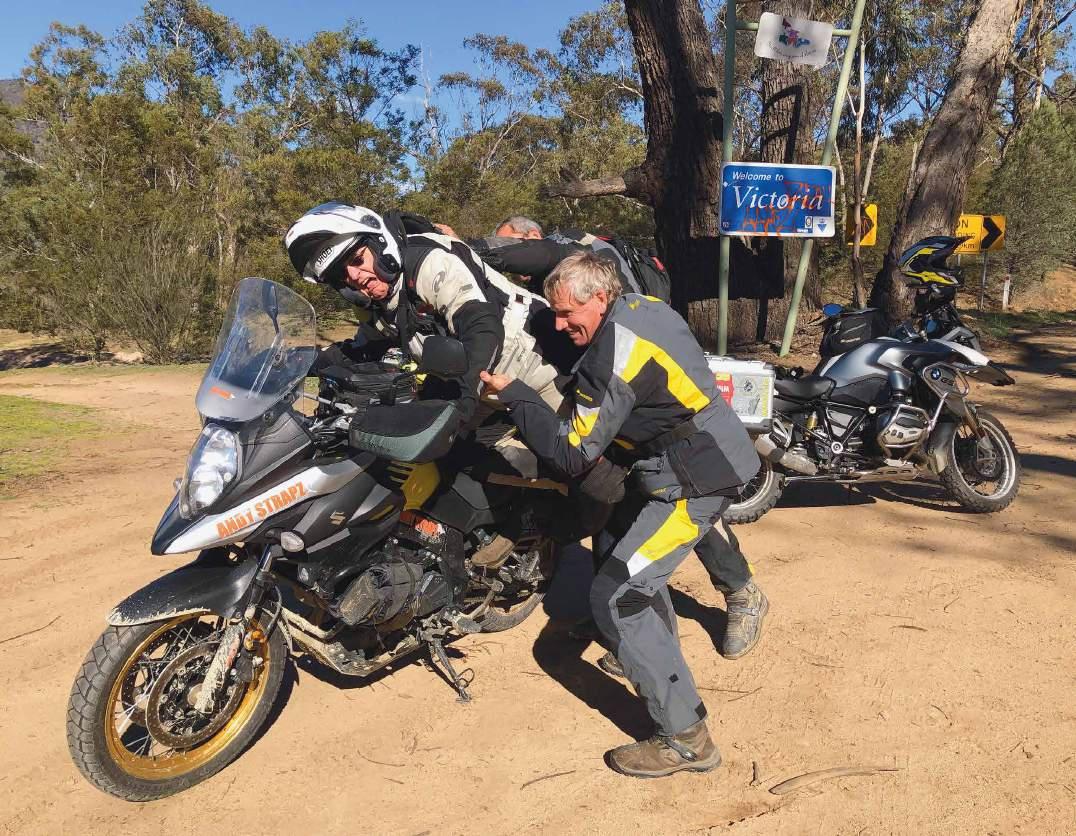
Words: Andy Strapz
Andy sees a future for adventure riding as therapy.
After reading my last column again, the straightroad gremlins have invaded my thoughts and teased me about getting old.
As I suggested last time, the dawning reality is that from here on in, ability is on the reverse slide. The mix of ambition and ability are at polar opposites to when
I was young and silly(er). Skill and practice still apply to my adventure riding, but for a completely different reason – getting home in one piece. To paraphrase a biking Melbourne magistrate Schultz (no it wasn’t last time I was up before him); “These days my body is a bit like a brown paper bag filled with cups and saucers”.
My realisation is that the goal of my riding is now to be smooth and safe, whether on sealed or unsealed surfaces. It still takes commitment and momentum to tackle roads in this way, but the time for finding the ragged edge has passed.
To be honest I’ve never been a great rider. I can hold my own on the blacktop but struggle with doubts and confidence when the road turns to track. I watch those blokes (and blokesses) who can make a bike dance with a mix of awe, frustration, gritted-teeth jealousy and sad resignation. The bike becomes part of them, they make it all look so easy and I’d love to be able to approach a
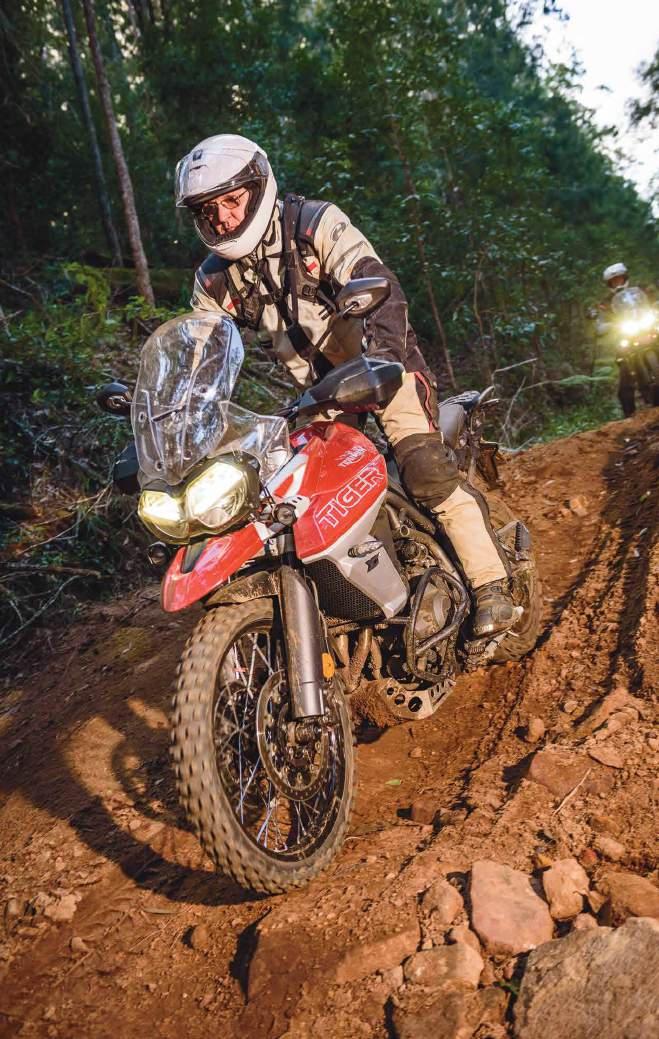
track with a bit more of that.
With survival in mind, those skills are more important now than ever to keep my bones intact.
In my past life mustering budgies in a hospital emergency department, we
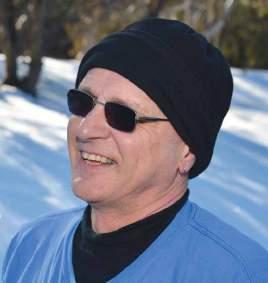
improve strength, balance and make it a point to enjoy life, but the concept of keeping fit is hollow unless there’s a reason to do so. The way I see it, that suggests over-60s should take up adventure riding. It ticks all the boxes:
3 Core strength is improved by using the large muscle groups of the legs, shoulders and torso
3 We all know balance is a key component to bike control – what grey-haired mug doesn’t need better balance?
3 It’s a pursuit best done in small groups
3 It gets us away from home, and
3 Bike prep gives us things to do other than watching the idiot box in the evening.
I can see it now: retirement homes with enduro tracks; mobility scooters off-road equipped; Wednesday’s outings marked as ‘single-track’. The day-room could be set up as a service centre and the Dakar would be compulsory viewing. Beer and tall stories would flow around the fire-pit outside. Garages would take precedence over sensory gardens, and the smell of petrol, oil and truckwash rather than rosemary bushes to brush past! Now, where are my Strapz? I need to get the Zimmer frame onto the back of the bike. There’s contour banks to jump.

saw many age-related presentations.
Over-60s are supposed to avoid ladders, roofs and strenuous sports without seriously planned preparation. Very few of the staff understood motorcycling, and even less when pursued by older people “…who should know better”. What we seniors are supposed to do is

Got any other suggestions for how adventure riding can benefit more mature citizens?
Let us know what you think. Email tom@maynemedia.com.au and we’ll make sure Andy knows your opinion.

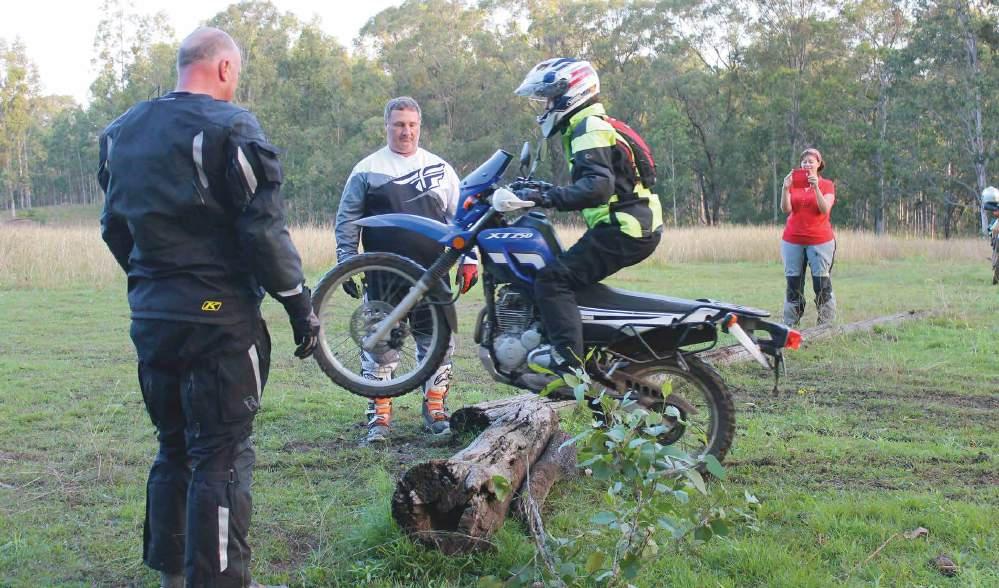
Karen considers the benefits of good training.
Those of us who were in the Girl Guides or Scouts will remember the motto ‘be prepared’. I think that’s a pretty apt creed for adventure riders, too. Along with ‘Always get a photo once you’ve checked they’re not seriously injured’. If you’re a half average rider or better what I’m writing won’t be anything you don’t already know. But don’t just skip through to the end where I share my latest embarrassing moment. Have a quick read and think about the knowledge and skills you have that could benefit others.
Being prepared can, very broadly and conveniently (and to fit within the word count), be broken down into two main areas: bike and rider.
The general attitude of most adventure riders overall is constantly positive. Having something go wrong is usually not seen as a disaster, but part of the adventure. There’s no point in me trying to say much about bike preparation, because without noticing, I’ve been riding around with handlebars that are, apparently, bent ridiculously out of shape. It was only when someone else jumped on it and asked how it was possible to ride like that I recognised something wasn’t right. When you’re making sure you and your bike are prepared for whatever riding you’re about to embark on, a little common sense will go a long way. Having enough fuel plus a little extra, knowing where and when you can get more, using good-quality tubes
Above: Greg and Kylie with the weekend participants.
Left: Everyone, regardless of their riding-skill level or experience, could ask questions and share knowledge.
Right: Jodie in slippery conditions.
(preferably ones that aren’t already patched) and carrying the correct tools and supplies for your model bike will make some of the potential issues more manageable…travelling with someone who can get your bike going when you’re in the middle of nowhere doesn’t hurt either.
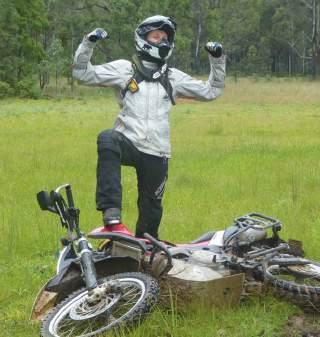
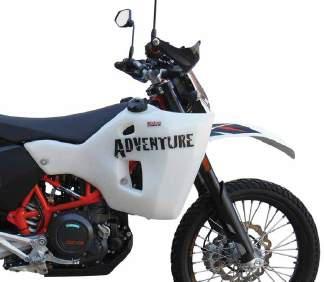
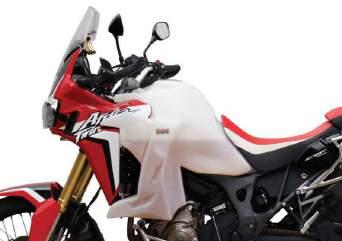
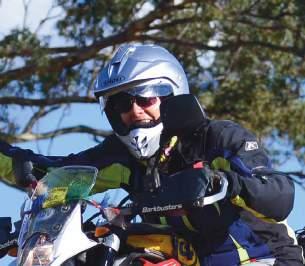
If the number of groups advertising rider training is anything to go by, rider preparation is a huge area of growth. If that equates to riders who are safer with better abilities, that can only be a positive for everyone. Perhaps the changing mindset many people have traditionally held towards training is the key. Lots of adventure riders also do trials riding, mountainbiking, pilates, or other cross-training pursuits. When you look at people who are standouts in their field, whether it’s in riding, sport, medicine, music or anything else, they are continually practising and training

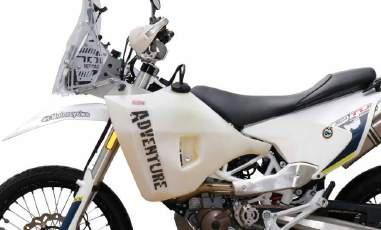

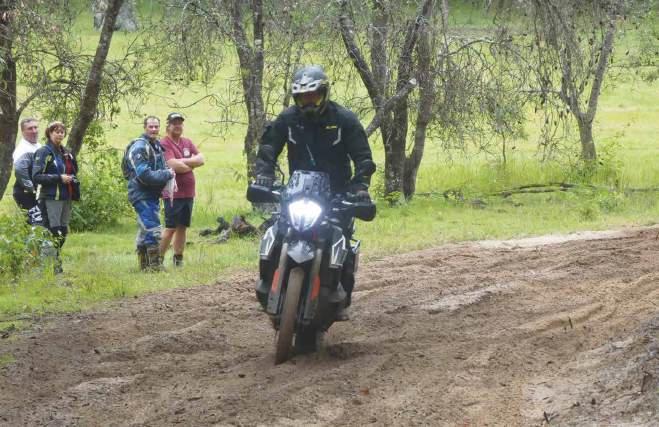
and learning. Regardless of how good or talented they are, they’re always looking to learn and improve. Imagine Toby Price or Laia Sanz heading to Dakar without any training or prep. Why should we, as adventure riders, be any different? Whether we’re going out for a weekend of fun, setting off on an unsupported challenge or embarking on a round-theworld trip, if we’re not properly prepared with skills and bike fitness, it’s going to be harder on us than it needs to be. Doing some training, regardless of whether it’s a paid session or getting together with some friends to practise, is worthwhile.
I recently attended an APC rider-training camp at Piora in northern NSW. Going through a range of drills and skills over
the weekend was invaluable. We had quite a lot of rain on the first day, which you really can’t complain about when so much of the country is in drought. Plus it made for a realistic range of conditions likely to be encountered. As an added bonus it made the sand riding a lot easier. It was interesting to see how people’s abilities improved over the weekend. Having the time to practise a skill with someone giving feedback was good. How many times do you get through a tricky spot by the skin of your teeth and think, ‘Well that was lucky,’ and not think of it again because you’re on to the next bit of track? Over the course of the weekend we had the opportunity to practise those situations so hopefully next time we encounter something out on the track those skills will automatically kick in.
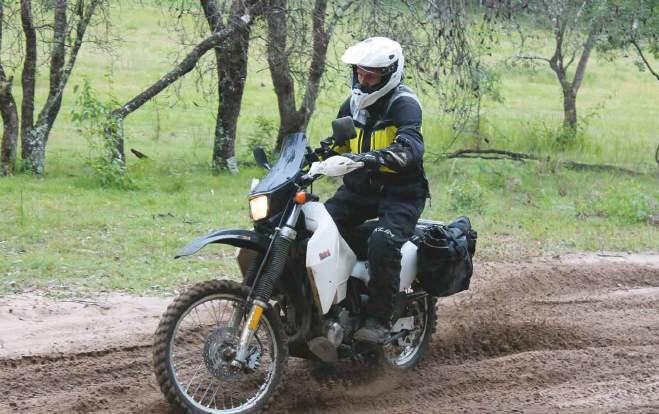
Left: It was interesting to see abilities improved over the weekend. Below: Practise is for everyone.
The other great aspect of it being over a couple of days was it allowed the opportunity for everyone, regardless of their riding-skill level or experience, to both ask questions and share knowledge. No matter who you are, someone is going to know something you don’t and vice versa.
Just in case it sounds as though I’ve got it all together… There was a group of us, probably around 20 people, on a weekend ride. We’d pulled up for a quick snack and a chat. It was the ideal opportunity to relieve oneself with plenty of trees around (often I’m wearing a fluoro vest as sweep, which makes visibility great, even when you’re trying to conceal yourself behind sparse, low bushes). All was going well. I’d found a great little spot a good distance away behind a big tree. Then I heard Dave getting everyone ready to get going. Finished, I attempted to speed things up with a special all-in-one manoeuvre of simultaneously hoisting my pants as I stood up. Unfortunately the graceful, efficient movement was thwarted by a big stick I managed to snag in my pants, sending me tumbling backwards in a fairly undignified manner. My fluoro top half, laying on my back, was fully visible to the mob if they cared to look over and could only end in a situation no one needed to see. Trying to keep hysterical laughter silent just compounded the situation. Fortunately for all I managed to extricate myself from the ‘Awkward Turtle On Back’ yoga pose and re-join the group with no one any the wiser – until now.
And I bet no one was prepared for that!
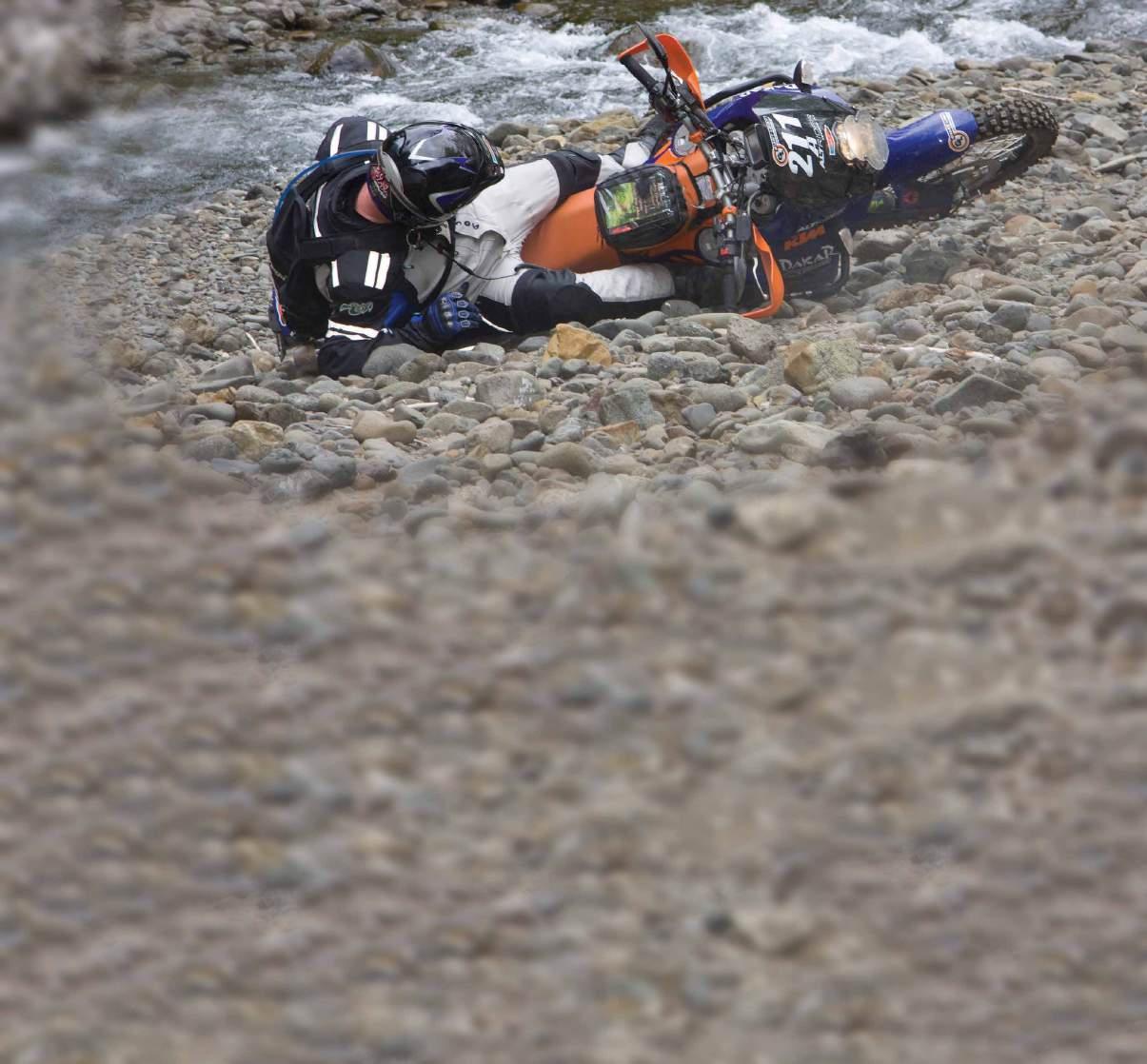

R Always be open to learning
R Remove the hi-viz vest when trying to blend into the scrub
R Practise is for everyone
R Everyone has some knowledge worth sharing
R Always check for big sticks
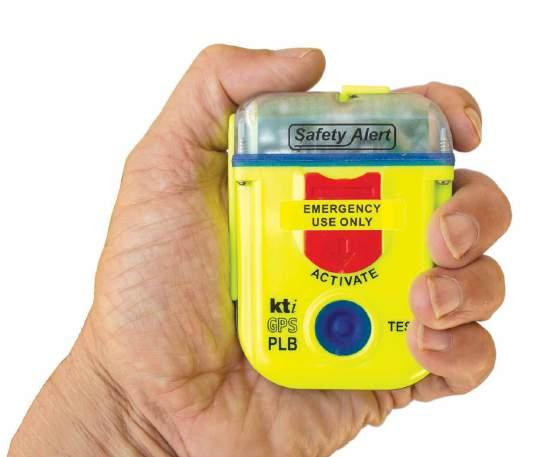

Formulated with an extreme wall thickness specifically for adventure bikes.
R Four-millimetre ultra-heavy-duty
R Front tubes weigh in at 1.8kg and rear tubes just over 2.4kg
R Made of 100-per-cent natural rubber
R Offset-valve tube available to convert OE KTM tubeless wheel to tube-type 18-150-170
R Straight-valve tube available to suit most large adventure bikes 18-150-170 and 17-130-150
R Available in a choice of sizes
inflation

Ideal for difficult-to-reach valve stems.
R CNC-machined aluminium
For an impressive beam balanced between night-time distance and daytime conspicuity. Yes…conspicuity.
R Two 10-Watt Cree XPL HI LEDs
R 160m beam distance and 22m beam width
R DataDim compatible technology
R Flood lenses and mounting hardware included
R Switches for 7/8-inch and one-inch handlebars
R Official E-Mark certification
R Compact 5.5cm-round and six-centimetredeep pods
R Three different beam functions
RRP: $732
RRP: $49.95
Available from: Your local JTR dealer Web: jtr.com.au
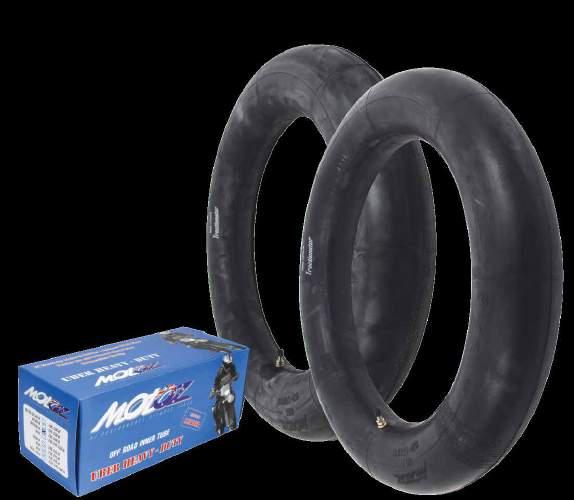
Bike-specific hardware kit
Designed specifically for the new Yamaha Ténéré 700.
R Two mounting points secure the full wrap-around aluminium design
R Heat-treated aluminium backbone for added strength and impact protection
R Complete hardware kit supplied with easy-to-follow instructions
R Hardware is compatible with JET, VPS, STORM or CARBON guards (each sold separately)
RRP: $129
Available from: Your local bike shop. Find a dealer on the website. Web: barkbusters.net
R Control valve head slips directly onto the tyre valve
R Gives complete control over CO2 discharge
R CO2 canisters not included
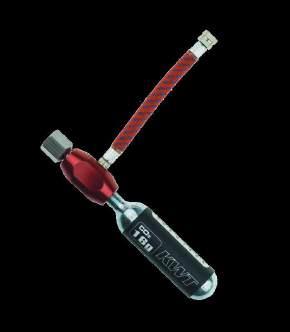
RRP: $17.95 plus postage and handling
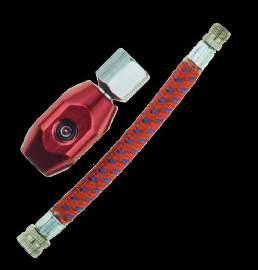
Available from: Rocky Creek Designs and all good motorcycle stores through Pro Accessories Web: rockycreekdesigns.com.au
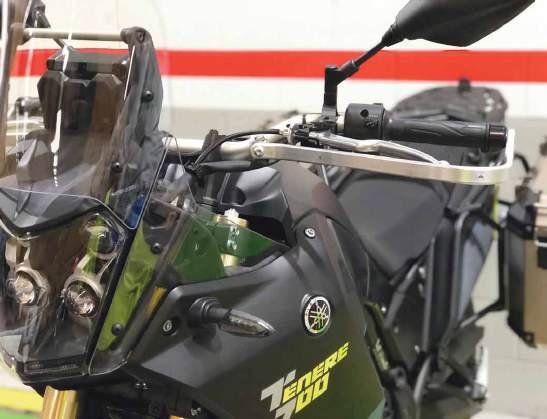
Available from: Any Denali dealer Web: whitesmoto.com.au
Built with Klim Rhino-stitch construction technology.
R Increased overall mesh coverage
R Heavy abrasion- and tar-resistant Mil-spec Klim Karbonite nylon mesh
R Abrasion zones at elbows and shoulders
R Fleece-lined soft collar
R D3O Level 1 shoulder pads, elbow pads and back pad
R 3M Scotchlite reflective on arms and back
R Available in sizes S to XXXL
R Available in blue, dark grey, hi-vis yellow and light grey
RRP: $575
Available from: AdventureMoto Web: adventuremoto.com.au
The flexibility and low weight of an enduro glove with the protection of a street glove.
R For riders who do not like the bulky feel of traditional gloves
R A combination of goat leather and spandex
R RISC polyurethane knuckle and wrist protection
R Available in black
R Sizes S – 3XL
RRP: $99.95
Available from: Selected stockists Web: macnaridinggear.com.au
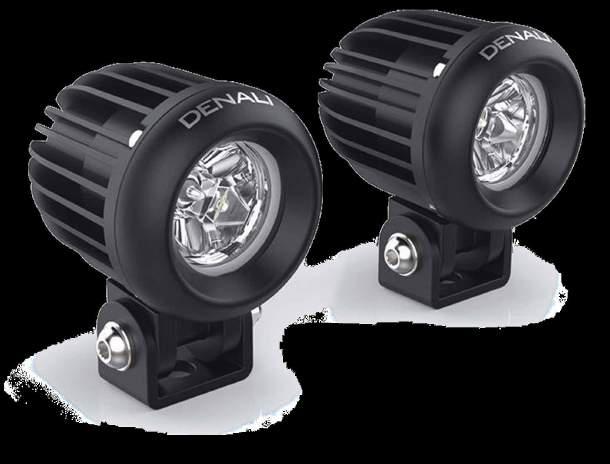
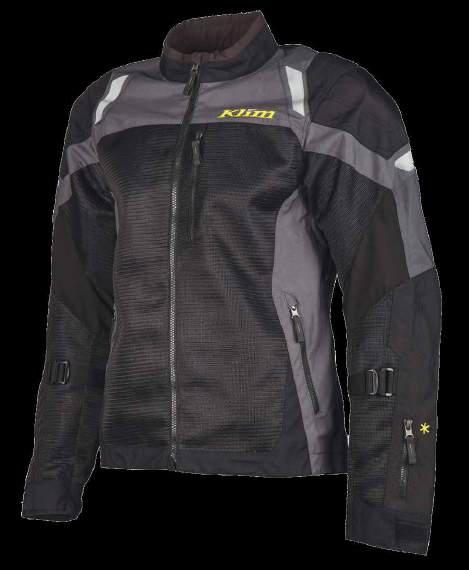
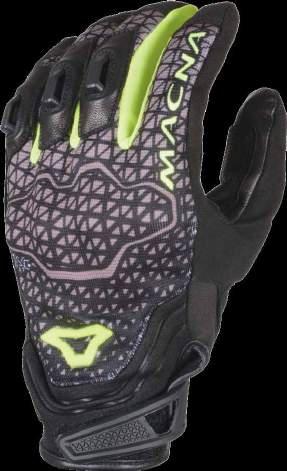
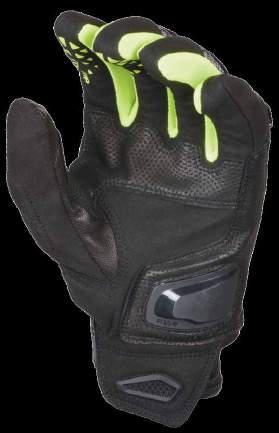
held air streaM 2 glove
Another high-quality product from Held.
R Highly abrasion-resistant kangaroo-leather palm
R Mesh fabric (100-per-cent polyester), leather detailed back
R Colourfast and sweatproof
R Unlined palm
R Special step seam avoids pressure points on inner hand
R Perforated leather back, finger panels and sidewalls of fingers
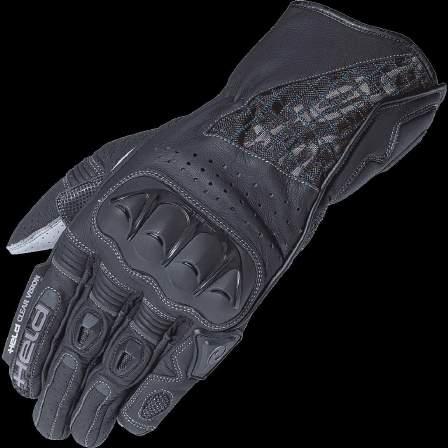
rukka airventur jacket
A rugged, comfortable, three-season jacket.
Made of #420 stainless with 48HRC hardness.
R Flat screwdriver
R #2 and #3 Phillips screwdriver
R Bottle opener
R Box cutter
R 5mm, 6mm, 7mm, 8mm, 10mm, 12mm, 13mm and 14mm end spanner
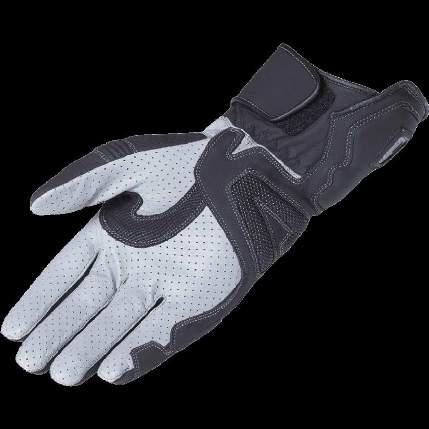
R Knitted mesh cordura AFT and AFT+
R Knitted cordura AFT double-layer strengthening on elbows
R Width adjustment on upper arm with snap fasteners
R Zipper adjustment in sleeve and velcro adjustments in hem
R Adjustable waist belt
R A crotch strap and a long connecting zipper for trousers
R Rukka D3O Air XTR shoulder and elbow protectors,
CE norm EN 1621-1 2012
R Ready for Rukka StretchDry jacket for wet weather
Designed to survive while ensuring your gear remains safe and dry.
R Tough PVC tarpaulin construction
R External and internal pockets for small items
R Reflective details for improved visibility
R 4mm, 5mm, and 6mm Allen key 1/4-inch and 7/16-inch end spanner Includes pouch and five-year warranty
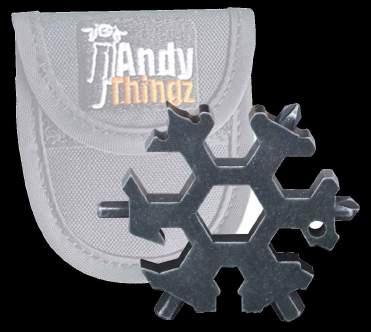
RRP: $18 including free untracked post Available from: Andy Strapz
Email: info@andystrapz.com
RRP: $655
Available from: Innotesco
Web: innotesco.com.au
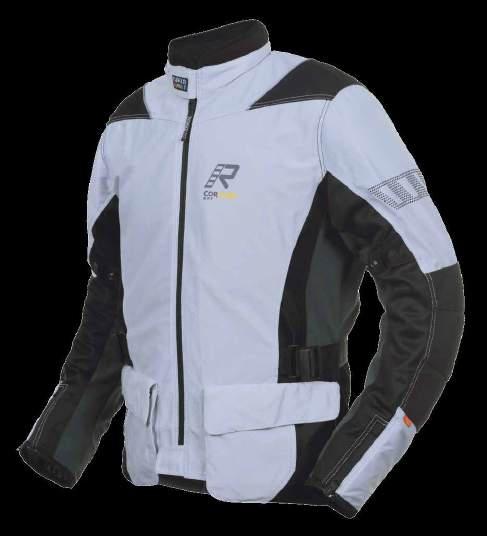
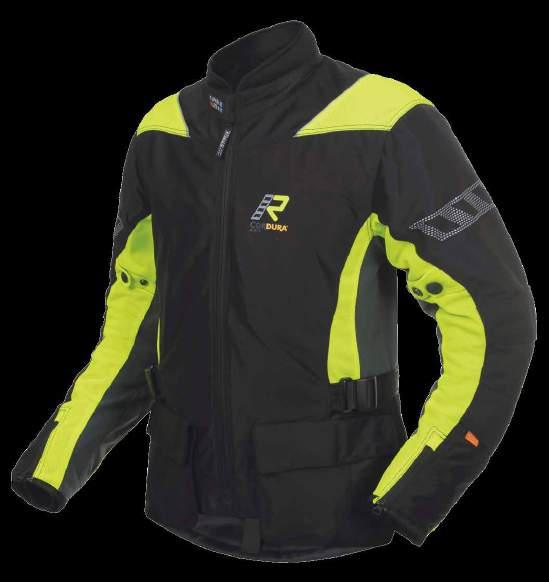
R Wipe-clean, waterproof construction with welded seams
R Padded shoulder strap for added comfort
R Unique attachment system for motorcycle with underseat security strap
R Compression straps for maximum stability
R Available in 20L, 30L, 50L or 70L sizes in black, black/grey, black/fluro and black/khaki
RRP: From $154.95
Available from: Your local dealer Web: oxfordproducts.com.au
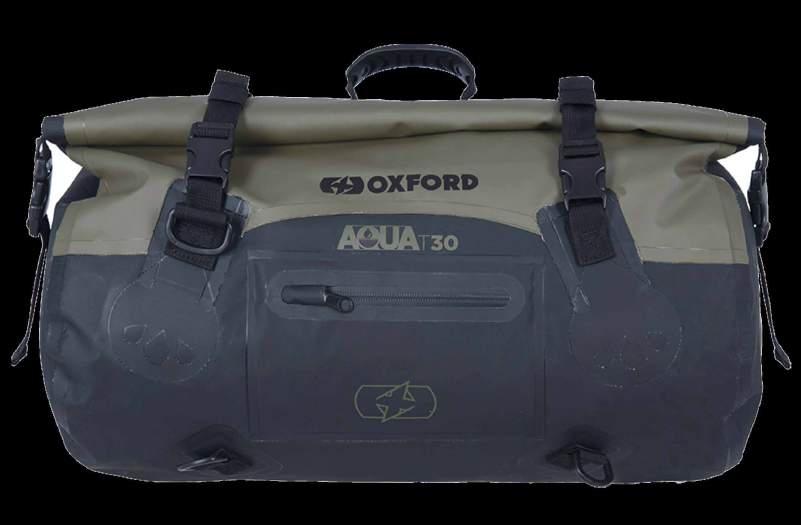
The editor’s about to fit a pair of these to the Touratech KLR.
R Ingenious block design
R High cross-section area and small pitch length
R Anti-irregular-technology
R New block profile
R Increased compound rigidity and strength
RRP: Fronts from $169.95. Rears from $249.95
Available from: Your local motorcycle dealer Dealer enquiries phone: McLeod Accessories 1300 300 191

forMa adventure Boot
Comfort and protection.
R 12-months warranty
R CE-level protection
R Drytex waterproof
R Adventure anti-slip sole
R Stainless-steel shank
R Plastic gear-pad protection
R TPU reinforced ankle area
R European production
RRP: $379.95
Available from: Lusty Industries
Web: lustyindustries.com
Web: formaboots.com.au u
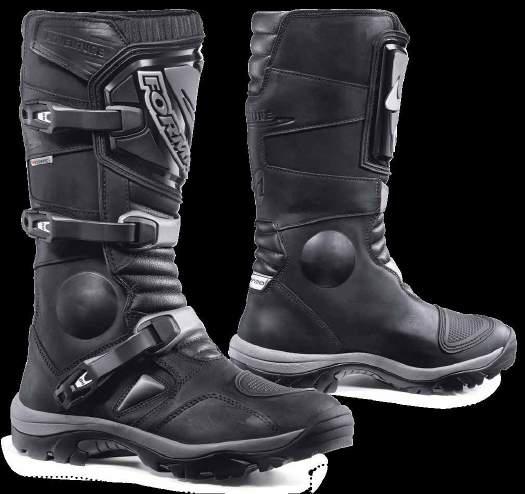
agv ark intercoM
Designed specifically for AGV helmets.
R Seamlessly communicate with up to four riders simultaneously
R Allows talking to riders up to 1.6km away
R Compatible with the AX9 Adventure range, the K5-S Sports range and the Sport Modular Touring range
R Take calls, listen to music and more
R A handlebar remote is available
R 10 hours of talking time
R Microphone-mute option
R Smart volume
RRP: $399. Handlebar remote $149.
Available from: All leading motorcycle dealerships Web: www.agvhelmets.com.au
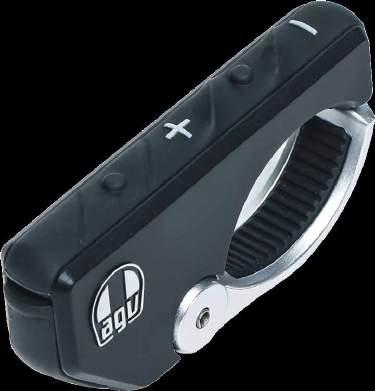
Connects to the bike battery and can be attached to the handlebar using the bracket or built into the bike’s dashboard.
R Discharge protector and short-circuit fuse
R Installation depth (inside) 45mm
R Diameter (inside) 28mm
R Battery connecting cable 170cm
R Blue indicator light (when voltage present)
R Input: 12V-24V DC
R Output: 5V DC, 2A
R Included: double USB socket, bracket, 170cm cable
RRP: From $68.24
Available from: www.shop.touratech.com.au Web: www.touratech.com.au
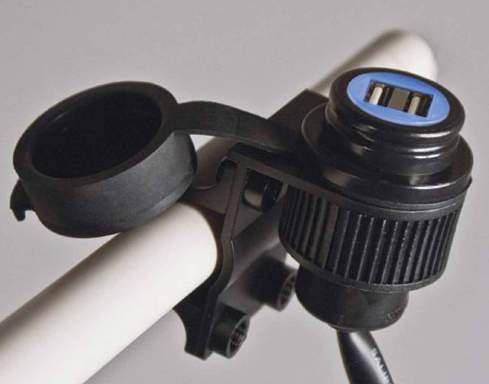
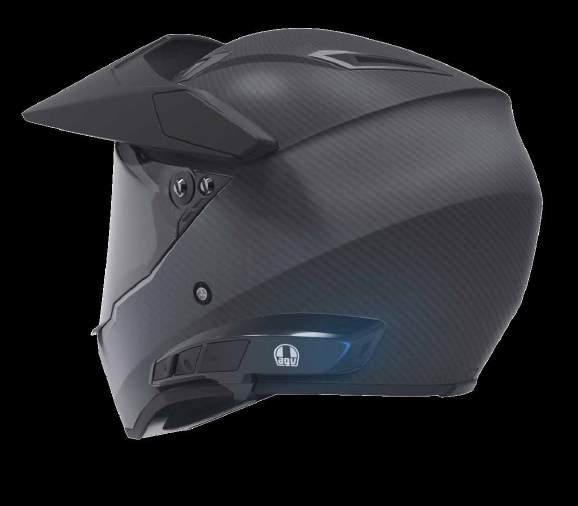
rippa grips foaM coMfort grips
Help absorb vibration for a more comfortable ride.
R Slip on over existing grips.
R Increases grip diameter for less fatigue and cramping
R Soft surface for greater comfort
R Reduces vibration from the handlebars
R Fits all standard-size grips
R Compatible with heated grips
RRP: $19.95
Available from: Motorrad Garage Web: www.motorradgarage.com.au
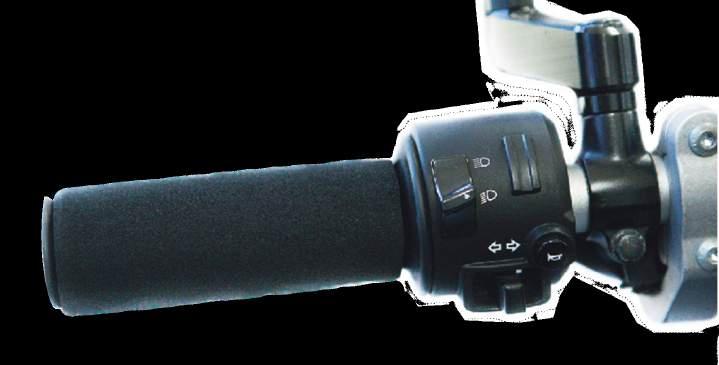
A wide-ratio gear set engineered and manufactured for direct replacement of DRZ factory gears.
R Incrementally broaden second through fifth gear
R Increase range for off-road riding or higher top speeds

Made of heat-treated and case-hardened chrome-moly steel
Precisely machined and precision ground
NOTE: Shift fork modifications are required. Instructions are included. Modified shift forks are also available via order

Tyres for your adventure motorcycle.
R Aggressive tread pattern provides excellent wet and dry adhesion
R Compound resists tearing while off-road
R Four-ply nylon construction
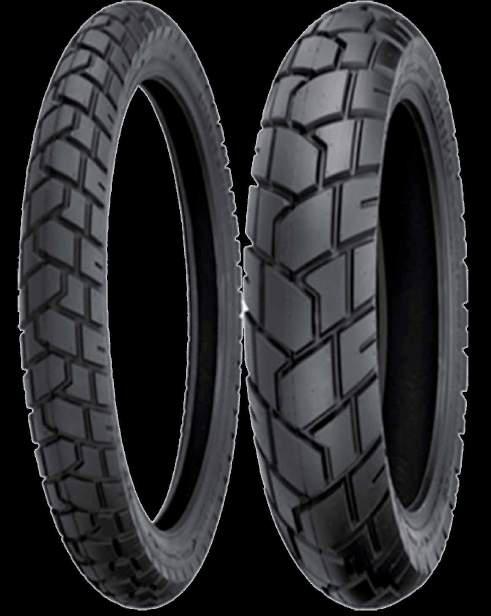
RRP: From $990 plus postage
Available from: Adventure Bike Australia adventurebikeaustralia.com.au
Allows communication with intercom devices.
R Built-in FM radio automatically saves the first eight stations with the most powerful signal
R Compatible with the main Bluetooth sat-navs for motorbike’s GPS voice directions
R Mobile-phone speed dial allows saving a number to call quickly with a control from the intercom, voice dialling, last-number redial, and sharing the phone conversation with the passenger
R Wireless MP3 playback from smartphones and MP3 players
R Listen to music or the GPS without interruption
R An iOS and Android app sets and controls the intercom directly from a phone
R Control the main functions of the intercom with simple voice controls
RRP: $479.95
Available from: All good motorcycle retailers Web: ficeda.com.au
Genuine cordura construction for extremely high abrasion resistance.
R C.E EN1621-1 approved body armour in shoulders, elbows and back
R Water-repellent outer shell with a 100-percent breathable and waterproof membrane
R Removable, thermal, zip-out liner
R Waterproof zippered air vents
R Six pockets
R Reflective panels
R Zip and button cuffs
R Zip-to-pant feature
R Available in black/black/red and black/hi-vis
RRP: $399.95
Available from: All good motorcycle retailers Web: cassons.com.au
zac speed flex tool roll
The tools aren’t included with this heavy-duty, 1680D poly-fabric tool roll.
R Clear internal storage pocket
R Seven elastic storage slots
R Padded parts mat
R Elastic compression strap
R Folded dimensions: 245mm x 160mm x 25mm
R Black with red trim
R Weight 200gm
R Part number TR3013
RRP: $19.95
Email: Info@zacspeed.com
Available from: www.zacspeed.com.au
Web: www.zacspeed.com.aus
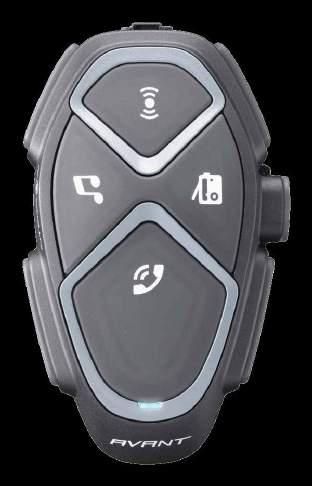
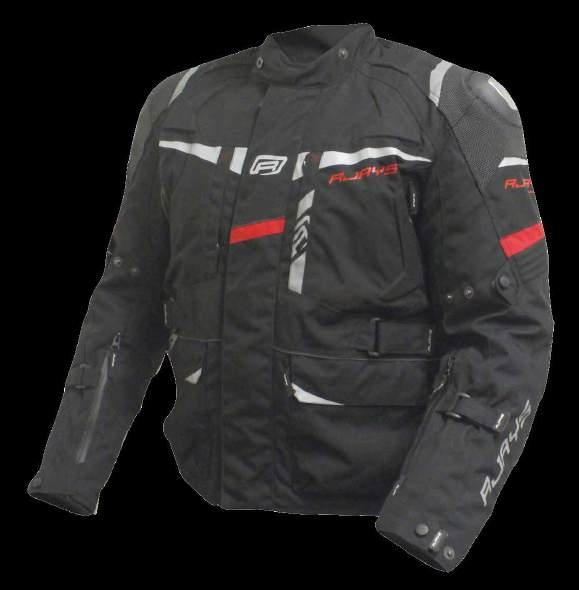
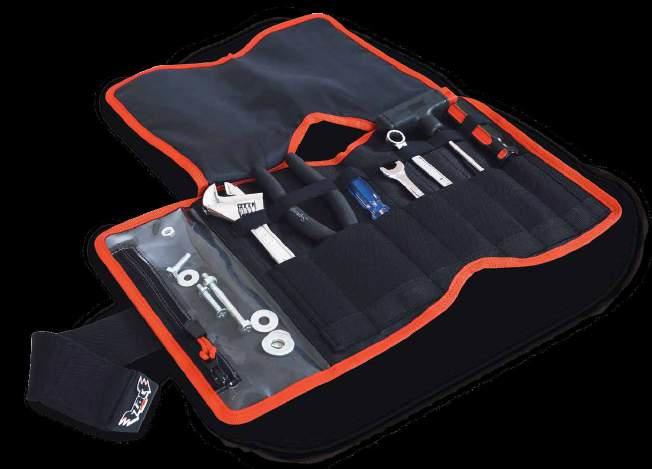
Developed for around-the-world riding.
R Gore-tex gloves and Gore grip technology
R Direct-laminated, waterproof-but-breathable membrane bonded to the outer shell
R Pittards WR100X leather
R Wrist and cuff adjustment system
R Ventilated dual comp protector – a 3D, pre-shaped, honeycomb structure of TPU material, topped by an aluminium high-impact shield
R Outside stitching is positioned on the outside of the glove, eliminating any potential pressure points at the seams
RRP: $379
Available from: REV’IT! Australia Web: revitaustralia.com.au
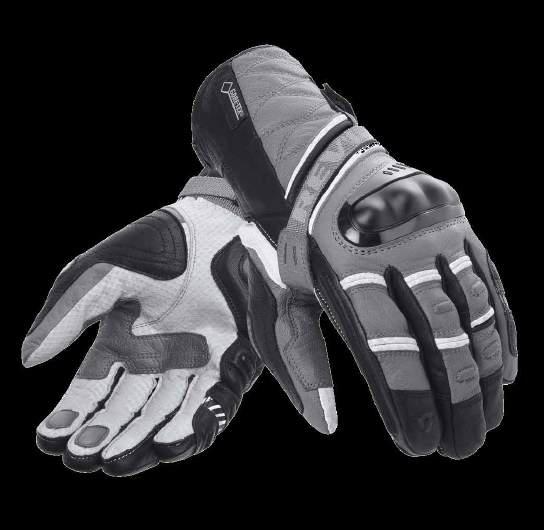
A high-quality, close-fitting tarpaulin cover for big adventure bikes.
R Made to include luggage-system widths of up to 110cm
R Zip fastener for the optional use of cover with topcase
R High-quality protection against dust and protection for paintwork
R Breathable fabric. No condensation under the tarpaulin cover
R Black, in the hallmark Touratech design
R L 272cm x W (area of the mirrors) 104cm x H (front) 147cm x H (back) 137cm
R 100-per-cent polyester, approx. 220 g/m²
R Part Number: 01-601-0009-0
RRP: From $262.29
Available from: www.shop.touratech.com.au
Web: www.touratech.com.au
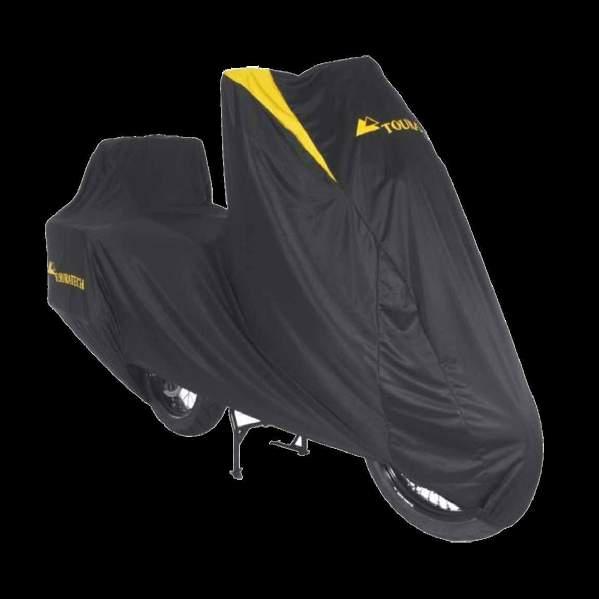
Combines the protection of motocross boots with waterproofing and comfort.
R Full-grain cowhide leather and nubuck shell with Superfabric and PU reinforcement
R Water-repellent coating
R REV’IT! Dynamic Support Frame (DSF) provides maximum support
R Hydratex sphere laminated waterproofing and breathable membrane
R External TPU shin plate with reinforced heel and toe cups
R Vibram Apex sole with integrated shank
R BOA Closure system
R Silver-ion anti-bacterial inner-mesh lining, gusseted tongue and anatomically designed footbed
RRP: $999
Available from: REV’IT! Australia Web: revitaustralia.com.au
